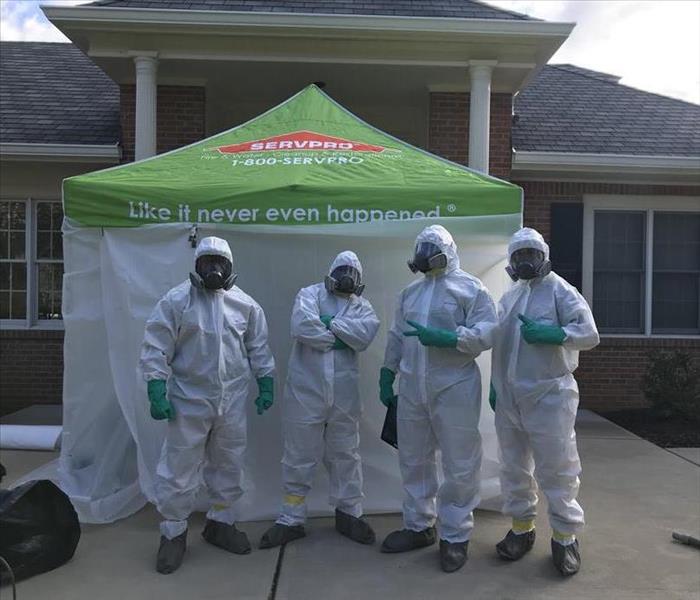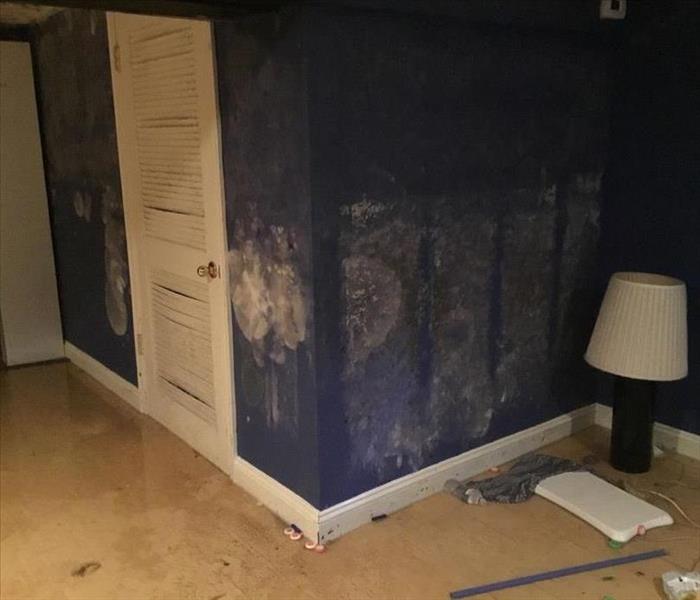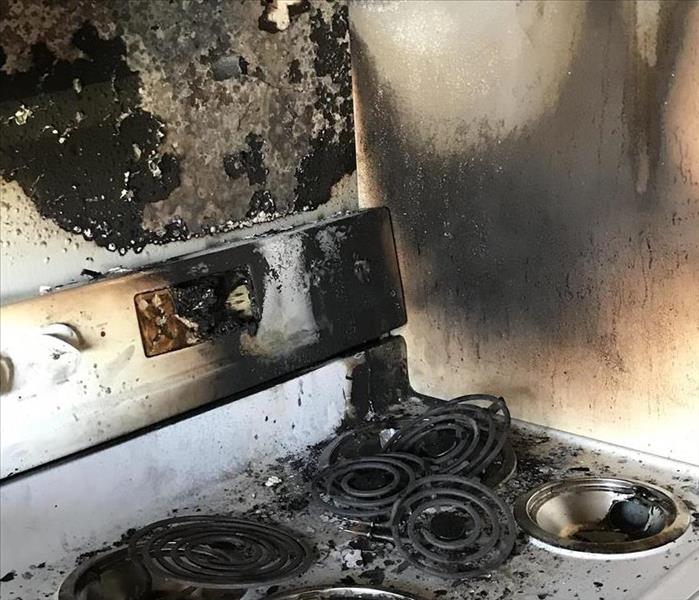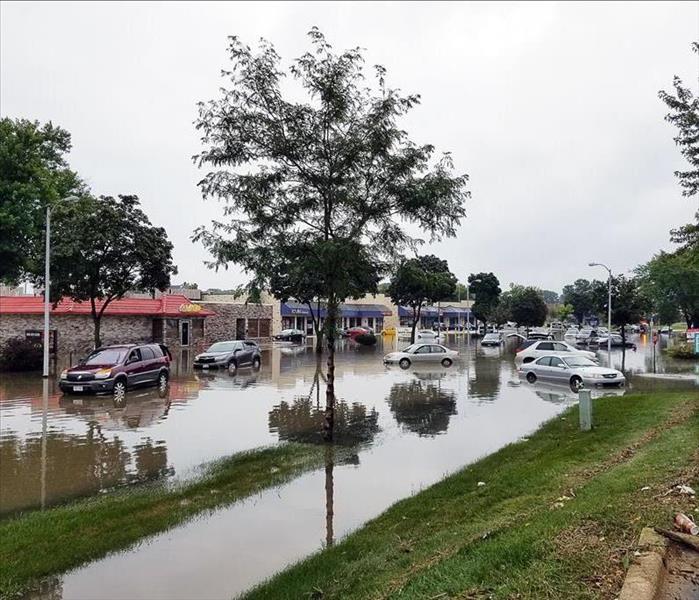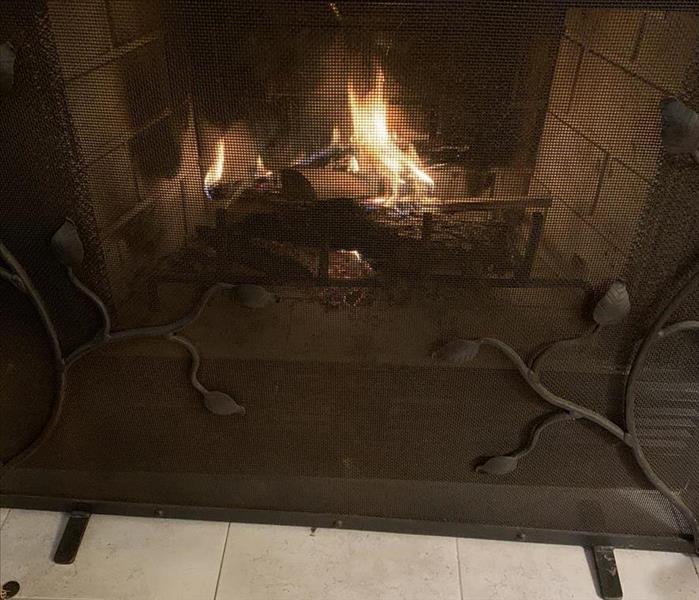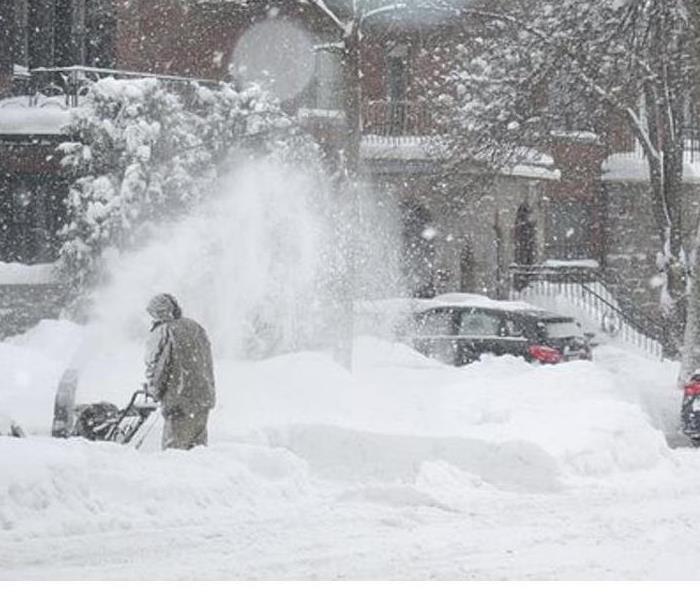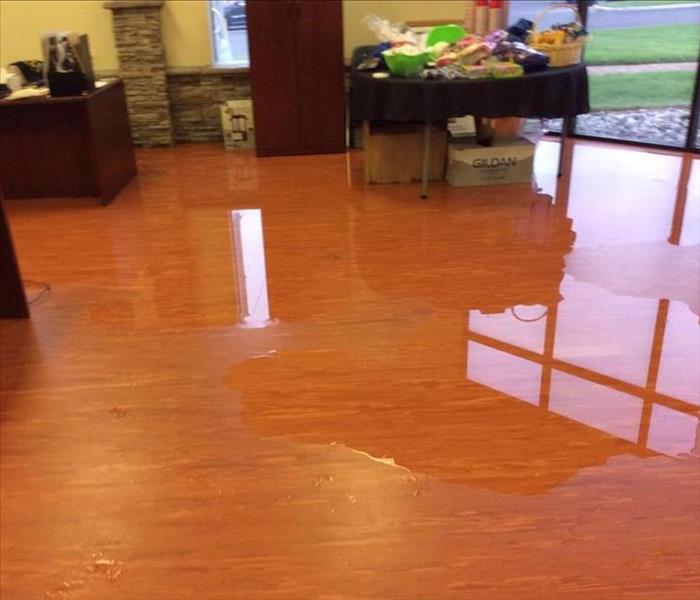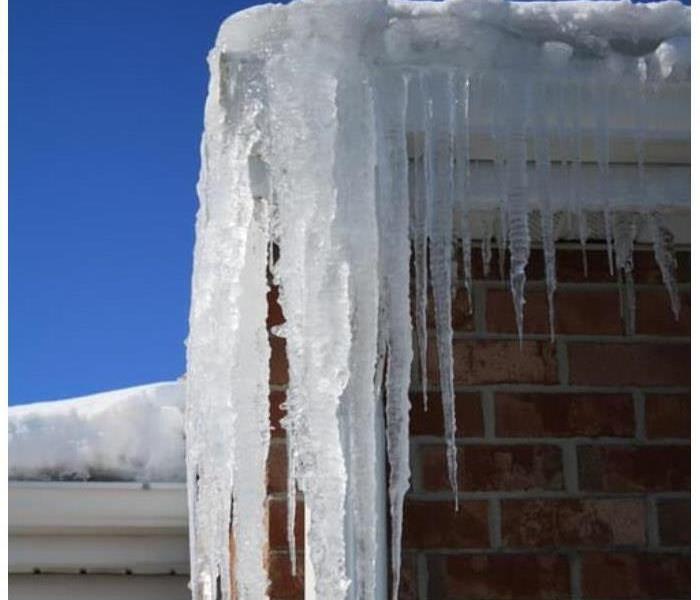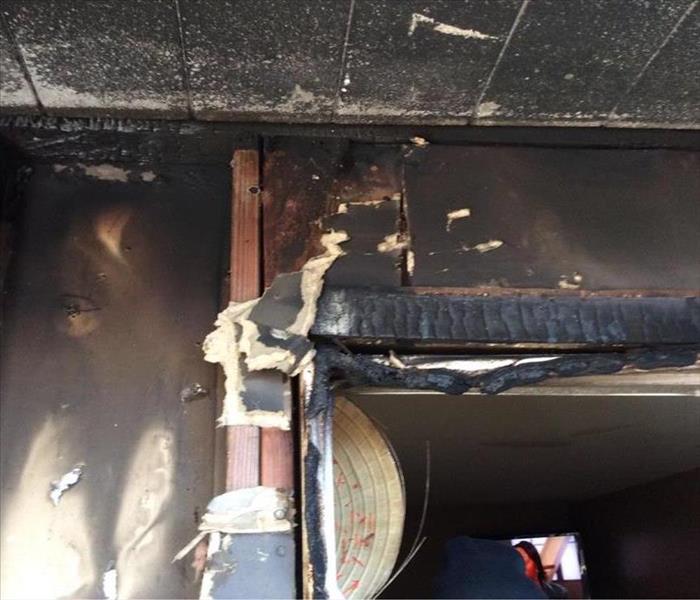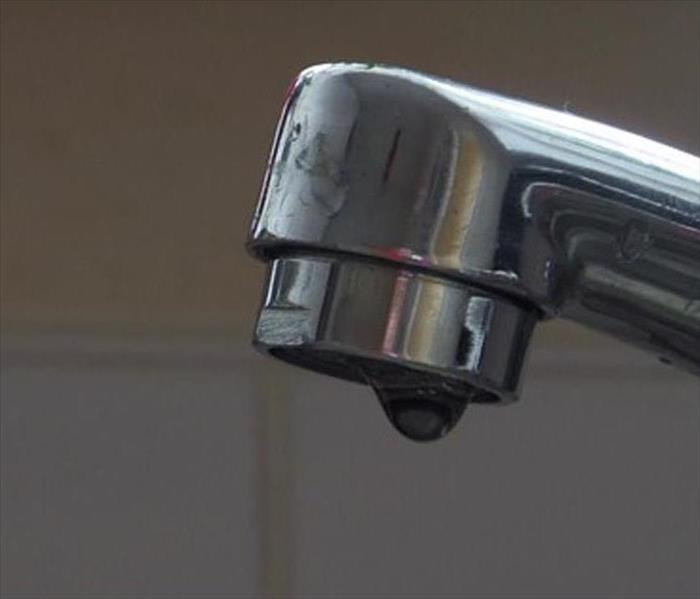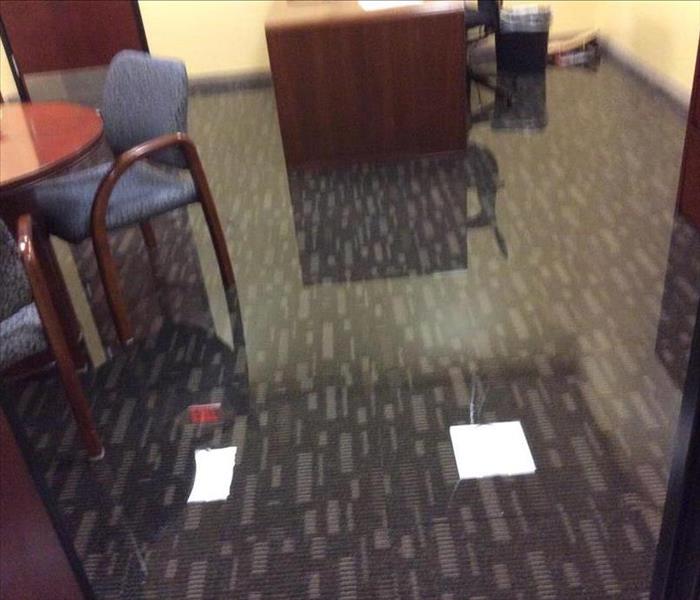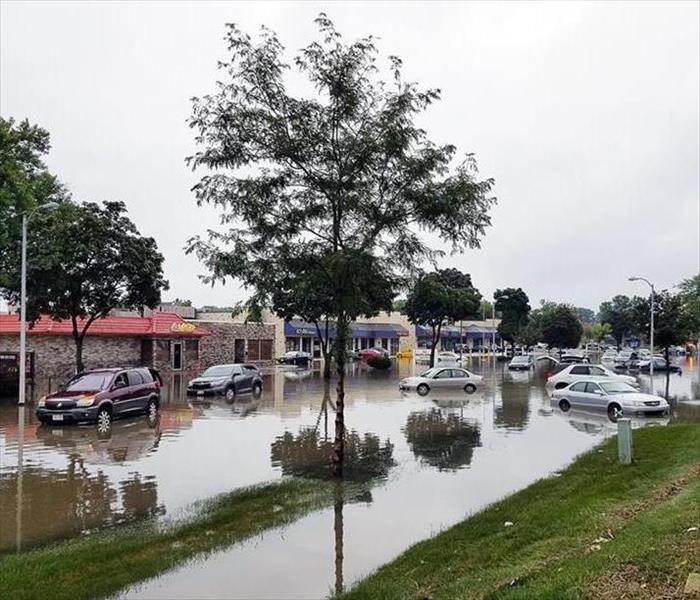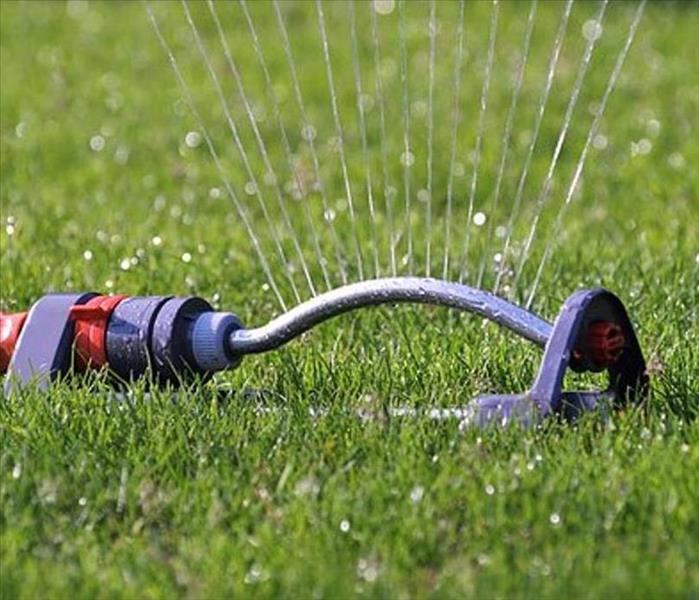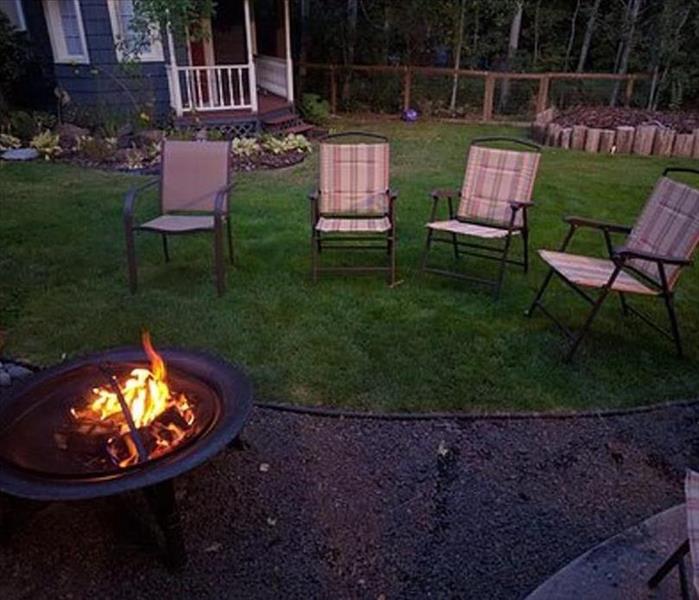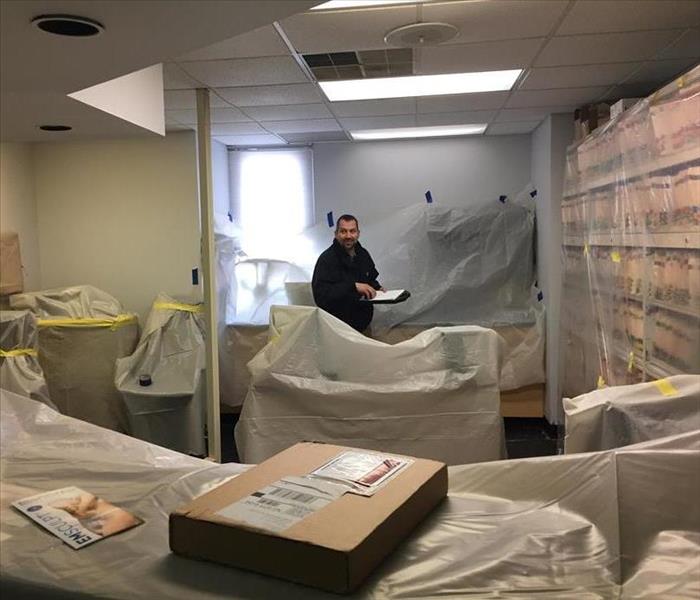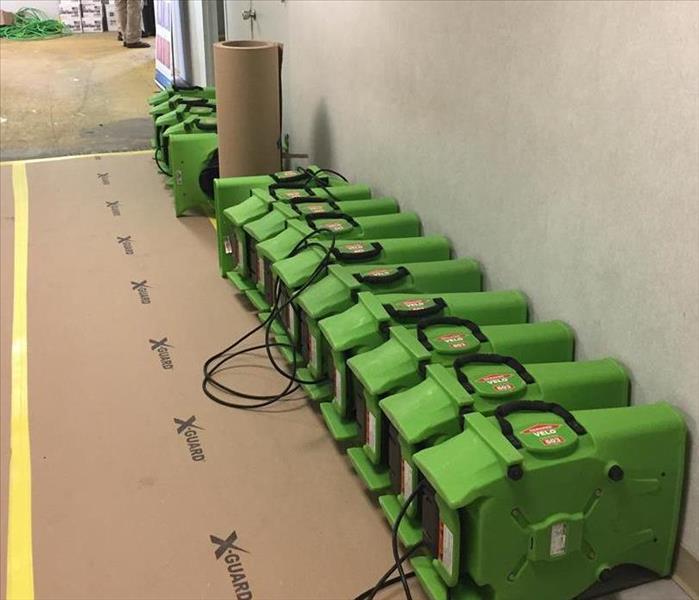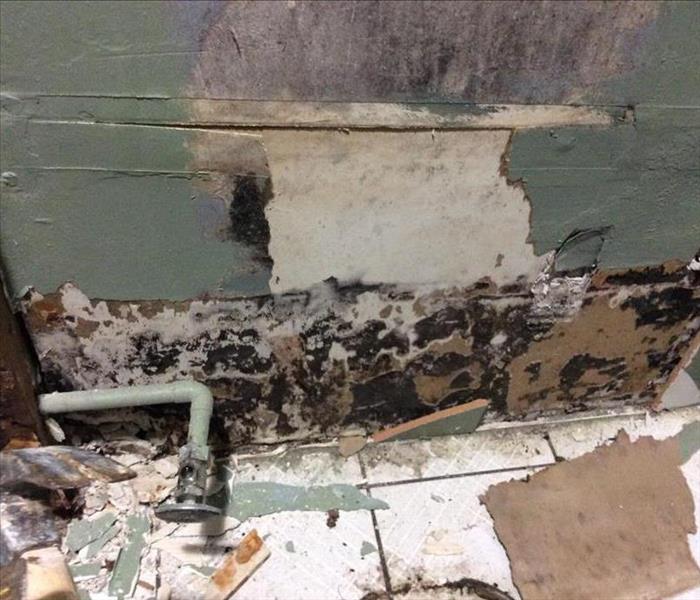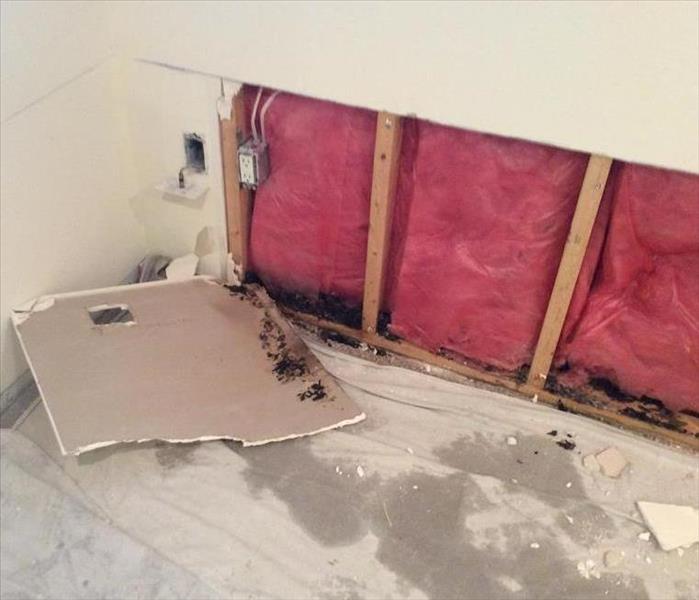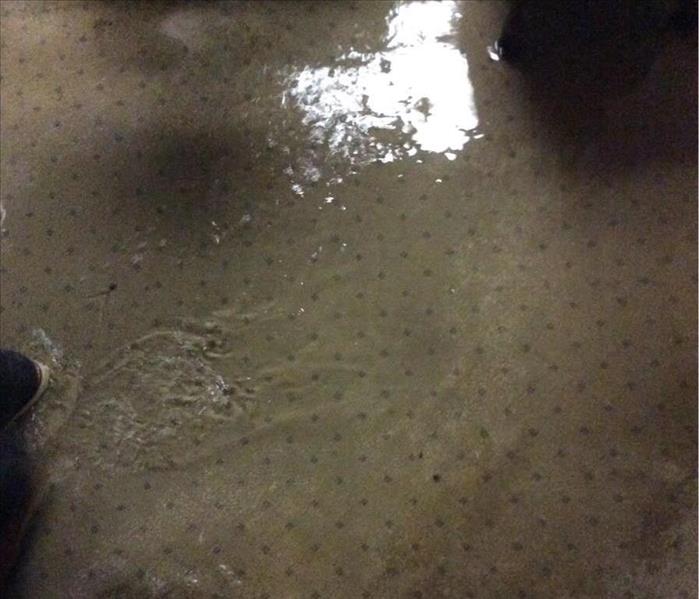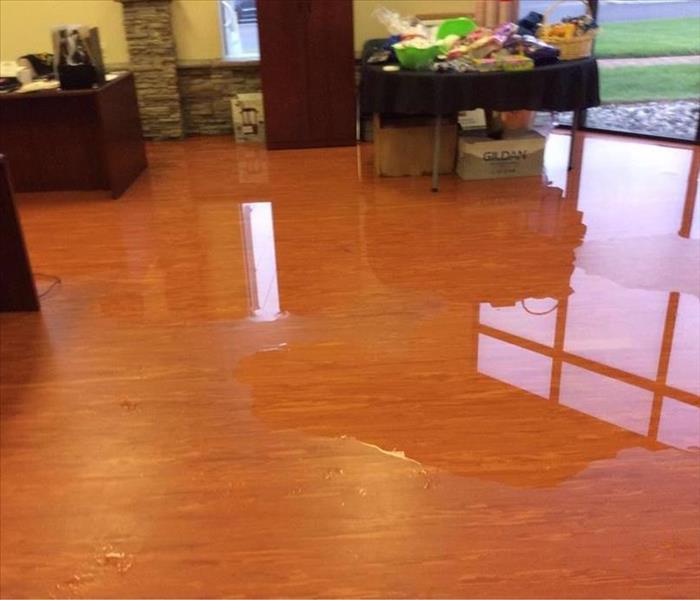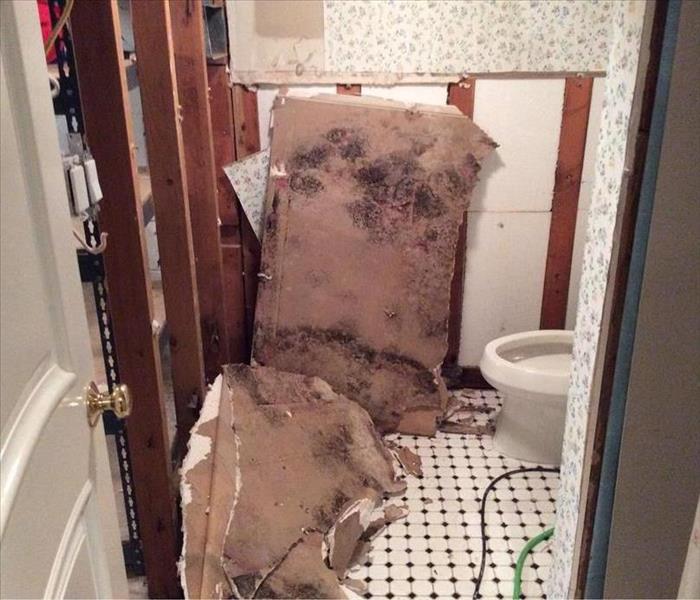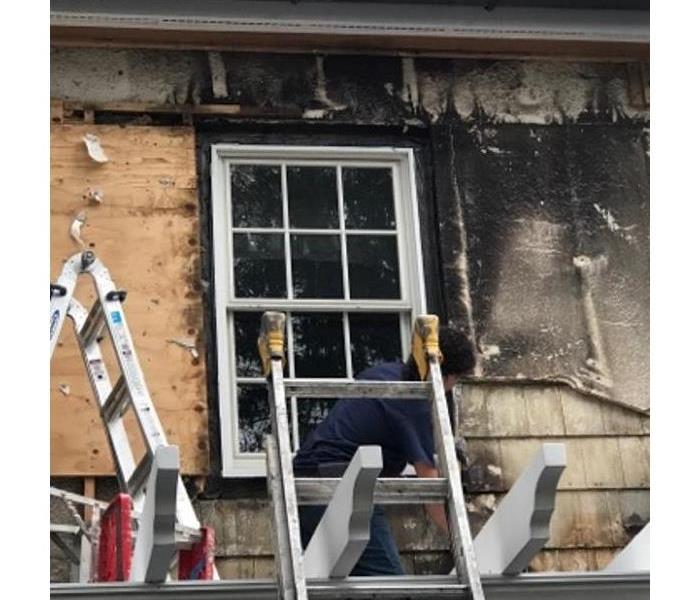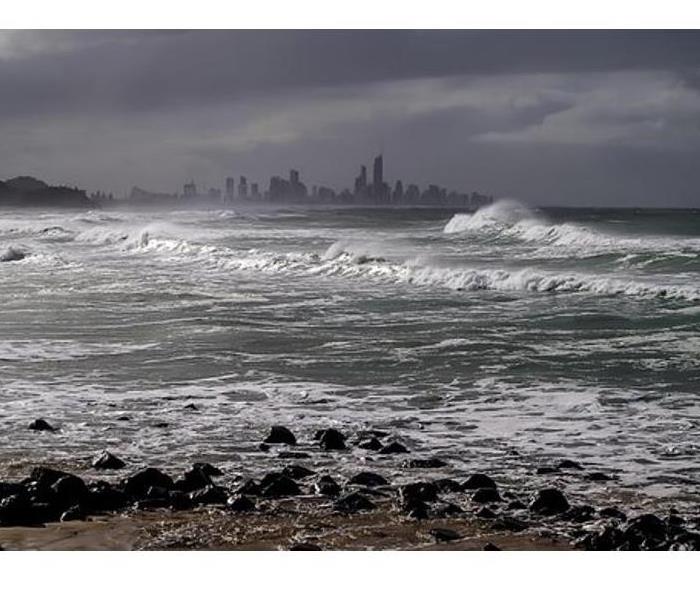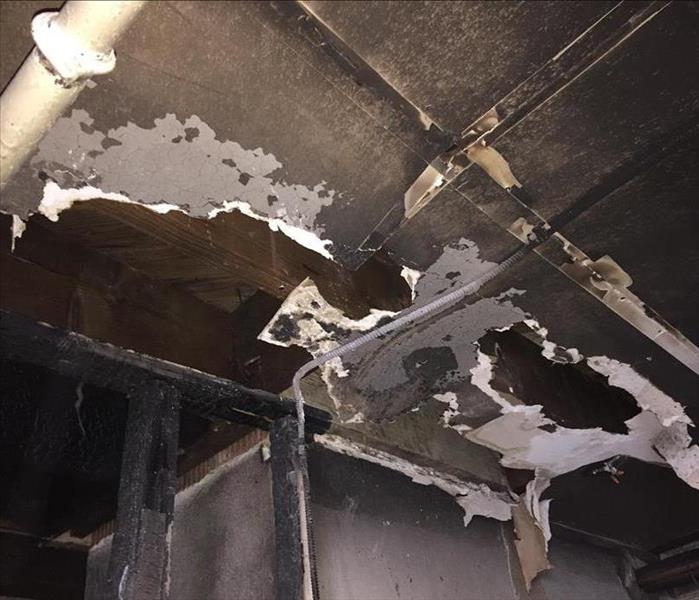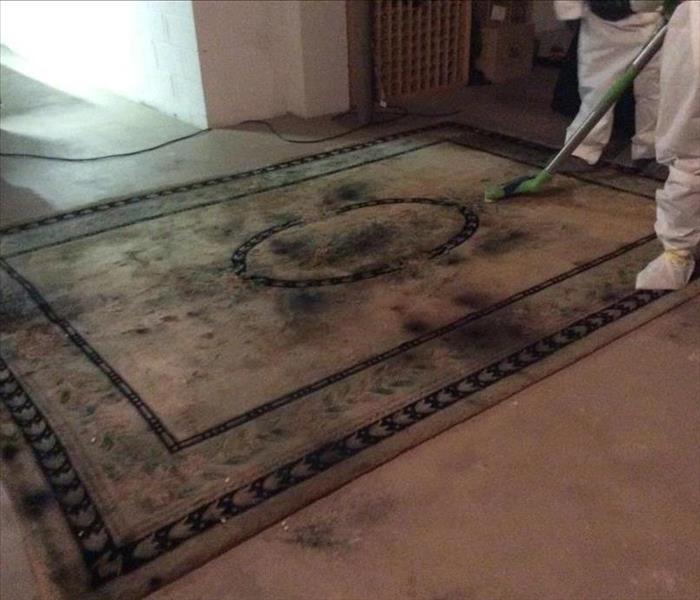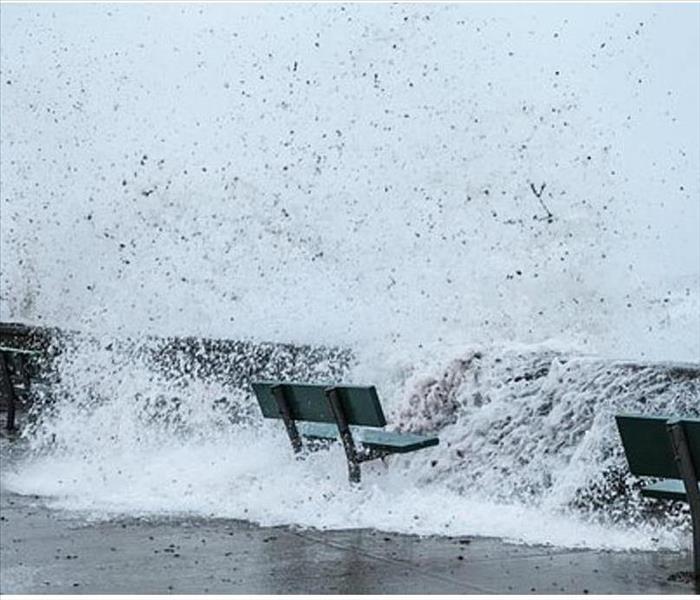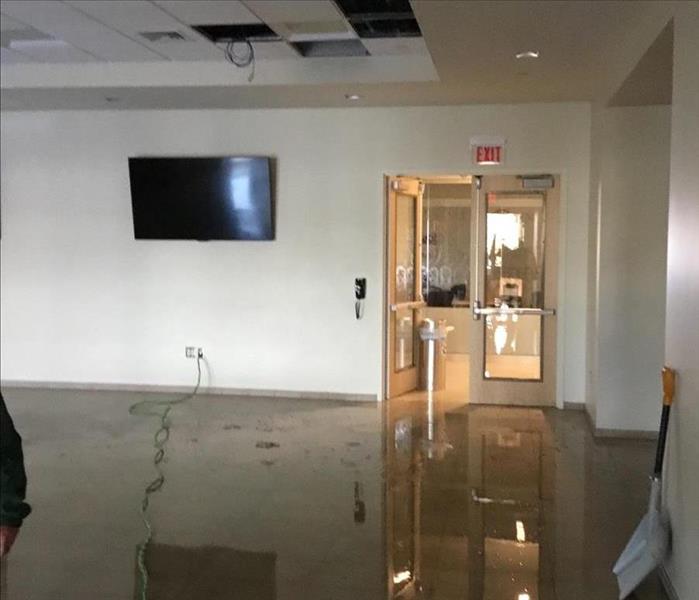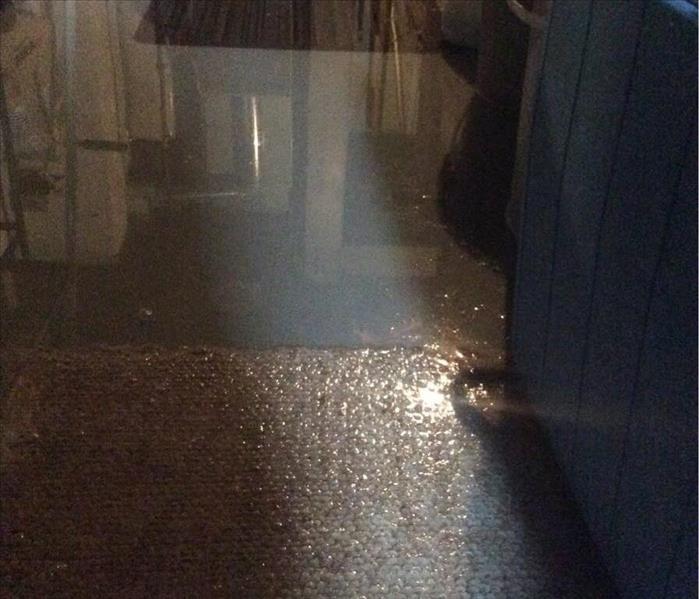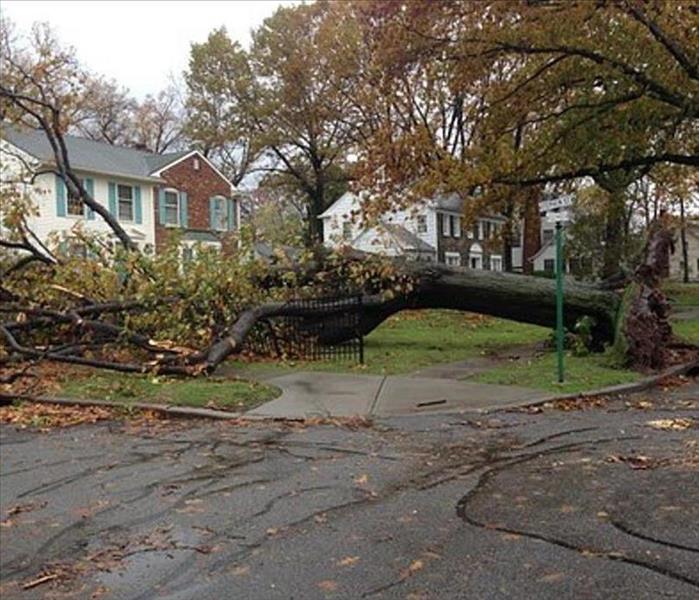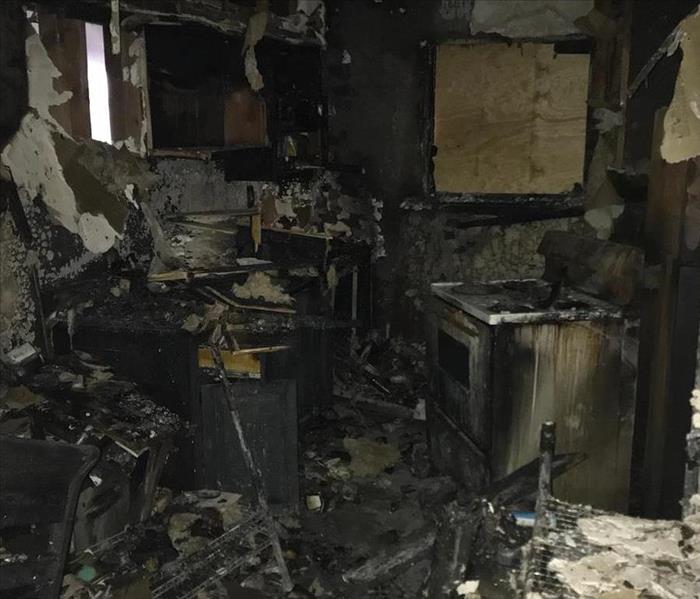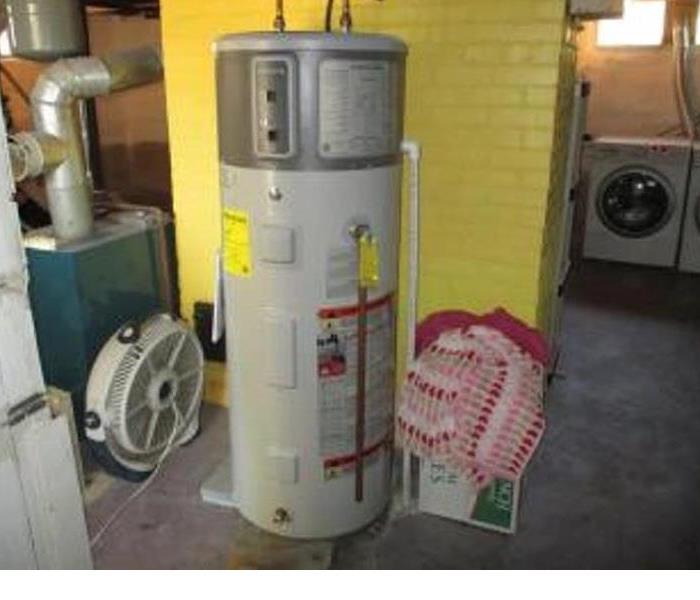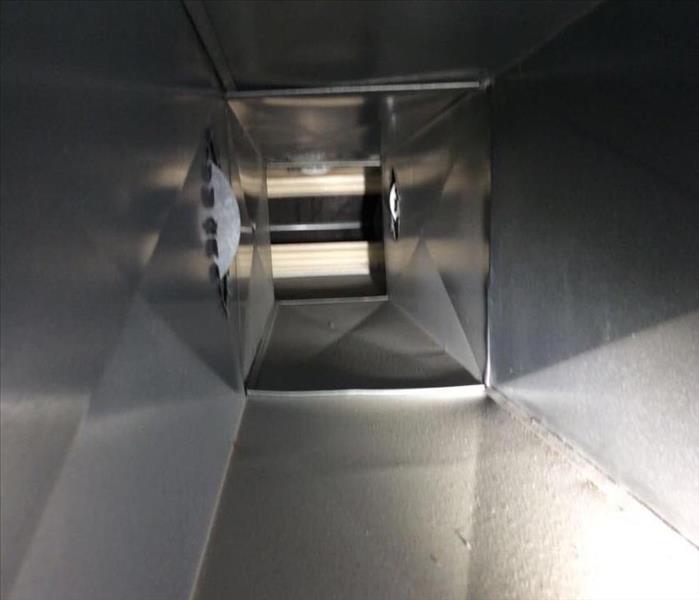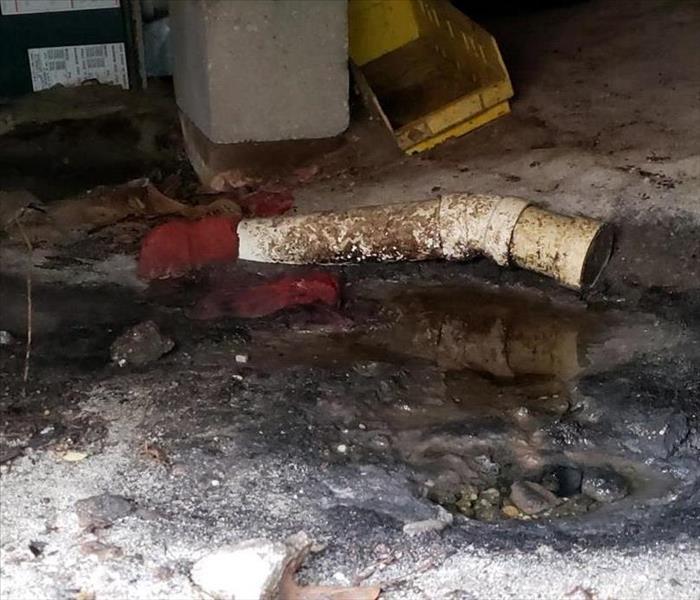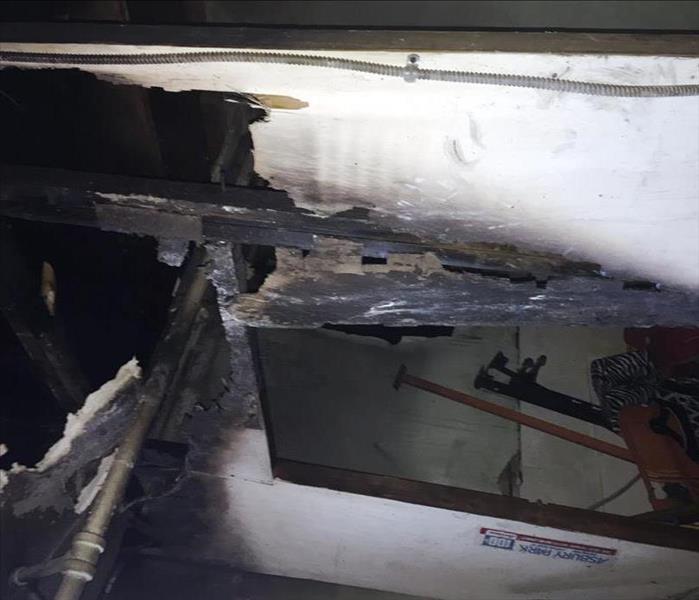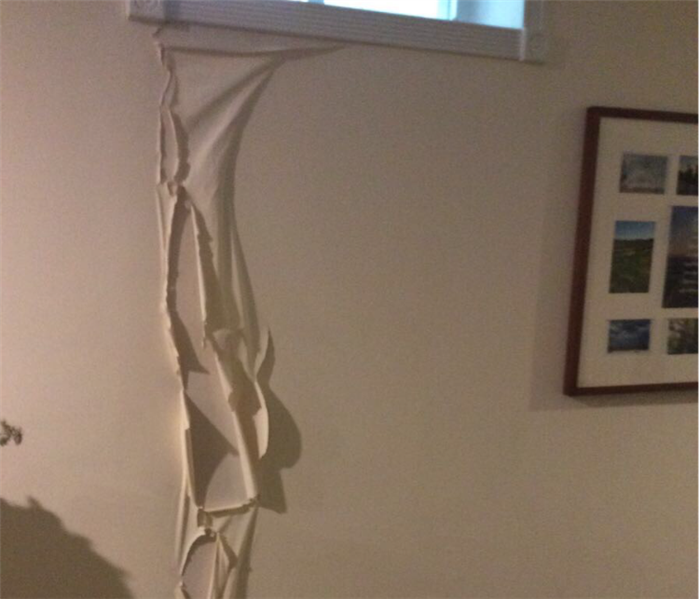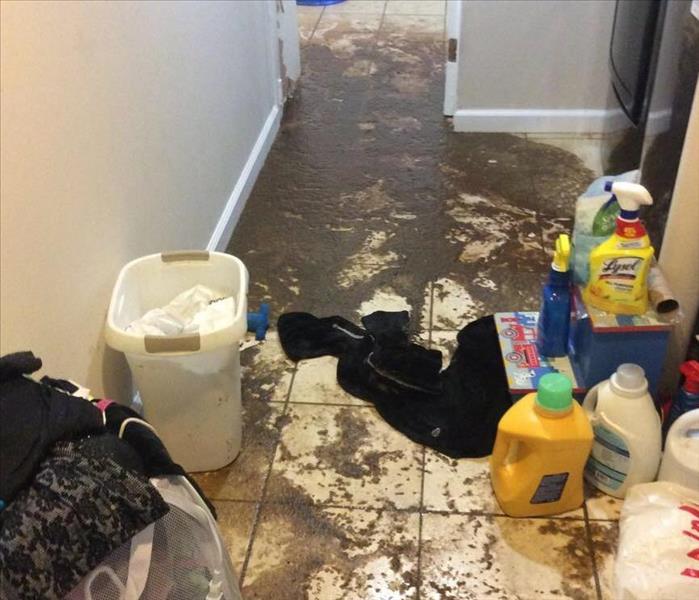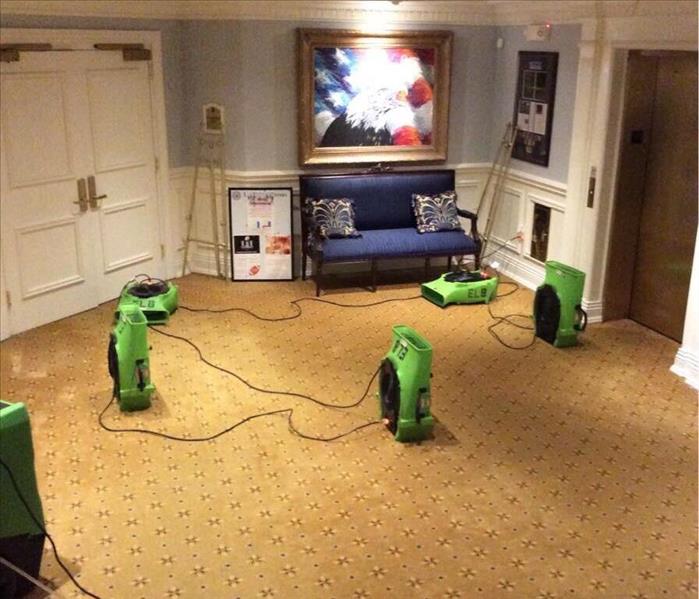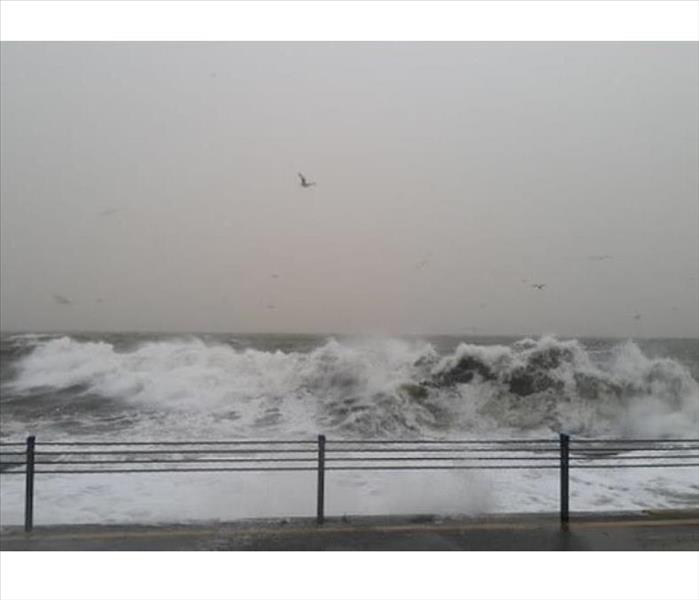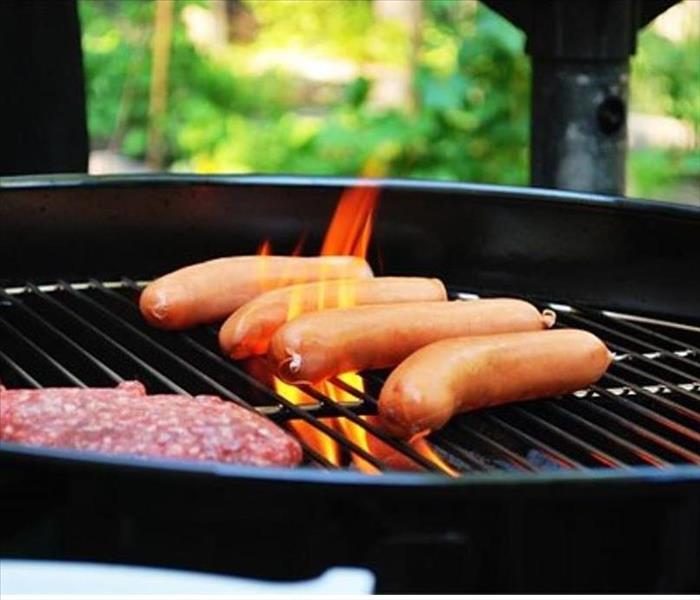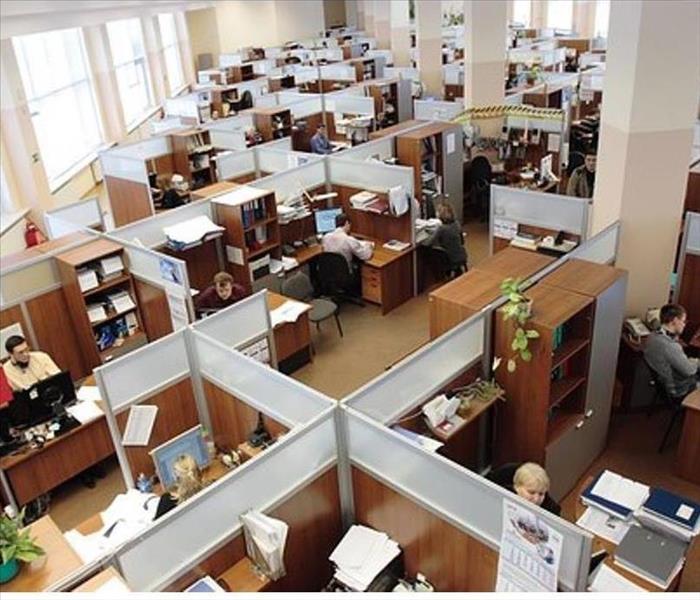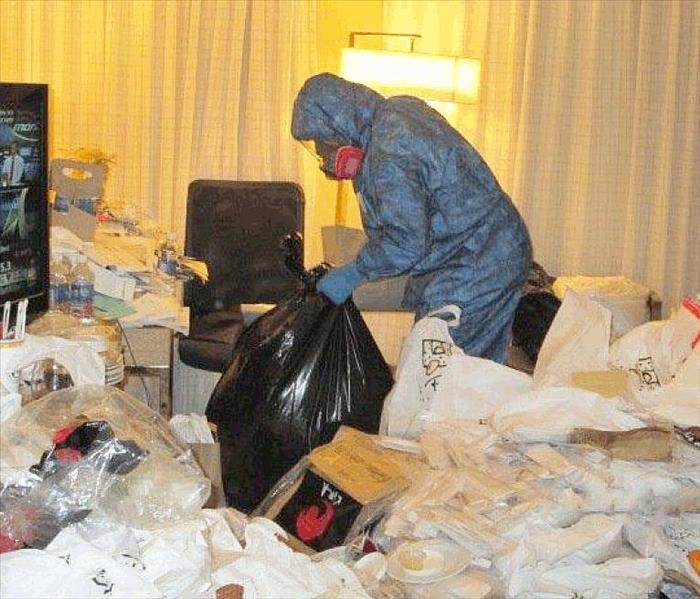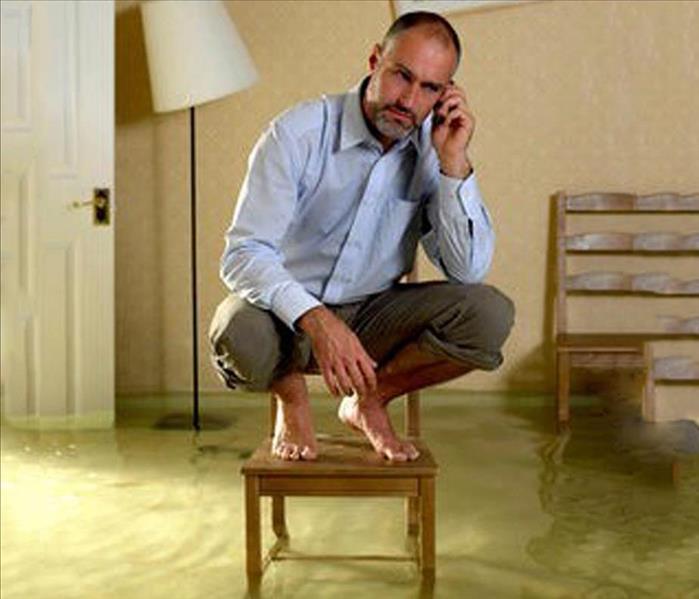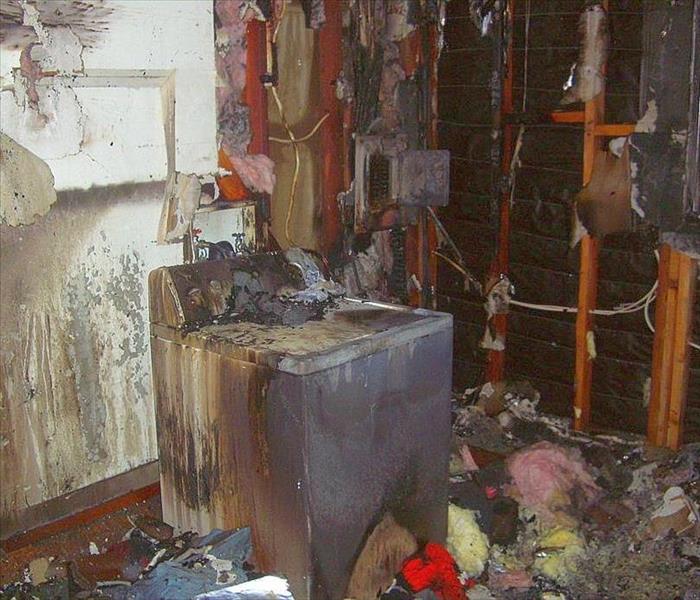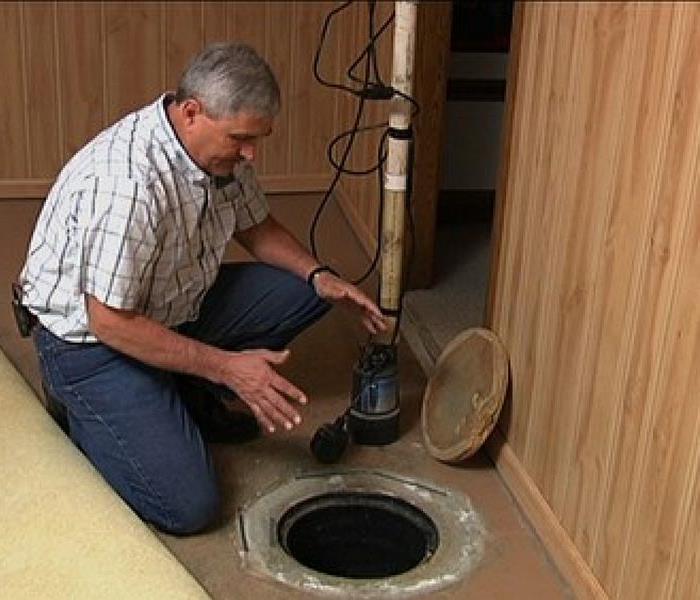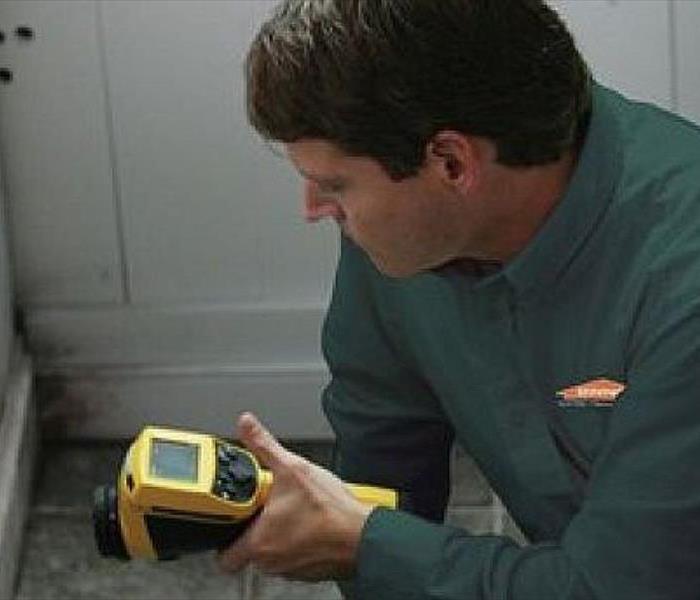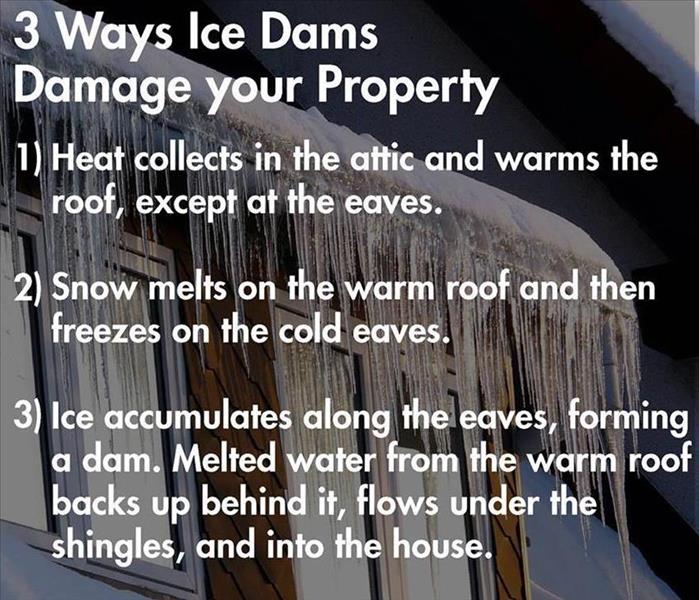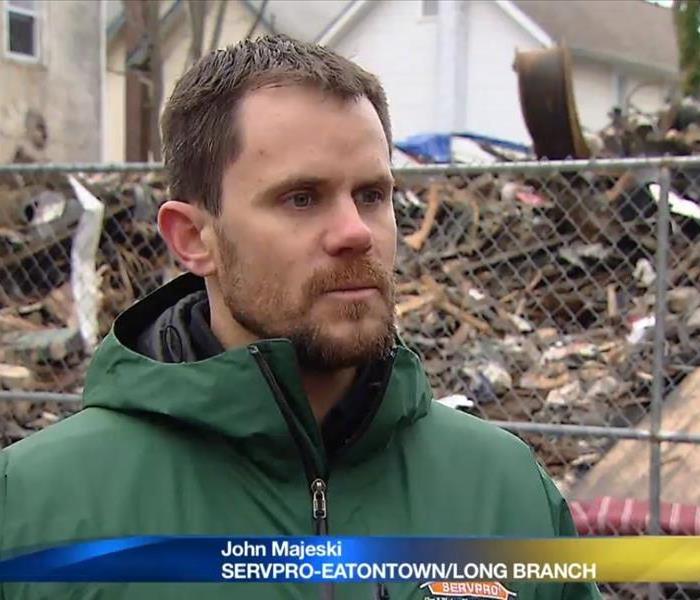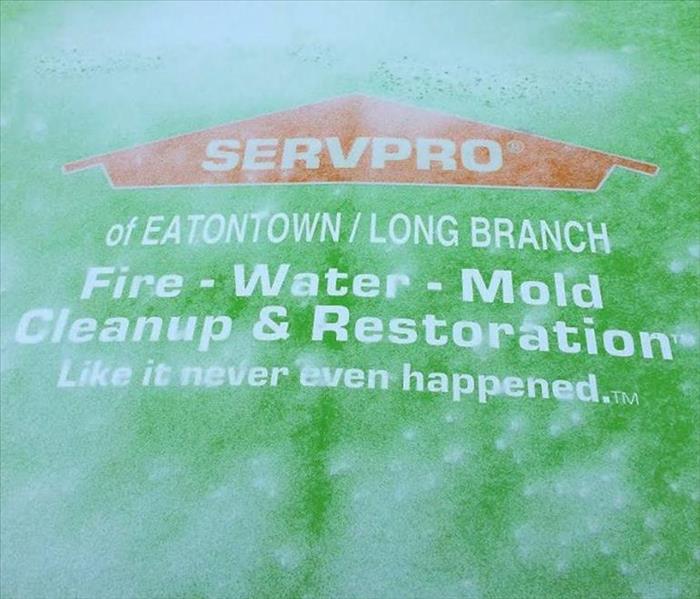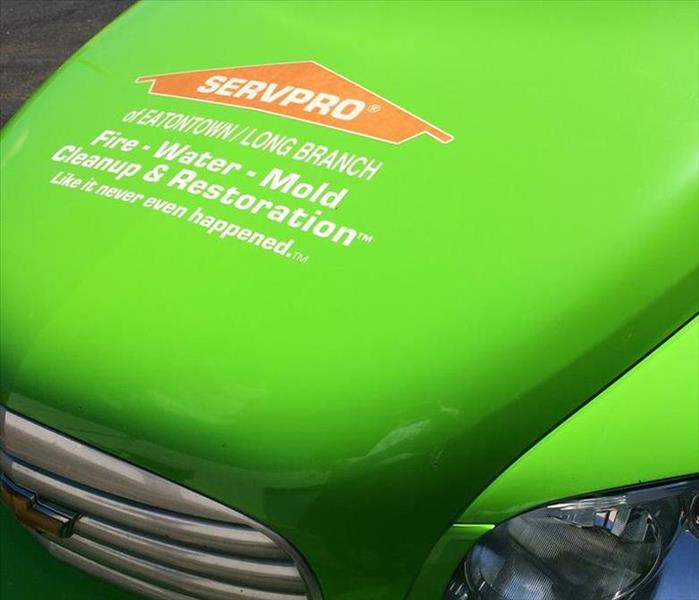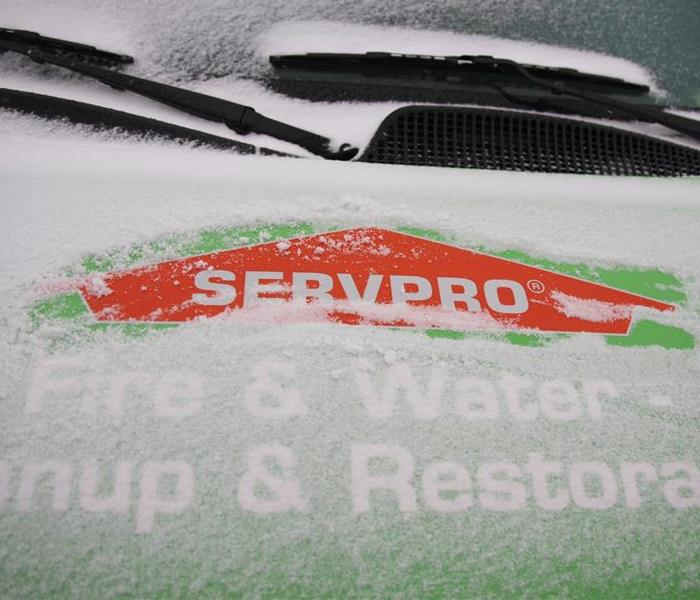Archived Blog Posts
Thunderstorm Preparedness
7/29/2022 (Permalink)
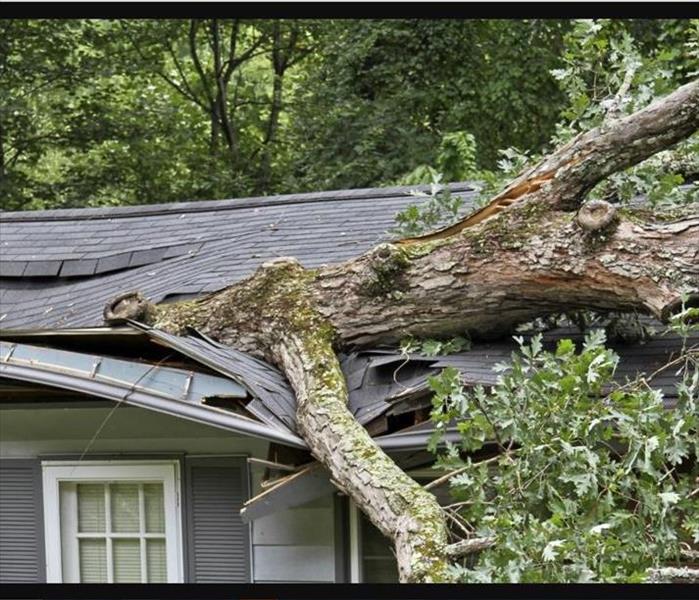 A thunderstorm toppled a tree onto this home.
A thunderstorm toppled a tree onto this home.
Each year, there are close to 100,000 thunderstorms across the nation. These frequent weather events can be scary, bringing strong winds, lightning, hail, and intense rain, all of which can cause personal danger and property damage.
Thunderstorms and tornadoes are not uncommon, even in NJ, especially in the spring and summer months. We must always be prepared for any weather that may come our way.
Your Severe Weather Communication Strategy
Understanding weather terms, particularly the differences between a watch and a warning is the first step in keeping your family safe. By knowing when to wait and when to go, you can clearly communicate with your household and activate the weather plan you have created together.
It is a good idea to have several ways to receive warnings from weather officials. Your cell phone and a weather radio from the NOAA are good tools to have ready when a storm hits.
Create a designated safe area in your house (typically a bathroom or basement) and ensure that everyone in your family knows where it is. A communication plan for your household is also recommended to ensure that everyone can check in during and after a storm. Be sure this plan includes a way for anyone who may not be home at the time of the event to check in so that all can be accounted for. Remember to consider pets. My dog instinctively runs into the bathroom when she hears thunder.
Your Severe Weather Emergency Kit
An emergency kit can be prepared ahead of time and updated throughout the year. It should contain enough water and food for each member of your family to sustain them through 72 hours. First-aid supplies, flashlights, batteries, and any comfort items that can aid in the calming of your household should also be in the kit. While you likely won’t stock the emergency kit with medication you should have some reminders with the kit to prompt you to gather essential medication prior to any evacuation.
Your Severe Weather Aftermath Checklist
Time matters after a storm, so it is essential to take quick action to mitigate losses. You should have a plan in place before a storm strikes so that you can act quickly and get your family to safety. As soon as you can, you should walk your property and assess any damage.
As you walk the property, pay special attention to your roof, windows, and doors to ensure they are still properly sealed and note any water damage that may have occurred.
If your home is damaged, call us at SERVPRO TEAM MAJESKI. We are available 24/7 and can offer you peace of mind after the storm as we make it, “Like it never even happened.”
Power in Numbers
7/29/2022 (Permalink)
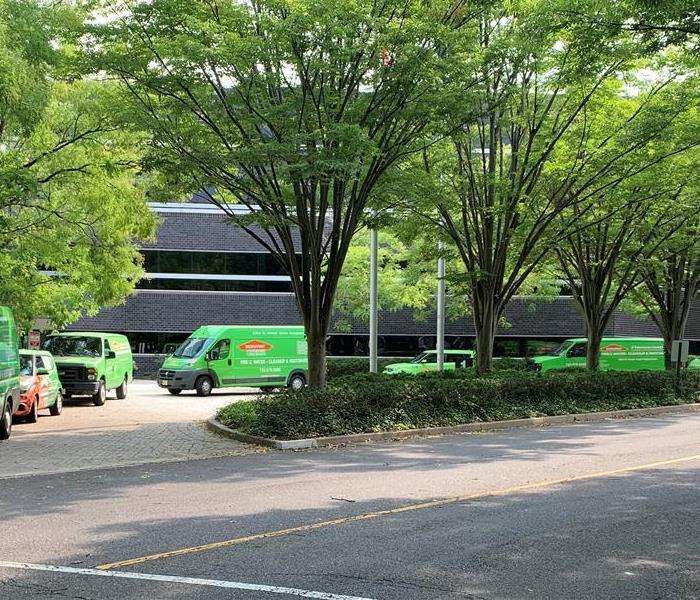 Vans from multiple franchises working on a weekend commercial job.
Vans from multiple franchises working on a weekend commercial job.
When a client in NJ files an insurance claim, insurers know they need to rely on storm, fire, or water damage restoration specialists that are faster to any size disaster. Waiting for help to arrive can quickly lead to additional damage and rising costs. Instead of hoping to hear back from a company, have confidence in immediate assistance by relying on a trusted company that is prepared to help any time of the day.
Multiple Franchises:
SERVPRO TEAM MAJESKI operates 4 franchises across NJ. Overall, SERVPRO has more than 1,700 franchises, which allows its team of professionals to jump into action the minute they get the call. No matter where the disaster happens, commercial services available include:
- Water damage restoration
- Fire damage restoration
- Mold Remediation
- Cleaning services
- Storm and major events
- Disaster recovery
Knowing that your emergency response team means working with professionals from the community also provides additional peace of mind. Being local, we care and are dedicated to ensuring everyone is satisfied with the restoration results. In addition to the local benefits, there is an additional bonus of each franchise being backed by a nationwide network. We work closely with national and local insurance companies, which boosts communication and makes the claim process easier for everyone involved.
Dedicated Professionals
Along with being faster to any size disaster thanks to a 24/7 emergency service, the people arriving at the disaster scene are certified professionals trained in property damage restoration. Along with employee certification training, technicians are required to be certified through the Institute of Inspection Cleaning and Restoration Certification. Training and certification are ongoing to ensure no matter where help is needed, the team answering the call has the latest skills to get a business back “Like it never even happened.”
When clients need help, it is vital to get assistance from a trusted company that is faster to any size disaster to avoid downtime, rising repair costs, and further damage.
TEAM MAJESKI
7/29/2022 (Permalink)
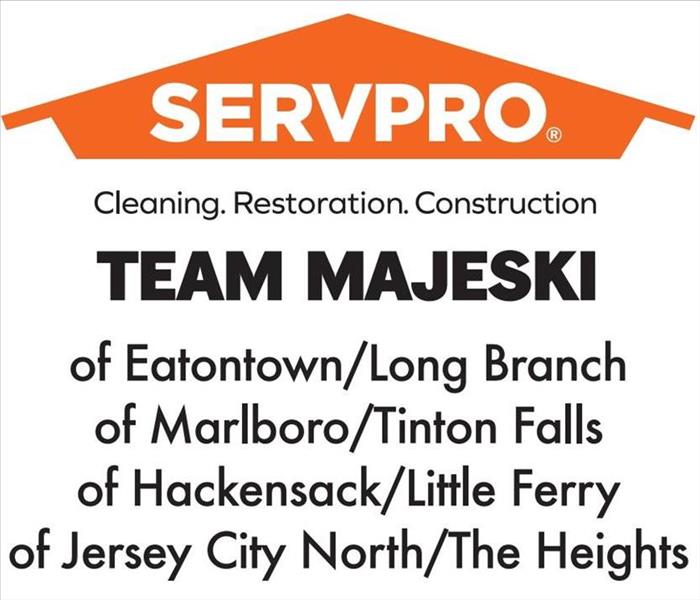 The SERVPRO TEAM MAJESKI logo.
The SERVPRO TEAM MAJESKI logo.
If you're in need of home restoration, SERVPRO TEAM MAJESKI is the best choice for the job! We have a team of experienced professionals who are dedicated to restoring your home or business back to its original condition. We understand that disasters can happen at any time, which is why we offer 24/7 emergency service. We also work with insurance companies to make the process as smooth as possible for you. So, if you're looking for quality service and professionalism, look no further than SERVPRO TEAM MAJESKI!
SERVPRO TEAM MAJESKI includes:
SERVPRO of Eatontown/Long Branch
SERVPRO of Hackensack/Little Ferry
SERVPRO of Jersey City North/The Heights
SERVPRO of Marlboro/Tinton Falls
SERVPRO TEAM MAJESKI is also partnered with most insurance companies, which means we can work directly with your insurance company to help you through the restoration process. We will work with you every step of the way to make sure you are satisfied with the service we provide
Please contact us today! We would be happy to answer any questions you may have. We look forward to hearing from you soon!
The Challenge with Mold Sampling
5/27/2022 (Permalink)
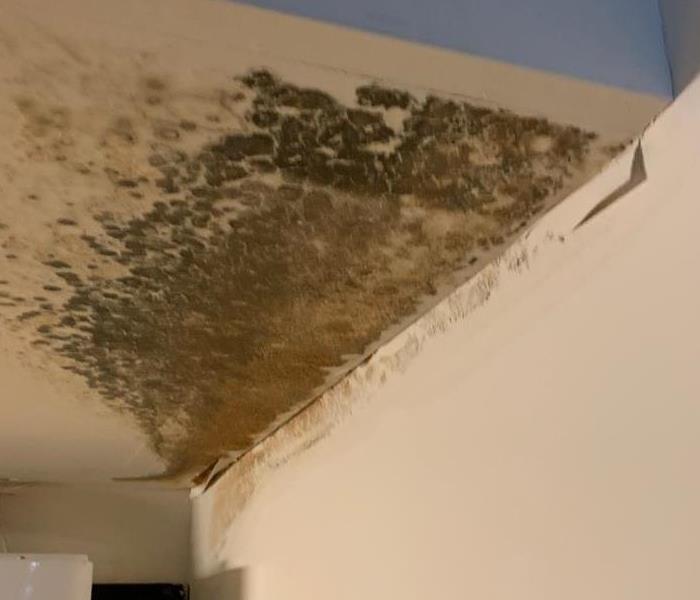 Noticeable mold growth in the home.
Noticeable mold growth in the home.
The Challenge with Mold Testing or Sampling
Is sampling for mold needed?
In most cases, if visible mold growth is present, sampling is unnecessary. Since no EPA or other federal limits have been set for mold or mold spores, sampling cannot be used to check a building's compliance with federal mold standards. Surface sampling may be useful to determine if an area has been adequately cleaned or remediated. Sampling for mold should be conducted by professionals who have specific experience in designing mold-sampling protocols, sampling methods, and interpreting results. Sample analysis should follow analytical methods recommended by the American Industrial Hygiene Association (AIHA), the American Conference of Governmental Industrial Hygienists (ACGIH), or other professional organizations.
Are there federal regulations or standards regarding mold testing?
Standards or Threshold Limit Values (TLVs) for airborne concentrations of mold, or mold spores, have not been set. Currently, there are no EPA regulations or standards for airborne mold contaminants.
Please note that SERVPRO does not conduct mold testing. We are specialists in the remediation of mold and believe that separating mold detection and its remediation eliminates any potential conflict of interest. Call us today for a free consultation.
Drying hard wood floors
5/27/2022 (Permalink)
 Water damage from the bathroom flooded this bedroom but the floor was able to be dried and did not require replacement.
Water damage from the bathroom flooded this bedroom but the floor was able to be dried and did not require replacement.
Water damage to hardwood floors can be tricky. SERVPRO has the ability and equipment to save your hardwood floors if it is addressed quickly. After our technicians have accessed the loss and determined that the hardwood floors can be saved, will set up our specialized equipment. Insurance companies and adjusters like it when we can save the floors because it is more cost-effective which in turn keeps down premiums. The floor drying mat system removes the excess water from underneath the hardwood floors. Stabilization takes between two to six days but in some cases may take longer. The goal is to remove the visible cupping and to get as close to appropriate equilibrium moisture content without overdrying. If you encounter water damage and your wood floors are affected, please call SERVPRO for a free consultation. We will respond quickly and help you with your loss and make it, “Like it never even happened.”
Commercial Carpet Cleaning
5/27/2022 (Permalink)
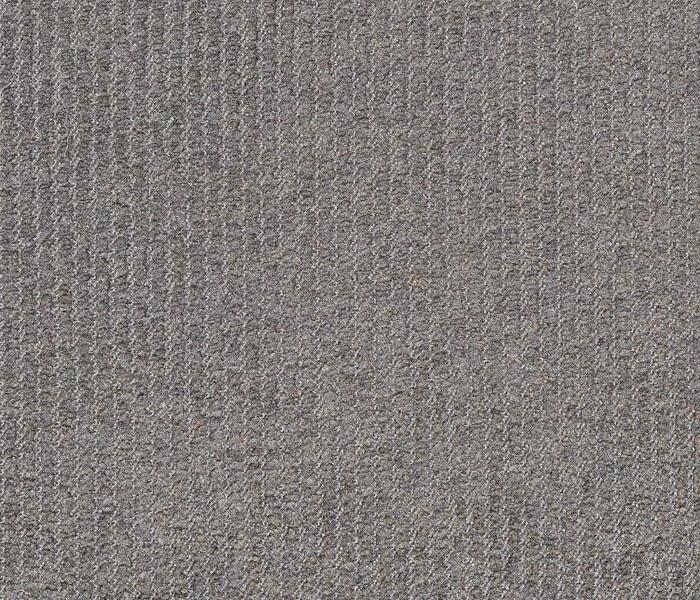 Commercial carpet beginning to show signs of wear.
Commercial carpet beginning to show signs of wear.
Routine carpet cleaning is important to commercial buildings because carpets act as a filter, trapping dirt, dust animal hair, and basically anything you walk on outside the building. Manufactures suggest the following:
- If you have a spill attend to the stain as soon as possible because the longer the stain stands the harder it will be to remove later
- Buying a good vacuum and vacuum regularly so the soils don’t build-up
- Maintenance carpet cleaning in light soil rating = 1-2 times annually, medium soil rating = 6-12 times annually and heavy soil rating = 12-52 times annually
Clean carpets also allow for a healthier work environment, maintain the value of the property and send a message to your clients/customers that you take pride in your company and that shows them you will do the same for them. If you would like to set up a carpet cleaning maintenance schedule please call us.
Tornado Prep
4/22/2022 (Permalink)
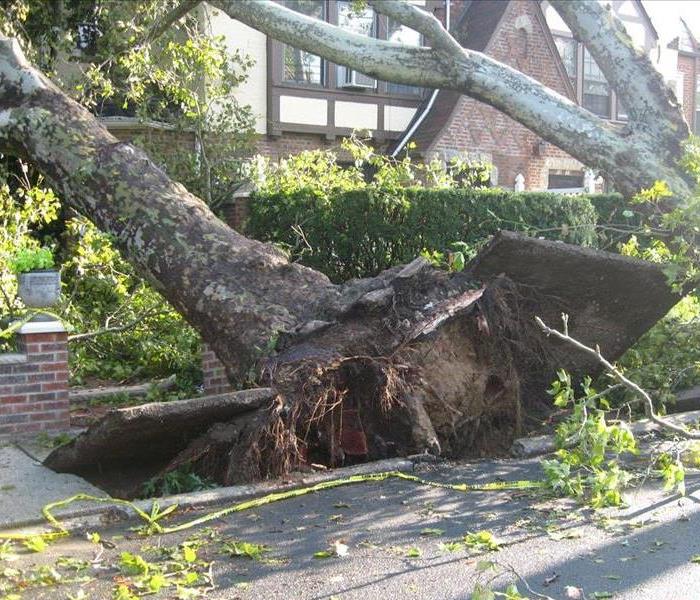 An NJ tree was knocked over by a tornado.
An NJ tree was knocked over by a tornado.
I don’t remember hearing tornado warnings when I was younger. Tornadoes were a phenomenon found in far-off places like Kansas. However, over the past couple of years, tornado warnings have become common and some devastating tornadoes have hit NJ in the past year. Is this the result of global warming? Like everything these days that seems to be a political question, but the fact remains that it is a new threat that NJ residents and business owners now need to consider.
IF YOU ARE UNDER A TORNADO WARNING, FIND SAFE SHELTER RIGHT AWAY AND REMEMBER THESE TIPS:
- Go to a safe room, basement, or storm cellar. If there is no basement, get to a small, interior room on the lowest level.
- Stay away from windows, doors, and outside walls.
- If you can safely get to a sturdy building, do so immediately.
- Do not get under an overpass or bridge. You’re safer in a low, flat location.
- Watch out for flying debris that can cause injury or death.
- Use your arms to protect your head and neck.
After the storm has passed:
- If you are trapped, cover your mouth with a cloth or mask to avoid breathing dust. Try to send a text, bang on a pipe or wall, or use a whistle instead of shouting.
- Stay clear of fallen power lines or broken utility lines.
- Do not enter damaged buildings until you are told that they are safe.
- Save your phone calls for emergencies. Phone systems are often down or busy after a disaster. Use text messaging or social media to communicate with family and friends.
- Be careful during clean-up. Wear thick-soled shoes, long pants, and work gloves.
Of course, the SERVPRO Ready Plan APP will also prove invaluable if a disaster does occur. Download it from the App Store today.
How to use a Fire Extinguisher
3/31/2022 (Permalink)
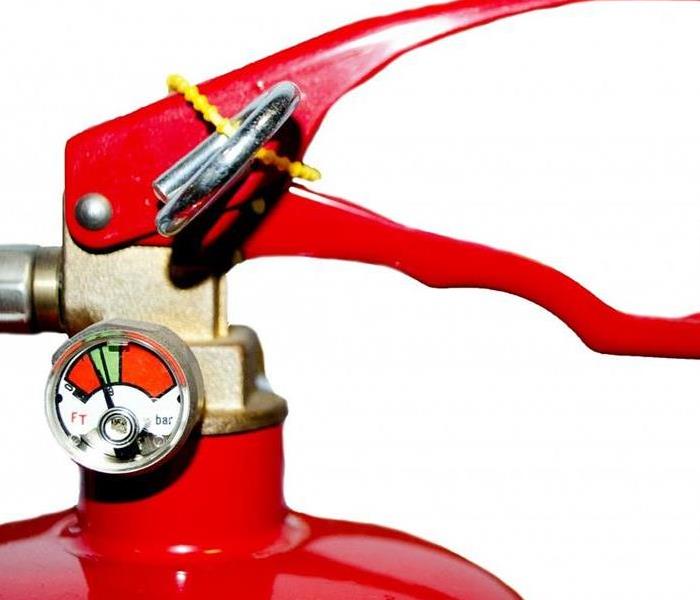 A close-up look at a fire extinguisher handle.
A close-up look at a fire extinguisher handle.
In a prior blog, we discussed the acronym R.A.C.E. which represents the steps to take in care of a fire. Those steps are Rescue, Alarm, Contain, and Extinguish. Another acronym used in training for a fire response is P.A.S.S. which stands for Pull, Aim, Squeeze, and Sweep. These are the steps for using a fire extinguisher.
First, you want to make sure you have the correct fire extinguisher. In most settings, an ABC class extinguisher is most common. An ABC extinguisher puts out most fires including:
Class A fires – common materials including wood which typically produce Ashes.
Class B fires – flammable liquids that are typically stored in a Barrel, such as gasoline.
Class C fires – electrical fires that have an electrical Current
Fires that require a more specialized type of extinguisher include class D fires which are flammable metal or class K fires which are high temperature cooking oil fires.
The steps for using a fire extinguisher are:
P: Pull the pin that prevents the extinguisher from discharging accidentally.
A: Aim the nozzle at the base of the fire
S: Squeeze the handle/trigger to discharge the extinguishing agent
S: Sweep the nozzle back and forth to cover the burning material
Team Majeski
3/31/2022 (Permalink)
 John Majeski is the owner of 3 SERVPRO franchises in NJ.
John Majeski is the owner of 3 SERVPRO franchises in NJ.
Why SERVPRO of Eatontown/Long Branch ?
SERVPRO of Eatontown/Long Branch was the first SERVPRO franchise of owner John Majeski. John currently owns 3 SERVPRO franchises across NJ serving clients from New York to South Jersey. The expanding team allows us to have both redundancy and specialized resources.
Redundancy is important because disasters often happen all at once, such as a cold spell or severe storm. Our ability to move resources and personnel around the state allows us to respond quickly even when there is a large demand for services.
Specialization is also important because many pieces of equipment are extremely expensive. A single franchise would have a hard time justifying a major purchase, such as a dry ice blaster. The ability to share resources amongst the Team Majeski franchises allows us greater capability.
Finally, being part of the national SERVPRO brand allows us to call on the resources of our corporate disaster response teams in the case of a major disaster. Our teams also respond to these calls as we did last year when we sent multiple teams to Texas.
Large or small, when a disaster strikes, count on the SERVPRO franchises of Team Majeski to make it “Like it never even happened.”
Commercial Mold Prevention
3/31/2022 (Permalink)
 SERVPRO vans outside an NJ facility on a Saturday morning.
SERVPRO vans outside an NJ facility on a Saturday morning.
Mold growth is NOT a new subject. In fact, many commercial structures end up closing their doors to business for months due to mold contamination. That is why in any large facility the importance of maintaining that facility to deter water leaks, moisture problems, and poor air quality should be the main focus.
Most mold growth is discovered after we get called to remediate a water issue, and we discover it growing behind removed material such as sheet rock, sink vanities, cabinetry, etc. In many instances, the mold growth has gone undetected for months, if not years.
According to the Environmental Protection Agency, the key to mold control is moisture control. Solve moisture problems before they become mold problems.
Mold Prevention Tips
- Fix leaky plumbing and leaks in the building as soon as possible.
- Watch for condensation and wet spots.
- Prevent moisture due to condensation by increasing surface temperature or reducing the moisture level in the air (humidity). To increase surface temperature, insulate or increase air circulation. To reduce the moisture level in air, repair leaks, increase ventilation (if outside air is cold and dry), or dehumidify (if outdoor air is warm and humid).
- Keep heating, ventilation, and air conditioning (HVAC) drip pans clean, flowing properly and unobstructed.
- Vent moisture-generating appliances, such as dryers, to the outside where possible.
- Maintain low indoor humidity, below 60% relative humidity (RH), ideally 30-50%, if possible.
- Perform regular building/HVAC inspections and maintenance as scheduled.
- Clean and dry wet or damp spots within 48 hours.
- Don't let foundations stay wet. Provide drainage and slope the ground away from the foundation.
Potential health concerns are also an important reason to prevent mold growth and to remediate/clean up any existing indoor mold growth.
Obviously staying on top of moisture issues is the key to keeping mold under control.
Should your commercial building need mold remediation, remember that SERVPRO has specially trained technicians that can handle the job. No job is too large or small, and we are available 24/7.
What to do in case of a fire
3/30/2022 (Permalink)
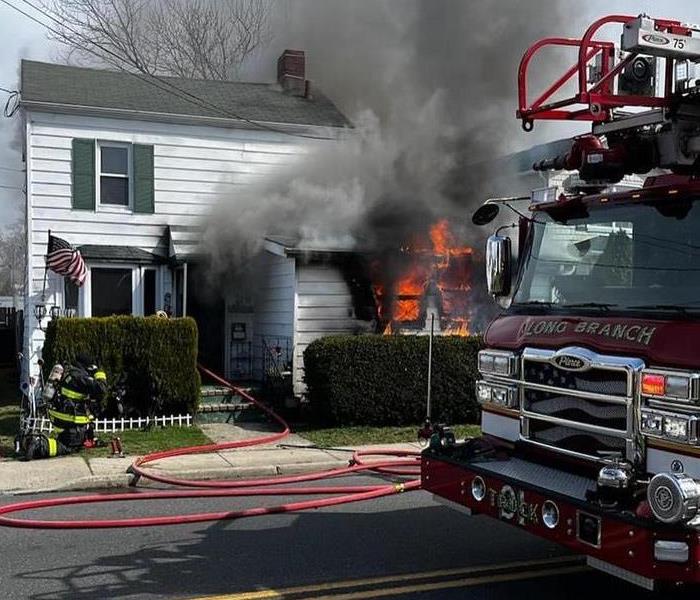 The Long Branch, NJ fire department fights a house fire on Patten Ave., March 28, 2022.
The Long Branch, NJ fire department fights a house fire on Patten Ave., March 28, 2022.
What should you do if you encounter a fire in your home or business? The common acronym R.A.C.E. provides some helpful guidelines. This stands for Rescue, Alarm, Contain, and Extinguish. These are the priority actions that should be taken. Unfortunately, they are often not followed in a panic as people typically try to fight the fire themselves, which costs precious time.
Rescue – The priority is life safety. Smoke and other deadly products of combustion can incapacitate an individual with just a few breaths. The top priority is rescuing anyone who is in personal danger.
Alarm – Sound the alarm by hitting the fire button on your alarm system or calling 911. A fire doubles in size every 45 seconds so alerting the fire department to begin their response is your second priority.
Contain – Stopping the spread of the fire is even more important than trying to extinguish the fire. Closing doors is a simple and effective way of stabilizing the scene and limiting fire spread. Moving a car away from a burning shed or using a garden hose to spray the vinyl siding next to a grill fire can likewise stop the fire from spreading and causing significantly more damage. All of these actions should only be attempted if they can be done safely.
Extinguish – Only after the first three actions have been completed should you attempt to extinguish the fire. Again, only if it can be done safely. Keep in mind that different types of fires (electrical, grease, gas-fed) may require special techniques to extinguish. At a minimum, every home and business should have an ABC class fire extinguisher handy as this is the most versatile type of extinguisher.
Of course, once the fire is extinguished, call SERVPRO because a quick response and immediate action can reduce the extent of smoke, water, and other damage.
Retail Floor Remediation
2/28/2022 (Permalink)
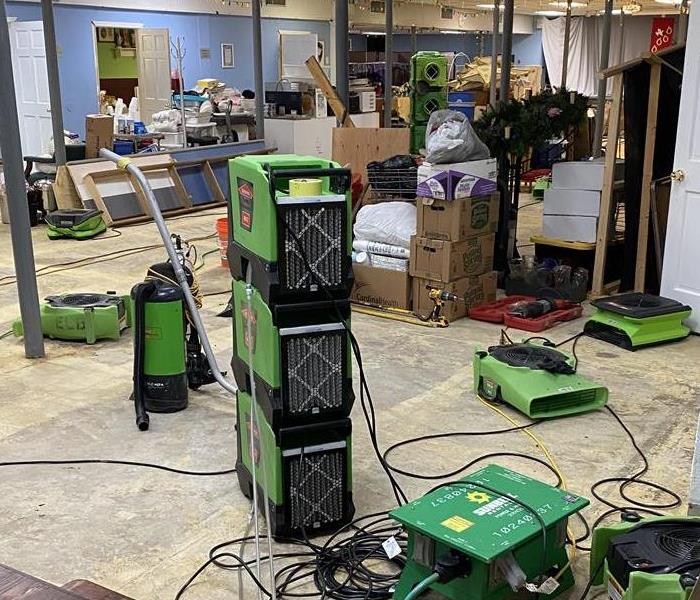 This recent job was caused by sewage backup.
This recent job was caused by sewage backup.
If your retail store suffers a water leak or flood, you must call SERVPRO as soon as possible. The faster we arrive, the more quickly we can take action to get your shop back to preloss condition so you can resume operating.
One of the essential steps in fixing water damage in your NJ business is removing water from the carpets. Some of the issues with wet carpets include:
- Causing delamination and requiring replacing.
- Preventing you from re-opening your store.
- Providing a potential breeding ground for mold
Our teams have a range of tools to help with water extraction. We have truck-mounted and freestanding pumps to deal with large puddles of water, even if your business has multiple stories. We have small, light carpet wands for vacuuming water from the carpets’ surface and getting into remote areas. We also have extraction tools that rely on the weight of our technician standing on them to press the water out of the carpet.
It is often possible to save carpets from water damage with thorough drying.
Tools for extracting storm water
2/28/2022 (Permalink)
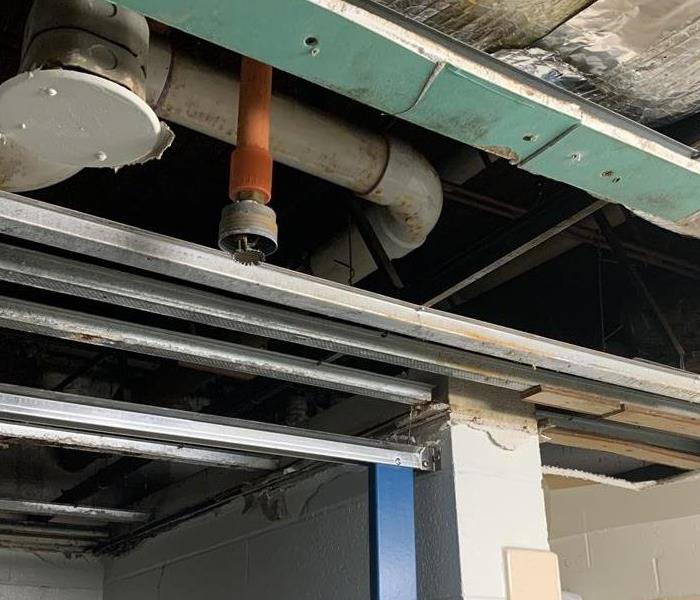 This NJ business was damaged by a water leak.
This NJ business was damaged by a water leak.
How Multiple Extractors Can Help Flooded NJ Properties
Effective water removal after a flood requires multiple extraction devices. These disasters can occur in both natural rising water levels and through the structural breaches that can plague homes and businesses after severe weather events. Considering the harsh Nor’easters we get in NJ, restoration teams should stay prepared to respond quickly with the equipment to help.
The need for flood removal in NJ residences is an immediate concern that follows these disasters and does not readily subside on its own. Many factors come into play when standing water exists. Choosing extraction equipment relates to the depth of the standing water, the materials exposed, the location of this damage, and the availability of power for the chosen equipment. Each of these factors can point our SERVPRO technicians to the appropriate extraction tools for the job.
In many cases, successfully removing all standing water from your property involves the use of more than one extracting tool or pump. Even in situations where we use powerful machines like the truck-mount or self-priming pumps to remove standing water, the intake hoses for these machines are not rated to work well when the depth of pooling water drops under two inches. Once this occurs and there is a noteworthy decrease in constant water draw, other units must pick up the remaining water.
Smaller and more portable units such as our wet-vacs with extraction wands can help to remove water once the overall depth drops below this critical two-inch margin. Eliminating as much of the standing water as feasible helps later drying with air movers and dehumidifiers to become more effective and efficient, so we remove as much pooling water and excessive moisture as possible with our light wands.
Flooding can be a devastating situation for many area homes after a severe weather event, but our SERVPRO of Eatontown/Long Branch team can help. We have multiple extraction units to help rapidly dry your property and make it “Like it never even happened.”
Fire Prevention in Commercial Spaces
2/28/2022 (Permalink)
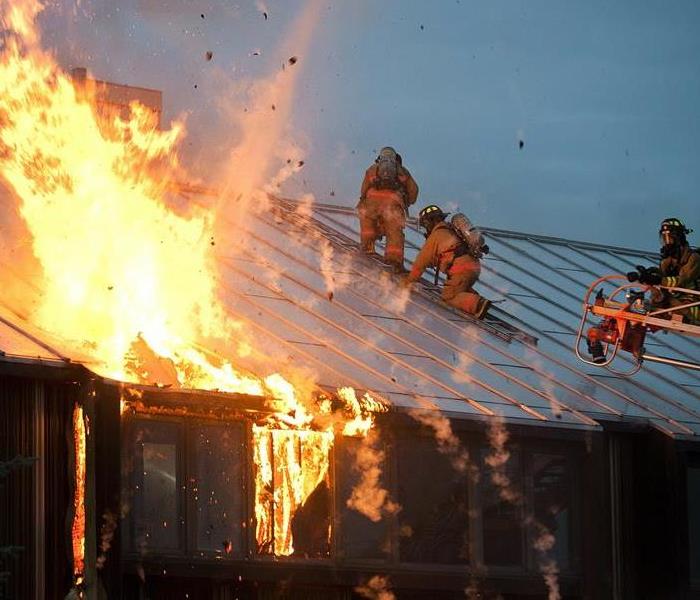 Firefighters working on the roof at a commercial fire.
Firefighters working on the roof at a commercial fire.
Fire Safety in the workplace is important all year round and our team here at SERVPRO of Eatontown/Long Branch would like to review workplace fire prevention & safety.
Here is a top-10 of tips to ensure a fire-safe workplace:
Step 1. Get Organized– Practice good workplace housekeeping. Clutter contributes to fires by providing fuel and by preventing access to exits and emergency equipment.
Step 2. Designated Smoking Areas – Smoke only in designated areas and extinguish smoking materials safely. Never smoke in storerooms or chemical storage areas.
Step 3. Fire Extinguishers – Maintaining the appropriate type and number of fire extinguishers and learning how to properly use a fire extinguisher.
Step 4. Electrical Hazards – Report all electrical hazards. Many fires start in faulty wiring and malfunctioning electrical equipment.
Step 5. Access to Control Panels – Electrical control panels need to have free access maintained so that the electricity could be shut off easily.
Step 6. Sprinkler Systems & Smoke Detectors – Never block sprinklers, firefighting equipment, or emergency exits. Observe clearances when stacking materials. Test sprinkler systems and smoke detectors at least annually.
Step 7. Chemical Safety – Use and store chemicals safely. Read the label and the Safety Data Sheet to determine flammability and other fire hazards. Provide adequate ventilation when using and storing these substances.
Step 8. Waste Control & Storage – Control the accumulations of flammable and combustible waste materials and residues so that they do not contribute to a fire emergency.
Step 9. Exits – Emergency exit diagrams should be posted and emergency exits should be well lit with neon-regulation signs.
Step 10. Contact Info – Employees should have a list of emergency contact phone numbers in case of emergency. Remember that people will often panic in an intense situation; therefore basics such as the company address, phone number, and floor plan should be posted. The SERVPRO Emergency Ready Plan app is a great tool for collecting, storing, and sharing this information.
For additional information or a free consultation, please call us today.
Certified: SERVPRO Cleaned
2/28/2022 (Permalink)
 Covid cleaning an NJ School.
Covid cleaning an NJ School.
Let us help you get back to business
As our communities reopen, we’re all moving back toward a new kind of normal. The expectations of visitors, customers, and employees who come into our establishments have evolved, and staying safe and well is a top concern. The global COVID-19 pandemic has changed what it means to be clean, and we’ve developed a program to help your business meet the new higher standard of clean that is now expected.
Certified: SERVPRO Cleaned is a defensive cleaning program we’re offering to businesses and commercial locations to address the current COVID-19 pandemic. This proactive viral, pathogen cleaning program goes well beyond janitorial or carpet cleaning. By choosing Certified: SERVPRO Cleaned, you, your employees, your customers, and your community can rest assured that you’ve selected a higher cleaning standard – you are Certified: SERVPRO Cleaned.
Extensive training and specialized products
As the #1 choice in cleanup and restoration*, we stand on more than 50 years of experience and expertise to help your business become Certified: SERVPRO Cleaned. Beyond fire & water, SERVPRO professionals are trained and experienced in biohazard decontamination and chemical spills – always adhering to the cleaning and decontamination standards set by the Centers for Disease Control and Prevention and local authorities.
From formulating and creating our proprietary cleaning products, like SERVPROXIDE, at our headquarters in Gallatin, TN, to taking the utmost care while disinfecting, we will ensure you and your business are set up to inspire consumer confidence as the economy continues to reopen.
3 C’s – Consult, Clean, and Certify
When the stakes are this high, you want a partner who has developed an industry-leading, proprietary training program, cleaning solutions, and remediation processes over decades. We’ve cleaned up some of the most challenging biohazards imaginable. Certified: SERVPRO Cleaned reflects our unique experiences and capabilities. The program is grounded in our uniqueness. 3 C’s: Consult, Clean, and Certify.
Consult
Every New Jersey business is different, which is why you’ll be assigned a Cleaning Protocol Consultant who understands your business and will create a cleaning program to meet your specific needs. This program will be developed based on your business type, size of space, amount of high-frequency touchpoints, foot traffic, and congestion points.
Clean
Based on your specific business needs, your location will undergo a thorough, deep clean, using exclusive cleaning products, according to protocols set forth by the CDC. Our employees have years of experience, and we will go beyond the scope of work that regular janitorial staff performs. Cleanup procedures generally include cleaning porous and non-porous surfaces, disinfecting non-porous surfaces, cleaning and disinfecting equipment, tools, and/or supplies used for the cleanup process, and disposal of hazardous materials. In the event of a suspected or confirmed COVID-19 event, we will be there cleaning within 24 hours to ensure you get back to business as quickly as possible.
Certify
Once your New Jersey business location has been Certified: SERVPRO Cleaned, you will gain access to proprietary signage, digital emblems, and other collateral that communicates that you’ve selected a higher standard of clean available to help protect your employees and customers. And because we add the day, month, and year to that proprietary stamp of clean, your guests will know that not only did you choose Certified: SERVPRO Cleaned, but that your location is being cleaned regularly at this standard.
Call today for a Certified: SERVPRO Cleaned Consultation
We’re Here to Help – 24 hours a day, seven days a week – until life is back to normal in the communities we all call home.
Preparing your business for a disaster
2/8/2022 (Permalink)
 SERVPRO of Eatontown/Long Branch assisting a commercial customer on a Saturday.
SERVPRO of Eatontown/Long Branch assisting a commercial customer on a Saturday.
Disasters like water damage, fire damage or flood, no matter how big or small, can never be predicted. But you CAN prepare for them!
The best way to reduce business interruption following a disaster is to plan for it NOW. Preparation is a key component for making it through any size disaster, no matter how big or small.
According to the latest industry research, 50% of all businesses never recover after a disaster. Of the businesses that do open, approximately 75% of those businesses had a plan in place.
One of our most effective tools in helping customers in the event of an emergency is the ERP or Emergency Ready Profile. This profile provides all the critical information needed in emergency situations and minimizes business interruption.
The main reason to have an ERP done for your facility or home is:
- It provides a concise Profile Document that contains only the critical information needed in the event of an emergency.
- It is a guide to help you get back into your building following a disaster.
- It is an identification of the line of command for authorizing work to begin.
- It provides facility details such as shut-off valve locations, priority areas, and priority contact information.
This invaluable service is offered at no cost to our customers and leaves them with peace of mind that their home, office, or school will be ready for whatever happens.
This service can also be done for residential properties, so homeowners can rest assured they have the information at hand when a disaster strikes.
Be prepared! Call SERVPRO to schedule your Emergency Ready Profile and rest easy knowing that we will be faster to your disaster!
NJ Deep Freeze 2022
1/31/2022 (Permalink)
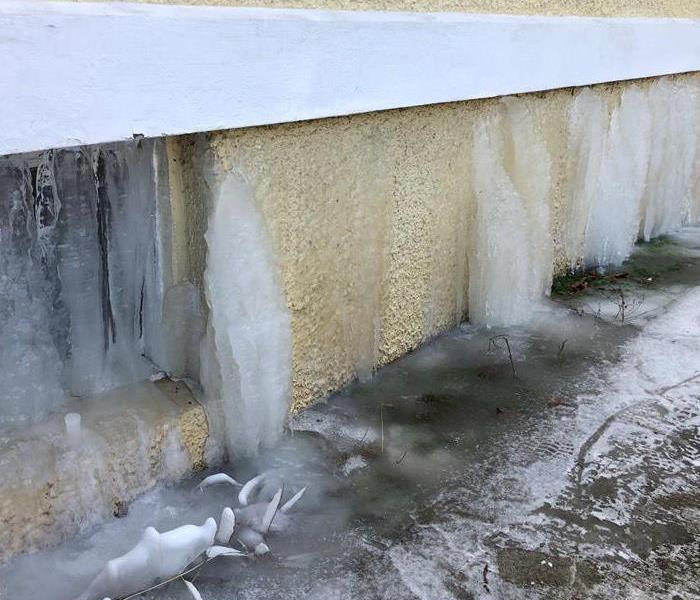 A water leak inside this NJ home is draining outside causing icicles.
A water leak inside this NJ home is draining outside causing icicles.
New Jersey is experiencing a deep freeze that is expected to continue for at least the next week. This has and will result in frozen and bursting water pipes in many homes, offices, and schools throughout the region.
SERVPRO has been on the scene, helping many homeowners and businesses by extracting water and drying basements, crawl spaces, floors, and sheetrock.
To avoid future frozen and broken pipes during long-time freezing temperatures, it is easy to take the following steps:
Outdoors:
- Wrap outside faucets
- Caulk around pipes where they enter the house
- Disconnect garden hoses
- Drain in-ground sprinkler systems
Indoors:
- Let a stream of water run if the temperatures dip below freezing
- Open cupboard and vanity doors in the kitchen or bathroom
- Make sure the thermostat is set to constant temperature
If, however, you do experience broken pipes, make sure you take quick action to have the water extracted and your home or business dried out properly. Call SERVPRO and we will make it “Like it never even happened.”
Water Damage Cleanup in Commercial Properties
1/31/2022 (Permalink)
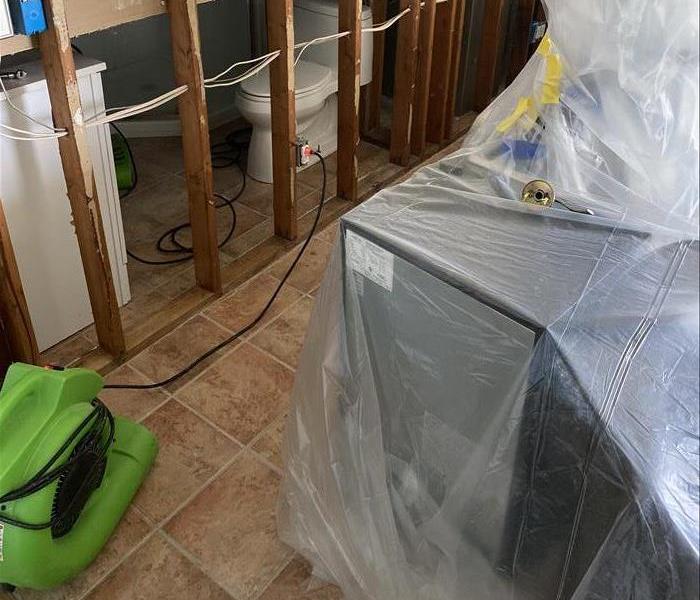 Water has caused significant damage in this NJ warehouse.
Water has caused significant damage in this NJ warehouse.
Commercial properties are often complex with numerous issues that require a knowledgeable and flexible response. Whether we’re dealing with a relatively small water cleanup scenario or a large-scale event, we work quickly to assess each unique situation and isolate the damaged area. In many instances, normal operations can continue in a temporary space while we restore your facility.
Restoring Commercial Properties Presents Unique Challenges
Our professionals are trained to be mindful of legal and environmental concerns and strive to fully restore the damaged area while working within your budgetary constraints. We understand that every hour spent cleaning up is an hour of lost revenue and productivity. So when an emergency situation arises in your business, give us a call and we’ll be there fast with the help you need.
About SERVPRO of Eatontown/Long Branch
SERVPRO of Hackensack/Little Ferry specializes in the cleanup and restoration of commercial and residential property after a water damage event. Our staff is highly trained in property damage restoration. From initial and ongoing training at SERVPRO’s corporate training facility to regular IICRC-industry certification, rest assured our staff is equipped with the knowledge to restore your property.
Cleaning a Flooded Basement
1/31/2022 (Permalink)
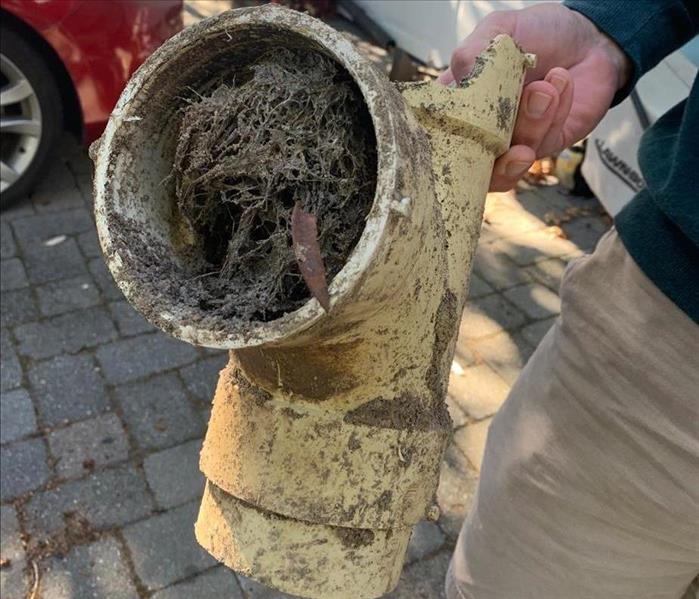 The roots of a tree clogged this pipe causing it to back up into the basement.
The roots of a tree clogged this pipe causing it to back up into the basement.
Groundwater flooding is basically water in your basement caused by seepage or flows through the walls or foundation floor.
According to State Farm Insurance, there are four common sources of water entering basements. Each source has its own specifics and requires its own course of action.
Surface water running down foundation walls.
If this is the first instance of water problems in your basement, the first thing to check for is surface water draining down next to the foundations. Water coming in at one location or only at the exterior foundation wall indicates surface water problems. Here are some things to look for once you get outside.
- Overflowing gutters: leaves
- Overflowing gutters: downspouts
- Downspout distance
- Pavement slope
- Sealant
- Landscape slope
- Irrigation
Groundwater in water-saturated soils is being pushed into the basement by hydrostatic pressure.
If no surface water sources are found, then the source of the water is likely subsurface groundwater under hydrostatic pressure. When the groundwater levels outside the basement rise above the level of the floor, the basement acts like a boat in a pond. If a boat is sitting in water, water will leak in through any open cracks or holes. It works the same way with a basement. Hydrostatic pressure can push water through hairline cracks.
Unfortunately, subsurface groundwater problems are more difficult and more expensive to fix than surface groundwater problems.
Storm sewer water from the municipal storm sewer system backing up into the home's existing perimeter foundation drain and leaking into the basement.
If you have an older house within town and the house has a basement with no sump pump, it is likely the perimeter foundation drain system connects directly into the city storm sewer system. If the level of the basement is below the street level, there is the potential of stormwater backing up in the city storm sewer system and being pushed into the perimeter foundation drain system. This can saturate the soils around the house at the basement level with stormwater under hydrostatic pressure, causing water to leak in.
- Underground springs
- Stormwater backing up
- Sewer water backing up
Sanitary sewer water from a clog in your home's sewer line. If there is a clog in the municipal sewer line, or the combined municipal storm/sanitary sewer system backing up into the home's drain system, it can cause sewer water to come up through sink drains and floor drains on lower levels.
Whatever the cause of water in your basement, remember it is important to have it dried out as soon as possible by a professional. SERVPRO of Eatontown/Long Branch is available 24/7 and will be able to get to your water damage quickly.
Training for Excellence
1/29/2022 (Permalink)
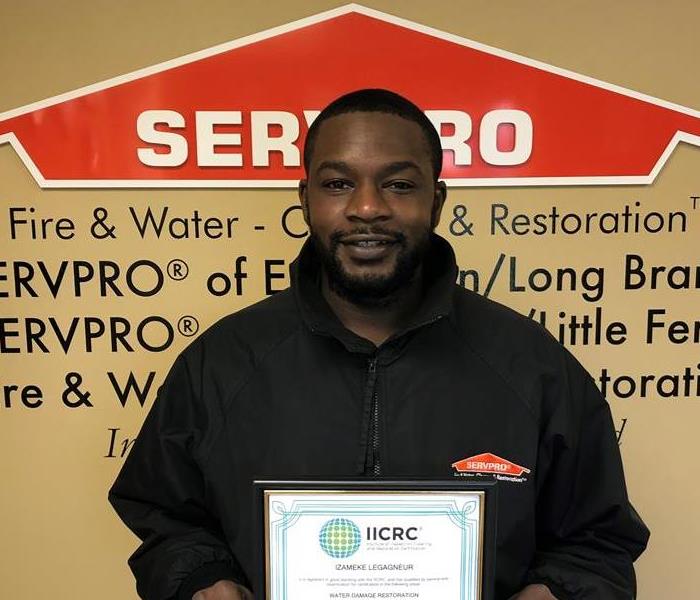 Meek holds his latest certification as a Water Damage Technician
Meek holds his latest certification as a Water Damage Technician
Congratulations to our technician, “Meek,” on completing his certification as a Water Damage Technician from the IICRC. At SERVPRO of Eatontown/Long Branch, we believe in service excellence and that begins with having professionally trained team members. We don’t hire “laborers.” We employ “Technicians” and invest in their training to tackle even the most challenging jobs professionally. This particular certification from the Institute of Inspection Cleaning and Restoration Certification is the gold standard in the restoration industry. Our team members are constantly taking courses to stay current on the latest trends, techniques, and tools of the trade.
Take a look at our reviews and you will consistently see comments about our professionalism in action. We take pride in these skills and our ability to make someone’s mess, “Like it never even happened.”
Leaking Hot Water Heater?
1/29/2022 (Permalink)
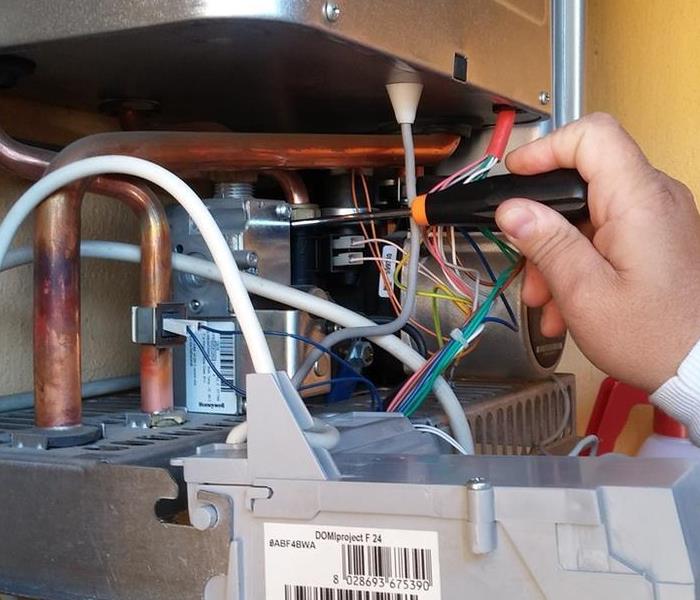 Making Adjustments to a hot water heater.
Making Adjustments to a hot water heater.
Sooner or later everyone will experience a leaking hot water heater. But this minor emergency doesn’t have to become a major disaster.
Here’s a list of steps you can take to minimize the damage from a leaking heater:
Confirm that it is, in fact, your water heater that’s leaking.
Sometimes looks can be deceiving. If you see a puddle of water under your hot water heater, it’s obvious why your first thought would be a heater leak. But that may, in fact, not be the problem.
If it’s a small puddle, your first step should be to clean up the water and inspect the heater. Do you see any wet fittings or other signs of leakage from the tank itself? Check your surroundings for other water sources? Maybe there’s a nearby window or pipe that is the actual source of the water you see. Don’t forget about the effect of gravity! If your floor slopes, the water may have traveled from a different source point to the place where it ultimately pooled.
Turn off the water.
If you do have a leaking water heater, the next recommended step is to turn off the water.
Your hot water heater should have its own shut-off valve.
If your valve is broken, you may need to shut off the water to your home. If you need assistance, reach out to your local expert professionals.
Cut the power.
Whether you have a gas or electrically powered water heater, your next step is to shut off the fuel source that powers your heater.
A gas tank should have its own dedicated shut-off gas valve. You want to make sure the gas is off so your heater will be safe to work with. If you have an electric tank, you can shut off the power at the breaker.
Try to determine the location and cause of the leak.
Now that the water and power are off, you will be in a better position to assess your situation and try to determine the location and course of your leak:
Check the pipes that connect to your heater for any loose fittings. This may just require quick tightening with a wrench.
- Check your pressure relief valve. If the temperature or pressure is too high, this could be causing valve leaks. Your water heater should be around 120 degrees Fahrenheit and the pressure shouldn’t be over 80 PSI.
- Check the drain valve to make sure it doesn’t need replacing.
- Check the bottom of the water heater itself -- it may be that the tank itself is cracked and needs to be replaced.
If you determine that it is your tank that is leaking and the leak is serious, you may want to drain the tank to minimize further water damage.
Hopefully, the leak from your hot water heater hasn’t caused too much water damage. But if you need professional assistance, the restoration pros at SERVPRO Eatontown / Long Branch are here to help. We’re equipped to handle any size water damage restoration needed for either residential or commercial buildings.
Just call us any time 24/7 at 732-578-9888
5 Tips to help your Business Weather the Storm
1/29/2022 (Permalink)
 Channel Club covered in Snow
Channel Club covered in Snow
New Jersey is getting a significant storm that can batter us with wind, rain, snow, and flooding.
If you own a business that is in a high-risk area for flooding, these tips can help you minimize the damage you may be unfortunate enough to endure
Get Prepared
1. Store important documents and valuables in a location that will be dry and secure.
2. Check your gutters and spouts to ensure they won’t be clogged.
3. Make sure to have a working sump pump.
4. If possible, move any electronics or other costly items to a higher floor or at least try to raise them several feet off the floor to minimize any flood damage.
Safety First
1. Turn off electricity in any affected areas. Even if there’s a power outage, the power may be suddenly restored without notice and could cause a shock hazard.
2. Be cautious of any structural compromises or falling debris ff you choose to enter a damaged building.
3. Keep out of the floodwater as much as possible to reduce the risk of slip-and-fall hazards and bacterial contamination.
4. Be sure to wear protective clothing – including slip-resistant shoes, gloves, eye protection, and a mask – in order to minimize potential risks.
Clean-Up ASAP
When flooding occurs, the quicker you can start your cleaning and restoration efforts, the better your chances of minimizing long-term damage and costs.
Here at SERVPRO Eatontown/Long Branch, our expert technicians are available 24/7 to respond to any flooding emergency big or small. We have the advanced training, skills, and equipment necessary to clean and restore your business to its pre-flood condition as quickly as possible.
Cleaning Smoke and Soot After a Fire
1/29/2022 (Permalink)
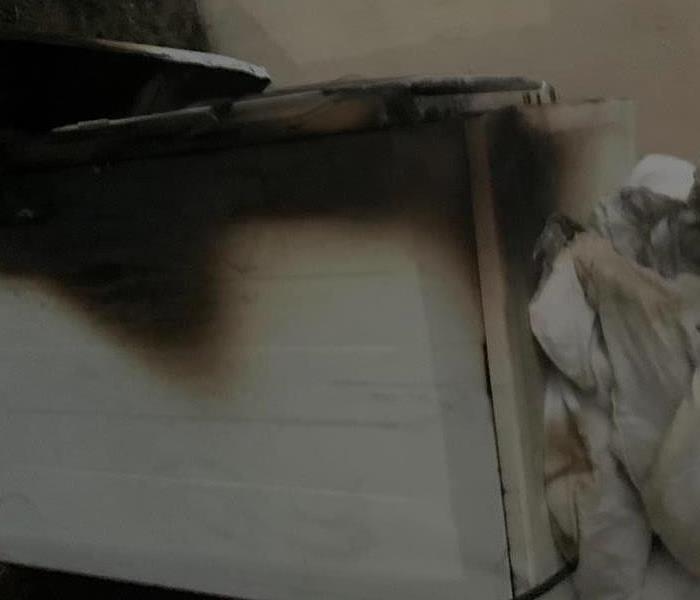 The mess was left behind after a dryer fire.
The mess was left behind after a dryer fire.
Smoke damage can make your home a dirty, smelling mess. Whether you’ve suffered a major fire catastrophe or had smoke damage accumulate from the presence of fire in your home, you want to start cleaning up smoke stains as soon as you can in order to prevent permanent damage.
Our team at SERVPRO of Eatontown/Long Branch has seen our share of fire incidents as Professional Cleaning and Restoration Leaders in this community so, we know what smoke damage can do to a home.
Make Sure the Area is Safe
If your incident was a small kitchen grease fire, there is probably minimal risk. However, if the fire burned through a significant section of your home, you want to be sure the area you enter is structurally sound and cleared by officials before anyone can attempt to start fixing it.
Dispose of Everything that Can’t Be Salvaged
The first step of the cleaning process is to get rid of everything that can’t be saved.
Be especially wary of food that may have been contaminated, plastics that may have melted, or materials that are too stained to be cleaned.
Vacuum Up Debris
We have specialized equipment to clean up debris.
Soot is greasy, it is best to wait for a professional to clean soot-stained surfaces than make a bigger mess.
Clean up Odors
You can clean some fabric and upholstery yourself that may have avoided smoke stains may still have absorbed odors.
If you have fabrics that are dry clean only, be sure to take them to a dry cleaner that specializes in smoke removal or fire treatment.
For fabrics that can go in a washing machine, add a cup of white vinegar and a cup of baking soda to your regular load to clean the smoke damage. A mixture of white vinegar and baking soda can also be used to spot clean carpeting and upholstery.
Seal Surfaces
Even after a full cleaning, there may still be some lingering stains and odors. To mitigate this, we use a sealing primer.
We use specialized sealers for different surfaces. For example, on painted walls, we use a stain concealing primer followed by a topcoat of latex paint. For wooden surfaces, we use a sealer designed specifically for wood or particleboard.
If you need professional assistance in cleaning up after a fire incident, SERVPRO of Eatontown/Long Branch is here to help. Our specialized technicians have the advanced training and equipment needed to clean and restore your property, helping you get your life and property back to normal ASAP.
Different Types of Water Damage
1/29/2022 (Permalink)
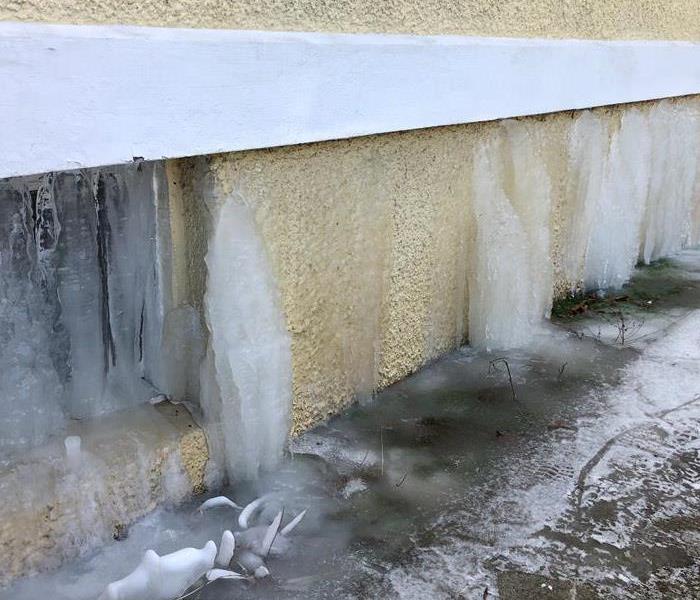 Flooding water in the home turned into icicles on the outside of the home.
Flooding water in the home turned into icicles on the outside of the home.
According to Wikipedia, wastewater is any water that has been affected by human use. But did you know that there are different grades of wastewater? Should your home be affected by water damage, it is imperative to act quickly to mitigate damage and prevent further damage such as mold growth.
CLEAN WATER
Floodwater that does not pose an immediate health threat is known as clean water. Clean water floods can result from malfunctioning appliances, toilet holding tanks, and melting snow and rainwater. Clean water home floods are generally safe for you to clean up yourself, but remember--time is an important factor. Standing clean water can become greywater if left untreated.
GREYWATER
Greywater refers to wastewater that is not contaminated with fecal matter. As far as household wastewater goes, greywater could include water from bathtubs and showers, appliances such as dishwashers, a weather event, an overflowing plumbing fixture or appliance, or even a broken pipe.
When flooding occurs, it can saturate carpeting, furniture, and drywall. If you experience a home flood with greywater, wear protective gear, and keep children and pets away from the flooded area. If the flood is extensive, such as several inches of water in the basement, it is advisable to hire professionals to safely clean up and decontaminate the area. Cleanup must begin as soon as possible as greywater can become blackwater if left untreated.
BLACKWATER
Blackwater is wastewater contaminated with human waste, floodwater, or water contaminated with chemicals.
Blackwater floods are the most dangerous and the most destructive and must be cleaned and mitigated immediately. Because of the unsanitary conditions of the water, items such as carpets, upholstery, and drywall are often unsalvageable. Contact with blackwater can cause illness in both humans and pets.
Having water damage in your home is never a pleasant experience, and oftentimes it is destructive, and disruptive - affecting multiple rooms, floors, levels – of a home, office, or multiple dwelling. Knowing whom to call and when could mean all the difference in keeping contamination and damage to a minimum.
Remember that you can call SERVPRO of Eatontown/Long Branch twenty-four hours a day, 365 days a year. We will be there to survey and clean up your water damage quickly and get you back to your normal routine as quickly as possible.
Both Local and National
12/28/2021 (Permalink)
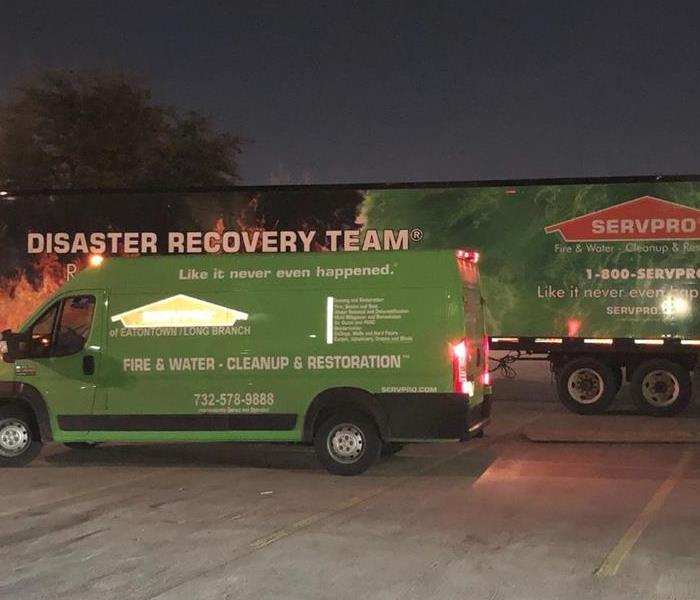 Our van helping in Texas as part of a national response plan.
Our van helping in Texas as part of a national response plan.
What will you do when, not if, an emergency strikes?. It doesn’t matter how the disaster occurred, all that matters is can you find a local reputable restoration company that can restore your property to pre-disaster condition.
When that time comes, you’re going to be in a situation where you have to make a decision quickly to protect your property, and you will need to decide what company is going to get your business quickly and professionally handle your restoration.
Keep these points in mind when evaluating a partnership with a restoration company:
Are They Legitimate?
Keep in mind that not everyone who shows up after a disaster has the best of intentions. Unfortunately, major storms and disaster situations bring scammers to the area who may try to take advantage when you’re most at risk, deliver nothing, and then disappear.
SERVPRO has been in business for over 50 years. You don’t get that kind of longevity without satisfied customers. These include many of the largest companies in the country.
Can They Act Fast?
When disaster strikes, there’s no time to waste. You have got to reach someone right away so resources can be mobilized and your restoration can begin. Even a small delay can lead to more damage and costs.
That’s why we’re on call 24 hours a day to respond to your emergency situation.
Do They Have Access to National Resources?
SERVPRO of Eatontown/Long Branch is locally owned and operated, which means there’s always a team right here in Monmouth County ready to act. But if major storms come and bring a surge of activity, our local franchise is supported by a full, coast-to-coast network of SERVPRO franchises.
This means when trouble hits, we’ll be coordinating with other crews and powerful tools to make sure every local homeowner in need gets the service and attention they deserve.
When you call SERVPRO, you can rest easy knowing you’ve got the trusted leader in the restoration industry on the other end of the line. When disaster hits home, contact us to get our local experts and nationwide network on your side.
What makes a great team?
12/28/2021 (Permalink)
 A group shot including members of the SERVPRO of Eatontown/Long Branch and SERVPRO of Hackensack/Little Ferry teams.
A group shot including members of the SERVPRO of Eatontown/Long Branch and SERVPRO of Hackensack/Little Ferry teams.
What makes a great team? Many factors, of course, but having a passion for what you do, a belief that you are a part of something larger than yourself, and the comfort that you are valued and supported by those around you is critical. This week teams from SERVPRO of Hackensack/Little Ferry and SERVPRO of Eatontown/Long Branch got together for our annual holiday party hosted by owner, John Majeski. This year, technicians competed in the Best Dressed competition and had a blast cheering each other on. Having this comradery reminds me of the book FISH which talks about building morale even in the toughest of work environments and the technician’s role can be a very dirty and difficult job! Having this environment allows our teams to perform challenging work with pride and passion. Congratulations to Justice for winning this year’s contest!
Preventing Leaks in Commercial Buildings
12/28/2021 (Permalink)
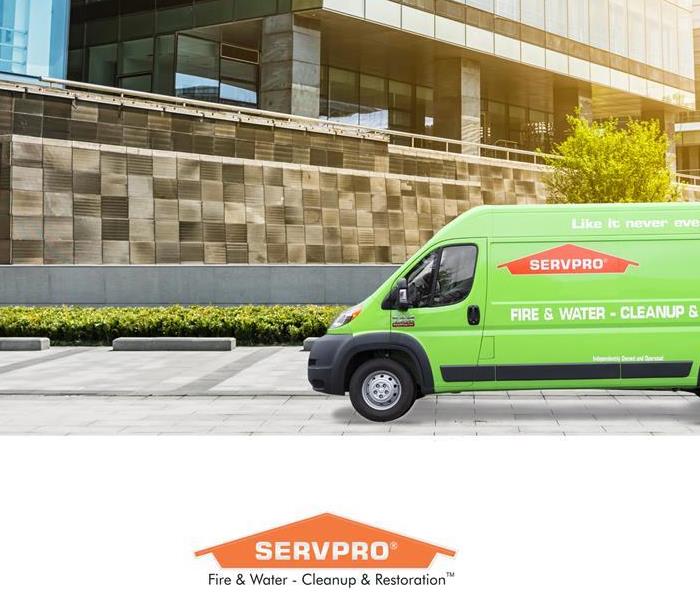 SERVPRO van outside an office building.
SERVPRO van outside an office building.
Most people pay attention to warning signs around their home in order to prevent damage but many do not take the same notice at their place of employment. Here are some things you can do as a commercial property owner/manager/employee that may save your business significant hardship.
Understanding your facility's water system can go a long way to preventing water damage. Practice preventive maintenance with an emphasis on the most common sources for water damage:
Toilet leaks: Whether it’s a broken wax seal or a clogged toilet, these have to be repaired quickly before more damage results. The tank has many moving parts, and these can wear out over time. Proper fixture maintenance in the bathroom can save you time and aggravation in the future. Periodically check around the toilet for signs of water. Feel the water supply line to make sure no slow leaks exist.
Ice maker supply line: Ice maker supply lines are common sources of water leaks. If the line is damaged, replace it. If it’s loose, secure it. Pests like mice love to chew on these hoses so do ignore signs of droppings, get an exterminator.
Foundation cracks: Foundation cracks are serious and should be repaired by a professional. They can allow water to seep into the basement which will lead to mold and significant property damage.
Poor ventilation: Proper attic ventilation is important because it removes moisture from the attic that could condensate, drip, and cause mold growth.
Roots in drain lines: Older facilities have more problems with roots in the drain lines due to the types of materials that were used in construction. Septic systems utilize field lines, and they tend to attract tree roots due to the moisture in the ground.
Common drain issues: Facilities face many issues with drain systems, including slow drains, recurring clogs, a foul odor, or flooding from a backup. What is being washed down your drains, food, waste products, tampons? Slowing drains may be a sign of impending trouble.
Staying current on your facility maintenance is the best way to avoid a potential catastrophe!
If a water leak turns into a big problem in your business, you’ve got the best team in the industry on your side. Contact SERVPRO of Eatontown/Long Branch today so we can get started.
Emergency Kits
12/28/2021 (Permalink)
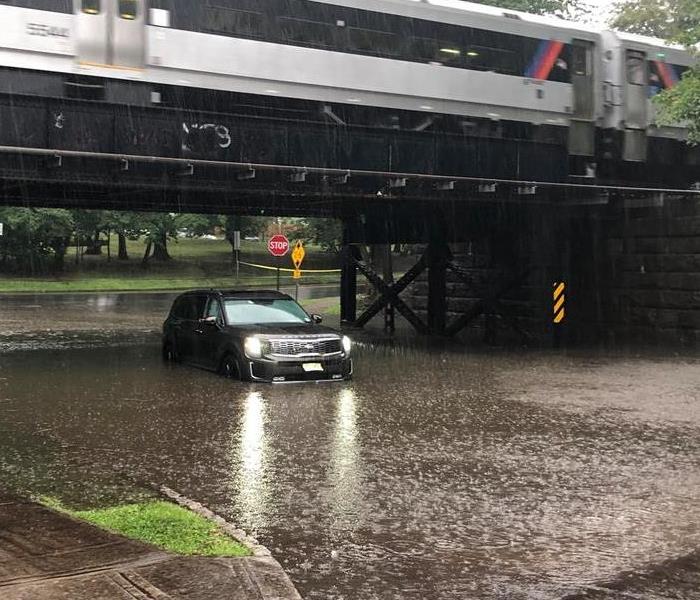 A car stuck in the water under an NJ Transit bridge.
A car stuck in the water under an NJ Transit bridge.
Cold weather, snow, ice, and storms can cause severe damage to your home or business. When these types of disasters strike, immediate action is necessary to prevent additional damage to your property. SERVPRO is always here to help and we want to give you tips to set up a basic emergency kit in case the unpredictable happens.
In a year filled with the unexpected, one thing that 2021 has shown us is, as the Boy Scout motto says, “Be Prepared.” Here are some basic items you should have in your Emergency Storm Kit:
- Water (one gallon per person per day for at least three days, for drinking and sanitation)
- Food (at least a three-day supply of non-perishable food)
- Battery-powered or hand-crank radio and an NOAA Weather Radio with tone alert
- Flashlight
- First aid kit
- Extra batteries
- Whistle (to signal for help)
- Dust mask (to help filter contaminated air)
- Plastic sheeting and duct tape (to shelter in place)
- Moist diaper wipes, garbage bags, and plastic ties (for personal sanitation)
- Pliers (to turn off utilities)
- Manual can opener (for food)
- Local maps
- Cell phone with chargers and a backup battery
Also, look at www.ready.gov for more information on emergency kits!
Certified: SERVPRO Cleaned
12/28/2021 (Permalink)
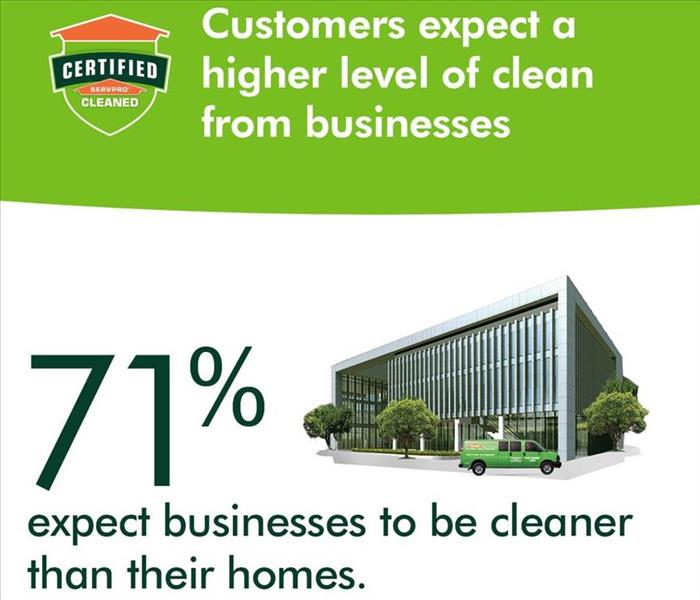 Infographic of Covid Research Findings.
Infographic of Covid Research Findings.
Government mandates or not, the expectations of visitors, customers, and employees who come into our establishments have evolved, and staying safe is a top concern. The global COVID-19 pandemic has changed what it means to be clean, and we’ve developed a program to help your business meet the new higher standard of clean that is now expected.
Certified: SERVPRO Cleaned is a defensive cleaning program we’re offering to businesses, schools, and commercial locations to address the current COVID-19 pandemic. This proactive viral pathogen cleaning program goes well beyond janitorial or carpet cleaning. By choosing Certified: SERVPRO Cleaned, you, your employees, your customers, and your community can rest assured that you’ve selected a higher cleaning standard – you are Certified: SERVPRO Cleaned.
Extensive training and specialized products
We stand on more than 50 years of experience and expertise to help your business become Certified: SERVPRO Cleaned. Beyond fire & water, SERVPRO professionals are trained and experienced in biohazard decontamination and chemical spills – always adhering to the cleaning and decontamination standards set by the Centers for Disease Control and Prevention and local authorities.
From formulating and creating our proprietary cleaning products, like SERVPROXIDE, at our headquarters in Gallatin, TN, to taking the utmost care while disinfecting, we will ensure you and your business are set up to inspire consumer confidence as the pandemic continues.
3 C’s – Consult, Clean, and Certify
When the stakes are this high, you want a partner who has developed an industry-leading, proprietary training program, cleaning solutions, and remediation processes over decades. We’ve cleaned up some of the most challenging biohazards imaginable. Certified: SERVPRO Cleaned reflects our unique experiences and capabilities. The program is grounded with our unique 3 C’s: Consult, Clean, and Certify.
Consult – Every business is different, which is why you’ll be assigned a Cleaning Protocol Consultant who understands your business and will create a cleaning program to meet your specific needs. This program will be developed based on your business type, size of space, amount of high-frequency touchpoints, foot traffic, and congestion points.
Clean – Based on your specific business needs, your location will undergo a thorough, deep clean, using an exclusive cleaning product, according to protocols set forth by the CDC. Our employees have years of experience, and we will go beyond the scope of work that regular janitorial staff performs. Cleanup procedures generally include cleaning of porous and non-porous surfaces, disinfecting of non-porous surfaces, cleaning and disinfecting of equipment, tools, and/or supplies used for the cleanup process, and disposal of hazardous materials. In the event of a suspected or confirmed COVID-19 event, we will be there cleaning within 24 hours to ensure you get back to business as quickly as possible.
Certify - Once your business location has been Certified: SERVPRO Cleaned, you will gain access to proprietary signage, digital emblems, and other collateral that communicates that you’ve selected a higher standard of clean available to help protect your employees and customers. And because we add the day, month, and year to that proprietary stamp of clean, your guests will know that not only did you choose Certified: SERVPRO Cleaned, but that your location is being cleaned regularly at this standard.
Call today for a Certified: SERVPRO Cleaned consultation
We’re ready to help – 24/7– until life is back to normal in the communities we all call home.
How to Handle a Leaking Toilet
10/29/2021 (Permalink)
 Animated toilet paper roll yelling, "Stop"
Animated toilet paper roll yelling, "Stop"
Managing An Overflowing Toilet
We’ve all been there! Clogged pipes, leaky faucets, and overflowing toilets are all common enough problems that you shouldn't be too surprised when happening to you. The toilet overflow presents a messy challenge for homeowners because it introduces the possibility of sewer damage. If your toilet starts running over, consider following these basic steps.
- Stop the water. Your first priority should be to stop the water. Most toilets have a shut-off valve at the base. Check to see if your fixture has one. If not, you can stop the water by manually manipulating the float valve in the tank. If all else fails, you can turn off your home's water and turn on the faucet at the lowest point in your home until the water stops.
- Get some help. Once the initial onslaught of water has been stopped, you need to call in a water restoration expert to help you assess the damage. This professional can help you figure out why the toilet started to overflow. The team will also create a sewer damage cleanup plan to help you get your bathroom back to normal.
- Remove the water. Leaving standing water in any part of your home is unwise. The water damage team will likely remove the water as soon as they can. This helps reduce the secondary damage, such as mold growth and material contamination, that can happen as a result of a flooded toilet.
- Fix the toilet. Chances are your toilet overflowed for a reason. The most common reason is a clog. Work closely with a plumber to remove the blockage from the pipes.
Fast response to a fire
10/28/2021 (Permalink)
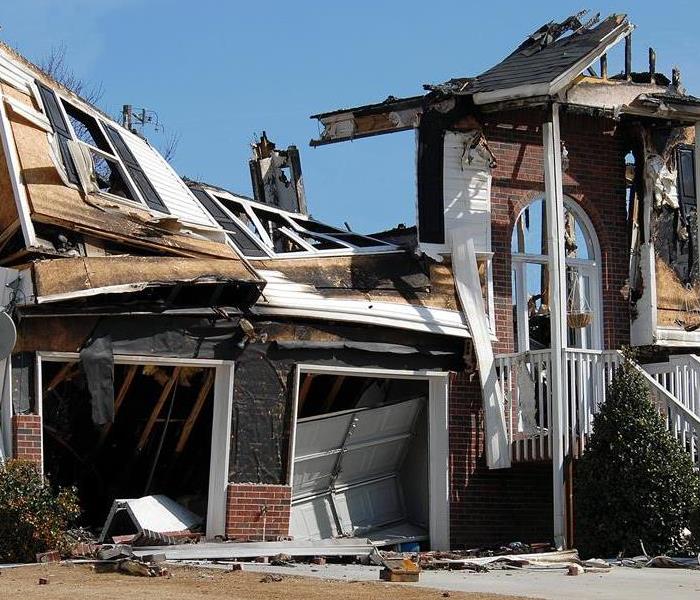 Severely damaged home do to a fire
Severely damaged home do to a fire
When a fire happens you expect a quick response from the fire department. But what happens once the fire is extinguished? The fire department does what they can to minimize damage to "exposure areas" but their responsibility ends once the fire is extinguished.
You will need a restoration company to intervene quickly to minimize damage. To that end, we respond as quickly as possible to be able to assist the owner in navigating the process. This sometimes leads to an awkward situation where owners are confused about why we are there and what they should do. I've personally had people react negatively as they perceive our quick response as a way to make a buck. While I understand this perception, and we are a business, it is our intention to assist the owner through every step of the process in order to minimize damage, provide assurances that things will be returned to normal, and ensure that important first steps are done correctly.
If you see us at a fire scene, please understand that our mission is to assist those affected in a variety of ways and without delay. Please help us to engage with the owner and allow us to use our expertise to be a resource to them. Thank you!
Key First Steps in Fire Damage Remediation
10/28/2021 (Permalink)
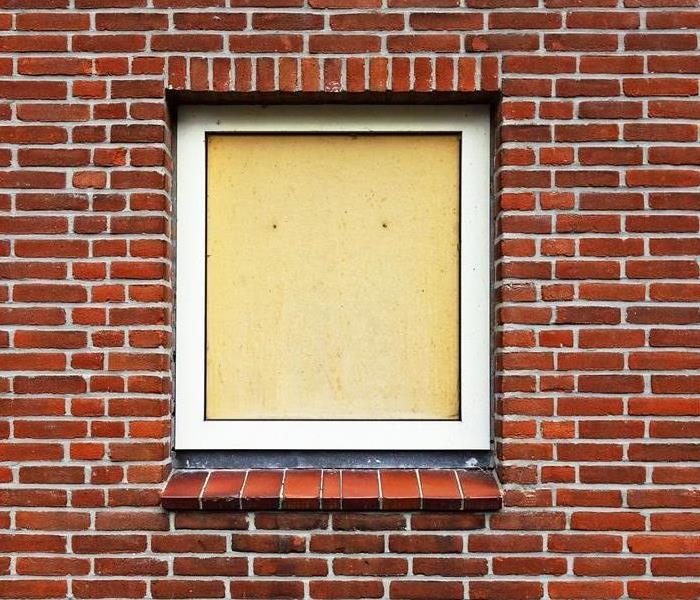 A boarded-up window on a brick home.
A boarded-up window on a brick home.
In a prior post, I spoke about our rapid response to a fire scene and our purpose for being there, often before the fire department leaves. Below I will touch upon some of the critical actions we take when we connect with the owner.
First, we provide assurance that we will be with them throughout the process. This includes facilitating communication between the owner and the insurance company as well as third-party adjusters. We use the same estimating software that is used by insurers to accurately document and detail what services are needed to reduce the possibility that claims will be questioned down the road.
Second, we look to secure the scene. Firefighters may have removed doors and are trained to "turn windows into doorways" as a way to provide both evacuation routes and ventilate the structure. quick board-up is needed to prevent additional damage and prevent unauthorized entry.
Third, we look to identify and remove belongings that need special attention and storage at our offsite facilities. This may include precious items, family heirlooms, and keepsakes.
Forth, we look to immediately begin extracting water to prevent further saturation and limit mold growth.
From here a detailed remediation plan is developed with consideration for the eventual reconstruction phase of the project. While we work with clients throughout the process, our early interventions are essential in limiting the overall cost and scope of the project.
Protecting Work Spaces During Demolition
10/28/2021 (Permalink)
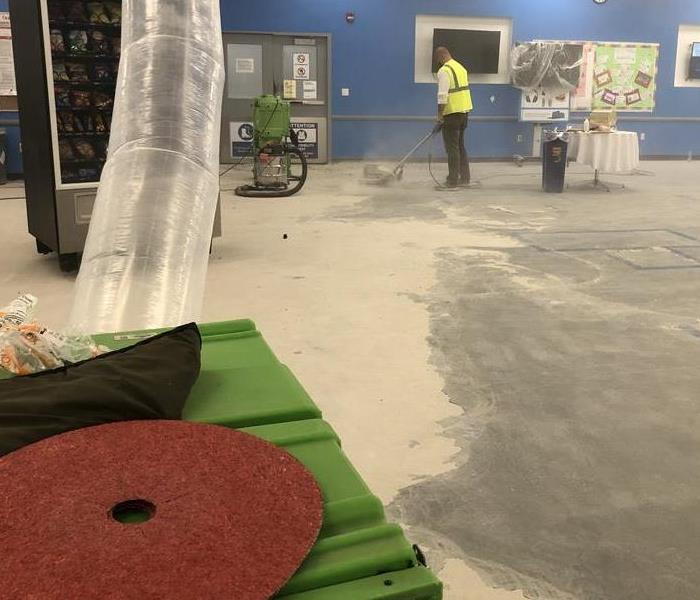 Special containment precautions during demolition in a large commercial space.
Special containment precautions during demolition in a large commercial space.
This picture was taken at a large distribution center for a well-known company. They could not afford to close the facility but needed to complete a messy demolition while protecting the unaffected areas. The existing floors needed to be scraped and the concrete sanded so a new floor could be installed. This is a very messy and dusty process that was beyond the scope of their flooring contractor.
SERVPRO created a special containment zone with positive pressure ventilation to prevent the dust from entering the HVAC system and being spread throughout the rest of the building. Air filtration systems were used during the demolition to clean the air within the work zone. Once demolition was complete, the SERVPRO team cleaned all of the equipment and surfaces so that reconstruction and installation of the new floor could be completed.
Having the expertise, the right equipment, and the resources to handle a large commercial job is what makes SERVPRO the ideal contractor for large commercial jobs.
Education from Our Professionals is the First Step
10/28/2021 (Permalink)
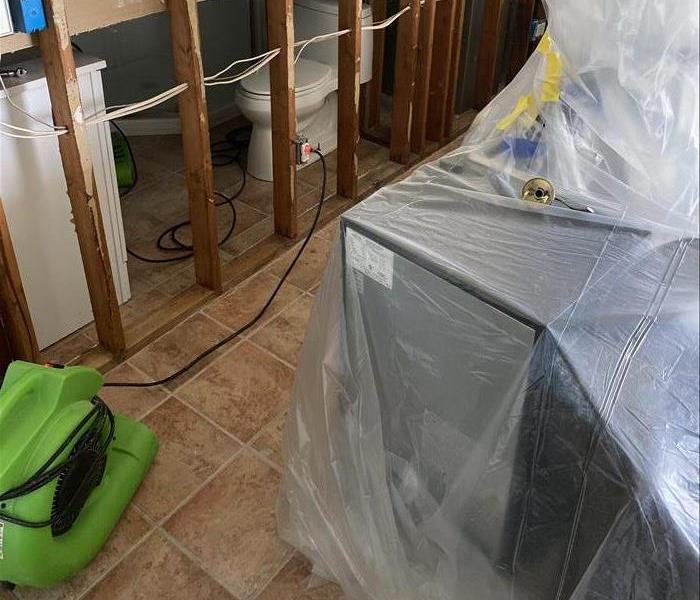 A NJ home was damaged by a clogged heating and air conditioning unit.
A NJ home was damaged by a clogged heating and air conditioning unit.
At SERVPRO of Eatontown/Long Branch, our expert technician’s first job is to educate.
When a burst pipe or leaky roof damages your property, It is time to call SERVPRO. Our technicians take the time to explain in detail all aspects of the job prior to commencing services so you understand the issues that need to be addressed and the process/methods we will use to address the damage.
- The consequences of delaying or failing to “mitigate” the damage
- The steps we expect to complete while limiting the harm and moving towards SERVPRO’s ultimate goal of making it “Like it never even happened.”
What Is Water Mitigation and Why Does SERVPRO Address It Before Other Tasks?
Water mitigation is one or more strategies to halt ongoing water damage. Because water is incredibly corrosive, prompt mitigation is essential for a wide range of water cleanup issues caused by damage like basement flooding or leaking roofs from storms. Mitigation in a water-damaged home can include:
- Shutting off water supply lines
- Pack-up and removal of soaked home contents
- Use of professional-grade wet vacuums to create a dry zone around the perimeter of water in carpeting
- Water removal services using pumps and or portable extractors
- The use of controlled demolition to release trapped water
What comes after Mitigation?
Water mitigation moves on to remediation and water damage repairs as the moisture diminishes. The goal of “restoration” is why SERVPRO’s customers reach out initially, but grasping that mitigation is part of a more extensive process helps residents allow the phases to follow in a logical and research-based progression.
Training, honesty, and integrity, plus top-of-the-line equipment are SERVPRO of Eatontown/Long Branch fulfills our promise to return a water-damaged home to safe and sanitary conditions.
Hazards of Storm water Flooding
9/30/2021 (Permalink)
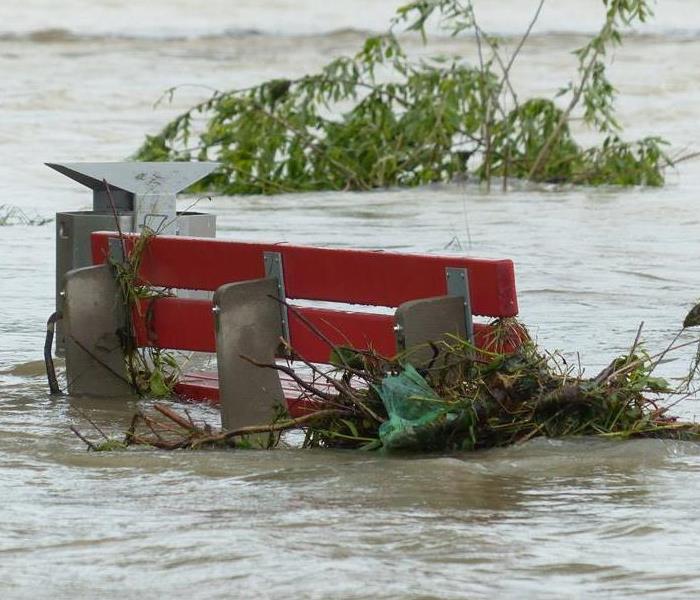 Dirty storm water pins debris against a park bench.
Dirty storm water pins debris against a park bench.
Almost a month after the remnants of Hurricane Ida hit NJ, many property owners are still dealing with the mess. We have been working 7 days a week to help as many people as possible. Our teams are bolstered by the support of multiple SERVPRO teams from out of state, and it is still not enough. Many homeowners have been tempted to handle the cleanup themselves but there are some serious considerations if you are going to do so.
First, make sure the area is safe. Downed wires and electrocution hazards need to be addressed before any work is done. If significant flooding has occurred, both the electrical service and gas should be shut off to prevent an explosion or electrocution. Sharp items such as broken glass must be removed to prevent puncture wounds and cuts which are highly prone to infection. Be aware of any displaced animals such as snakes. Always wear PPE such as rubber boots, gloves, and goggles.
Second, floodwater is contaminated. A river that has overflowed is carrying more than just the usual stream water. Flooding has washed contaminants downstream which may include:
- Human and livestock waste
- Household, medical, and industrial hazardous waste (chemical, biological, and radiological)
- Coal ash waste that can contain carcinogenic compounds such as arsenic, chromium, and mercury
- Other contaminants that can lead to illness
- Physical objects such as lumber, vehicles, and debris, or needles
- Wild or stray animals such as rodents and snakes
Third, exposure to contaminated floodwater can cause:
- Wound infections
- Skin rash
- Gastrointestinal illness
- Tetanus
If you experience any of these symptoms seek immediate medical attention.
For more information on the health concerns after a flood visit the CDC website at Floodwater After a Disaster or Emergency | CDC
SERVPRO Reconstruction Services
9/30/2021 (Permalink)
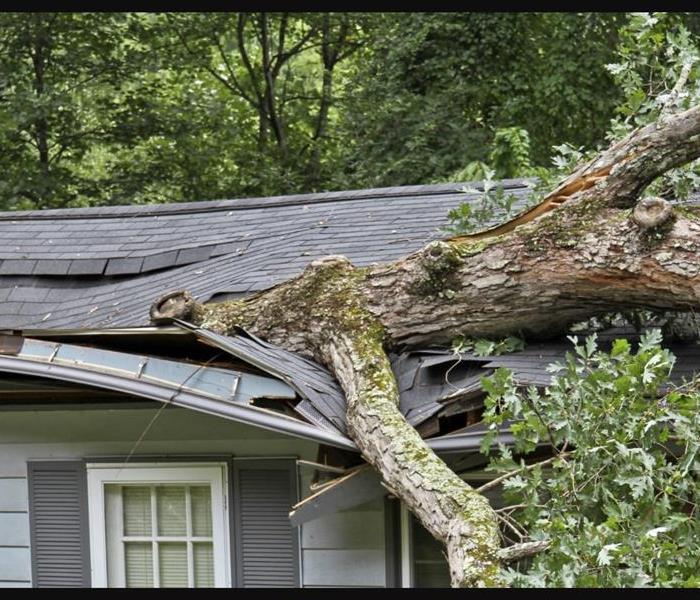 A tree rests on a home
A tree rests on a home
When major storms hit we are often called when trees have fallen on houses. This can be one of the scariest events customers face. In fact, my brother had a very large tree come through his bedroom ceiling and was almost struck by a large branch while sleeping. The damage caused usually involves both physical damage and significant water damage.
At SERVPRO of Eatontown/Long Branch, we work 24-7 to provide an immediate response. The initial response often includes “board up” services to prevent further damage. This is typical with most jobs. The next step is removing the water to prevent mold via a number of extracting and drying technologies but we don’t stop there.
SERVPRO also offers reconstruction services. Under the supervision of our licensed general contractor, our teams remove the damaged material and reconstruct the area to restore the area to its original condition. This ability makes us a 1-stop shop and ensures a quicker process and streamlined coordination with your homeowner’s insurance.
Proper Water Remediation
9/30/2021 (Permalink)
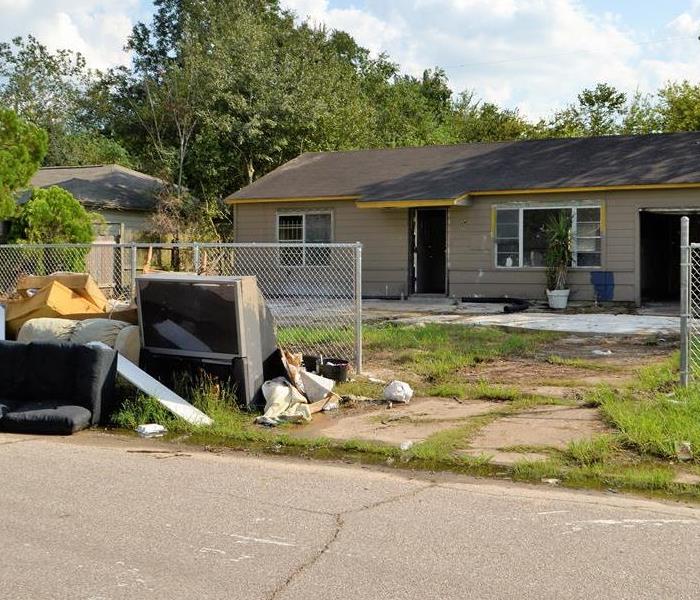 A home damaged by water during a storm
A home damaged by water during a storm
Even small water damages have the potential to cause serious structural and indoor air quality issues over time.
The key to avoiding costly future restoration is to handle every water problem as a real threat to your property. The proper equipment makes a huge difference in reducing the damage expense during a water loss. When time matters most, technology and equipment can be counted on.
Here are a few tools used by SERVPRO of Eatontown/Long Branch to properly mitigate a loss;
Moisture Sensors- used to detect moisture in carpets, baseboards and walls.
Moisture Meters- used to determine the actual moisture content of various materials. The meter provides accurate readings to monitor the drying process.
Thermo Hygrometers- measures temperature and relative humidity to calculate and create an environment most conducive to drying. When handling a contaminated loss (CAT 2 or 3), it is not only important to dry the structure, but disinfect and deodorize.
Ultra Low-Volume (ULV) Foggers- used to atomize liquid deodorizing agents, producing a fine mist that can easily penetrate the site where odor-causing residues may accumulate. It can also be used to inject fungicides and disinfectants into wall cavities and other hard-to-reach areas.
Thermal Foggers- dispenses solvent-based products by creating a dense fog that consists of tiny particles of deodorant solution that attach to and neutralize odor-causing particles.
The bottom line... ALWAYS treat water damage seriously. Call in a professional team like SERVPRO of Eatontown/Long Branch. We will work for you to restore your property and your life to make it "Like it never even happened."
Faster To Any Size Disaster
7/27/2021 (Permalink)
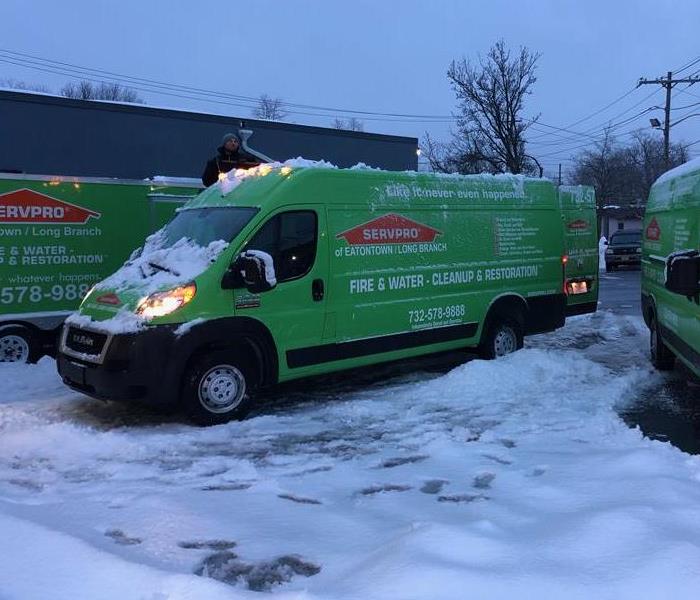 SERVPRO team responding on an early winter morning.
SERVPRO team responding on an early winter morning.
When disaster strikes, timing is critical. A quick response limits damage and saves money. In many cleaning and restoration situations, immediate action is needed. Owner John Majeski and his team of highly trained technicians are available in your immediate area 24/7, meaning an immediate response day or night that will help to minimize your damage, cleaning, and restoration costs. Water is particularly invasive, quickly spreading throughout your property and being absorbed into floors, walls, furniture, etc. SERVPRO of Eatontown /Long Branch can arrive quickly and start the restoration almost immediately, whether it be water, fire, or mold.
Water Damage Timeline:
Within Minutes
- Water quickly spreads throughout your property, saturating everything in its path.
- Water is absorbed into walls, floors, upholstery, and belongings.
- Furniture finishes may bleed, causing permanent staining on carpets.
- Photographs, books, and other paper goods start to swell and warp.
Hours 1 - 24:
- Drywall begins to swell and break down.
- Metal surfaces begin to tarnish.
- Furniture begins to swell and crack.
- Dyes and inks from cloth and paper goods spread and stain.
- A musty odor appears.
48 Hours to 1 Week:
- Mold and mildew may grow and spread.
- Doors, windows, and studs swell and warp.
- Metal begins to rust and corrode.
- Furniture warps and shows signs of mold.
- Paint begins to blister.
- Wood flooring swells and warps.
- Serious biohazard contamination is possible.
More Than 1 Week:
- Restoration time and cost increase dramatically; replacing contaminated materials and structural rebuilding may be extensive.
- Structural safety, mold growth, and biohazard contaminants pose serious risks to occupants.
Here come the Hurricanes
7/7/2021 (Permalink)
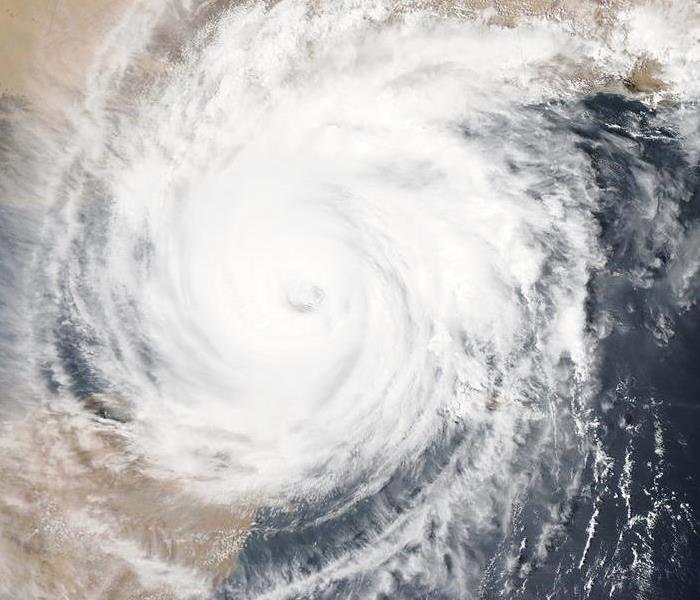 A satellite photo of a hurricane from space.
A satellite photo of a hurricane from space.
The east coast hurricane season has officially started and runs from June 1 to November 30th. So far there have already been 5 named hurricanes in the Atlantic this season.
Here is a brief list of things you should be considering NOW in order to be prepared.
- Make sure your flood insurance is active. Many people let these policies lapse to save money or as an oversight.
- Make sure both your home and business are secured as much as possible. This may include storm shutters, clearing gutters/downspouts to direct water away from the structure, and checking the roof for damage.
- If you have a generator make sure it is operable. If it hasn’t been serviced recently you should check the oil, make sure you have adequate fresh fuel, and run the generator periodically.
- Develop a business continuity plan. This should include emergency communication plans for employees and customers, facility remediation contacts, and contingency work plans.
- If you are in an evacuation zone determine where you will go should the need arise.
- Download the SERVPRO Emergency Ready Plan app which allows you to store and share emergency contacts, critical facility information, and document current conditions. For more information and to access the app click HERE.
Finally, you can register with SERVPRO to be added to our list of contacts so we have your information on file in the event you suffer a loss. If you would like assistance in preparing your readiness plan please contact us for a free consultation and have a great summer!
Sewage Clean Up Services
7/7/2021 (Permalink)
 Clean up in progress after a sewage backup in a basement.
Clean up in progress after a sewage backup in a basement.
Sewage leaks in your home or business can happen for a variety of reasons. I found out the hard way that when a toddler flushes a plastic hammer down the toilet it may get past the toilet itself but can get lodged in the pipe further down the system causing a block. This blockage caused a bathtub full of water to come shooting up through the first-floor toilet (lowest point) when it could not exit my home just as Superstorm Sandy was hitting.
All sewage leaks should be considered extremely hazardous to your health. Besides the obvious foul smell and disgusting nature of the material, sewage can harbor a variety of harmful bacteria that can cause illness for but humans and pets.
At SERVPRO, our technicians are trained to deal with these incidents and have the proper equipment to do it safely. Depending on the type of material that is contaminated a variety of equipment and techniques may be used. For example, soft porous material will need to be extracted to remove the contamination prior to sanitization. This is far more complicated than a tile or linoleum floor.
When (not if) you have a sewage mess, call the experts at SERVPRO!
We've Performed at MSG!
6/1/2021 (Permalink)
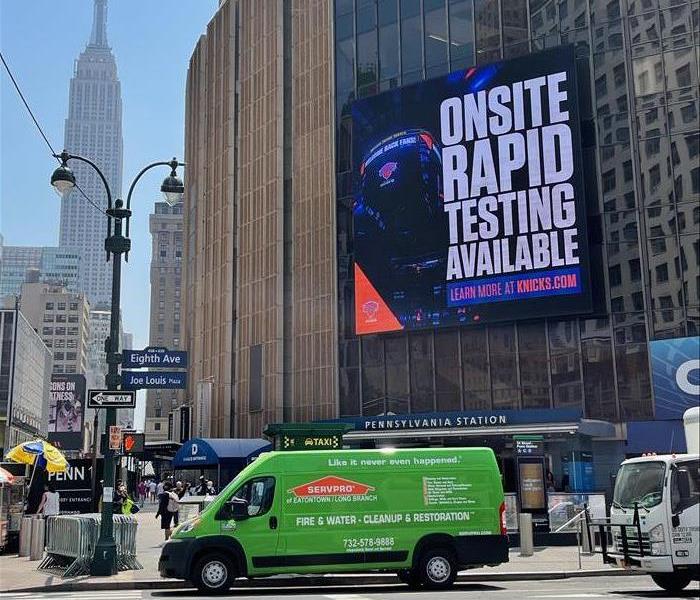 SERVPRO van parked outside MSG
SERVPRO van parked outside MSG
At SERVPRO we have the pleasure of serving businesses both large and small. Disasters come in all shapes and sizes including leaks, fires, floods, commercial cleaning, and COVID-19 cleanings. We've been honored to help local food pantries, high-end restaurants, and everything in between.
We take great pride in performing our commercial services with the utmost speed and attention to detail. Our focus is to be as inconspicuous and limit business interruptions for our customers. This may include services on an emergency basis or scheduled work after hours. Our initial consultation with the business owner/manager is always focused on limiting our impact on the business.
Some of our prior clients include the following categories:
- Small Office Buildings
- Large Office/High-Rise Office Buildings
- Apartment Buildings
- Restaurants
- Hotel/Motels
- Small Retail Stores
- Large Retail/Big-Box Stores
- High-Rise Residential
- Manufacturing & Industrial
- Government/Military
If your business needs commercial cleaning services there is no job too big or too small for the professionals at SERVPRO!
Sewage Clean Up Services
5/30/2021 (Permalink)
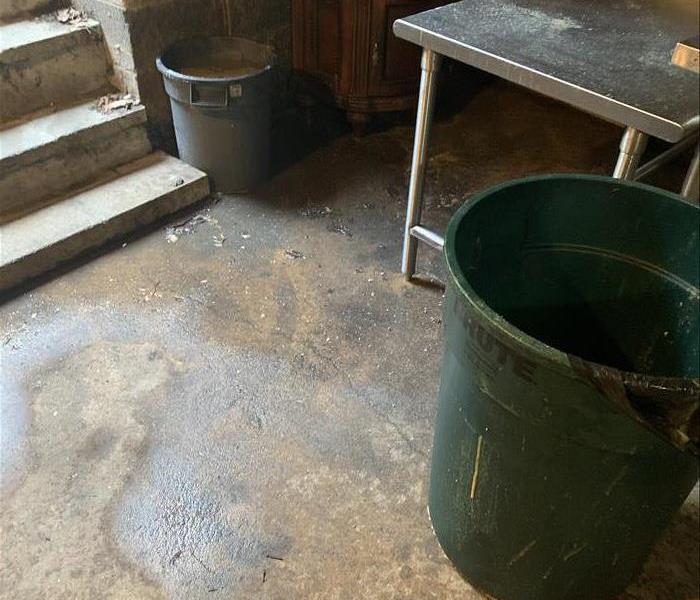 Image of a recent SERVPRO of Eatontown/Long Branch sewage clean up in Fair Haven, NJ.
Image of a recent SERVPRO of Eatontown/Long Branch sewage clean up in Fair Haven, NJ.
Sewage leaks in your home or business can happen for a variety of reasons. I found out the hard way that when a toddler flushes a plastic hammer down the toilet it may get past the toilet itself but can get lodged in the pipe further down the system causing a block. This blockage caused a bathtub full of water to come shooting up through the first-floor toilet (lowest point) when it could not exit my home just as Superstorm Sandy was hitting.
All sewage leaks should be considered extremely hazardous to your health. Besides the obvious foul smell and disgusting nature of the material, sewage can harbor a variety of harmful bacteria that can cause illness for but humans and pets.
At SERVPRO, our technicians are trained to deal with these incidents and have the proper equipment to do it safely. Depending on the type of material that is contaminated a variety of equipment and techniques may be used. For example, soft porous material will need to be extracted to remove the contamination prior to sanitization. This is far more complicated than a tile or linoleum floor.
When (not if) you have a sewage mess, call the experts at SERVPRO!
Wet Memorial Day Weekend
5/28/2021 (Permalink)
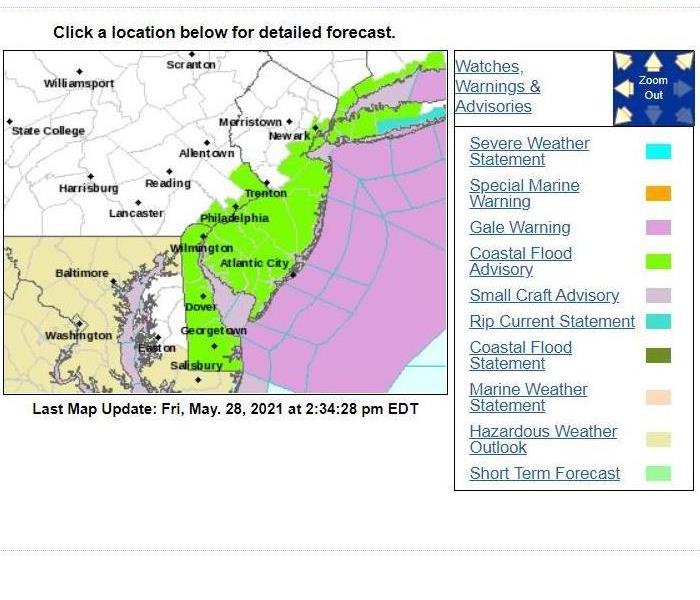 It is going to be a wet Memorial Day Weekend here in NJ!
It is going to be a wet Memorial Day Weekend here in NJ!
It is going to be a very wet Memorial Day Weekend. Hopefully, we will catch a break on Monday and be able to get out to honor our veterans. In the meantime, take a moment to prepare for significant rain and possible flooding. The National Weather Service is forecasting a couple of inches of rain across NJ with the potential for flooding along the coast, rivers, and low-lying areas.
As the first heavy rains of the season approaches, here are some quick tips to check and prevent water damage:
- Check your gutters and downspouts – if you have had any new landscaping or mulch installed check to make sure the water will flow freely away from the structure
- Check your basement sump pump to make sure it is operational
- Make sure items are on shelves or otherwise raised off of basement/ flood prone floors
- Make sure the patio furniture you just put out is secured
- Turn off the gas line to your grill
If you experience any water damage rest assured that SERVPRO will be ready to respond and provide assistance 24/7/365.
Mold is Everywhere
5/27/2021 (Permalink)
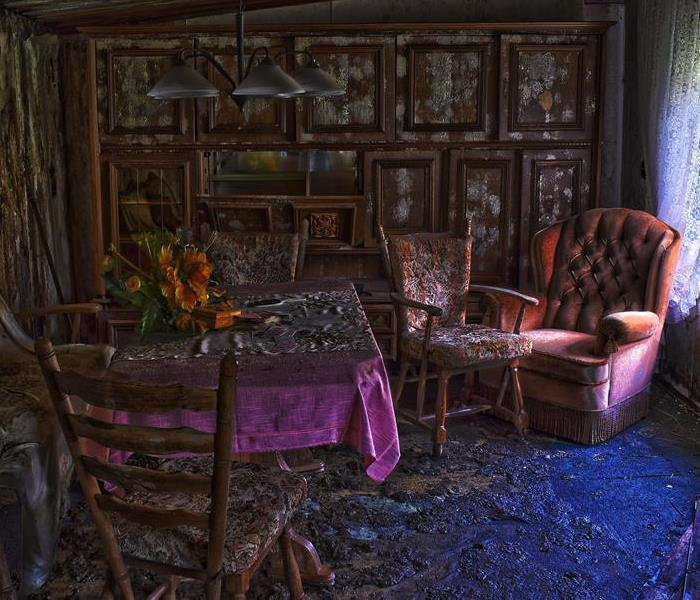 Living Room covered in mold.
Living Room covered in mold.
Did you know that mold is everywhere, both outside and inside your home? The spores are constantly floating around and cause little adverse issues until they find a nice moist place to grow. This is where small leaks in roofs, pipes, basements, windows, etc. can create a serious problem for both health and property.
Places where mold often appears include:
- areas where leaks occur, especially behind walls and concealed by sheetrock
- where flooding has occurred
- areas that routinely get wet (where is your dog's bowl?)
- windows where condensation builds up
- places where the air does not circulate well
- wet cellulose materials are most supportive of mold growth.
Molds produce spores, which spread by floating in the air. Mold spores are present in all indoor environments. There is no way to prevent spores, and they can persist in conditions where mold itself cannot grow.
Mold spores thrive in environments that are moist and warm, so when they land on a damp spot, they begin to grow.
Molds can grow on a variety of different surfaces, including fabric, paper, wood, glass, and plastic. As they grow, they may digest the material they are growing on.
Molds are classified in three different ways:
Allergenic: Molds that cause and produce health effects.
Pathogenic: Molds that cause health effects in those suffering from an acute illness.
Toxigenic: Molds that produce toxic substances that can lead to health effects. This is sometimes referred to as “toxic mold.”
PROFESSIONAL MOLD REMOVAL
Getting rid of mold is a very complex undertaking. Not only is mold difficult to identify, but it’s also dangerous to be around. SERVPRO uses mold remediation equipment and techniques that protect both you and our team. Our remediation strategy is specifically designed to address the damage that has already occurred and prevent the problem from recurring.
Not sure if there is an issue?:
SERVPRO intentionally does not do mold testing to prevent any potential conflict of interest. Often times the mold is obvious to our technicians. If there is uncertainty, we can recommend a reputable testing company that can help. Based on their findings we will develop a plan to address the remediation.
Call us today for more information.
Prevent a Dryer Fire
4/28/2021 (Permalink)
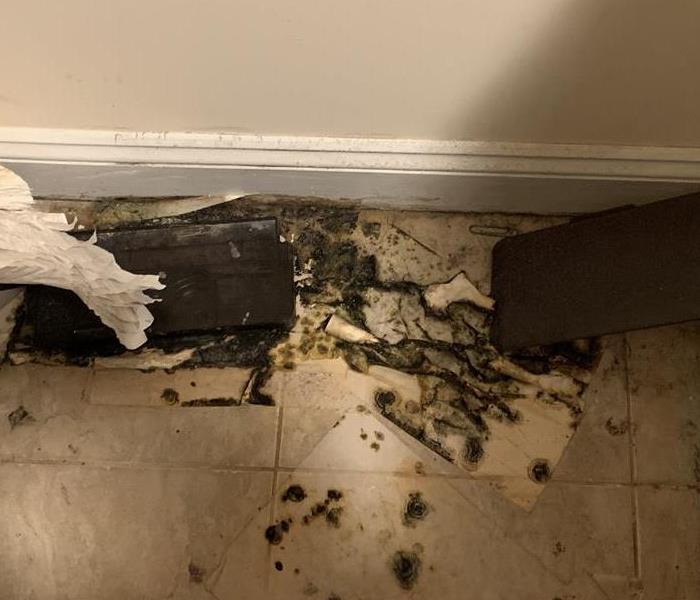 Burnt material behind a dryer that fortunately did not spread to create a structure fire.
Burnt material behind a dryer that fortunately did not spread to create a structure fire.
Dryer fires are a serious issue that causes thousands of fires in the US each year. Clogged vents can easily cause the lint buildup to ignite and quickly spread to the surrounding areas. The homeowner in the attached photo was extremely lucky that the buildup behind the dryer ignited but the fire did not spread to the surrounding material causing a structure fire.
Dirty or clogged dryer vents and ductwork reduce your dryer’s performance and efficiency. However, the buildup of heat, dryer lint, and dust can lead to a fire hazard. It is recommended that dryer ducts and vents be cleaned annually to keep your units running efficiently and safely.
If you have not cleaned your ducts/vents recently, and especially if you are experiencing any of the following warning signs, call SERVPRO today.
Warning signs:
- laundry taking longer to dry
- the clothes dryer becoming hotter to the touch
- a burning smell becoming noticeable in the laundry room.
Call SERVPRO today!
Spring Flooding
4/25/2021 (Permalink)
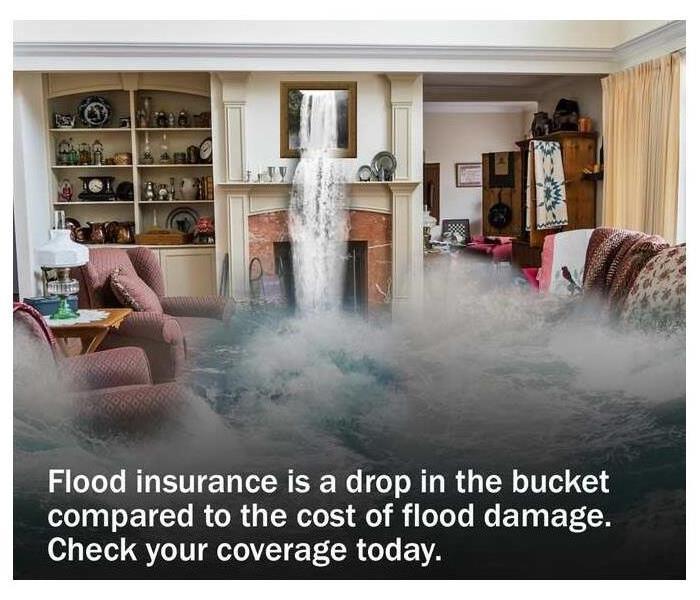 Flood insurance can be very valuable!
Flood insurance can be very valuable!
Although flooding can happen at any time, Spring flooding is common as frequent storms leave the ground soaked and streams are often at their highest levels of the year. Here are some tips for both families and businesses.
First, take advantage of a free App called the SERVPRO Emergency Ready Plan (ERP). To learn more about this app and how it can prepare your business and minimize business interruptions click HERE for a brief video. This app is also extremely useful for homeowners in preparing for a variety of disasters.
- Make a family emergency communication plan and include pets.
- Have emergency supplies in place at home, at work, and in the car.
- Flood insurance takes 30 days to take effect, so purchase now to protect your family!
- Listen to local officials by radio, TV or social media.
- Evacuate when advised by authorities or if you are in a flood or flash flood prone area.
- If you are on high ground above flooded areas, being prepared to stay where you are may be the best protection.
- Don't let your business end up in a dumpster. Make a Flood Safety plan today.
- Charge mobile devices. Locate flashlights & radio. Tell friends/family your location in case of power loss.
- Heavy rain to areas that have been experiencing drought can cause flash flooding.
If you do need to venture out during or immediately after a flood, follow these rules:
- Don’t drive or walk through flood waters
- Water moving at just 5 miles per hour can lift and displace manhole covers leaving unseen dangers
- As little as 12 inches of moving floodwater can be enough to float and carry away a small vehicle.
- 6 inches of moving water can knock an adult off their feet. STAY AWAY from moving water!
- Driving thru 6 inches of standing water can cause vehicles to lose control & stall. Avoid flooded roads.
- Be aware of areas where waters have receded. Roads may have weakened & could collapse under the weight of a vehicle.
Personal Property
- 30: The number of days it takes for flood insurance to begin. Don’t wait until it’s too late!
- Only flood insurance will cover the damage from floods. Speak with your insurance agent to learn more.
- A few inches of water in a 1,000-square foot home could cost more than $10,000 in repairs & replacement of personal possessions
- Prepare for a flood today by reviewing your property & flood insurance policies.
- Snap some pictures of your property & do an inventory. This will be handy if flood waters damage your property. Again, consider using the SERVPRO Ready Plan App.
- Flood waters can damage important papers. Store critical docs in a waterproof container or electronically.
- Before a flood: reduce potential property damage by elevating utilities & installing sewer backflow valves.
- Prepare before a flood by installing a water alarm in your basement.
After a Flood
- Watch your step! Flood waters often hide sharp and dangerous debris like broken glass and metal!
- Wear the appropriate protective clothing and gear like boots, gloves and safety glasses when it comes to moving debris!
- Hands off! Stay away from electrical utility equipment after a storm or if it is wet to prevent being electrocuted!
- Flooded homes are hazards! Get a professional to check for loose wires, mold and hidden damage before re-entering!
- Avoid walking in floodwater. It can be contaminated with oil, gasoline, or sewage.
- Use generators or other gas powered machinery only outdoors and away from windows.
Gas Safety - Part 1
3/29/2021 (Permalink)
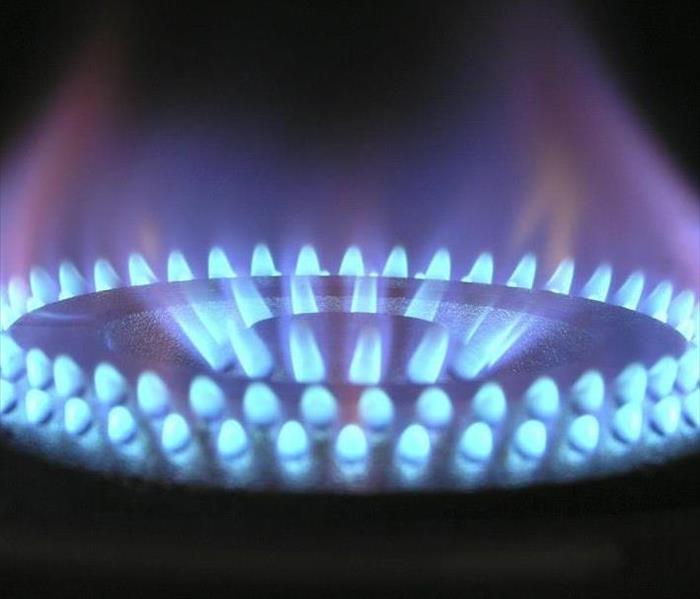 Blue flame from a gas burner
Blue flame from a gas burner
This month marks the anniversary of the 1994 Durham Woods gas pipeline explosion in Edison, NJ. This sudden explosion of a 36-inch gas pipeline was caused by minor damage from a backhoe years earlier that slowly deteriorated the pipe until it ruptured causing a ball of flame and mushroom cloud so large that one pilot flying into Newark Airport reported it as a nuclear blast.
Fortunately, these incidents are very rare. However, more mundane gas (propane or Natural gas) incidents are very common and are easily managed if you know what to do. First, call 911. This article is not intended to teach you what to do as an alternative to calling for professional assistance. The fire department and gas companies are very willing to come and help. Beyond their level of training, they have specialized tools that you won’t find in your toolbox.
Tips to prevent a gas fire/incident:
- Make sure all appliances that use Gas including furnaces, ovens, dryers, fireplaces, grills, etc. each have shut off valves that are easily accessible and functional.
- Download the SERVPRO Emergency Response Plan App and document the location of valves so you can easily share the info with friends/neighbors/first responders if you are not home.
- Have gas appliances serviced annually. Consider a service plan from PSE&G or NJNG which are a great value.
Gas Safety - Part 2
3/29/2021 (Permalink)
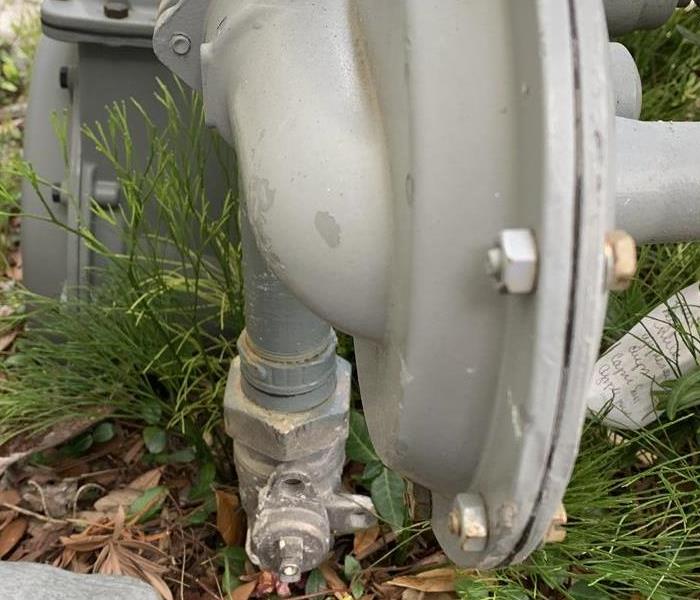 Gas meter showing shut off valve and regulator
Gas meter showing shut off valve and regulator
Natural Gas is non-toxic. It is also naturally odorless but a chemical called mercaptan is added to give it the distinct rotten eggs smell. If you smell gas in your home, call 911. You should leave the house and wait for first responders at this point. But, if you are like me and feel the leak is minor and want to address it here are some tips.
- Don’t turn on any lights or create any ignition sources.
- If the leak is coming from an appliance such as a stove or clothes dryer, see if there is a shut off valve to the unit and turn the valve handle so it is perpendicular to the pipe.
- If the leak is stopped and you want to ventilate the structure remember that natural gas is lighter than air and will float to upper floors while propane is heavier than air and will flow downstairs.
- If the leak is significant and not able to be stopped at a remote valve, the main gas line can be turned off where it enters the house. Typically a pipe comes out of the ground and runs through a regulator and meter before entering the house. There is usually a valve on the pipe before it reaches the regulator (the disk-like piece). This will turn off all of the gas to your home but will require a plumber to resume service.
- Use caution when digging. You can call 811 and have the utility companies mark their connections for free. Gas lines are plastic and can be punctured with a good shot from a spade shovel. These lines are only required to be a foot below ground and usually go straight from the gas connection to the street.
If the possible source is not obvious wait for the first responders. They have meters to test the overall gas levels in the building as well as “sniffers” that can pinpoint the exact location of the leak. They will attempt to isolate the leak and minimize the impact on your home/business until your plumber can make the repair.
ERP for Business
3/29/2021 (Permalink)
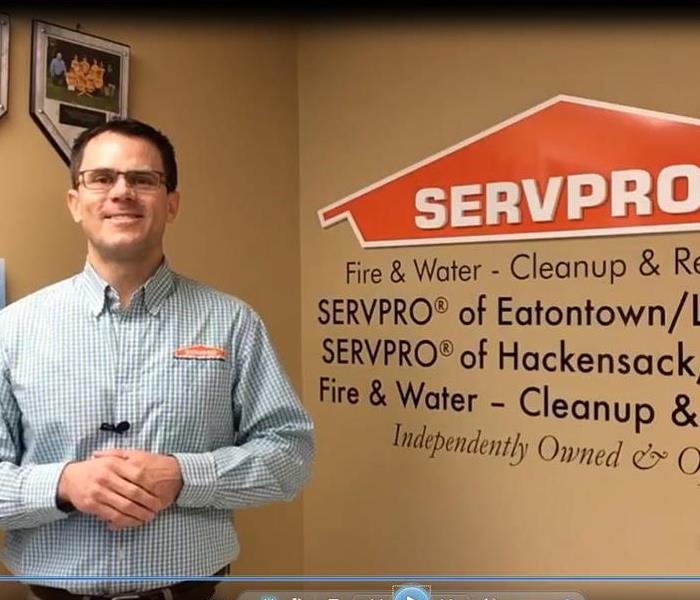 John Explains ERP use in businesses
John Explains ERP use in businesses
Are you prepared for a disaster?
As many of 50% of businesses may never recover following a disaster. Of the businesses that survive, the overwhelming majority of them had a preparedness plan in place. By developing a SERVPRO Emergency Ready Profile for your business, you minimize business interruption by having an immediate plan of action. Knowing what to do and what to expect in advance is the key to timely mitigation and can help minimize how water and fire damage can affect your business.
The SERVPRO Emergency Ready Plan is a proactive approach that provides the critical information needed to begin mitigation and recovery services. It is designed to serve as a quick reference of important building and contact information.
The SERVPRO Emergency Ready Profile is:
- No cost assessment of your facility
- An app on your phone that contains critical information needed in the event of an emergency
- A guide to help you get back into your building following a disaster
- Critical facility details such as shut-off valve locations, priority areas and priority contact information
Learn more by watching THIS 1-minute clip by John Majeski, owner of SERVPRO of Eatontown/Long Branch and SERVPRO of Hackensack/Little Ferry.
Contact us today for a free consultation on steps to safeguard your business.
High Tech Documentation of Commercial Losses
2/26/2021 (Permalink)
 Sample Matterport Image
Sample Matterport Image
Documenting a loss is critical in order to facilitate quick remediation, assure a smooth claims process with the insurance provider, and create a comprehensive plan. One of the ways SERVPRO provides superior service is through the use of a specialized 3D mapping system called Matterport. Think of it as a 3D home tour on steroids.
With this system there is no need for hundreds of photos, written statements, measurements, and repeat visits. This system also assists insurance adjusters who want to limit field time due to COVID-19 exposure. In fact, the system provides the ability to do a virtual walk-through which includes the ability to measure and tag areas of interest. This drastically improves the assessment time and the claim processing time.
However, the best way to prepare for a loss is with accurate documentation of the property’s current contents and condition. SERVPRO can complete a scan of your property to document your assets which will reduce potential discrepancies and disputes with insurance carriers.
To learn more and get a free estimate, call us today!
SERVPRO Storm Teams
2/26/2021 (Permalink)
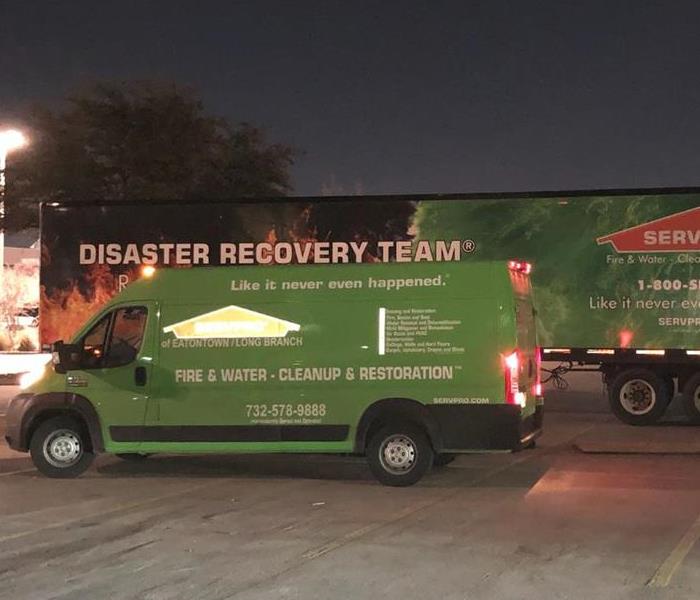 SERVPRO of Eatontown/Long Branch van operating in Texas.
SERVPRO of Eatontown/Long Branch van operating in Texas.
SERVPRO Storm Response Teams coordinate large scale responses, such as the recent deep freeze in Texas. This is a scalable organization similar to first responder’s modular Incident Command System. For the current disaster in Texas and other states, there are two storm response teams coordinating 1,000+ SERVPRO teams. Both SERVPRO of Eatontown/Long Branch and SERVPRO of Hackensack/Little Ferry are proud to have teams currently operating in Texas.
This requires specialized training for leaders in large scale incident management, logistics, planning, and communications. Responding teams need to understand how they will be asked to integrate into the larger organization and what protocols will be required.
Franchises who participate in Storm Response Teams are proactively trained in many areas including travel requirements and equipment needs, operating in storm damaged areas safely, FEMA expectations, budgeting, and regulatory considerations between states.
Participation in these teams is voluntary and represents a high level of commitment to technical expertise and constant preparedness. It is not only the commitment of the organization but the personal commitment of each team member who volunteers. They answer the call knowing this means leaving home for several weeks in a row to help someone in need. We are thankful to all of our team members who have answered the call!
Is Your Smoke Detector Working?
2/25/2021 (Permalink)
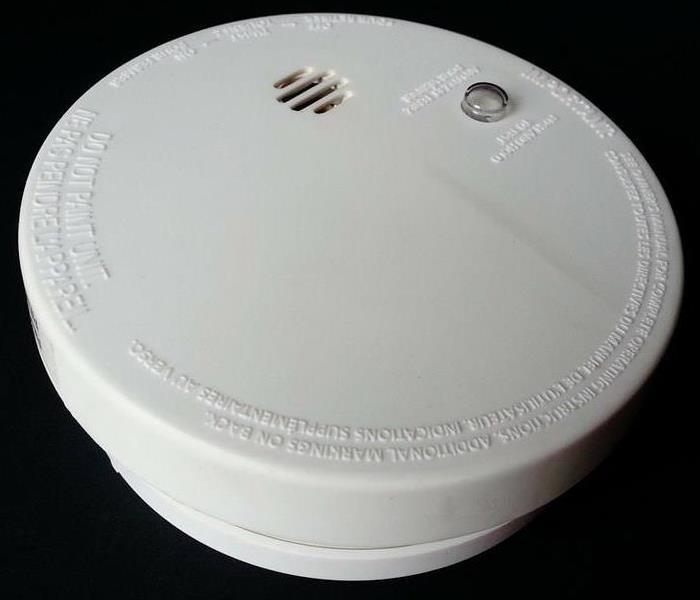 A typical smoke detector
A typical smoke detector
Are your smoke detectors working correctly? In many homes and businesses the answer is no. Often the problem is that they are perceived as a hassle and there are too many false alarms. The information below will help you troubleshoot your system because the simple fact is that smoke detectors save lives and prevent property damage.
All too often the answer for property owners is to disable the system to avoid the nuisance alarms. The batteries are removed, the system is disabled, or the devices are removed entirely. This is usually undetected, especially in private homes where fire officials do not perform regular inspections and have limited enforcement powers.
There are 3 basic types of systems but the tips below are largely the same for each. Single station units are the ones you buy at the hardware store and screw to the ceiling.
Hardwired/interconnected may look the same but they activate as a group ensuring that all areas of the home get the message. These first 2 types only notify the occupants. Monitored systems may be wired or wireless but they notify the fire department when activated.
The smoke detectors themselves are typically one of 2 types: Ionization or photoelectric. Ionization units use a small amount of radioactive material that detects invisible particles created by the fire using electrical currents. They are more expense so most people have photoelectric units. Photoelectric units use a beam of light which is deflected by smoke particles to activate.
The main problem is that other “stuff” can enter the chamber, block the light, and set off an alarm. This includes dust and bugs. The most common unwanted cause of activation is a contractor sanding near the unit. This is easily identifiable but a little spider passing through often makes the owner think the device malfunctioned.
To prevent issues follow these tips:
- Cover the detector when working nearby, especially sanding
- Put a monitored alarm system on test if you are doing something that may activate the system
- Change your batteries each time you change the clocks
- Use a vacuum to clean the unit periodically
- Units have a manufacture date on the back of them and they expire after 7-10 years depending on the brand. Replace them when needed.
Whatever you do, don’t disable these important systems. The fire department would much rather respond and find a minor issue than fight a significant fire because your system was disabled. Your local fire department is most likely offering a complementary home safety survey which can answer any questions you have along with other helpful advice.
Be Prepared
1/29/2021 (Permalink)
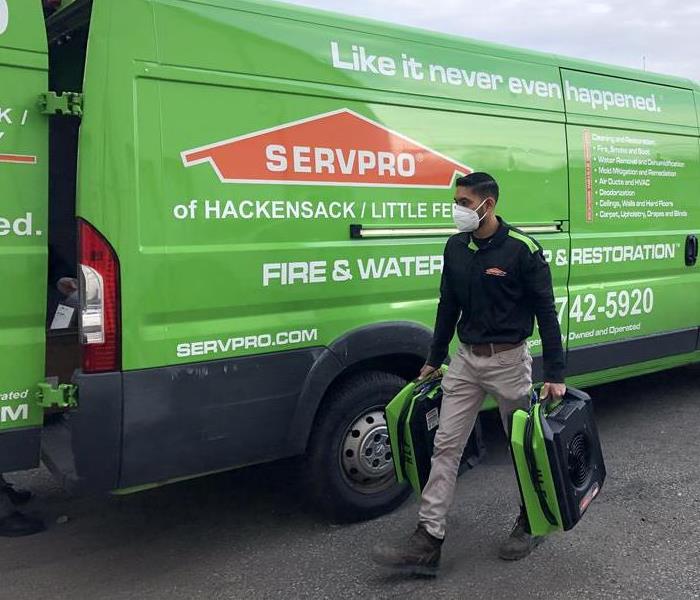 Loading equipment in preparation for the next job
Loading equipment in preparation for the next job
At SERVPRO of Eatontown/Long Branch we are constantly reinvesting in our people and equipment. Like the Boy Scout motto says, "Be Prepared."
Unlike most companies, we do not have the luxury of reviewing plans, determining the scope of work, and investing in the right tools and equipment in preparation for a job. It is normal for most builders, contractors, and tradesman to have several days or weeks to prepare for a job. Our turnaround time from receiving the call to beginning a job is measured in minutes, not weeks.
To be prepared we need the proper tools for all types of jobs on hand, well maintained, organized, and ready to load. Our team does an amazing job or pre-planning and preparation. Our dedicated warehouse team performs preventative maintenance, monitors inventory of equipment and chemicals, and orders additional supplies.
Grab the Fire Extinguisher
1/28/2021 (Permalink)
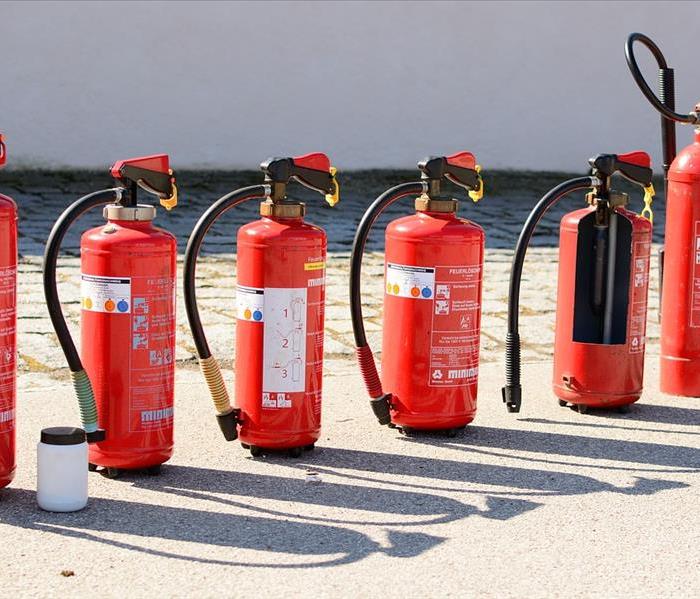 Several Types of Fire Extinguishers
Several Types of Fire Extinguishers
One of the most obvious things you can do to limit fire damage is to extinguish the fire quickly. However, some of the most common causes of residential fires are Cooking (48%), Heating appliances (14%), and Electrical malfunctions (14%), and these are not safely or effectively extinguished with water.
I am a firefighter and last night we had a call at 4AM caused by an electrical outlet which was sparking and catching the wall on fire. These calls are very routine. As a homeowner, you do not want to spray water on an electrical outlet due to the risk of electrical shock. YOU NEED TO HAVE A FIRE EXTINGUISHER IN YOUR HOME!
Fire extinguishers come in a variety of types based on the classification of fire they are designed to extinguish. For home use you should have a class ABC extinguisher which means is can extinguish class A fires (solid materials like wood), class B fires (liquids like gasoline or oil), and class C fires (electrical equipment).
Most towns require at least 1 extinguisher under the kitchen sink in order to obtain a certificate of occupancy to sell a home but these tend to disappear over time. Personally, I keep one under the sink, one on the wall in the laundry room, and one in the garage. At least maintain the class ABC extinguisher under your kitchen sink at a minimum.
If you do experience a fire, call the professionals at SERVPRO to help restore your home, “Like it never even happened.”
Have You Had Water Damage in Your Home?
1/28/2021 (Permalink)
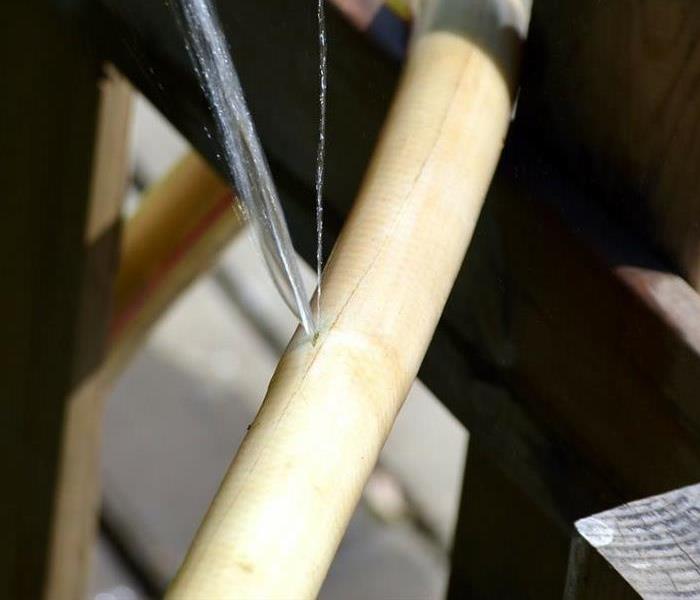 Water Spraying from a Hose
Water Spraying from a Hose
Have you had water damage in your home? On average, homes experience water damage once every 11 years. This damage is caused by a variety of sources, most of which can be mitigated through periodic monitoring and maintenance. Here are some tips to help you find some of the routine causes.
Gutters
- Make sure the gutters are not clogged by leaves and debris. This will cause standing water that can freeze and cause ice dams. For more information on ice dams click on this related blog Ice Dams
- Downspouts need to be extended far enough away from the house to prevent water from entering the basement
Plumbing
- Look for leaks under your refrigerator. Not only does removing dirt help improve the unit’s efficiency but the water supply line to the ice maker can come loose and cause a leak that is hidden due to its location. As a side note, I experienced a leak here about a year ago due to a mouse chewing on the supply line.
- Washing machines often have very old and degrading supply lines. Is yours appear worn you should consider a new set which are easy to install. Look for the ones that have a metal mesh around them for added reinforcement
- Dishwashers also have water supply lines and can have issues similar to ones noted in the refrigerator section.
Sinks
- As above, check the supply lines for leaks.
- Check the drain, especially the S-trap under the sink to make sure it hasn’t wiggled loose after being bumped by items stored in this space
Humidifiers
- One last time, check the supply lines. These units should be turned on in the fall and off in the spring at the closest valve to limit the risk of leaking during the warm weather.
If you experience water damage, call the experts at SERVPRO of Eatontown/Long Branch at 732-578-9888.
Hidden Dangers of Power Outages
1/28/2021 (Permalink)
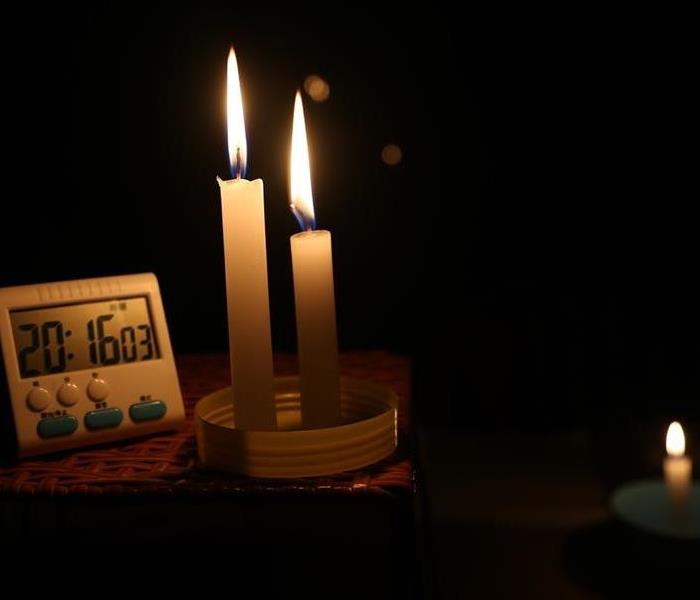 Candles on a Night Stand
Candles on a Night Stand
When the power goes out it can be very annoying, especially if you have no internet. But, there are more serious concerns that you should be considering to protect your home. Without power several critical systems in your home are going to be offline. Here are some items to consider:
Sump Pumps: these pumps are located in the basement and prevent water from entering from the ground. Without power the pump will not operate and water could enter from the sump pump pit.
Heating units: even gas powered heating units need electricity to run the blowers/fans that push the air through ducts and around the home. Without heat the pipes are susceptible to freezing and rupturing. If the temperature outside is below freezing consider turning the faucets on just a little bit to keep water moving in the pipes. This not only introduces warmer water from underground pipes but the movement of the water helps prevent freezing.
Freezers: If you haven’t thawed your freezer in a while you may have significant ice buildup that will begin to melt and cause water to puddle at the freezer door. You are better off putting a baking tray under the door rather than opening the door and trying to manually remove the ice. Opening the door will cause the cold air to escape and will lead to more rapid thawing/spoiling of food if power is not restored quickly.
Of course a back-up generator is your best bet for restoring power quickly but these can be costly, especially built in units. If you do have a generator (portable or built-in) make sure it is wired to provide power to the critical systems above.
If you do experience storm damage, call the experts at SERVPRO!
Storm Surge Flooded Floors
1/28/2021 (Permalink)
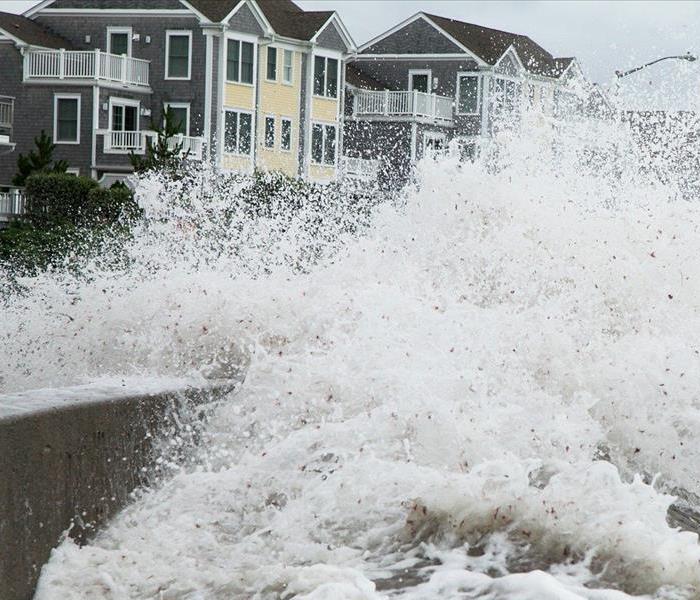 Storm surge approaching houses
Storm surge approaching houses
Storm surges can be dramatic and cause significant damage but with the proper tools and training it doesn’t have to mean a total renovation. The only good thing about storm surges is that the waters often recede as quickly as they rush in. Hardwood flooring that is properly protected with polyurethane can withstand water penetration if remediation happens quickly. At SERVPRO we have the right equipment and training to often save hardwood floors instead of removing them. Here are three techniques we use.
First, our injecti-dry panel system is one way to extract the moisture. Our technicians use plastic sheeting to create a containment area and install dehumidifiers to regulate the moisture levels. The panels are installed with special methods to reduce additional damage. We then use moisture measuring meters to monitor the changing moisture levels all the way to the sub-floor.
Second, we may utilize a heat drying system which heats the material to approximately 100 degrees. Heat ducts are installed to remove the humid air and infrared monitors are used to monitor the drying process.
Finally, a Desiccant Dehumidifier may be used to introduce outside air which is passed through a dehumidifier before being introduced to the material. Again, moisture monitoring equipment is used to measure the progress and reduce moisture at a controlled rate.
If you experience flooded floors call us to see if one of our methods can be used to save the material before you begin removing any material.
Storm Front Coming
1/27/2021 (Permalink)
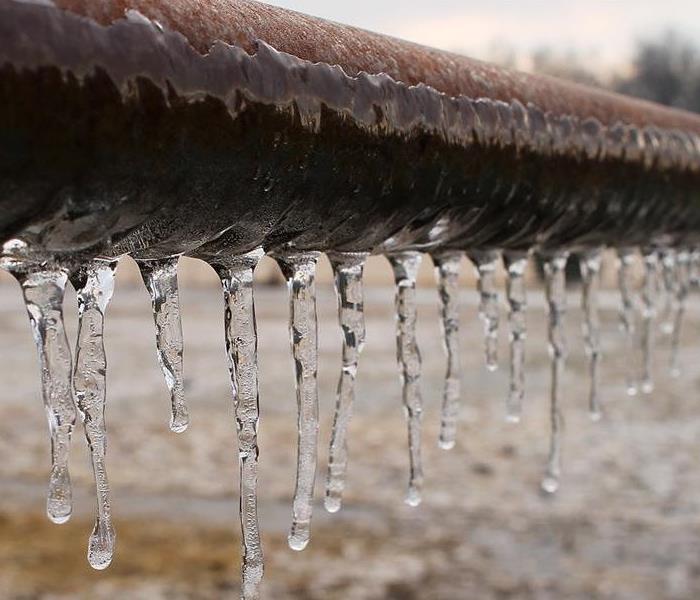 Icicles Hanging from a Frozen Pipe
Icicles Hanging from a Frozen Pipe
Prepare for the next Arctic Blast coming this Friday. The high temperature on Friday will be in the low 20’s with a low near 15 degrees. Is your home ready to withstand the blast?
Here is a simple checklist of items you can do to prepare for the cold:
- Have your HVAC system checked if you have not already done so. An HVAC system failure in freezing temperatures is not only an uncomfortable inconvenience but could lead to frozen and ruptured pipes.
- Clean your chimneys to remove soot build up and prevent a possible clog. Smoke blowing back into your home can make a real mess.
- Test your smoke and CO2 alarms to make sure they are working and have charged batteries.
- Make sure all outside plumbing including hoses, lawn sprinklers. and pool equipment is off and pipes are drained.
If you experience storm related damage call SERVPRO at the number above.
COVID Market Research for Businesses
1/27/2021 (Permalink)
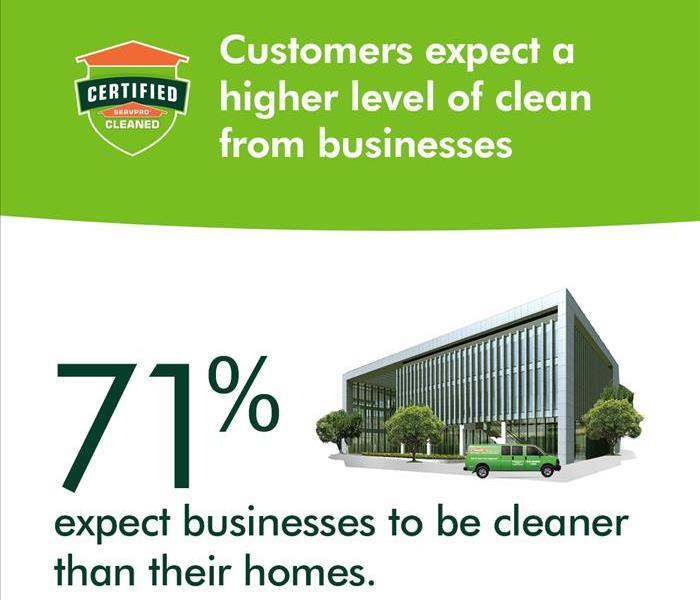 Research Study Sample Finding
Research Study Sample Finding
According to a study by Message Factors, Inc., a market research firm, businesses are being held to a high standard for COVID-19 cleanliness.
- Consumers expect your business to be cleaner than their home.(71% expect businesses to have higher cleanliness standards than respondents do in their own homes.)
- Ifyou aren’t clean, your business will suffer great damage to its reputation. (76% say the way a business addresses cleanliness during COVID is a good indicator of how well that business is run in general.)
- This is the start of a new era for cleanliness and businesses.(73% say they are going to be more attuned to cleanliness once COVID is over.)
- Customer concerns about COVID are not going away any time soon.(68% are constantly thinking about avoiding COVID exposure when out in public.)
- All else being equal(product, price, service, convenience) customers trust businesses that are professionally cleaned over ones that self-clean. (64% are more likely to choose to shop at the store that has a decal stating the store has been professionally cleaned.)
- Surface cleaning remains a significant concern. (59% are worried about COVID exposure from touching surfaces that have not been sufficiently cleaned.)
If you are interested in having your business professionally cleaned and certified, call SERVPRO!
What Type of Water Is It?
1/27/2021 (Permalink)
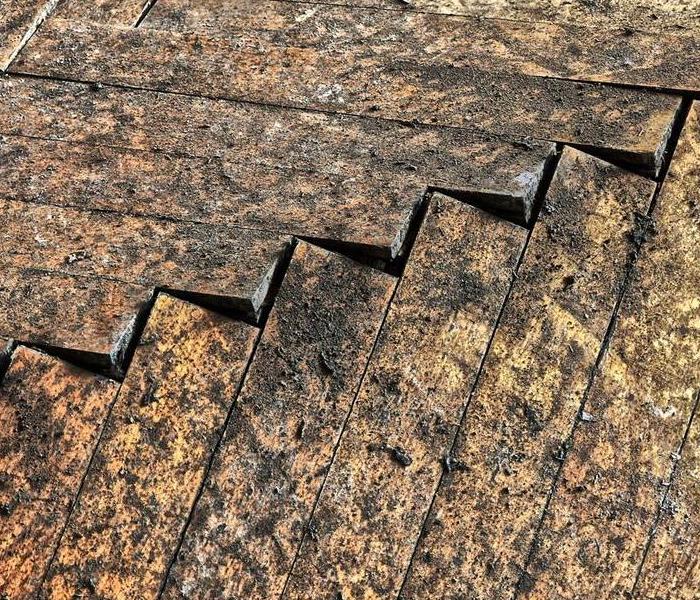 Boards after water damage
Boards after water damage
What type of water is it? No, sparkling or tap are not options when it comes to water damage. There are 3 classifications of water when it comes to flooding: Clear, Gray, or Black. These are not exact terms but designed to give an indication of the level of contamination within each.
Clear Water originates from water pipes such as water mains or plumbing in your home. It is always essential to remove the water as quickly as possible but clear water is the easiest because there are reduced safety procedures involved.
Gray Water is water which may have contamination. Therefore, a moderate degree of care and safety precautions are warranted. This water may come from storm damage or flood damage from more natural sources.
Black Water is the most serious and dangerous. SERVPRO technicians are trained in handling this material, along with many other biohazards. Typical sources may include septic tanks or waste water pipes that have ruptured. This type of water causes the most dangerous due to the microbial parts it contains and the accompanying health effects of exposure. Don’t tackle these situations yourself. Call the experts at SERVPRO!
Ice Dams
1/23/2021 (Permalink)
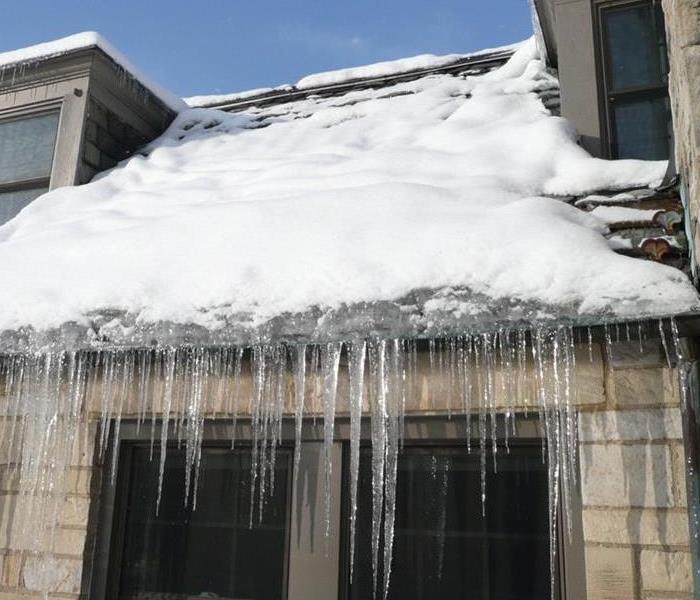 Ice Dam on a Roof
Ice Dam on a Roof
It looks like we have a winter storm moving into NJ this week. At SERVPRO this means we will likely receive calls for water leaking through the ceiling. The most common cause during winter storms is Ice Dams.
Ice dams form when the snow melts, runs down your roof and refreezes near the edge or in a valley. This only occurs when the roof has colder and warmer spots which allow the water to melt and then refreeze. Where the water refreezes it masses and creates a ‘dam” which pushes the water back up the roof. This water pushing/flowing against the usual force of gravity helps it to find openings to penetrate the roof and ceiling below.
Typically, heat escapes through ceilings into the attic and warms the wood and shingles directly above it. Although the outdoor temperature is below freezing, the snow melts over the warmed section of roof. Ideally, you should not see the snow melting on the roof if the temperature is below freezing. This means sufficient heat is escaping from your home’s living spaces to provide enough warmth to melt the snow. You should also not see uneven melting as evidenced by bare shingles next to patches of snow. The melted areas show where the strongest heat loss is occurring.
If you see these warning signs on your roof you should take steps to prevent an ice dam from occurring. The overall strategy is to keep the roof cold which also makes your home more energy efficient and comfortable. Three steps to consider are:
- Look for openings which may be causing heat loss such as gaps around pipes and air ducts which can easily be filled with spray foam.
- Make sure the attic floor is properly insulated with insulation rated at R-40 or higher. Look for areas where insulation has been removed or pushed aside such as bathroom exhaust fans or other modifications.
- Make sure your roof is properly ventilated, based on the type of roof you have.
A technician from SERVPRO can perform an inspection for you using a thermal imaging camera to view and photograph areas where heat is escaping. This needs to be done on a cold day.
If these measures don’t work you might consider installing a heating coil in the affected area with a thermostatic switch which turns on the heating coils when the temperature drops below freezing. For worst case scenarios, safely remove the snow and ice manually with a shovel and/or broom until a long term solution can be found.
You Will Thank Me One Day
1/20/2021 (Permalink)
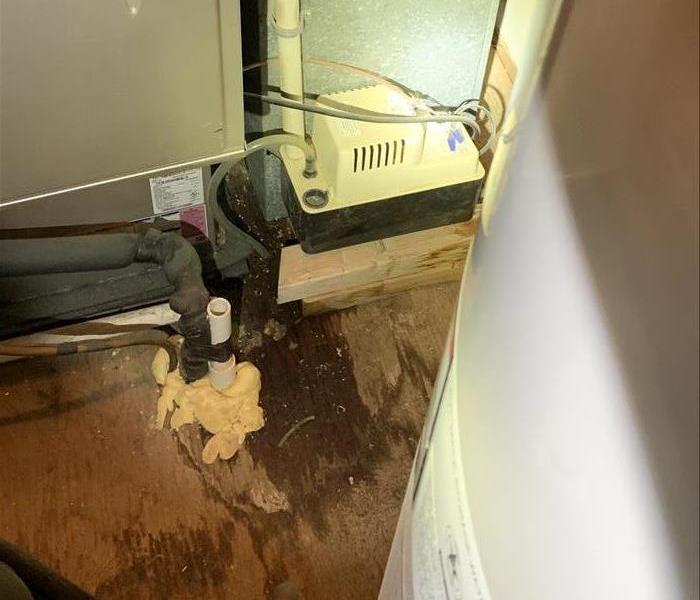 Water Collecting Next to a Furnace
Water Collecting Next to a Furnace
How often do you check the mechanical closet/spaces in your home? If you’re like me, you are proud of yourself if you remember to change the air filter even once a year. Like many issues that arise with home ownership, an ounce of prevention is worth a pound of cure.
I recently went into my mechanical closet to get a folding chair and noticed water on the floor. “Where did that come from,” I wondered. It wasn’t the hot water heater or near any plumbing. It was next to the furnace (see image). While the amount of water was fairly minimal, it would certainly result in a deterioration of the plywood flooring and create a breeding ground for mold.
I had my HVAC contractor come and the cause was a tiny hole in the exhaust flu. When the weather turned cold the moisture in the exhaust condensed and ran back down the flu, leaking out onto the floor. I paid $99 for the service call to have it repaired.
The lesson: check your mechanical areas periodically to look for signs of water, mold, or other mechanical issues that could result in more significant issues if not addressed. You will thank me one day…
Proper Soot Remediation
1/20/2021 (Permalink)
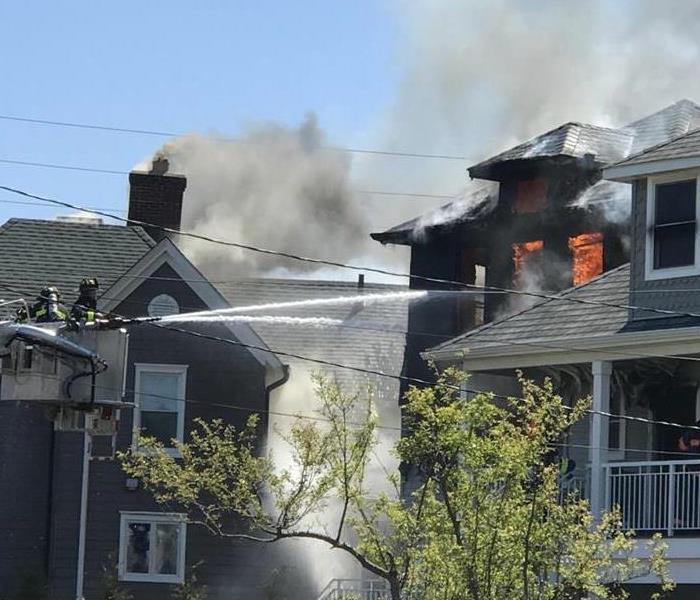 Smoke-filled Houses
Smoke-filled Houses
The possible health effects of a fire can last long after the flames are extinguished. In fact, decontamination of soot and environmental exposures is the “hottest” topic in the fire service today. The nasty chemicals caused by fire can linger for long periods of time on surfaces and in belongings. Make sure these items are professionally cleaned.
Soot is made of tiny particles created by incomplete combustion, technically called pyrolysis. (Fun fact: solids and liquids can’t burn. Heat at the surface of these materials is converting them to gasses which burn.) Even the basic wood used in framing (Douglas Fur) causes 75 different chemicals including poisons such as hydrogen cyanide and phosgene. These particles linger in the form of soot leaving a dangerous smelly mess.
During a fire, soot spreads to the whole house, attaching to surfaces. The acidic properties of soot can further damage your home and indoor air quality if the soot is not removed immediately.
Soot can inhabit your home even without a fire. Candles can lead to soot buildup, fireplaces can release soot as well if not ventilated properly, and furnaces are also a source of soot contamination when they produce a puff back (reference our blog on puff backs at What is a Puff Back? .)
To avoid the health risks of soot exposure after a home fire, make sure that all soot-affected areas are properly cleaned and sanitized.
When cleaning soot, wearing safety equipment to protect the lungs, skin, and eyes is essential in reducing soot exposure. Specialized techniques such as air scrubbing are also needed to restore indoor air quality following a fire.
A dust mask and a household cleaner are not enough to clean up soot! Removing soot requires professional tools, knowledge, and expertise. Certified experts at SERVPRO can properly clean soot and odors from your entire home to ensure it is safe to inhabit.
If you are concerned about these exposures in your home, call us today for a consultation at 732-578-9888.
It's Just Water
1/18/2021 (Permalink)
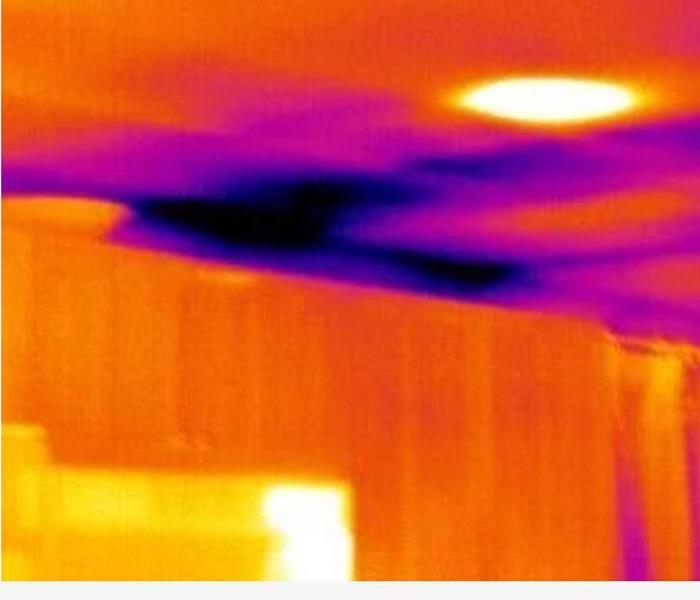 Water damage visible through a Thermal Imaging Camera
Water damage visible through a Thermal Imaging Camera
It’s just water, but it makes a huge mess! Even a small leak can create a massive amount of damage and pose serious health concerns for the long term. It is important that those cleaning up water damage have the proper training and equipment. This is not a job for your typical general contractor!
The cosmetic aspects of a remediation project are fairly obvious to identify but what about what you can’t see? Water saturated insulation, flooring, and sheetrock can be a breeding ground for potentially harmful mold that may not become apparent for a long time. This growth may also cause health issues including respiratory and auto-immune issues.
One way SERVPRO uses technology to assess the extent of water damage is with a Thermal Imaging Camera (TIC). This roughly $2,000 piece of equipment uses varying colors to show heat changes, making dampness visible. A local handyman or general contractor will not have this type of technology.
Wet areas in the building material do not warm and cool the same way adjacent dry areas do and this makes them visible when looking through a TIC. The photo shown here is from recent water damage at a local school here in NJ. To the naked eye the area shown appeared to be undamaged. However, when viewed as a thermal image the pattern of water soaking into the material from the flooded floor above becomes apparent. Had this area not been removed and replaced it could have created mold issue for the staff and students.
All About the People
1/15/2021 (Permalink)
 Owner John Majeski
Owner John Majeski
Isn’t it always about the people? When you hire someone to do a job, any job, satisfaction always comes down to the people doing the work. At SERVPRO of Eatontown/Long Branch and SERVPRO of Hackensack/Little Falls we have the best.
Training is important so our leaders and project managers maintain the highest levels of certification from The Institute of Inspection Cleaning and Restoration Certification (IICRC). However, training is not just an event. Our entire team receives ongoing weekly continuing education. This training is supported by SERVPRO’s industry leading training group.
Beyond training there needs to be accountability. All of our employees receive a criminal background check before hire and our project managers are hands on in managing the job site.
Insurance is also essential. God forbid something goes wrong, how do you know you will be protected? SERVPRO maintains all of the necessary insurance at levels that exceeds the industry recommendations. This includes Liability protection and Worker’s Compensation Insurance.
What does this all mean? Satisfied customers, as our online reviews can attest!
Don't Ruin Your Vacation
1/13/2021 (Permalink)
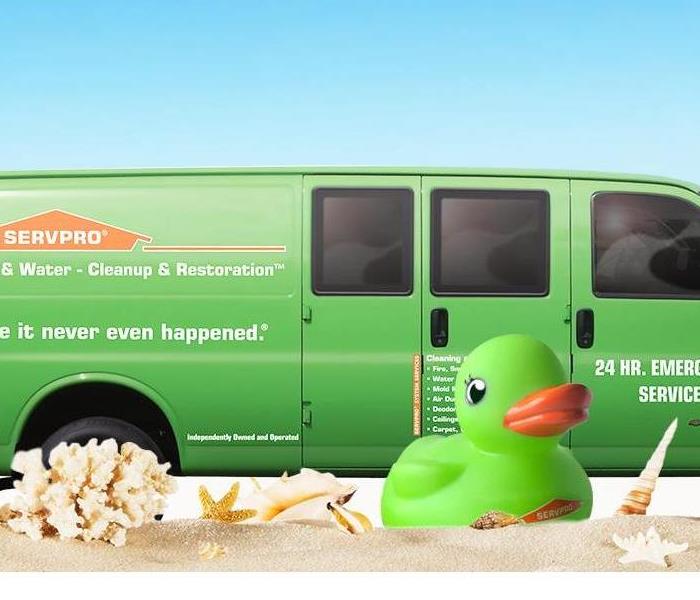 Oh, I'd like to be that van!
Oh, I'd like to be that van!
Are you looking forward to going on vacation again? Our family’s “Spring Break Trip” looks like it is going to be cancelled due to Covid, so my wife (Happy Birthday!) wants to take a road trip to FL. I love vacation but I always have that voice in the back of my head wondering if I set the alarm, locked the doors, and did my wife unplug the hair straightener (yes honey, I love you, and it’s your birthday, but this is a legitimate concern). But, what else am I forgetting? What about Water damage?
Before you leave, it is important safeguard your home from possible water damage. Here are some easy steps to protect your home and prevent vacation from being cut short due to a disaster.
Take a proactive look before you leave
Check for leaks in your plumbing, focusing on the pipes and connection you can see inside your house. The weakest points are places where hoses connect to taps or household appliances. Check under sinks for signs of leakage and rust and around water heaters, dishwashers, furnaces, and washing machines
Turn off the Water Supply
Shut off the water supply to the home and the hot water heater itself. Not only are hot water heaters a major culprit of water damage but there is no need to keep 75 gallons of water piping hot while you are away. Even a small leak, from a toilet supply line for example, can cause a massive amount of damage if not detected quickly (See our Facebook post from 12/4 at Simple toilet leak - NJ).You may also choose to, additionally, shut off the valves at your toilets, appliances, washers, and dishwashers.
Commercial Water Damage Concerns due to COVID-19
12/31/2020 (Permalink)
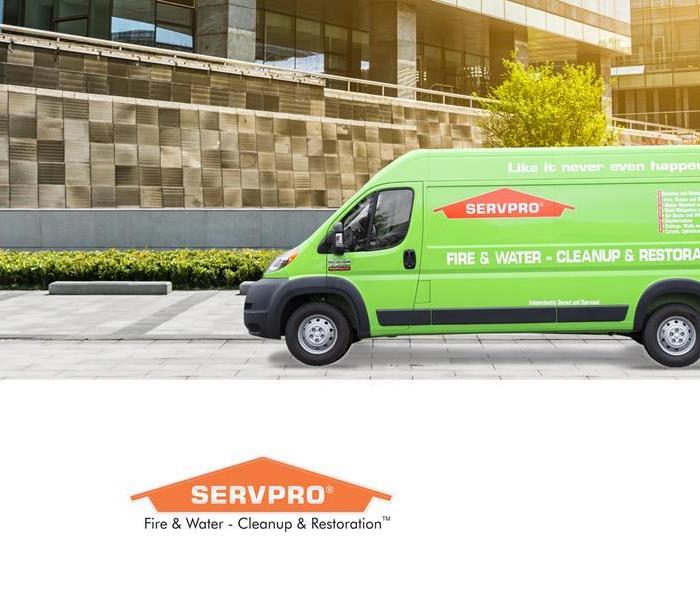 SERVPRO Cleans Commercial Properties
SERVPRO Cleans Commercial Properties
With many offices and commercial spaces vacant, or minimally staffed due to Covid, water damage has become more common and more severe. There are several reasons for this increase but many can be prevented with a few simple steps. Here is a list of causes and some steps to prevent a disaster.
- Broken pipes due to freezing – With less staff working, water is not flowing as regularly and pipes are more prone to freezing. Consider shutting off/draining water pipes to areas that are not being used.
- Stagnant water – water sitting in pipes can become rusty and foul. Run the water/flush toilets daily which keeps water fresh. This also helps to keep water in the drain’s “S-trap” which prevents sewer gases from coming into the property.
- Undetected leaks – slow leaks that go undetected can lead to significant mold issues. Major leaks can cause catastrophic damage if they are allowed to flood the structure undetected. Assign a team member to walk the property regularly looking for potential leaks, especially new markings in ceiling sheet rock or tiles.
- deferred maintenance – While the facility may not be getting it’s typical wear and tear, regular maintenance is still needed on essential systems like boilers, furnaces, and alarm systems.
Should a loss occur call SERVPRO of Eatontown/Long Branch at 732-538-9888.
Santa Came Early
12/29/2020 (Permalink)
 SERVPRO Commercial Services
SERVPRO Commercial Services
Commercial restoration requires a significant capacity. Due to the size and complexity of a large-scale commercial disaster, the demands on resources, manpower, expertise, and equipment can be extreme. Many restoration companies are not equipped to scale-up from residential clean ups to tough commercial operations. The decision to prepare for these types of jobs needs to be made well before disaster strikes.
Required pre-planning and investments:
- Equipment: the right tools for the job need to be ready in advance. This means a significant investment in purchasing, maintaining, and warehousing an adequate quantity of each type of equipment needed. While our owner, John, likes finding reasons to wear his Christmas suit the real message to the team is we are ready!
- Manpower: Any restoration company needs to have a variable staffing pool including full-time, part-time, per diem, and contract workers. But, in commercial jobs the level of expertise needed is hire and this labor pool needs to be trained and ready to go when the time occurs.
- Expertise: Our leaders and project managers maintain the highest levels of certification from The Institute of Inspection Cleaning and Restoration Certification (IICRC).
Even with the best preparation, large scale disasters like Super Storm Sandy here in NJ can cause a need for a large scale disaster response. SERVPRO coordinates a nationwide network of 1,700 franchises along with corporate-deployed resources to ensure that our clients receive the service they require in even the worst of times.
Check out the video of what Santa delivered at Santa Came Early
To talk about SERVPRO can help you pre-plan for a commercial disaster please call
SERVPRO of Eatontown/Long Branch at 732-538-9888
What is a Puffback?
12/26/2020 (Permalink)
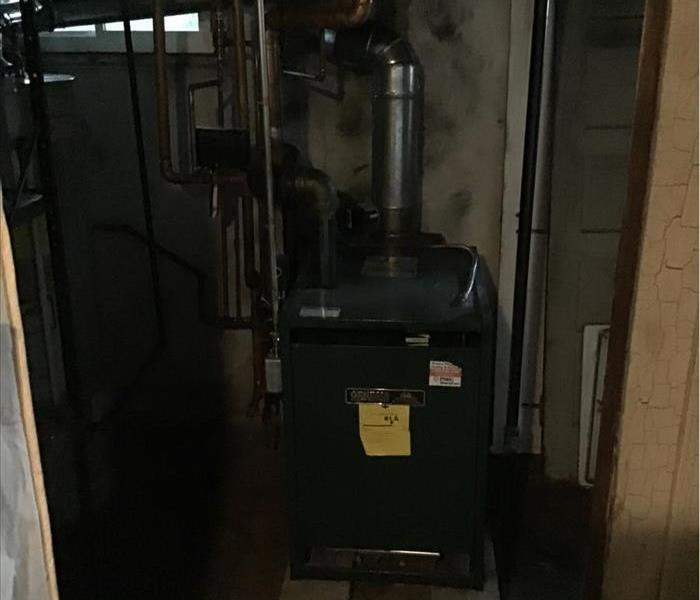 Furnace after puffback
Furnace after puffback
Do you stay up at night worried about Puffbacks? Yeah, I didn’t think so but this quick read could save you a big headache. Many people don’t even know what a puffback is but they are fairly common.
A puffback is an explosion of unburned fuel vapors inside your furnace, boiler, or hot water heater. The explosion does not pose a serious safety issue but can cause a huge mess of soot and ash that gets blown into your property. Puffbacks can happen in both natural gas and oil fueled furnaces but are more common in oil furnaces due to the need for more routine maintenance.
Fortunately regular maintenance can help prevent a puffback:
- Don’t keep pressing the reset if your furnace is not working properly or staying lit. Schedule a service call with your HVAC contractor.
- Have your heating system serviced annually including a check for clogged burners.
- Look for visible oil leaks/dripping around the oil supply piping.
- Make sure the flue vent is securely connected. Small puffbacks over time loosen this connection.
- Check the exhaust flue and chimney for obstructions.
- Dirty ignition electrodes don’t generate enough of a spark to burn all of the fuel causing excess fuel to puddle in the combustion chamber causing corrosion.
Should you experience a puffback, the SERVPRO team has the tools and training needed to restore your property. Specialized tools for this job include proprietary chemicals to remove soot, eliminate odors, and prevent stains. Our technicians are highly trained in property damage restoration. From initial and ongoing training at SERVPRO’s Corporate Training Facility to regular IICRC industry certifications, rest assured our staff is equipped with the knowledge to restore your property. Our training program includes the following:
IICRC Training
Employee Certification Training
Initial Franchise Training
e-Learnings
Continuing Education Classes
Call SERVPRO of Eatontown/Long Branch at 732-578-9888
Fun fact: I am a volunteer firefighter and while writing this blog I received an alarm for a smoke condition in a local bank. After our investigation the likely cause was determined to be a puffback in the natural gas heating system. The bank’s HVAC contractor is enroute for a service call.
SERVPRO Cleaning Services for COVID-19
12/5/2020 (Permalink)
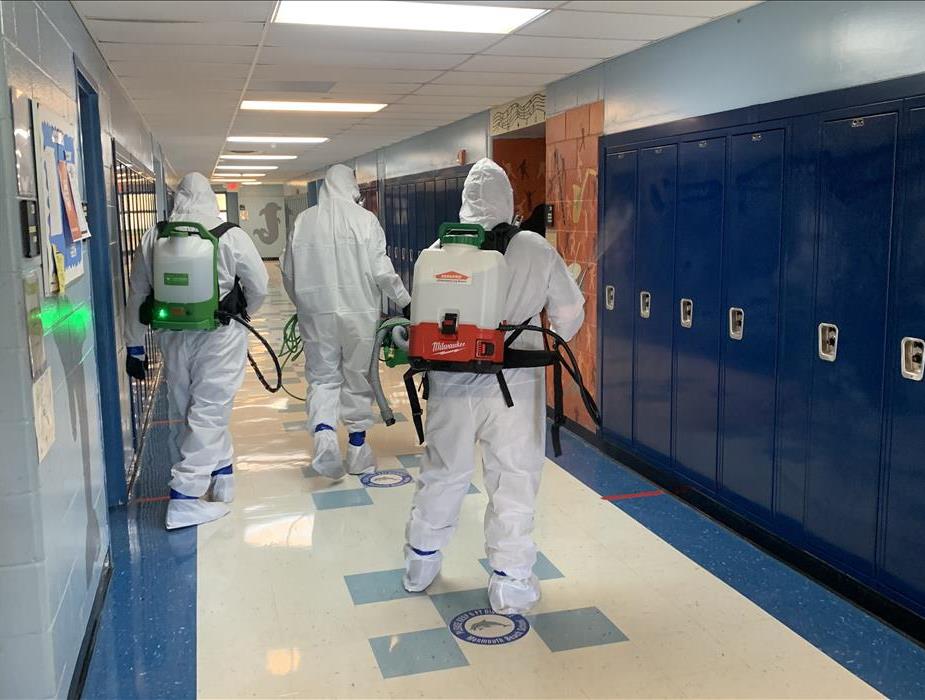 Our Crew Getting to Work in a Local School
Our Crew Getting to Work in a Local School
SERVPRO is Here to Help during this time of need
During this unprecedented time caused by the global pandemic of coronavirus, this is a reminder to our customers that we are specialists in cleaning services, and we adhere to the highest cleaning and sanitation standards. SERVPRO of Eatontown/Long Branch has been busy cleaning facilities or all types including nursing homes, schools, restaurants, and government offices.
Specialized Training
We are prepared to clean and disinfect your home or business, according to protocols set forth by the Centers for Disease Control and Prevention. We have years of experience in dealing with biological contaminants, and we will go beyond the scope of work that regular janitorial staff perform on a daily basis.
The CDC encourages cleaning of high-touch surfaces such as counters, tabletops, doorknobs, light switches, bathroom fixtures, toilets, phones, keyboards, tablets and tables. Other spaces mentioned in the CDC’s guidance for commercial spaces include:
- Kitchen/Food Areas
- Bathrooms
- Schools/Classrooms
- Offices
- Retail Spaces
- Water Fountains
- Shelving/Racks
- Sales Counters
- Carpets and Rugs
- Stair Handrails
- Elevator Cars
- Playground Equipment
- Fitness Equipment
Specialized Products
The CDC recommends usage of a labeled hospital-grade disinfectant with claims against similar pathogens to the coronavirus. Multiple products in the SERVPRO product line carry the EPA-approved emerging pathogens claims. While there is currently no product tested against this particular strain of the coronavirus, we are following all guidelines as provided by the CDC and local authorities.
Call Today for a Proactive Cleaning
If your home or business needs deep cleaning services, call the experts today – SERVPRO of Eatontown/Long Branch, 732-578-9888
Sources:
https://www.cdc.gov/coronavirus/2019-ncov/hcp/guidance-prevent-spread.html?CDC_AA_refVal=https%3A%2F%2Fwww.cdc.gov%2Fcoronavirus%2F2019-ncov%2Fguidance-prevent-spread.html
https://www.cdc.gov/coronavirus/2019-ncov/specific-groups/guidance-business-response.html
It's Time to Prepare for Nor'easter Season
12/5/2020 (Permalink)
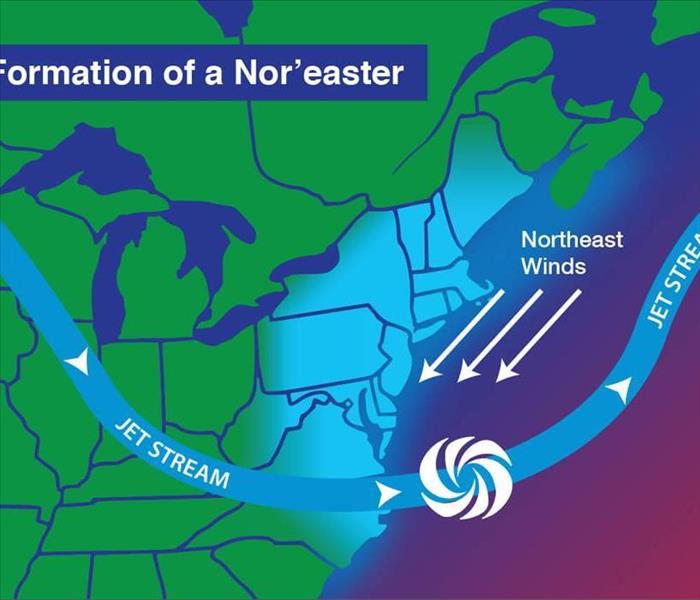 Photo Courtesy of NOAA
Photo Courtesy of NOAA
As a Nor'easter or Coastal Storm Approaches
- Listen to a National Oceanic and Atmospheric Administration (NOAA) Weather Radio or to a local news station for the latest information.
- Follow instructions given by public safety officials. Many towns have email or phone distribution systems for emergency messages. Make sure you are on the list.
- Review your family emergency plan.
- If you live or work in a flood zone, hurricane evacuation zone, or an area that is prone to flooding be ready to evacuate. This requires an understanding of which roads experience flooding most often so you can have an alternate route in mind.
- If you are not in an area prone to flooding and plan on riding out the storm at home, gather adequate supplies in case you lose power and water for several days and are unable to leave.
- Prepare for power outages by charging cell phones and electronics (and portable cell phone chargers if you have them) and setting your refrigerator and freezer to their coldest settings. If you use electricity to get well water, fill your bathtub with water to use for flushing toilets. Gather adequate supplies in case you lose power and water for several days and are unable to leave.
- Keep your car’s gas tank full. Pumps at gas stations may not work during a power outage.
- Prepare your home.
- Secure or bring in outdoor objects (patio furniture, children's toys, trash cans, etc.) that could be swept away or damaged during strong winds or flooding. This includes grills! Despite their size and weight, strong winds can knock over grills causing gas lines to be severed. Fire departments across Monmouth County, NJ responded to numerous calls for ruptured grill supply lines during our last storm.
- Clear clogged rain gutters to allow water to flow away from your home.
- If damaging winds are expected, cover all of your windows. If you don’t have storm shutters, board up windows with 5/8” exterior grade or marine plywood.
- Go Tapeless! Taping windows wastes preparation time, it does not stop windows from breaking or make cleanup easier. In fact, taping windows may create larger shards of glass that can cause serious injuries.
- Turn off propane tanks if you are not using them.
- Prepare for flooding by elevating items in your basement, checking your sump pump, unplugging sensitive electronic equipment, clearing nearby catch basins, and parking vehicles in areas not prone to flooding.
- If instructed, turn off your gas and electricity at the main switch or valve.
- If you have a boat, remove it from the water. If you cannot, prepare your boat for the storm to reduce damage.
- If the nor’easter or coastal storm is a winter storm, learn how to prepare with our Winter Storm Safety Tips.
For more information visit this great site created by the State of Massachusetts”
https://www.mass.gov/info-details/noreaster-coastal-storm-safety-tips#:~:text=a%20power%20outage.-,Prepare%20your%20home.,flow%20away%20from%20your%20home.
Does Household Mold Get Worse Over Time?
10/28/2020 (Permalink)
 If mold is left unchecked, it can spread very quickly. Contact our IICRC certified mold damage remediation team for an assessment today.
If mold is left unchecked, it can spread very quickly. Contact our IICRC certified mold damage remediation team for an assessment today.
SERVPRO Recommends Enlisting Mold Damage Remediation Technicians to Help Contain an Outbreak of Microbial Growth in your Red Bank Home.
Is it possible to stop mold from spreading?
The arrival of microbial growth in your Red Bank home can be a worry. Microbes are microscopic organisms that can quickly reproduce and spread through an indoor environment—fungi's breakdown of organic matter, which could include building materials or fittings. The presence of mold colonies could also indicate other microbial organisms' growth, such as bacteria or viruses. The appearance of an infestation is indicative of a moisture problem that could be making your home unsanitary. It is essential to put in place containment controls before, during, and after the remediation process. SERVPRO applied microbial remediation technicians can help uncover and control an outbreak.
How can you prevent mold from spreading?
- Contain the spread of mold by establishing a containment zone using plastic sheeting and negative air-pressure to capture spores
- Seal air vents of your heating ventilation and air-conditioning (HVAC) system to stop organisms from entering
- Set up clean spaces to decontaminate affected contents, clothes, and equipment when performing remediation.
Does remediation eliminate mold?
Hiring a mold damage remediation specialist in Red Bank does not eliminate all microbial organisms in your house. These microscopic lifeforms are a natural part of the home environment. However, once a microbial infestation gets out of control, it can cause health effects in humans. The remediation process is designed to contain, control, and remove contaminated materials from home, safeguarding it against future infestation. SERVPRO adopts different methods for dealing with mold depending on the type of surfaces they infest and the infestation extent. Often the best way for controlling microbial growth is to correct moisture problems, which provide the conditions for the reproduction of mold spores. A final step is often the fogging of the environment with an antimicrobial agent, or a fungicide.
How does remediation bring mold growth under control?
- Dispose of porous materials with signs of active mold growth and install non-contaminated new materials
- Non-porous materials like glass or metal can often be salvaged through aggressive agitation and disposal of mold colonies.
- Inspect the structural integrity of the property. In some cases, wooden frames can rot away and become unsafe. These items must be removed.
Use a professional remediator as soon as mold infestation becomes apparent to return your home to a standard, sanitary state. Contact SERVPRO of Eatontown / Long Branch at (732) 578-9888.
Does SERVPRO Work with Homeowners Insurance Company After a Fire?
10/23/2020 (Permalink)
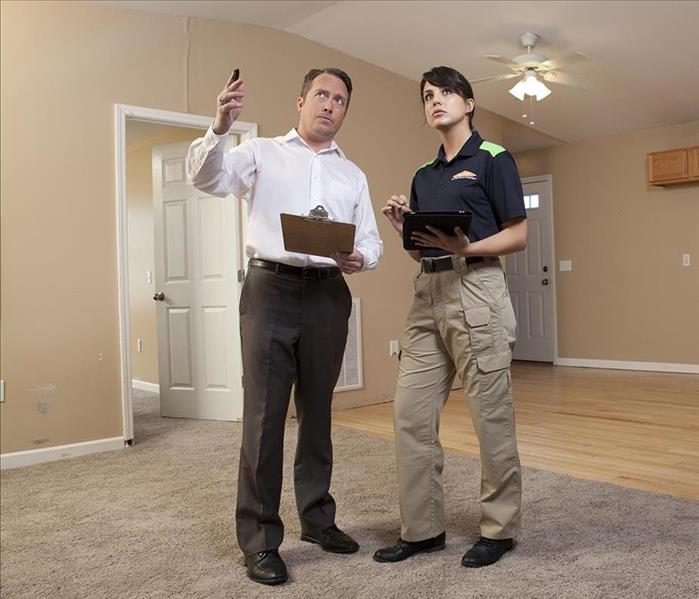 Rest assured, SERVPRO works closely with your insurance company. Call us anytime for assistance.
Rest assured, SERVPRO works closely with your insurance company. Call us anytime for assistance.
Little Silver Homeowners Can Trust SERVPRO to Work Closely with Insurance Companies.
The leading cause of fire-related deaths, injuries, and property loss is residential fires. Most of these homes, thankfully, are covered by homeowner’s insurance. When it comes to assisting Little Silver residents with fire claims, a professional restoration company is vital.
How Does SERVPRO Assist Both the Homeowner and the Insurance Company?
Whenever a fire has occurred, the insurance company works with the owners to decide the extent of the loss. This process involves the homeowner, insurance company, insurance adjuster, and the restoration company. In many cases, the insurance company requires a professional company to work with them to ensure that everything gets done professionally. At SERVPRO, our services go beyond fire cleanup in Little Silver. What we do is designed to assist all parties involved and includes:
- Minimal loss prevention - By providing immediate fire mitigation, more can be salvaged. Prompt action reduces secondary damage and property loss.
- Scoping information – The details we provide during the initial scope allow the insurance agent to review inspections and reports. He then can prioritize items on the work schedule.
- Assessing restoration needs – Our technicians help the insurance adjuster and owner decide what gets cleaned and what needs to be declared a loss.
- Working with adjusters – Our professional teams provide scoping, testing, and loss details that save the insurance adjuster time.
- Managing the restoration job –When our technicians handle the various aspects of restoration, the insurance company and homeowner do not need to waste time on minor, time-consuming tasks.
- Restore instead of replace – Our goal is always to restore instead of replacing whenever possible. This saves everyone time and money.
- Customer satisfaction – we know how a fire can impact your home. If possible, we restore your home to preloss condition.
SERVPRO provides an invaluable service by working closely with residents and their insurance companies. As our company works closely with the adjuster, the stress is taken off the homeowner. The agent’s job goes smoother due to the detailed information we provide early in the process. When our Green Team provides fire cleanup services, we are doing more than cleaning – we are helping you get your life back on track.
Contact SERVPRO of Eatontown / Long Branch at (732) 578-9888 for professional fire cleanup services. We’re Faster To Any Size Disaster.
What are the Most Common Reasons For Commercial Water Damage in Little Silver?
10/14/2020 (Permalink)
 The technicians are available 24/7 to restore your property and make it, “Like it never even happened.”
The technicians are available 24/7 to restore your property and make it, “Like it never even happened.”
SERVPRO technicians have comprehensive training for handling all kinds of water damage in Little Silver commercial properties
It is easy to get busy and keep putting off inspecting your Little Silver commercial property for water damage. However, this can enable slow leaks to go on and cause a greater amount of damage to the building materials and contents. Some incidents happen suddenly, such as a sewage backup or floodwater issues after heavy storms in the area. Other frequently seen reasons for water cleanup restoration services by SERVPRO include:
• Broken or damaged pipes
• Leaking sprinkler systems
• Damaged roofs and windows
Can a Business Stay Open During Commercial Water Damage Cleanup?
Whether or not a Little Silver business can remain open during commercial water damage restoration services depends on the type of water in the structure and any safety concerns. For example, a sewage backup would result in closure due to the toxic nature of the water. Simultaneously, a sprinkler malfunction that drenched an office may also require closure because of the need to move out the contents of the area even though this water-type is clean.
The construction materials that make up the property can contribute to whether the business can remain open if the water spill is a level one or categorized as clean. Wet slab or tile flooring can also present significant slip and fall hazards. SERVPRO techs put up security tape to cordon off the worksite and inhibit unauthorized persons from entering.
Before reopening, the commercial property needs to verify as dry according to readings on the techs' moisture detection equipment and then sanitized to ensure both employees and customers enter into a clean and healthy environment when the business reopens.
SERVPRO of Eatontown / Long Branch at (732) 858-5422 is the place to call when you have commercial water damage that needs cleanup and drying pronto. The technicians are available 24/7 to restore your property and make it, “Like it never even happened.”
What Are Airborne Concerns in Fire-Damaged Homes?
10/7/2020 (Permalink)
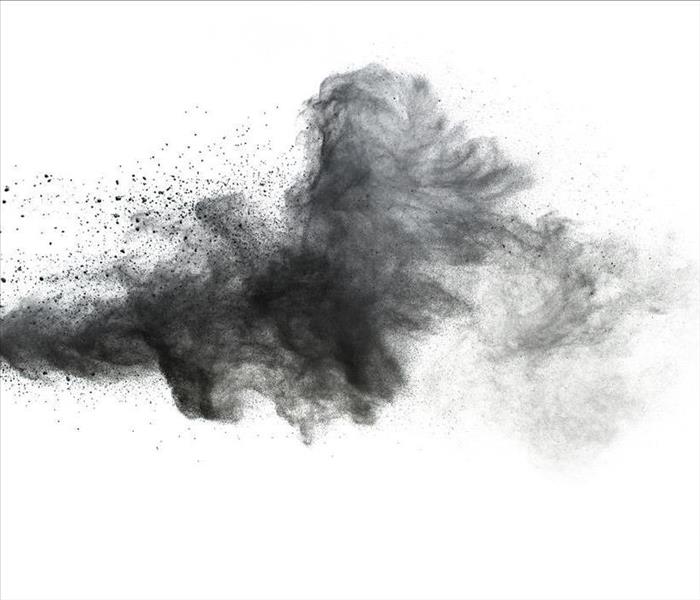 SERVPRO Cleans and Restores Fire Damaged Homes in Fair Haven. Removal of Airborne Soot and Ashes improves Indoor Air Quality while Reducing Odors
SERVPRO Cleans and Restores Fire Damaged Homes in Fair Haven. Removal of Airborne Soot and Ashes improves Indoor Air Quality while Reducing Odors
Mitigation should begin as soon as possible after a fire in Fair Haven homes, and the fast response of our SERVPRO team can help.
After a fire in your Fair Haven home, professional mitigation seeks to reduce loss and ultimate costs for the customer. Our SERVPRO team can work quickly to manage the situation with containment protocols and remove pressing safety and health concerns from the property to begin restoration actions.
Among the chief concerns of fire damage in Fair Haven properties are airborne contaminants and health threats. Addressing particles and particulates left behind from combustion and extinguishment can be vital in making the property safer for occupants and our responding technicians. Some of these circulating threats include:
- Soot – Soot is among the most hazardous of airborne and stationary byproducts of combustion. These potential carcinogens can directly impact those exposed, so our SERVPRO team utilizes filtration efforts to remove these particles from the environment.
- Smoke/Ash – Smoke and ash particles can create a residue on surfaces and stain materials hosting these layers.
- Odors – Burning odors and smoke scents can move quickly throughout the property, beginning at the ignition point and using channels like structural openings and the HVAC system to spread.
- Contaminants/Toxins – A lesser-considered obstacle for responding technicians is the combustion of toxic materials and products that can also become a threatening condition for the house.
Can the HVAC System Become Damaged by Spreading Soot?
Because of the magnetism of soot particles, sheet metal used in your home's ductwork can attract ionized soot into the system. While this can distribute soot and smoke to new areas of the property, much of it can also remain attached to the inner walls of the HVAC network itself.
We have a fast and reliable response to manage fire loss effects in your home. Whenever these disasters occur, count on our SERVPRO of Eatontown / Long Branch team. Give us a call today at (732) 391-6141.
When Storms or Floods hit - SERVPRO of Eatontown/Long Branch is ready!
9/18/2020 (Permalink)
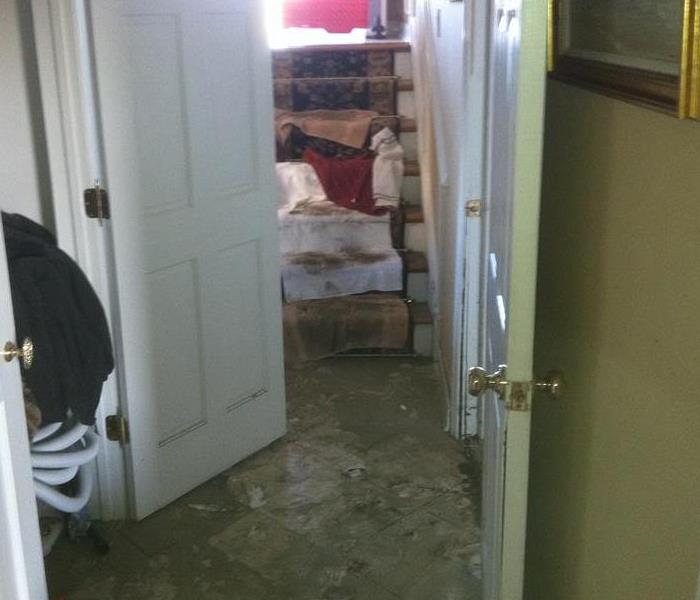 If you have storm damage, please call SERVPRO of Eatontown/Long Branch!
If you have storm damage, please call SERVPRO of Eatontown/Long Branch!
SERVPRO of Eatontown/Long Branch specializes in storm and flood damage restoration. Our crews are highly trained and we use specialized equipment to restore your property to its pre-storm condition.
Faster Response
Since we are locally owned and operated, we are able to respond quicker with the right resources, which is extremely important. A fast response lessens the damage, limits further damage, and reduces the restoration cost.
Resources to Handle Floods and Storms
When storms hit, we can scale our resources to handle a large storm or flooding disaster. We can access equipment and personnel from a network of 1,650 Franchises across the country and elite Disaster Recovery Teams that are strategically located throughout the United States.
Have Storm or Flood Damage? Call Us Today 732-578-9888
Need Emergency Service?
9/2/2020 (Permalink)
 Available for you 24/7
Available for you 24/7
Need Emergency Service? Call Us 24/7 – SERVPRO of Eatontown/Long Branch - 732-578-9888
Water Damage Timeline
Within Minutes
- Water quickly spreads throughout your property, saturating everything in its path.
- Water is absorbed into walls, floors, upholstery, and belongings.
- Furniture finishes may bleed, causing permanent staining on carpets.
- Photographs, books, and other paper goods start to swell and warp.
Hours 1 - 24:
- Drywall begins to swell and break down.
- Metal surfaces begin to tarnish.
- Furniture begins to swell and crack.
- Dyes and inks from cloth and paper goods spread and stain.
- A musty odor appears.
48 Hours to 1 Week:
- Mold and mildew may grow and spread.
- Doors, windows, and studs swell and warp.
- Metal begins to rust and corrode.
- Furniture warps and shows signs of mold.
- Paint begins to blister.
- Wood flooring swells and warps.
- Serious biohazard contamination is possible.
More Than 1 Week:
- Restoration time and cost increase dramatically; replacing contaminated materials and structural rebuilding may be extensive.
- Structural safety, mold growth, and biohazard contaminants pose serious risks to occupants.
About SERVPRO of Eatontown/Long Branch
SERVPRO of Eatontown/Long Branch specializes in the cleanup and restoration of residential and commercial property after a fire, smoke or water damage event. Our staff is highly trained in property damage restoration. From initial and ongoing training at SERVPRO’s corporate training facility to regular IICRC-industry certification, rest assured our staff is equipped with the knowledge to restore your property.
We Specialize in Flooded Basement Cleanup and Restoration!
9/2/2020 (Permalink)
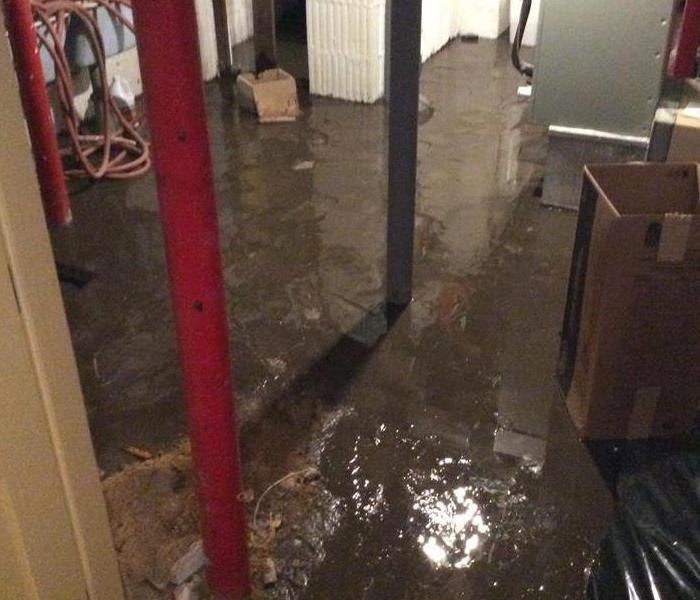 A broken pipe caused a flooded basement
A broken pipe caused a flooded basement
A basement can flood at any time, although flooding most often occurs during heavy rainfall. Basements are inherently prone to flooding because they are the lowest level of a building and are normally built partly or entirely below ground level. There are a number of reasons why your basement could flood, including:
- A blocked or failed sewer lateral pipe
- Heavy rain causes surface water to pool around your home
- Storm sewer backup
- Sanitary sewer backup
- Foundation drainage failure
- Water supply-line break or hot-water tank failure
- And many more
Have Questions about Basement Flooding?
Call Today - SERVPRO of Eatontown/Long Branch - 732-578-9888
If flood water is not handled quickly and properly, it can jeopardize your health and safety, and cause severe damage to your home’s structure. Remember, the longer you wait, the worse the problem will get.
The bottom line: a flooded basement can jeopardize your health, safety, and your home’s integrity. It’s worth making a call to SERVPRO of Eatontown/Long Branch and let our trained, professional crews handle the situation safely and correctly. We have earned the trust of hundreds of homeowners, business owners, and property professionals.
We are Flooded Basement Specialists:
- We are Available 24 hours/7 days per week
- We’re a Preferred Vendor to many National Insurance Companies
- We Bill The Insurance Directly – One Less Thing For You To Worry About
- Our Technicians are Highly-Trained in Water Restoration Techniques
- We use s500 IICRC Restoration Standards
- Advanced Inspection and Extraction Equipment
Basement Flooded? Call Us Today – We’re Ready To Help - SERVPRO of Eatontown/Long Branch 732-578-9888
When Storms or Floods hit the Jersey Shore, SERVPRO of Eatontown/Long Branch is ready!
7/10/2020 (Permalink)
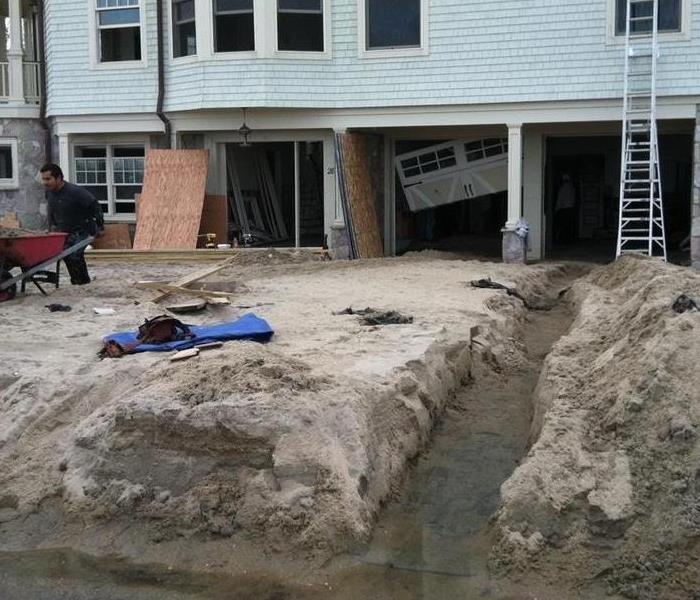 Our highly trained crews are ready to respond 24/7 to storm or flood damage on the Jersey Shore.
Our highly trained crews are ready to respond 24/7 to storm or flood damage on the Jersey Shore.
SERVPRO of Eatontown/Long Branch specializes in storm and flood damage restoration. Our crews are highly trained and we use specialized equipment to restore your property to its pre-storm condition.
Faster Response
Since we are locally owned and operated, we are able to respond quicker with the right resources, which is extremely important. A fast response lessens the damage, limits further damage, and reduces the restoration cost.
Resources to Handle Floods and Storms
When weather events hit the Jersey Shore we can scale our resources to handle a large storm or flooding disaster. We can access equipment and personnel from a network of 1,650 Franchises across the country to make sure that there are enough resources for all of our customers. This is something that no other company can do on the scale that SERVPRO does it.
Have Storm or Flood Damage? Call Us Today 732-578-9888
Restoring Your Commercial Property After A Water Damage Event
7/1/2020 (Permalink)
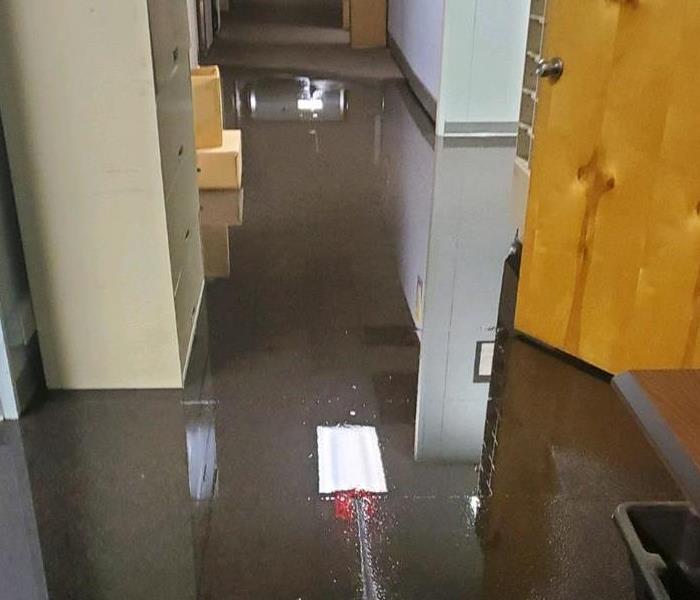 Commercial Water Damage Events Present Unique Challenges
Commercial Water Damage Events Present Unique Challenges
Commercial properties are often complex with numerous issues that require a knowledgeable and flexible response. Whether we’re dealing with a relatively small water cleanup scenario or a large scale event, we work quickly to assess each unique situation and isolate the damaged area. In many instances, normal operations can continue in a temporary space while we restore your facility. Restoring Commercial Properties Presents Unique Challenges Our professionals are trained to be mindful of legal and environmental concerns and strive to fully restore the damaged area while working within your budgetary constraints. We understand that every hour spent cleaning up is an hour of lost revenue and productivity. So when an emergency situation arises in your business, give us a call and we’ll be there fast with the help you need. About SERVPRO of Eatontown/Long Branch SERVPRO of Eatontown/Long Branch specializes in the cleanup and restoration of commercial and residential property after a water damage event. Our staff is highly trained in property damage restoration. From initial and ongoing training at SERVPRO’s corporate training facility to regular IICRC-industry certification, rest assured our staff is equipped with the knowledge to restore your property.
IICRC Certified Firm
7/1/2020 (Permalink)
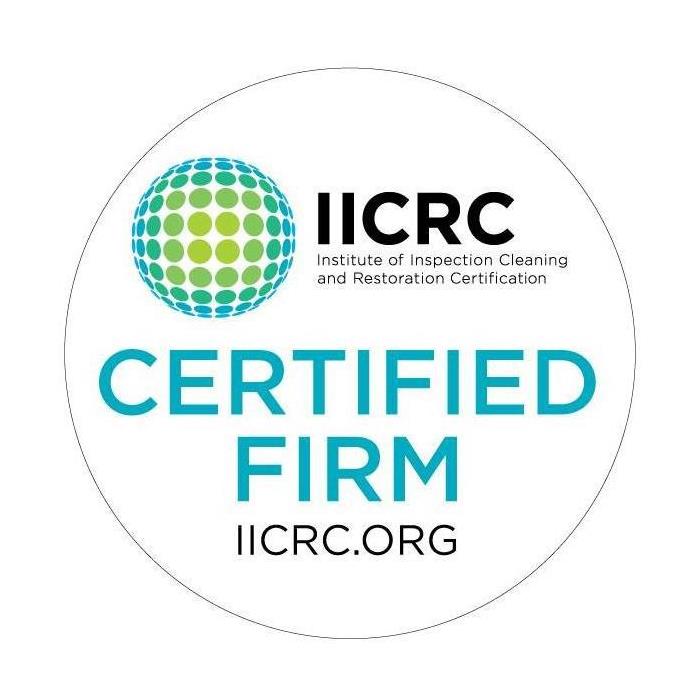 We are an IICRC Certified Firm
We are an IICRC Certified Firm
SERVPRO of Eatontown/Long Branch is an IICRC firm. The Institute of Inspection, Cleaning and Restoration Certification (IICRC) creates the standards for the restoration industry and provides training and certification to restoration companies. IICRC Certified Firms have the right to display the IICRC Certified Logo.
IICRC Certified Firms must
• Present accurate information to consumers and conduct business with honesty and integrity.
• Require a technician on all jobs who has been formally trained and passed all required tests.
• Require a continuing education program to keep technicians up-to-date on the latest changes in the industry.
• Maintain liability insurance to protect all parties in the event of an accident.
• Maintain a written complaint policy and agree to Better Business Bureau or similar arbitration to resolve disputes, and accept the conclusions and recommendations of arbitration.
The IICRC Develops The Standards For The Restoration Industry
The IICRC has been the driving force in establishing the main industry standards and reference guides for professional carpet cleaning, water damage restoration and mold remediation. These IICRC standards take years to develop and require the coordination of experts in the field: manufacturers, industry organizations, insurance professionals, training schools, contractors, and public health professionals.
Every five years, the standards are reviewed and updated. The water damage restoration field changes rapidly with advancements in technology and science, and therefore the standards must evolve to keep pace.
About SERVPRO of Eatontown/Long Branch
SERVPRO of Eatontown/Long Branch specializes in the cleanup and restoration of residential and commercial property after a fire, smoke or water damage event. Our staff is highly trained in property damage restoration and we are an IICRC Certified Firm. We believe in continuous training: from initial and ongoing training at SERVPRO’s corporate training facility to regular IICRC-industry certification, rest assured our staff is equipped with the knowledge to restore your property.
Smoke & Soot Cleanup
6/3/2020 (Permalink)
 This is the damage caused by a fire.
This is the damage caused by a fire.
Smoke and soot is very invasive and can penetrate various cavities within your home, causing hidden damage and odor. Our smoke damage expertise and experience allows us to inspect and accurately assess the extent of the damage to develop a comprehensive plan of action.
Smoke and soot facts:
- Hot smoke migrates to cooler areas and upper levels of a structure.
- Smoke flows around plumbing systems, seeping through the holes used by pipes to go from floor to floor.
- The type of smoke may greatly affect the restoration process.
Different Types of Smoke
There are two different types of smoke–wet and dry. As a result, there are different types of soot residue after a fire. Before restoration begins, SERVPRO of Eatontown/Long Branch will test the soot to determine which type of smoke damage occurred. The cleaning procedures will then be based on the information identified during pretesting. Here is some additional information:
Wet Smoke – Plastic and Rubber
- Low heat, smoldering, pungent odor, sticky, smeary. Smoke webs are more difficult to clean.
Dry Smoke – Paper and Wood
- Fast burning, high temperatures, heat rises therefore smoke rises.
Protein Fire Residue – Produced by evaporation of material rather than from a fire
- Virtually invisible, discolors paints and varnishes, extreme pungent odor.
Our Fire Damage Restoration Services
Since each smoke and fire damage situation is a little different, each one requires a unique solution tailored for the specific conditions. We have the equipment, expertise, and experience to restore your fire and smoke damage. We will also treat your family with empathy and respect and your property with care.
Have Questions about Fire, Smoke, or Soot Damage?
Call Us Today – 732-578-9888
Does your house have a mold problem?
5/20/2020 (Permalink)
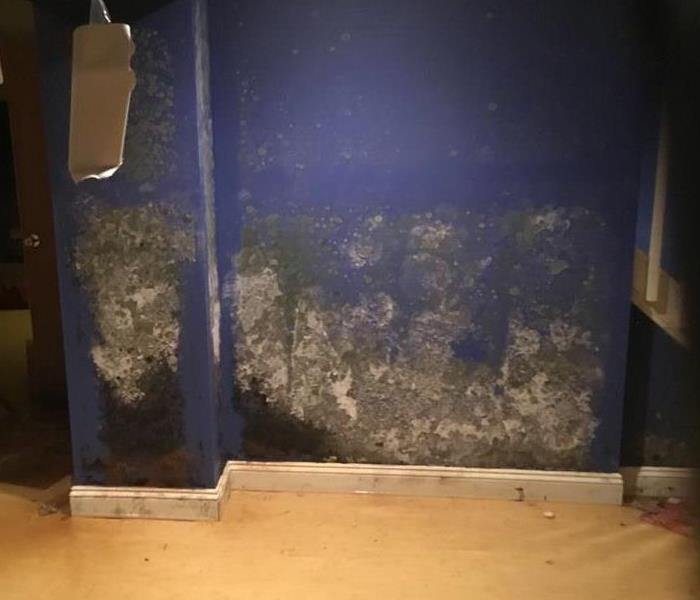 Mold Damage in Basement of a Residential Home
Mold Damage in Basement of a Residential Home
Microscopic mold spores naturally occur almost everywhere, both outdoors and indoors. This makes it impossible to remove all mold from a home or business. Therefore, mold remediation reduces the mold spore count back to its natural or baseline level. Some restoration businesses advertise “mold removal” and even guarantee to remove all mold, which is a fallacy. Consider the following mold facts:
- Mold is present almost everywhere, indoors and outdoors.
- Mold spores are microscopic and float along in the air and may enter your home through windows, doors, or AC/heating systems or even hitch a ride indoors on your clothing or a pet.
- Mold spores thrive on moisture. Mold spores can quickly grow into colonies when exposed to water. These colonies may produce allergens and irritants.
- Before mold remediation can begin, any sources of water or moisture must be addressed. Otherwise, the mold may return.
- Mold often produces a strong, musty odor and can lead you to possible mold problem areas.
- Even higher-than-normal indoor humidity can support mold growth. Keep indoor humidity below 45 percent.
If your home or business has a mold problem, we can inspect and assess your property and use our specialized training, equipment, and expertise to remediate your mold infestation.
If You See Signs of Mold, Call Us Today – SERVPRO of Eatontown/Long Branch at 732-578-9888
Water Damage
5/20/2020 (Permalink)
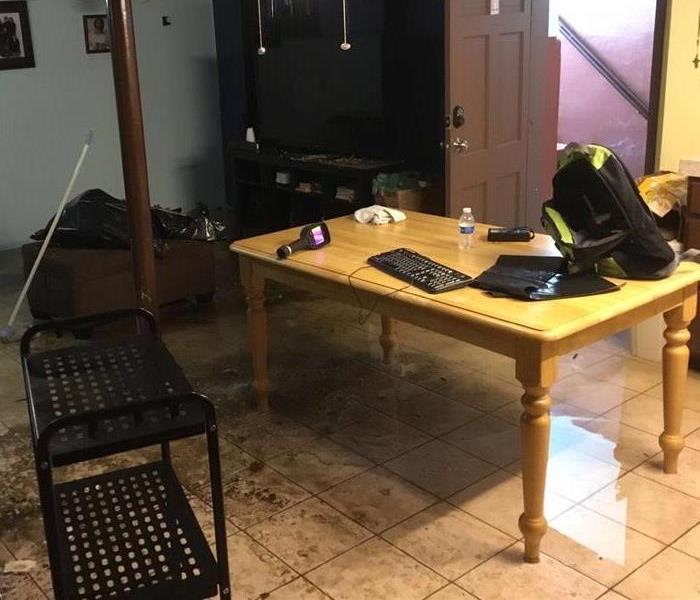 Water damage in residential home.
Water damage in residential home.
SERVPRO of Eatontown/Long Branch is available 24 hours a day for water emergencies, large or small. When you are dealing with water damage, immediate action is crucial. A delay of just a few hours can greatly increase the severity of the water damage.
We Answer the Phone Ready to Help
Call Today - 732-578-9888
We understand that when you call us, you may be feeling confused, stressed, and vulnerable. You need an expert to guide you through this crisis. SERVPRO of Eatontown/Long Branch has the specific water damage training and experience to help you through this tough time. We specialize in water damage restoration—in fact, it's the cornerstone of our business.
What to Expect
When you call, we will ask several questions regarding your water damage emergency. These questions will help us determine what equipment and resources to bring, including how many trained SERVPRO Professionals may be needed.
Our SERVPRO Representative will ask several questions:
· Your name and contact information
· Your insurance information (if applicable)
· The street address of the water-damaged home or business
· When did the flooding or water damage occur?
· What caused the water damage (if known)?
· Is there electricity available (on-site)?
About SERVPRO of Eatontown/Long Branch
SERVPRO of [Eatontown/Long Branch specializes in the cleanup and restoration of residential and commercial property after a fire, smoke or water damage event. Our staff is highly trained in property damage restoration. From initial and ongoing training at SERVPRO’s corporate training facility to regular IICRC-industry certification, rest assured our staff is equipped with the knowledge to restore your property.
We are cleaning experts!
5/19/2020 (Permalink)
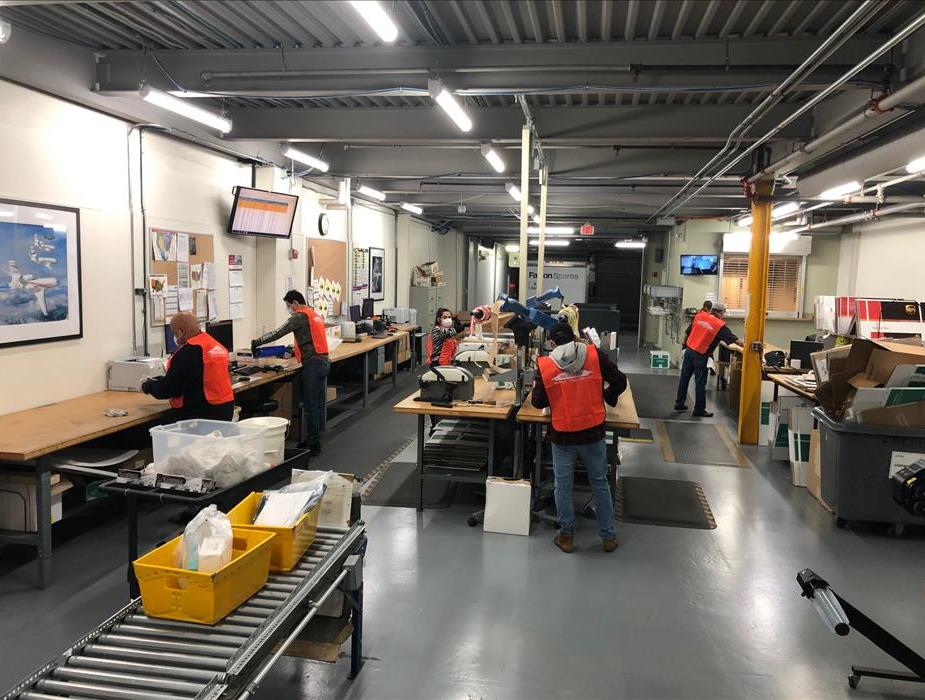 SERVPRO Team cleaning a commercial building
SERVPRO Team cleaning a commercial building
During this unprecedented time caused by the global pandemic of coronavirus, this is a reminder to our customers that we are specialists in cleaning services, and we adhere to the highest cleaning and sanitation standards.
Specialized Training
We are prepared to clean and disinfect your home or business, according to protocols set forth by the Centers for Disease Control and Prevention. We have years of experience in dealing with biological contaminants, and we will go beyond the scope of work that regular janitorial staff perform on a daily basis.
The CDC encourages cleaning of high-touch surfaces such as counters, tabletops, doorknobs, light switches, bathroom fixtures, toilets, phones, keyboards, tablets and tables. Other spaces mentioned in the CDC’s guidance for commercial spaces include:
· Kitchen/Food Areas
· Bathrooms
· Schools/Classrooms
· Offices
· Retail Spaces
· Water Fountains
· Shelving/Racks
· Sales Counters
· Carpets and Rugs
· Stair Handrails
· Elevator Cars
· Playground Equipment
· Fitness Equipment
Specialized Products
The CDC recommends usage of a labeled hospital-grade disinfectant with claims against similar pathogens to the coronavirus. Multiple products in the SERVPRO product line carry the EPA-approved emerging pathogens claims. While there is currently no product tested against this particular strain of the coronavirus, we are following all guidelines as provided by the CDC and local authorities.
Call Today for a Proactive Cleaning
If your home or business needs deep cleaning services, call the experts today SERVPRO of Eatontown/Long Branch 732-578-9888
Sources: https://www.cdc.gov/coronavirus/2019-ncov/hcp/guidance-prevent-spread.html?CDC_AA_refVal=https%3A%2F%2Fwww.cdc.gov%2Fcoronavirus%2F2019-ncov%2Fguidance-prevent-spread.html https://www.cdc.gov/coronavirus/2019-ncov/specific-groups/guidance-business-response.html
We Are Cleaning Experts
3/27/2020 (Permalink)
SERVPRO is Here to Help during this time of need
During this unprecedented time caused by the global pandemic of Coronavirus, this is a reminder to our customers that we are specialists in cleaning services, and we adhere to the highest cleaning and sanitation standards.
Specialized Training
We are prepared to clean and disinfect your home or business, according to protocols set forth by the Centers for Disease Control and Prevention. We have years of experience in dealing with biological contaminants, and we will go beyond the scope of work that regular janitorial staff perform on a daily basis.
The CDC encourages cleaning of high-touch surfaces such as counters, tabletops, doorknobs, light switches, bathroom fixtures, toilets, phones, keyboards, tablets and tables. Other spaces mentioned in the CDC’s guidance for commercial spaces include:
- Kitchen/Food Areas
- Bathrooms
- Schools/Classrooms
- Offices
- Retail Spaces
- Water Fountains
- Shelving/Racks
- Sales Counters
- Carpets and Rugs
- Stair Handrails
- Elevator Cars
- Playground Equipment
- Fitness Equipment
Specialized Products
The CDC recommends usage of a labeled hospital-grade disinfectant with claims against similar pathogens to the Coronavirus. Multiple products in the SERVPRO product line carry the EPA-approved emerging pathogens claims. While there is currently no product tested against this particular strain of the Coronavirus, we are following all guidelines as provided by the CDC and local authorities.
Call us today for an estimate or proactive cleaning today.
Sources:
https://www.cdc.gov/coronavirus/2019-ncov/hcp/guidance-prevent-spread.html?CDC_AA_refVal=https%3A%2F%2Fwww.cdc.gov%2Fcoronavirus%2F2019-ncov%2Fguidance-prevent-spread.html
https://www.cdc.gov/coronavirus/2019-ncov/specific-groups/guidance-business-response.html
A Water Damage Timeline
3/26/2020 (Permalink)
Living on the Jersey Shore, it's inevitable that there will be some sort of water event (groundwater, nor'easter, etc.) at some point during the year. Depending on your actual location, and how much water is flowing and how fast and/or how forcefully, water damage can begin occurring almost immediately.
Unfortunately, the longer water sits, the more time it has to cause even further damage. Stagnant water can become a breeding ground for mold, bacteria, insects, or other contaminants.
This is why it’s important to dry everything as quickly as possible in order to minimize the long-term damage.
In Minutes…
- Water can soak into paper and cardboard, ruining them beyond repair
- Water can cause stains and other noticeable surface level damage to furniture, carpeting, ceilings, and walls
- Water can cause electricity-powered devices to short out
In Hours….
- Walls and furniture made of composite materials can start to dissolve
- Carpet padding can start to fall apart, and carpet backing can become weakened
- Items made of unfinished wood can start to swell
- Upholstery and fabrics can develop stains
- Musty odors can start to develop
In Days….
- Structural beams can start to swell and warp
- Carpets and fabrics can start to dissolve
- Mold can start growing
In Weeks…
- Wood floors and furniture can start to swell, warp, and dissolve
- Mold can grow to the extent that it poses a severe health risk
- The structural support of your home can become so weakened that it is now unsafe
Taking care of the problem early will eliminate the need for very costly remediation later. Make sure you make the call to the professionals at SERVPRO of Eatontown/Long Branch as soon and as quickly as possible. Most water damage is covered by insurance, and we will work directly with your insurance company to make the process less stressful, simple and seamless.
What To Do With Contents After a Fire
3/24/2020 (Permalink)
Fires are devastating. If contents aren't destroyed by flames, they can be rendered useless by smoke and soot.
Four items you should definitely throw away:
- Food Exposed to Fire and Heat - any foods that come contact with the flames, smoke, high heat, including foods stored in the refrigerator or freezer.
- Fabrics
- Mattresses
- Medicine and Cosmetics
- Electric Appliances
Three examples of items that can often be salvaged after a fire.
Hardwood - unless there is extreme burning or charring, use an oil soap made especially for wood to clean off stains.
Glass - if it doesn’t melt, try cleaning it with white vinegar or dish soap. You can also try to soak it in vinegar and baking soda.
Metal - use vinegar or dish soap and then try to gently sand and paint the metal.
Note: never try to keep items that may be melted, charred, or rendered structurally unsafe.
If you need help trying to salvage and/or restore your property and belongings after a fire, our team of experts here at SERVPRO of Eatontown/Long Branch is close by and ready to help! Whatever the size of your fire damage, we have the know-how, training, and tools to help you deal with it and move forward.
Prepare for Flash Floods: Your Guide to Stay Safe and Clean Up Effectively
3/10/2020 (Permalink)
Flash floods can be devastating and dangerous, and oftentimes there is no warning.
As a leader in cleanup and restoration services in the Eatontown / Long Branch area, our team here at SERVPRO has seen how damaging a flash flood can be. We want to help make sure everyone in this community will be prepared.
Causes of Flash Floods
Flash floods typically happen when there’s a sudden storm, and the ground soil can’t absorb all the water that’s quickly streaming in.
The most common causes of flash flooding include:
- Rain for an extended time (e.g. during a tropical storm or hurricane)
- Sudden heavy rain in a short time span
- Dam failures
- Rapid thawing of snow build-up
- Overflow in man-made sewers and storm drains
Flash Flood Safety
It’s important to understand the difference between a flood warning and a flood watch:
- Flood Warning – a flood is expected within 30 minutes to an hour
- Flood Watch – the conditions are right for a flood, and you should continually check to see if a Flood Warning develops
If a flood warning is issued, you probably won’t have much time to take action, so it’s important to be prepared and know what to do:
- Pay attention to instructions from local authorities – there may be a mandatory evacuation or a recommended evacuation to designated shelters or areas.
- Protect your home – if there is no need to evacuate, be sure to secure your home by closing all windows and doors and staying up high away from possible flooding.
- Pay attention to water sources – if you find yourself near any bodies of water, from oceans to rivers to lakes to streams, keep a close eye on water levels and be prepared to leave if necessary. Storm drains or drainage ditches could also cause problems.
- Avoid driving and walking through flooded areas – many flood-related deaths are the result of people who are trapped in the cars or swept away by the flood waters.
Flash Flood Cleanup
To cleanup after a flash flood, you want to make sure to remove all the water and dry the affected area as quickly as possible. Whether you hire professional cleanup and restoration services or can manage the cleanup work yourself, the process typically involves the following steps:
- Removing all standing water
- Properly disposing damaged materials
- Quick-as-possible drying and dehumidifying
- Cleaning and disinfecting
- Rebuilding and restoring
After a flash flood, it’s important to dry the affected area as soon as possible in order to minimize the extent of the water damage. This is why many people turn to experts like SERVPRO of Eatontown / Long Branch, as we guarantee fast, thorough cleanups with our expertly trained technicians and advanced professional-grade equipment. We’ll even help you work with your insurance.
Commercial Biohazard Cleanup
3/7/2020 (Permalink)
Accidents can happen at any moment at your business or commercial property. When the accident involves biohazards, you have to be extra cautious to make sure everything is cleaned up and restored properly.
A biohazard is defined as “a biological agent or condition that is a hazard to humans or the environment.” Some biohazards include pathogens such as MRSA or hepatitis that are known to be highly infectious. Because of the health risks, you should never attempt to cleanup biohazards on your own.
While every situation is different, there are several steps that are common to most biohazard cleanups. Here’s what you can expect if you’re in need of biohazard cleanup.
Safety Protocols
Before beginning any cleanup, the professionals will establish proper safety protocols. Sometimes an area might need to be quarantined with bio-tape and plastic sheeting. It’s important to follow the right safety measures to prevent further contamination.
Discarding Contaminated Items
Biohazard cleanup includes the removal of any contaminated items or materials from the scene that can’t be salvaged. Items are typically secured in specialized biohazard bags before being removed from the premises.
Sanitization
Disinfection is often done in multiple steps using several different commercial or hospital-grade cleaners that have proven to be effective and safe for biohazard cleanup. Deodorizers are also used to keep odors from developing as time passes.
Safe Disposal of Biohazards
After everything is disinfected, it will be time to systematically take down any quarantine structures and materials that may have been used.
In order to prevent contamination, any of the items that may have been exposed to biohazards are disposed according to established government regulations and industry standard best practices.
SERVPRO of Eatontown/Long Branch has certified professionals that have training for biohazard cleanup. SERVPRO also has specialized equipment that is necessary to properly clean up biohazards and prevent the risk of further contamination.
If you require help with biohazard cleanup and restoration for your business or commercial property, just call our team and we will be there "Faster to any disaster."
5 of the Most Important Winter Fire Safety Tips You Need to Know
2/26/2020 (Permalink)
These are the days of the year when we expect temperatures to remain chilly if not freezing, and it’s common for use multiple heating sources to keep your house warm. Unfortunately, that means it’s also a time when there’s a greater risk of fire damage.
Too many homes suffer from fire damage that could have been prevented with just a little foresight and planning. In order to help you keep your family safe from fire during the cold weather days, here are 5 of the most important Winter Fire Safety Tips you should act on:
Check Your Smoke Alarms
Ideally, you would have checked your smoke alarm batteries when the clocks changed. But now is the season when it might actually make a difference, so make sure that your batteries are good for the winter.
Also, there should be smoke alarms in every bedroom plus the kitchen and laundry room at bare minimum. Make sure you have enough smoke alarms strategically placed all around your home.
Inspect Your Chimney
If you use a fireplace, you should know that they can produce creosote, which is a flammable substance.
If your family likes to light fires in the fireplace, you should get an annual chimney inspection to ensure there are no fire hazards.
And don’t forget to use dry, seasoned wood, which will give you bright flames with less smoke. Excess smoke could lead to smoke damage.
Always Use a Screen for Your Fireplace
Whether you prefer a metal screen or a screen of tempered glass, you want to make sure to protect against any sparks that might otherwise stray from the fireplace.
Even with a screen in place, be sure to keep curious children and pets safely away from the fireplace. Also, any potentially flammable fabrics or materials should be kept at least three feet away from a lit fire.
Maintain Your Furnace
Typically, it’s a good idea to invest in an annual inspection from a professional. They can check your system for the signs of wear and tear or potential damage that could lead to furnace problems.
Use Candles and Space Heaters with Caution
Candle create a lovely atmosphere and may even provide extra light on the darkest of days. Make sure, however, they are placed securely where they won’t get knocked over, as well as safe out of the reach of young children and pets.
And don’t forget to blow them out when you leave the room!
Similarly, with space heaters, you want to make sure to keep sufficient clear space around them (typically at least 3 feet all the way around) to prevent a potential fire hazard. Make sure the heater you use has an automatic shut-off switch so that its internal mechanisms won’t overheat.
And make sure to turn it off before you go to sleep or move to a different room!
Here at SERVPRO of Eatontown / Long Branch, we have a strong track record of protecting the people and properties of this community from the horrifying effects of fire damage. We’re known not only for our reliability and expertise as a professional restoration and cleaning services provider, but people love us for our friendly customer service too.
For help with Fire Damage cleanup and restoration, you can give us a call any time 24/7.
March Is a Tricky Time of Year
2/26/2020 (Permalink)
March is always a tricky time of year, it is far enough removed from the cold winter temperatures, but not close enough to spring that we are not out of the woods for winter storms, either nor’easters or blizzards.
In 2019, the beginning of March in New Jersey saw three major nor’easter storms in less than two weeks, one accompanied by a full moon which resulted in flooding for many Jersey Shore towns.
Actually, two of the three most expansive, heaviest Northeast snowstorms since the mid-1950s have happened in March, rather than the core winter months of December, January or February.
According to The Weather Channel, they are:
Superstorm 1993 (Mar. 12-14)
Blizzard of 1960 (Mar 2-5)
Just like March itself, it’s difficult to predict what can happen in any weather situation. The main rule of thumb is to always be prepared. As we have mentioned before, there are many things you can do to make sure you are ready for any major storm:
- Trim Large and/or Dying Trees
- Make Sure Your Gutters are Clean
- Know Your Evacuation Plan
- Put Together an Emergency Kit
- Water
- Non-Perishable Food
- Flashlight
- Radio (battery-powered or hand-crank)
- Batteries
- First Aid Kit
- Medications
- Multi-Purpose Tool
- Personal Hygiene & Sanitation Items
- Copies of Personal Documents
- Cell Phones & Chargers
- Emergency & Family Contact Info
- Cash
- Blanket
- Area Maps
Being prepared may minimize your damage, but you many still need some help should you have water or ice damage. The experts at SERVPRO of Eatontown / Long Branch are equipped to handle any kind of disaster – from flood to fire and everything in between and we have experience restoring businesses and homes affected by storms and flooding. We can respond immediately with highly trained technicians who employ specialized equipment and techniques to restore your home or business back to pre-storm condition.
Why Commercial Losses Differ From Residential Losses
2/7/2020 (Permalink)
Imagine coming to work on a Monday morning, only to find that the sink in the kitchen is broken and has been leaking water all weekend, leaving your office a wet, soggy mess!
While any loss can be devastating, there are things that make cleaning a commercial loss different than a residential one, the main one being that a commercial water or fire loss can create a loss of business as well.
SERVPRO of Eatontown/Long Branch is always available, and is equipped to handle any size loss. Our IICRC certified technicians are trained to be mindful of legal and environmental concerns. We understand that every hour spent cleaning up is an hour of lost revenue and productivity.The sooner we arrive the sooner mitigation can begin and the sooner you can get back to business.
So when an emergency situation arises in your business, make sure you call SERVPRO of Eatontown/Long Branch, and we’ll be there fast with the help you need.
How You Can Prevent 5 of the Most Common Causes of Winter Storm Damage
2/6/2020 (Permalink)
Here in New Jersey, we know all about the common winter storm cycle where ice and snow start to melt on slightly warmer days, only to be replaced by more ice and snow when temperatures drop below freezing again. Unfortunately, this cycle can lead to significant damage to your property and belongings.
SERVPRO of Eatontown / Long Branch wants to help prevent major winter storm damage by taking proper precautions to keep your property safe. A little knowledge and preparation can go a long way to keep you safe this winter.
Here are 5 of the most common causes of winter storm damage and what you can do to avoid a potential catastrophe.
Frozen Pipes that Burst
One of the horror stories that’s common in winter is pipes that freeze and burst. Even a small crack in a pipe (especially if it goes unnoticed!) can lead to significant leaking and damage. Making sure your pipes are correctly wrapped and insulated will make a huge difference when the temperature drops.
Ice Dams
Ice dams happen when snow that builds up on your rooftop goes through a repeated process of melting and freezing, often as a result of the rising and setting sun. When it’s in liquid state, water can seep under your shingles, and once that water freezes again, it can lift up and damage your shingles.
One of the best ways to prevent ice dams is to pay attention to your roof and make sure snow is swept away before it can build up. Be attentive of any signs of stress or damage to your shingles, and be sure to repair shingles ASAP.
Damage to Your Roof
Ice dams aren’t the only threat to your roof this winter. Heavy winds and continuous pelting from snow and ice can damage roofs, especially if/when they repeat over time.
Older roofs are often most susceptible to winter storm damage, so it’s important to make sure to perform routine maintenance on your roof to make sure it’s ready to last another winter. Pay special attention to your shingles and decking - you might even look for signs of water damage to your ceiling as evidence of a problem to the roof above.
Flooding from Melting Snow & Ice
Though melting snow and ice are often considered most problematic in springtime as temperatures thaw, melting can happen anytime temperatures start to rise.
Water can enter into your basement if there are cracks or other damage to your foundation walls or seams. Be on the lookout for signs of water damage to your basement or crawlspace when snow and ice are melting.
Leaking
Leaks are probably the most common cause of winter storm damage, as they can happen anywhere your home has been damaged or otherwise compromised.
Although the most common leaks are through damaged roofs and foundations, they also frequently happen from gutters, windows, and doors. Make sure to pay attention to the caulking and seals around any entrance points to make sure no leaking will be allowed in.
If you’re dealing with major damage from a winter storm, our team here at SERVPRO Eatontown / Long Branch is on call 24/7. We’re your local community experts in cleanup and restoration with all the specialized training and equipment needed to restore your property ASAP.
Mold Myths
1/29/2020 (Permalink)
Mold is one of those words that triggers an alarm - its dangerous and will create health problems are two of the most troubling concerns.
When suspected mold is discovered, it is best left to the professionals to remediate, simply because there are too many variables and mold is tricky. It is also because there are many "untruths" about mold:
Myth 1.) “All Mold is Dangerous and Unhealthy”
In fact, some kinds of mold make human life better. Just think of the life saving benefits of penicillin or the delicious taste of bleu cheese on a salad. These all come from mold.
While it’s true that some molds do cause health problems, the effects of mold on people can vary dramatically from person to person. Some molds produce allergens that can make life miserable for people sensitive to this allergy, and people with compromised immune systems are also often at greater risk to become sick from repeated mold exposure.
Myth 2.) “Bleach Kills All Mold Growth”
Many people when they discover mold in their homes immediately reach for the bleach and assume this will solve the problem. Unfortunately, this is not always the case.
Bleach may kill certain kinds of mold growth, especially on non-porous surfaces. But bleach has not been proven to be effective on all kinds of mold, and it frequently doesn’t work so well on porous materials such as wood.
In addition, the amount of bleach that may be needed to clean-up a mold problem may in turn pose its own health risks.
Myth 3.) “If There’s Just a Little Mold, You Don’t Have to Worry”
Many people believe that if they see jut a little mold, they don’t have to worry about it. Unfortunately, sometimes a little mold is a big problem.
While it is true that mild mold growth may not cause any problems, what you see may not in fact be merely mild growth. Mold can be like an iceberg where what is visible is only the tip of major growth lurking beneath the surface.
Often times, the first visible signs of mold are just a signal that you have a major mold issue that needs to be remedied.
Myth 4.) “You Can Clean-Up Mold Yourself with Home Remedies”
According to the EPA, if your mold problem is “less than about 10 square feet (less than roughly a 3 ft. by 3 ft. patch), in most cases, you can handle the job yourself.” However, as was just discussed, many times the mold you see is just the surface of a larger underlying problem.
If you even suspect that your mold problem may be larger than 10 square feet, or you’ve been experiencing health symptoms that may be related to mold exposure, you should bring in a professional mold remediation service provider as soon as you can.
SERVPRO of Eatontown/Long Branch has the training and equipment necessary to thoroughly inspect and address any mold issues you may encounter. We’ve helped many homes and businesses in the community with mold problems both large and small, including providing 24/7 emergency services.
What To Do After a Structure Fire
1/27/2020 (Permalink)
A fire in your home or business is always traumatic, and knowing what to do next usually adds to the stress and anxiety already experienced. Most people are unsure of what the next steps should be.
It's always best to call experts who know the behavior of smoke and soot to clean up and restore the building, but there are a few things that can be done to increase the chances of a successful restoration.
- Limit the amount of foot traffic within the property. Soot particles can be spread to unaffected areas and embed themselves into carpet and furniture fibers.
- Keep your hands clean. Transferring soot and other fire-related substances can further soil the walls, upholstery, woodwork, etc.
- Electricity is often turned off, empty refrigerators/freezers. Leave doors open to reduce odors.
- Cover air registers with cheesecloth, and double layer the tape. If cheesecloth is unavailable, use any similar fabric that will keep soot particles out of the HVAC system.
- If your electricity is off, your heating system will not operate. In the winter, pour antifreeze designed for RV's and Campers in your sinks, toilet bowls, holding tanks and bathtubs to "winterize" your home and keep pipes from freezing.
As smoke and soot can leave a film on surfaces (different kinds of smoke will have different properties, and will require different cleaning methods), leave ALL cleaning to SERVPRO of Eatontown/Long Branch.
Do not:
- Attempt to wash any walls or painted surfaces.
- Shampoo carpet or upholstery
- Clean any electrical items. Cleaning these should be left to professionals. Most likely they should be discarded.
- Use or consume any canned or packaged food or beverage that may have been near the fire, heat or water. Varying conditions can alter the integrity of food items.
- Use or turn on any electrical device, including ceiling fixtures or outlets, wiring can be damaged by water.
- Send garments to an ordinary dry cleaner. Improper cleaning may cause smoke odor to set in.
If you ever have a fire, SERVPRO of Eatontown/Long Branch has certified technicians who know the properties of smoke and soot, and will be able to professionally and thoroughly clean and restore your property. Call us any time, we are open 24/7.
Fire Damage to Your Floors? Here’s Why You Need to Call SERVPRO
12/24/2019 (Permalink)
Cleaning up after fire damage to a floor can be tricky, because different floors are made of different materials, and the clean up process can be different depending on the kind of floor you have.
If you need some information and advice to help you choose the right floor cleansers, calling SERVPRO of Eatonton/Long Branch is your best move. We have certified technicians who know how to clean soot and grime from smoke, and the mess left after using a fire extinguisher without disturbing the rest of your home.
Preparation for Cleaning Your Floors After Fire Damage
While you may understandably feel a temptation to rush in and start cleaning up right away, it’s a good idea to take certain safety precautions before you start.
Regardless what kind of floor you have, SERVPRO has the professional equipment needed to remove any debris.
Remove the Water and Begin the Cleaning Process
Once the fire department puts out your fire, there will not only be charred debris but also probably standing water left from the efforts to put out the flames. It’s important to not only remove any debris but all the excess water too.
Depending on the extent of the mess, you may need to go through the cleaning process multiple times if you did the work yourself. Calling SERVPRO will guarantee that the work will be done quickly and correctly.
How to Clean Different Types of Floors
Because each floor surface has different properties, leave the cleaning to professionals who know how to individually work with each one:
- Wood – soot can leave a residue on hardwood floors.
- Tile – glazed and sealed tiles are often resistant to soot stains. However, tiles with open pores will absorb stains easily.
- Vinyl – because vinyl is porous, it will absorb stains. Vinyl is also prone to melt or warp in the heat. For these reasons, it is likely you may have to replace any sections of the vinyl flooring that are severely damaged.
If you’re in need of professional cleaning and restoration services for fire damage to your home or business, our team of friendly experts here at SERVPRO Eatontown / Long Branch are available 24/7.
Water Damage Isn't Always From a Storm
12/11/2019 (Permalink)
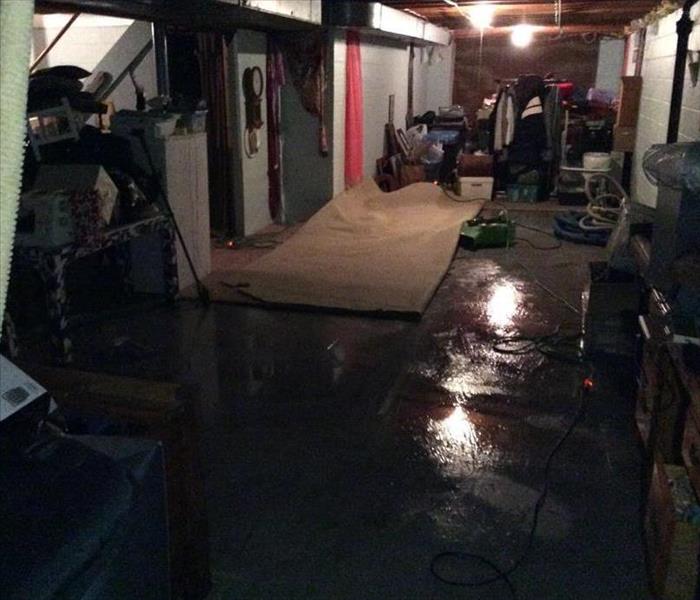 A broken water heater caused the water damage in this basement, affecting the entire floor and contents.
A broken water heater caused the water damage in this basement, affecting the entire floor and contents.
When people think about water damage, often, especially in our area close to the Jersey Shore, they think of major storms like Hurricane Sandy or coastal flooding. In reality, most water damage is “man made.”
The majority of water damage in homes stems from leaking or broken pipes, pipe fittings or caps, burst or leaking water heaters, appliances, kitchen and bath fixtures and sump pumps.
For pipes, these simple steps can deter major issues once winter weather settles and it becomes cold.
OUTDOORS:
- Wrap outside faucets.
- Caulk around pipes where they enter the house.
- Disconnect garden hoses.
- Drain in-ground sprinkler systems.
INDOORS:
- Check your home for places where water supply lines are not heated (e.g., in a basement or garage).
- Let a stream of water run if the temperatures dip below freezing.
- Open cupboard and vanity doors in the kitchen or bathroom.
- Keep the thermostat set to the same temperature both during the day and at night. By temporarily suspending the use of lower nighttime temperatures, you may incur a higher heating bill, but you can prevent a much more costly repair job if pipes freeze and burst.
- Shut off and drain your water system if you are leaving the home for several days or more, and set your thermostat a temperature no lower than 55° F.
Water heaters, on average, should last anywhere between 8 to 12 years. A broken water heater can leave over 50+ gallons of water all over your house, depending on how big it is.
How can you tell if it’s time to change your water heater? There are definitely signs.
- If your water heater is getting up in years, it may be time to replace it before it breaks.
- Tinted water coming from your hot water tap means there may be rust in your water heater, which is a possible indicator your hot water heater is showing signs of wear and may start to leak.
- Gurgling or popping noises coming from your water heater are caused by the buildup of hard water sediment heating up and exploding inside your water heater tank.
- Look around the base of your hot water heater for dampness. This may be a symptom of a slow or intermittent leak.
- If you have no hot water while using your hot water tap, it may be a sign that your water heater needs to be checked out.
- If you see a puddle around the base of your hot water heater, immediate action should be taken to replace it.
To save yourself and your home from a sewage backup, here’s some advice to keep in mind.
- Keep your drains clear of clogging. Don’t flush items down your toilet that can cause build up in the pipes, such as diapers, sanitary napkins, or thick waste. Also, don’t get rid of grease down the sink, as grease can harden within the pipes and then collect other waste, creating a major clog.
- Conduct regular inspections of all the pipes and valves in your home and make sure they are well maintained.
- Don’t plant trees too close to the sewer lines, as over time the roots can grow and damage the pipes.
Keep a working sump-pump on hand, just in case.
And speaking of sump pumps….. a sump pump is designed to help you prevent water damage, but if the sump pump itself fails, you’re in trouble. In order to keep your sump pump in good running order, it’s smart to service it at least once or twice a year. You can do this yourself by pouring a bucket of water into the sump pump basin to make sure it’s working properly. You may want to consider replacing your sump pump about every 7 years depending on use.
Even with all this preparation, accidents can still happen. In that case, calling SERVPRO of Eatontown/Long Branch immediately will ensure that any water damage will be cleaned by professional technicians and your home will be restored “Like it never even happened.”
How Often Do You Think About Your Plumbing?
12/7/2019 (Permalink)
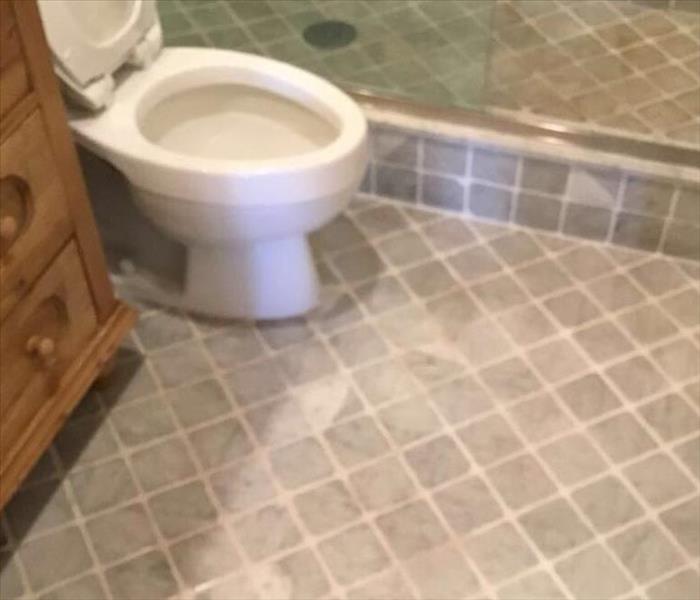 Toilets are often a cause of water damage, either by overflowing (sewage) or leaking. Damage can be extensive.
Toilets are often a cause of water damage, either by overflowing (sewage) or leaking. Damage can be extensive.
Many homeowners overlook issues that could develop into significant plumbing problems, and maybe even expensive water damage.
An easy visual inspection or simple test is often all it takes to ensure your plumbing is in good working condition and catch any problem before it becomes as major catastrophe.
Here’s a checklist of 4 common plumbing problems, and what you can do to prevent them from becoming a problem for you:
Washing Machine
Did you know that the average washing machine will use up to 40 gallons of water each cycle? With that much water pumping through, you want to be sure to check both the supply and wastewater lines about once a quarter.
Sinks
One of the biggest wear-and-tear problems for sinks are the seals and washers which will deteriorate over time.
You’ll want to check under the sink cabinets for any signs of leaking, which could include dampness, deterioration, or odors.
Toilet
When your toilet starts to wear down, it could lead to higher monthly water bills, or even potential flooding and major water damage.
In order to inspect your toilet, remove the tank lid and flush and make sure all the components (like the flush valve and flapper) are all in good working condition.
One easy way to check for a toilet leak is to add a couple drops of food coloring into the tank. After a few hours, check the bowl – if you see the dye color, then you know there’s a leak problem.
Showers & Tubs
Showers and tubs are often the most heavily used plumbing fixtures in a home, so it’s important to make sure everything is working properly.
Make sure to check faucets, drains, and shower heads on a regular basis. You’ll also want to check the seals. If caulk deteriorates, it could lead to a mold problem behind your walls.
If you see any signs of damage or corrosion, or if you decide you’d like a professional opinion, our team of experts here at SERVPRO Eatontown/Long Branch can help make sure you minimize any water damage. And if you do need more advanced help, know that we have all the specialized training and equipment necessary to handle even a large-scale water emergency.
Keeping Your Business Safe During Winter
12/7/2019 (Permalink)
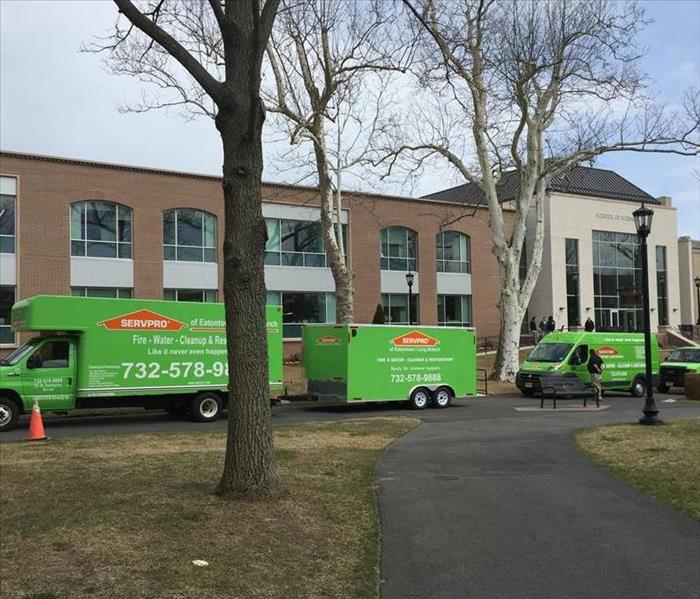 It can sometimes take a lot of manpower to clean up a business after storm damage. Taking precautions before a storm can save time and money.
It can sometimes take a lot of manpower to clean up a business after storm damage. Taking precautions before a storm can save time and money.
Many areas of Monmouth County are considered to be in low-lying areas, especially in the Two River Peninsula area. If you own a business here, make sure you are prepared before any storm to keep your business afloat afterward.
Prepare by making sure you locate any important documents and valuables and store them in a location that will be dry and secure.
Check your gutters and spouts to ensure they won’t be clogged when the storm hits, and make sure to have a working sump pump.
If needed, move any electronics or other costly items to a higher floor or at least try to raise them several feet off the floor to minimize any flood damage.
If your business facility floods, your first responsibility is to keep people safe.
Make sure to turn off electricity in any affected areas. Even if there’s a power outage, the power may be suddenly restored without notice and could cause a shock hazard. If you choose to enter a damaged building, be cautious of any structural compromises or falling debris.
Clean-Up ASAP
When flooding occurs, the quicker you can start your cleaning and restoration efforts, the better your chances of minimizing long-term damage and costs.
Reconstruction can’t happen until the flood-damaged area has been thoroughly disinfected and dried.
Be aware that although surfaces may feel dry to the touch, that doesn’t mean they are thoroughly dried. If you are able to remove any wet items from the flood-affected area of your business, make sure they dry completely before you bring them back to where they belong.
Anything porous that gets soaked – like carpet, insulation, or molding – may be beyond salvaging. If so, these items will need to be thrown away to prevent risk of disease from contamination. Items that can be saved will need to be disinfected and washed in the hottest possible water the item can tolerate.
If your business suffers storm damage and requires professional cleaning and restoration, rest assured that SERVPRO of Eatontown/Long Branch has technicians with advanced training, skills, and equipment necessary to clean and restore your business.
Getting Ready for Coastal Storms
12/2/2019 (Permalink)
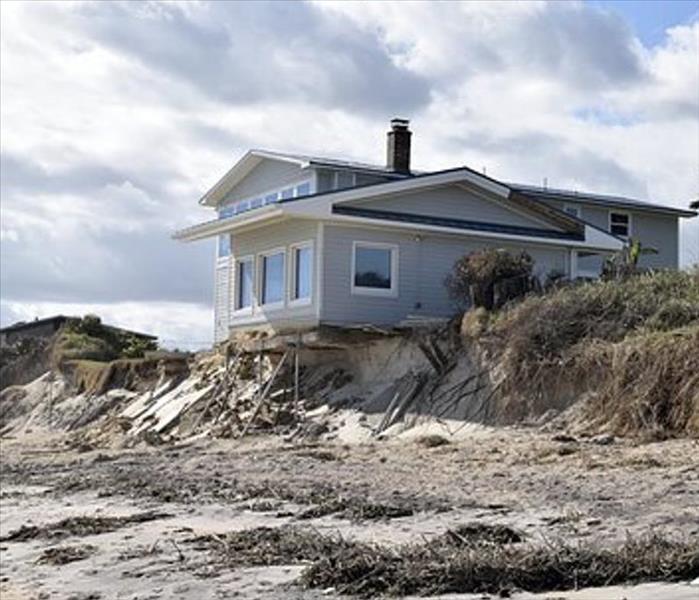 Erosion from coastal storms can affect structures built along the beach.
Erosion from coastal storms can affect structures built along the beach.
Living on the Jersey Shore means dealing with coastal storms, mostly in the form of hurricanes and nor’easters.
By definition, a nor’easter is a “storm that forms along the East Coast of North America. Nor'easters are named after the direction from which the strongest winds typically blow over the northeast states, including New England and the Mid-Atlantic states. The storms can bring wind, snow, rain and flooding.”
Here at the shore, most of damage we suffer is flooding and beach erosion due to high surf and tidal surge.
Nor’easter vs. hurricane
Nor'easters and hurricanes both form over the Atlantic Ocean. They're both also types of cyclones-a storm that has winds spiraling around a central low pressure zone.
However, while hurricanes originate over the warm waters of the tropics (near the equator) and rely on warm air to help move and strengthen them, nor'easters originate further north, near the eastern coast of the United States. Also, nor'easters thrive and pick up strength from cold air in the atmosphere, north of the Jet Stream and fueled by low-pressure systems from Canada.
Typically nor’easters are most common during the months between September and April. Because they thrive on cold air, bad weather conditions usually accompany them. These conditions usually include rain, flooding, high winds, snow and even blizzards. Sometimes the winds can be stronger than hurricane-force winds.
Hurricane season typically runs from June through October, with most storms affecting the East Coast during late August through October.
How to prepare for a coastal storm
Winterize Your Home
- Exposed water pipes should be wrapped with newspapers or a plastic wrap, and faucets should be turned on to allow a trickle to come through to prevent freezing and pipes bursting.
- Leaking roofs need to be patched or re-freezing precipitation could widen gaps and bring in more water and cold.
- Clogged gutters should be cleared of fallen leaves and twigs to let liquid flow and not get a chance to freeze so gutters weigh down.
Stock Up on Supplies
- Canned and Non-Perishable Food: Begin buying a few canned goods before the season with each trip to the supermarket as part of your regular shopping.
- Bottled Water: You should always keep a few extra gallons of water with some designated for drinking, others for non-consumption and set aside for washing up and cleaning, and even for first aid purposes.
- Battery-Operated Devices: Keep an assortment of fresh batteries in different sizes for use in flashlights, radios, battery-operated charges and other useful equipment.
- Generators: Keeping a generator running requires diligent maintenance. Perform all necessary checks, change the oil and make sure you’re stocked with all the necessary equipment and fuel to keep it running. Store it outside of your house at a good distance, since generators emit carbon monoxide exhaust.
- Emergency & First-Aid Equipment: Keep your home first-aid kit fully stocked with fresh, clean bandages and non-expired topical applicants and gels
- Keep Your Car Storm-Ready: Things to keep in your trunk are first-aid kit; jumper cables, shovel, scrapers and brushes .You may also want to carry kitty litter or rock salt to free your car from slushy situations.
Being prepared is paramount to making it through a storm unscathed. However there are circumstances beyond anyone’s control that may affect your home which even the best preparation won’t help. In that case, SERVPRO of Hackensack/Little Ferry is your best bet to get your home back to normal after a terrible storm.
Raw Sewage Backup? Why You Need to Call SERVPRO
11/28/2019 (Permalink)
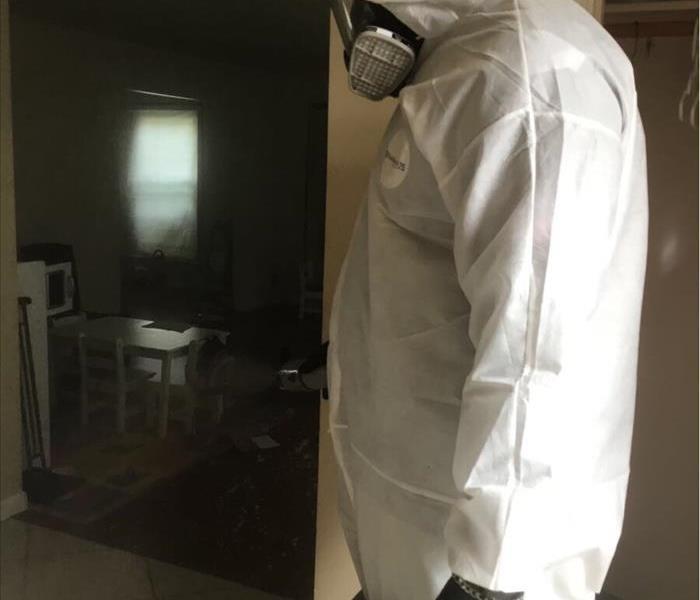 It is important to wear protective covering while cleaning sewage.
It is important to wear protective covering while cleaning sewage.
Let’s admit it, raw sewage is disgusting to have to deal with. But if it’s currently a problem in your home, it’s important to act quickly and get the clean up started as quickly as possible in order to minimize any long-term damage and keep your family safe.
Until help arrives, make sure you keep any young children or pets away from the affected area. Any adult who may be cleaning raw sewage should make sure to cover up any exposed skin and use safety equipment such as rubber boots, rubber gloves, and safety goggles.
Leaving sewage to the professionals is important due to the possibility of contamination or coming in contact with contaminants.
The experts at SERVPRO will follow the proper steps to ensure your home will be decontaminated, cleaned and dried professionally and completely by:
- Pumping out and removing sewage
- Cleaning & Sanitizing affected area(s)
- Drying the area to prevent mold growth and the spread of further contaminants.
- Restoring & Rebuilding
Depending on the situation, it may be necessary to remove carpeting or other building materials. You may find that the raw sewage has damaged parts of your home beyond saving.
If you find you've had a sewage backup, or need help restoring your property after a backup incident, give SERVPRO of Eatontown/Long Branch a call.
SERVPRO of Eatontown/Long Branch is always available
11/8/2019 (Permalink)
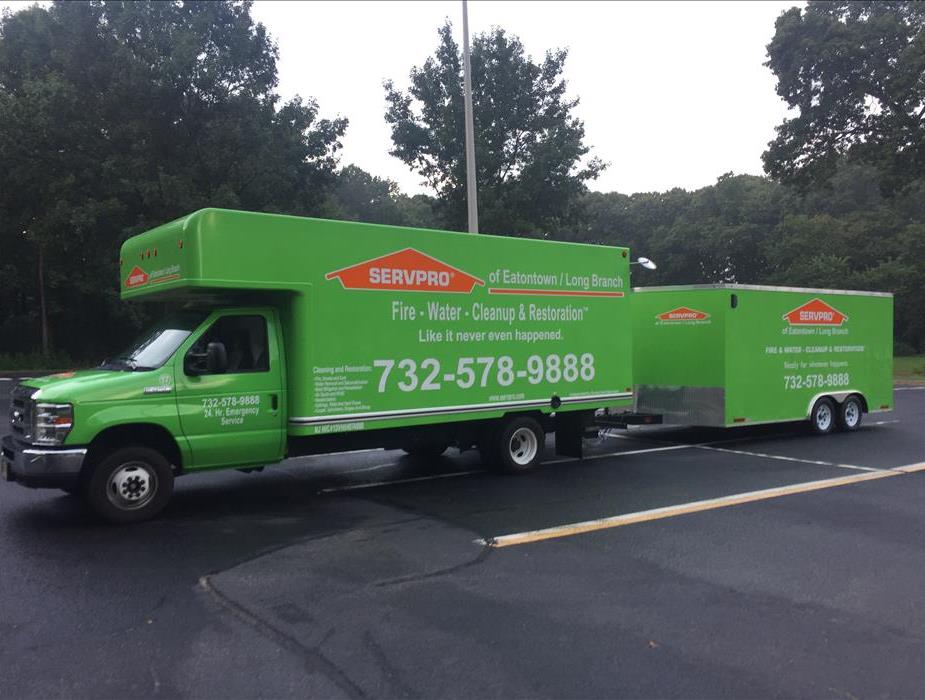 SERVPRO of Eatontown/Long Branch is always ready to head out for fire or water emergencies.
SERVPRO of Eatontown/Long Branch is always ready to head out for fire or water emergencies.
Nobody can predict when a water heater will burst, a pipe will break, or your stove will catch fire while you’re cooking. That is why SERVPRO of Eatontown/Long Branch is always available, twenty-four hours a day, seven days a week.
Within minutes, water will quickly spread, saturating everything in its path. Water is absorbed into walls, floors, upholstery, and belongings. Within the first 24 hours drywall begins to swell and break down, metal surfaces begin to tarnish and furniture begins to swell and crack. The earlier SERVPRO can get to the scene, the faster water can be extracted from the area and the important step of drying and mitigation can begin.
Fire and smoke is especially destructive. Not only does the structure suffer physical damage, smoke and soot can creep into tiny spaces and settle there, leaving a lingering odor and settling in air ducts, furniture, clothes, and crevices. In many instances property will also suffer from water damage from firefighting efforts.
Immediate response can mean all the difference in further issues .If you wait too long, there is the possibility of the appearance of mold and mildew, wood flooring begins to swell and warp or metal and paint being affected. The longer an area remains unmitigated, restoration time and cost increase dramatically; replacing contaminated materials and structural rebuilding may be extensive.
So remember that SERVPRO of Eatontown/Long Branch is available day or night, we are always on call, and we’re always here to help.
Why SERVPRO Can Help When Your Sump Pump Fails
11/1/2019 (Permalink)
 A malfunctioning sump pump can inundate a basement with water quickly, leaving a messy clean-up.
A malfunctioning sump pump can inundate a basement with water quickly, leaving a messy clean-up.
If you’ve invested in a sump pump, congratulations! A sump pump is your extra layer of protection to keep your basement or crawlspace safe from flooding and water damage. But what happens if your sump pump fails?
Here are 5 common reasons why sump pumps fail and what you can do about it:
An Overworked Sump Pump
If there’s a problem with your switch, or excessive amounts of rain or water flow, there’s a possibility your sump pump could continuously run until it burns out. Typically, sump pumps should only run for under a minute at a time.
Check how frequently your sump pump is running. If major storms will be a common occurrence, you may want to consider installing a secondary pump which can work alongside your first pump and empty the water basin more quickly when there’s heavy waters.
A Clogged Sump Pump
The drain lines that feed into the basin of your sump pump often carry bits of dirt and debris that can build up over time and clog the pump. When this happens, the pump may turn on, but it won’t function properly.
In order to keep your sump pump running smoothly, it’s a good idea to clean it out once a year. Make sure to use a wet/dry vacuum to remove both water and dirt from the bottom of the basin.
Power Problems
Power problem are one of the most frequent causes of sump pump failures. If your sump pump runs on electricity, you’ll be in trouble if you lose power during a major storm. That’s why you want to make sure to have a battery backup.
Unfortunately, battery backups can be expensive. As an alternative, consider a manual pump or a water-powered pump as your backup in case of a power outage.
Lack of Maintenance
Admittedly, it’s not pleasant to have to clean a sump pump – they’re typically dirty, smelly, and can be difficult to reach in a tight crawlspace. However, a sump pump that isn’t cleaned and properly maintained will wear out faster.
It’s a good idea to test your sump pump at least once a month to make sure it’s working properly. Then, every 6 months you will want to unplug the unity, drain the basin, and clean it out. Once you reassemble the unit, don’t forget to test it with several bucketfuls of water.
Older than 6 – 12 Years
Depending on how frequently your sump pump runs, it should last between 6 to 12 years.
If you know your pump is getting older or you’re unsure of its age, it’s a good idea to test and clean it more often. If you start to notice the onset of any problems, you should consider replacing the unit sooner than later to prevent a backup.
If your sump pump does fail, and you find yourself dealing with water damage, at least you can rest assured that SERVPRO of Eatontown/Long Branch is close by to help. Our team of expert technicians have all the tools and training needed to deal with any size disaster, and we offer 24/7 emergency service for when you need it.
5 Common Causes of Water Damage in Homes and Businesses
10/30/2019 (Permalink)
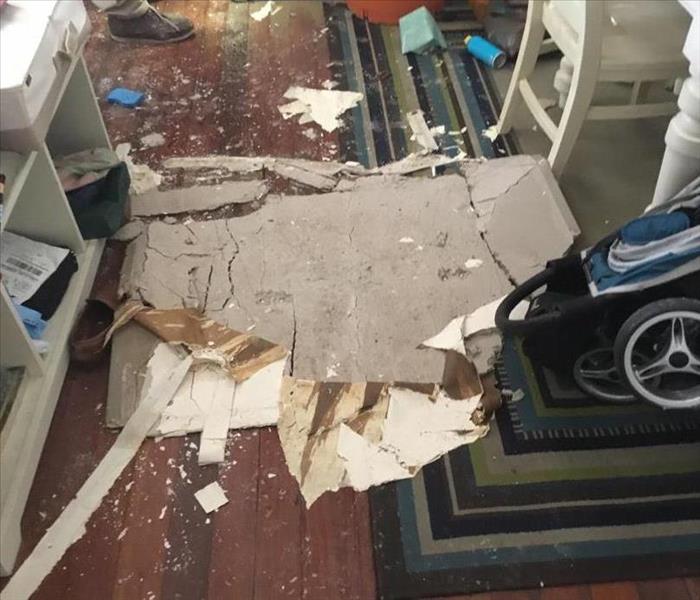 Water damaged the ceiling of this home, and ended up with the ceiling collapsing onto the living room floor
Water damaged the ceiling of this home, and ended up with the ceiling collapsing onto the living room floor
Do you have a water problem? Water is plentiful in nature and essential to life, but too much water in all the wrong places can be disastrous to homes and businesses. Water can breakdown drywall, hardwood, and other structural elements of a building as well as lead to hazardous mold conditions
Here at SERVPRO of Eatontown / Long Branch, we know how important it is to diagnose and fix a water problem quickly, before it turns into a catastrophe. Although sometimes the cause of water damage is obvious and unavoidable – major flooding from a hurricane, for example – there are actually several common causes of water damage that start small but can turn big and hazardous, especially if they go unnoticed.
In order to help you prevent water damage, here are 5 common causes of water damage you should pay attention to:
Backed Up Sewage
When sewage backs up, there is potential danger both from water damage and waste that can carry bacteria, parasites, and other contaminants.
Open floor drains are typically the most common cause of backed up sewers, but they can happen even with a closed waste system.
Leaks in Your Roof
It is common for roof shingles and decking to wear out over time, and as your roof weakens, there is an increased chance that rain or snow will lead to water damage.
Unfortunately, it is common for a roof problem to go undetected until it is too late. That’s why it’s a good idea to make a visual inspection of your roof at least twice a year. Also, pay attention to your ceilings for any signs of water stains, soft spots, or mold.
Problems with Your Foundation
Damaged foundations are also a common cause of water damage. Cracks, gaps, and general wear and tear to your foundation can make it possible for water to start to seep into your basement or crawl space, sometimes so slowly that it can go unnoticed until there’s a problem.
It’s a good idea to check your foundation regularly, and especially after storms or rapid snow melt when any small problem might quickly intensify.
Leaks in Your Plumbing
The valves and fixtures of your plumbing system will wear down over time and may cause at first just tiny leaks that easily go unnoticed, especially if the leaks are behind walls or otherwise hidden from plain sight.
To help prevent leaks, make sure to check your valves at least twice a year and replace them every 20 years or sooner depending on their condition. If the valves are behind walls, be on the lookout for signs of water spots or sagging drywall.
A Malfunctioning Sump Pump
A sump pump is designed to help you prevent water damage, but if the sump pump itself fails, you’re in trouble.
In order to keep your sump pump in good running order, it’s smart to service it at least once or twice a year. You can do this yourself by pouring a bucket of water into the sump pump basin to make sure it’s working properly. You may want to consider replacing your sump pump about every 7 years depending on use.
Here at SERVPRO of Eatontown / Long Branch, our mission is to be “faster to any disaster.” So, if your home or business is in need of help for water damage, our team of advanced technicians will be on hand bringing the advanced equipment and specialized training needed to clean and restore your damaged property as quickly as possible.
Why SERVPRO Can Help if You’re Selling a Home with Mold
10/25/2019 (Permalink)
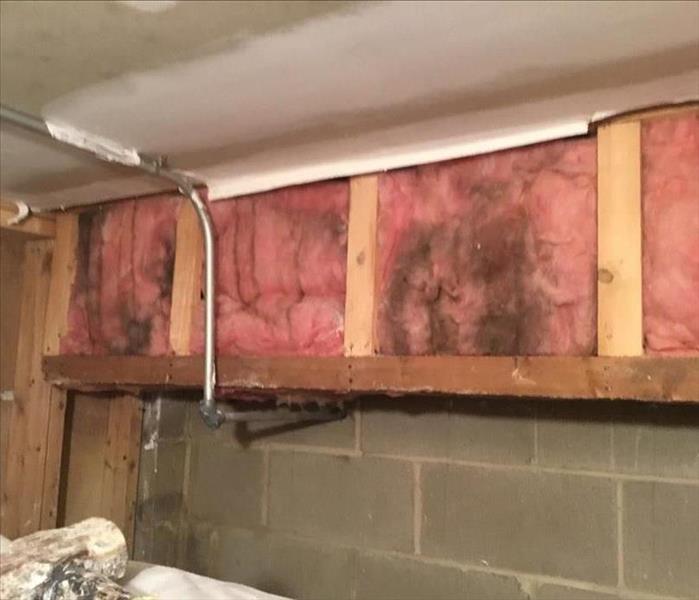 Basements are the prime space in homes that are prone to mold growth.
Basements are the prime space in homes that are prone to mold growth.
If you’re thinking about selling your home, one issue you may have to deal with is the presence of mold Unfortunately, a mold problem can be quite common in homes where there are persistent sources of water and moisture – and a significant mold issue can make it difficult to sell your home with a good return on your investment.
Here at SERVPRO of Eatontown / Long Branch, we know how difficult it can be to deal with mold. While a small mold problem – less than 10 sq. ft. – is something you may be able to clean on your own, mold can also easily get out of control, especially if it’s growing behind walls or above ceiling tiles, etc.
While dealing with a significant mold problem is never pleasant, the issue can be especially challenging if you want to now sell your home.
Don’t make the process of selling your home harder than it has to be! Here’s a simple 3-step process for dealing with a major mold issue before you put your house up for sale:
If you suspect a mold problem, get an inspection
There are common signs that indicate you may have a mold problem. If you notice any of the following, it’s a good idea to have your home professionally inspected so you know exactly the extent of the problem you may have:
- Signs of visible mold on walls, ceilings, or floors
- Stains or discoloration
- Musty smells
- Building materials that are deteriorating or “soft”
- Sudden or persistent respiratory problems or allergic reactions
Make sure to disclose the mold problem
If you currently have or have recently had a mold problem, this information is something you must include in your disclosure agreement.
It’s a good idea to be as specific and detailed as possible about the extent of the mold problem and the steps you have taken or will take to solve it. Make sure to document the process and provide proof of work through reports, receipts, and paperwork.
Get the help of a trusted professional mold removal provider
When you’re going to be selling your home, you want to make sure you hire trained, licensed and/or certified professionals to remove the mold.
This is important, because an expert mold removal provider will not only have the advanced equipment and training needed to thoroughly clean and sanitize the affected area, they will also be equipped to address the water source that caused the mold problem in the first place.
Reputation matters, and you want to be able to show future buyers that your mold problem was fixed by a name they can trust.
Document all aspects of the mold remediation and removal process
When you’re planning to sell your home, it’s a good idea to save all the paperwork associated with any mold remediation services you get. This includes the initial estimate, work order, and any mold testing reports.
It’s also a good idea to document the process with before and after photos, including photos you take with your smartphone.
While this may seem overdone, it’s better to be more cautious than not. In the event that a future buyer files a legal claim against you, a court will be looking for these kinds of records in order to side in your favor.
SERVPRO of Eatontown / Long Branch has been a trusted mold remediation and removal provider for homes throughout Monmouth, Ocean, Middlesex and Mercer Counties. Our team of experts can handle all aspects of a mold problem to make sure your home is ready for sale.
If you’re interested to find out more about how SERVPRO can help fix your mold problem for good, just give us a call at: 732-858-5196
Fire Damage? How to Start the Cleaning Process
10/21/2019 (Permalink)
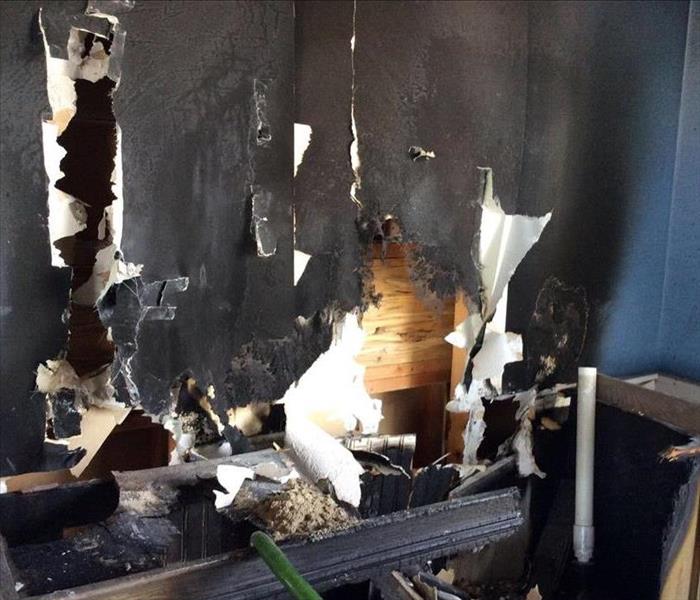 Calling SERVPRO of Eatontown/Long Branch helped this homeowner clean up after a fire.
Calling SERVPRO of Eatontown/Long Branch helped this homeowner clean up after a fire.
If you’ve experienced fire damage in your home or business, you’ve undoubtedly observed that smoke and soot can unfortunately damage almost all kinds of surfaces and materials. While some items are easy to replace, it’s a good idea to try to salvage as much as you can.
The good news is: there are many fire damaged items you can clean (or at least start to clean) all by yourself with easily available cleansers and cleaning techniques. In fact, it’s a good idea to get started cleaning as quickly as you can, in order to prevent the effects of long-term damage. However in most cases, CONTACT YOUR INSURANCE COMPANY, everything from cleaning to replacement is most likely covered.
Here’s a guide to help you get started cleaning up after a fire:
Remove Smoke and Soot Stains from Wood
As long as your wooden items aren’t charred, you should be able to clean them with a mild oil soap. Rinse with water, and let them air dry.
Remove Smoke and Soot Stains from Upholstery
If you can remove stained upholstery, bring it to a dry cleaner that specializes in cleaning fire damaged fabrics. At home, you could try washing it in a solution of water mixed with white vinegar and baking soda.
If you have upholstery that’s can’t be removed, start by vacuuming the surface with a shop vac, keeping the hose just above the surface to prevent rubbing in the stain even more. Next, sprinkle the stain with baking soda and allow it to sit for at least one hour. Then, spray the stain with white vinegar and wipe with a damp rag.
For hard-to-clean stains, you may have to let the baking soda sit longer (sometimes overnight) and/or repeat the cleaning process multiple times.
Remove Smoke and Soot Stains from Metal
When cleaning metal, you want to be sure to use a polish that is specially designed for the specific type of metal you have. Typically, the process is just to gently rub the stain with the polish and then wipe away with a clean rag, but be sure to follow the manufacturer’s instructions.
Remove Smoke and Soot Stains from Glass
To clean glass, you can often use a commercial glass cleaner or a homemade solution of one-part water to one-part vinegar. You’ll want to avoid spraying the glass, as this can leave smoke streaks. Instead, apply the solution to the rag and start wiping at the edge of the stain moving inward.
Remove Smoke and Soot Stains from Leather
You can clean fire damaged leather with a specialized leather soap and conditioner.
You want to be sure not to get the leather too wet, as this can create additional stains. Also, you’ll want to apply the soap gently to avoid scratching the leather.
If you need help to restore your property after fire damage, SERVPRO of Eatontown/Long Branch is always available to help.
SERVPRO Is Here to Help You Clean Up After Smoke Damage
9/30/2019 (Permalink)
 Soot and fire extinguisher dust will cover every surface and is usually difficult to clean.
Soot and fire extinguisher dust will cover every surface and is usually difficult to clean.
Smoke damage can make your home a dirty, smell mess. Whether you’ve suffered a major fire catastrophe or had smoke damage accumulate from the presence of fire in your home, you want to start cleaning up smoke stains as soon as you can in order to prevent permanent damage.
Our team at SERVPRO of Eatontown/Long Branch has seen our share of fire incidents as Professional Cleaning and Restoration Leaders in this community so, we know what smoke damage can do to a home.
Make Sure the Area is Safe
If your incident was a small kitchen grease fire, there is probably minimal risk. However, if fire burned through a significant section of your home, you want to be sure the area you enter is structurally sounds and cleared by officials before anyone can attempt to start fixing it.
Dispose of Everything that Can’t Be Salvaged
The first step of the cleaning process is to get rid of everything that can’t be saved.
Be especially wary of food that may have been contaminated, plastics that may have melted, or materials that are too stained to be cleaned.
Vacuum Up Debris
We have specialized equipment to clean up debris.
Soot is greasy, it is best to wait for a professional to clean soot-stained surfaces and making a bigger mess.
Clean up Odors
You can clean some fabric and upholstery yourself that may have avoided smoke stains may still have absorbed odors.
If you have fabrics that are dry clean only, be sure to take them to a dry cleaner that specializes in smoke removal or fire treatment.
For fabrics that can go in a washing machine, add a cup of white vinegar and a cup of baking soda to your regular load to clean the smoke damage. A mixture of white vinegar and baking soda can also be used to spot clean carpeting and upholstery.
Seal Surfaces
Even after a full cleaning, there may still be some lingering stains and odors. To mitigate this, we use a sealing primer.
We use specialized sealers for different surfaces. For example, on painted walls, we use a stain concealing primer followed by a topcoat of latex paint. For wooden surfaces, we use a sealer designed specifically for wood or particleboard.
If you need professional assistance in cleaning up after a fire incident, SERVPRO of Eatontown/Long Branch is here to help. Our specialized technicians have the advanced training and equipment needed to clean and restore your property, helping you get your life and property back to normal ASAP.
5 Things You Must Do Immediately After Storm Damage
9/20/2019 (Permalink)
Storm damage can happen any time of year, (although during the winter, the effects of storm damage can be particularly brutal.) Your home may suffer roof damage that might ruin the structural integrity of your home and cause leaking. Strong winds might cause fragile trees to collapse.
At SERVPRO of Eatontown / Long Branch we’re committed to help keeping this community safe. We understand how challenging it can be to deal with storm damage. As a leader in the restoration industry, we’ve been helping homes and businesses in this area for over 10 years. We have the advanced training and equipment needed to get your life back to normal as quickly as possible.
When you’re dealing with storm damage, it’s important to act quickly to minimize problems. Here are 5 things you should do immediately in the wake of storm damage:
Stay safe!
Winter storms can quickly create hazardous conditions, such as collapsing roofs or damage to your windows and/or walls. Leaking can cause water damage that can ruin carpeting, furniture, and building materials, leading to an environment full of potential dangers.
While it can be tempting to want to rush in and save what you can – don’t forget that your first priority is to stay safe!
Be sure to shut off the main gas line if you smell gas, and be on the lookout for slippery surfaces, exposed nails, broken glass, and other possible hazards. I you decide to enter the affected area, you’ll probably want to wear protective clothing and slip-resistant shoes. Depending on the extent of the damage, it may even be necessary to arrange an alternate place to be while your property is being restored.
Call Your Insurance Provider
Contact your insurance provider as soon as you can to notify them of the damage. Your insurance company will send an adjuster to check on the state of the damage and determine payments for repairs.
SERVPRO of Eatontown / Long Branch will work with your insurance provider to help you process the claim. Just let us know when you call!
Take Photos
If it is safe to move around or near the affected area, try to photograph the damage so that you have an additional record of evidence for your insurance company. This can help make sure you will be fully compensated.
No fancy camera required – taking photos with your cellphone will be just fine.
Check if You Qualify for Federal Disaster Assistance
Depending on the severity of the storm, the federal government may have declared your property to qualify for disaster relief assistance. You may be eligible for aid or a low-cost loan for restorations
Restore
When a severe storm hits, it’s a good idea to call for professional restoration services as quickly as you can. The longer standing water is left untreated and damage is not addressed, the more restoration work may be needed and the chance of cost increases may occur.
Why SERVPRO Can Help with Water Damage – Even When It’s Not Obvious What / Where the Problem Is
9/13/2019 (Permalink)
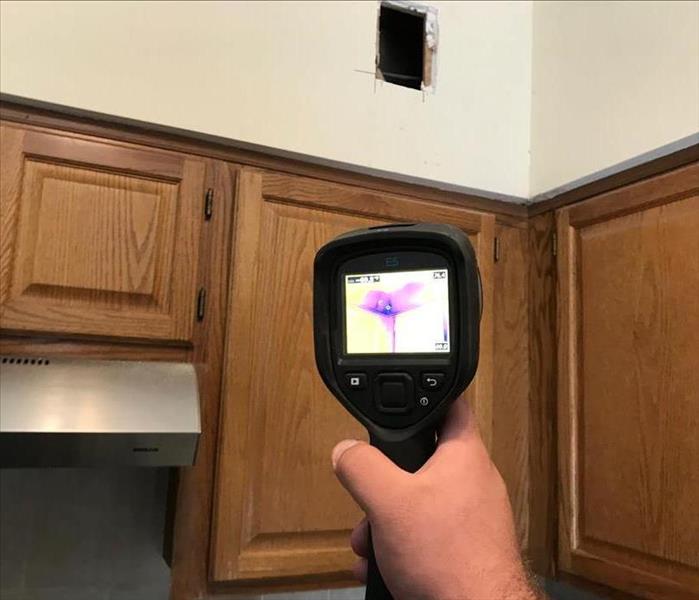 SERVPRO has special equipment to help see moisture even when its not outwardly visible
SERVPRO has special equipment to help see moisture even when its not outwardly visible
Sometimes water damage and its source are easy to identify – for example when a pipe bursts or a major storm causes flooding. But sometimes the problem can be more subtle…and that can actually lead to more damage over the long-term if you don’t recognize a problem before it becomes a potential disaster.
If you’re concerned there may be a water problem in your home or business, here are 5 common but not-so-obvious signs to look out for:
Water Stains
If you see pale yellow or brown stains on your ceilings, wall, or floors, that may indicate the presence of a slow but steady leak.
Many times, water stains will form directly under the water source. However, sometimes water will run along wire, pipes or other materials and then drip and cause stains far from the source. Make sure you figure out the cause of the water damage you see.
Mold Growth
Mold grows where there is sufficient wetness for it to thrive, so if you have a mold problem, there’s a water problem.
Sometimes materials in your home will become mold infested if they’ve become wet and have never been able to dry sufficiently. This can happen to fabric, wood, insulation, and perhaps even your floors, ceilings, or walls.
Odors
A musty smell can be one of the first signs of a water problem, even if you can’t yet see any leaks.
Be on the lookout for any sudden changes in odor. Take note if it gets worse after a rainstorm or while you’re taking a shower or running the dishwasher.
Weak Wall, Floors, or Ceilings
Water will weaken your building materials. You might notice that your walls are becoming more soft or “spongey”, your floors might be bowing, there may be a crack in your ceiling or a bubble in your wall paper.
A sudden large leak might cause a major, obvious problem, but if the leak is slow these issues might come on gradually over weeks or months. The sooner you notice, the sooner you can address the root cause.
Higher Utility Bills
If you have a sudden and unexpected surge in your utility bill, that might be an indication of a water problem.
While slight fluctuations month to month are normal, be on the lookout for a sudden rise in the water bill, especially if there’s no corresponding increase in your sewer rates. If there isn’t a reason you can think of why your water bill might be high this month, it may be that there’s a water damage issue.
Here at SERVPRO of Eatontown / Long Branch we know just how disastrous water damage can be to a home or business. That’s why we’re passionate about helping the people in this community do what they can to prevent water damage before it becomes a major issue.
But IF you have water damage – even just minor damage – SERVPRO of Eatontown / Long Branch can help you identify and address the source of the problem and ensure that it won’t turn into an expensive catastrophe for your home or business.
Is Your Water Bill is Too High?
9/2/2019 (Permalink)
It can be normal for your water bill to fluctuate from month to month - you may be watering your lawn more in the Spring or Summer, or doing extra laundry if you have guests visiting. As long as you know why your water bill is higher, there shouldn't be any cause for alarm. However, sometimes you may notice an unexpected large increase…and that could be a sign of water damage
To help you prevent severe water damage to your property, here are 4 common kinds of leaks to look out for that may be causing your water bill to be too high:
Leaking Faucets
A leaky faucet may just release a few drops of water, but if you wind up with a severe leak you could be wasting as much as 20 gallons of water every day. That’s why it’s important to check each faucet to make sure there are no visible signs of a leak.
One way to check is by placing an empty cup underneath the faucet and making sure no water collects. You’ll also want to take a look at the piping in the cabinets underneath the sink, and don’t forget to check your outside hoses and water sources as well!
Leaking Pipes
Plumbing leaks can sometimes be difficult to detect as many of your pipes may be hidden behind walls or above the ceiling. Still, you can at least make sure to check all the visible fittings and fixtures for any signs of damage or leaking.
As for your hidden pipes, you can pay attention to the ceiling and walls themselves. If you notice any signs of discoloration, deterioration, or mold, that can be a clue to the source of the problem.
Leaking Toilets
A continuously running toilet can waste as much as 200 gallons of water every day and cause your water bill to soar.
One easy way to check if you have a leak is to dispense a few drops of food dye into the tank of your toilet. If you see the color start to come into the bowl, that’s a sign of a potentially bad leak.
Purification Systems / Water Softeners
If you use a water softener or purification system, that could be the cause of your bill increase. These systems tend to produce more waste water than other plumbing systems.
If you water bill is suddenly high, you want to make sure that these systems are working correctly and not producing excessive water waste.
Here at SERVPRO of Eatontown / Long Branch, we are available 24/7 and can be at your home quickly to help you if you do have water damage. Our local team is made up of the best advanced technicians with the training and equipment needed to handle any size disaster.
Carpet Drying after Flooding and/or Water Damage
8/19/2019 (Permalink)
If your business has been damaged by flooding or a water leak, the carpeting may be a soggy, water-logged mess. And because most business flooring IS carpeting, this can create a major issue.
The main concern is to dry the carpeting quickly in order to prevent damage to walls, sub-flooring, and other structural elements of your building. The good news is: the drying process is one you can often start on your own almost immediately after the incident! Just remember that calling in professionals like SERVPRO of Eatontown/Long Branch will ensure your office will be back in sooner rather than later (or never).
Here’s how to START the drying process in order to prevent further damage:
Identify and Stop the Source of the Water Problem
The first step in saving your carpeting is to identify the source of your water problem and do your best to stop it, or at least to lessen it.
Remove Any Standing and/or Excess Water
Once there’s no more water coming in, your next step is to start to remove any standing or excess water. Either renting a pump from your local hardware store or using a wet/dry shop vac will work.
Separate the Soaked Carpeting from the Floor
Once you’ve removed most of the water, if possible, separate the carpet off from the floor.
Begin along a wall, pulling away from the tack strips and moving across the room. Be careful not to use too much force in handling your carpeting, as wet carpeting is more fragile than normal and more likely to tear.
Bring In Professional Restoration Services
In order to thoroughly dry and clean any flooring and/or carpeting, you’ll want to consider calling for the help of a professional restoration service provider.
The professionals at SERVPRO of Eatontown/Long Branch are IICRC certified for all types of restoration, and will make sure every surface is dried out, cleaned and remediated professionally, and will take the necessary steps to
– helping homes and business deal with water damage that’s gone beyond their control. We have all the necessary training and equipment to quickly and efficiently dry your wet carpeting, limiting your risk of mold/bacteria exposure and increasing the chances of saving your carpeting.
- Dry the area, including affected walls.
- Clean the floor and sub-flooring.
- Clean and/or replace the carpeting.
- Check and remediate for mold if necessary.
SERVPRO Wants to Make Sure You’re Prepared for Storms
7/10/2019 (Permalink)
Because weather can be so volatile, especially with the upcoming hurricane season, it’s important be prepared in advance. Here at SERVPRO of Eatontown / Long Branch we’ve seen firsthand how destructive storm damage can be, and we want to make sure everyone in this community knows what they can do before, during, and after a storm to help protect your family and your property in case of a storm emergency.
Here’s a helpful guide so you can be prepared when a storm is in the forecast:
Before
- Make sure you’re ready with a Disaster Preparation Plan. Determine a meeting place away from your home or commercial building and plan escape routes from each room. Practice the plan with everyone, so there won’t be any question what to do in an emergency.
- Put together an Emergency Supply Kit. Some good items to include are water, non-perishable food, extra medications, a flashlight, batteries, copies of your personal documents, a blanket, a first aid kit, and cash.
- Check that your home or commercial building is in good condition to withstand a strong storm. Check your roof now for loose shingles and make sure your doors, windows, and basement are waterproof.
During
- During a storm, make sure all the windows and doors have been securely shut. Keep away from windows in case the glass should break and shatter. If the storm is severe, you may want to stay in the basement if you have one, or an interior room.
- If you go outside, be careful of moving water, because just a few inches of rapidly flowing water can be enough to sweep a person off their feet. If you can, try to stay on higher ground and keep away from low lying areas where deep flooding is more likely.
After
- Once the storm is over, make sure everyone is ok and start to check your property for any damage. Don’t forget the maxim “Safety First” as flooding can cause potential hazards, including risks of falling, contamination, and electrocution.
- Make a list of any lost or damaged items, and take photos to document the extent of the damage.
Don’t forget, any storm can happen suddenly, so now is the best time to plan and act. And, if you do require emergency flood repair or water damage restoration, rest assured that SERVPRO of Eatontown / Long Branch is always here to help. We’re known for being “faster to any disaster” with the advanced technicians and equipment needed to restore your property so that it’s like new. We can even help you work with your insurance provider.
5 Tips to Keep Your Energy Costs Down and Your Home Safe from Damage as Temperatures Rise
7/2/2019 (Permalink)
Summer is a great time for family activities around the house, but it can also be a time of skyrocketing energy costs and potential home & health hazard.
Here at SERVPRO of Eatontown / Long Branch, we want to make sure everyone in this community stays safe and is able to enjoy the Summer while protecting your home and property values. As leading Cleanup & Restoration experts in this local area, we want to help you with this simple Summer checklist.
Here are 5 tips to keep your family protected and your home safe as the days get longer and temperatures continue to rise:
How to Keep A/C Costs Low
One of the best ways to keep your air conditioning costs down is to plan for regular maintenance. It’s a good idea to have a central HVAC unit serviced at least once a year, and make sure to replace or at least clean your filters before the new summer season gets into full swing.
Another useful tip is to not run your air conditioner on high when you’re not at home. Set your thermostat a couple of degrees higher anytime you’ll be out for more than an hour. You can set it back down once you return.
How to Grill Safely
Summertime grilling is a favorite way to spend quality time for families across the country. Unfortunately, it is also a leading cause of fires and fire damage.
Here are a few guidelines for safe grilling:
- Make sure the grill is clean and in good working order before you use it.
- Keep a bottle of water and a fire extinguisher on hand.
- Place your grill at least 10 feet away from your house or any other flammable structure.
How to Prevent Water Damage
Warmer weather is also the season for sprinklers, hoses, and other outdoor water faucets.
You want to be diligent to make sure these water systems aren’t leaking, as leaks can lead to significant water damage. Look for signs of corrosion, wear and tear, or other damage to the various parts. Also, be on the lookout for any puddles or pools of water that may have formed across the water line.
How to Prevent Mold Growth
The potential for mold growth increases as the weather gets more humid. Mold grows where there’s moisture, so be on the lookout for standing water or extensive condensation.
If you discover a small section of mold (less than 10 sq. ft.) it is probably safe to clean it yourself with a solution of one-part water to one-part bleach. If in doubt, however, you can always call for help from a professional service provider like SERVPRO.
Pay Attention to Your Attic and Basement
While you may now be spending more time outdoors, don’t forget to keep tabs on what’s going on inside your house as well, especially in the attic and basement.
If you notice signs of discoloration or deterioration, these may be signs of a water or mold problem. Catching these problems early is the best way to keep costs down.
Maintenance and prevention are the best ways to prepare for a safe Summer. If, however, a problem should arise, know that SERVPRO of Eatontown / Long Branch is always here to help with any clean-up or restoration project large or small. We have the all the advanced training and equipment needed to deal with home damage of all kinds.
What You Need to Know About Commercial & Large Loss Fire Damage Restoration
7/1/2019 (Permalink)
A large-loss fire presents unique challenges for a business that needs to emerge from the ashes stronger than ever. A fire is not only devastating to a business’s physical building, it can also be emotionally devastating to the owners, employees, and loyal clients and customers of the business.
Because of this, handling a large-loss fire restoration project is not only about restoring a piece of commercial property to its pre-fire condition, it also requires sensitivity to the long-term, deep needs of those most affected by the fire.
Here at SERVPRO of Eatontown / Long Branch, we have the advanced training, specialized equipment, and expertise to help your business in all aspects of the restoration process. Our elite large-loss specialists are strategically trained and positioned to be able to respond to any size disaster, no matter how large. Every large-loss project is supervised by a specially designated manager who ensures that the restoration process happens as quickly as possible with effective, responsive communication among everyone involved.
If your business suffers a major loss due to fire, here are 6 key steps to the restoration process that you can anticipate:
Making the Call
The first point of contact happens when we get the call about your fire damage restoration needs.
During the initial stages, we want to gather as much information as we can about the fire and your needs: When and where was the fire? What kind of fire was it? How much of your business property has been affected? The better we understand the scope of your needs right from the start, the more efficiently we can move forward.
On-Site Inspection
Next, we will conduct an on-site inspection to assess the extent of the damage and prepare for next steps.
Typically, this occurs after the fire department has cleared the fire and secured the property. Oftentimes, the efforts to put out the fire can cause an additional set of problems (i.e. water damage). In this stage, we work to determine the exact scope and timeline of the project and how much demolition and/or reconstruction may be necessary. Sometimes we may have to temporarily board-up open spaces and introduce temporary supports to maintain the structural stability of your building.
Property Removal
Typically, the next step is to remove and pack up anything in the building that has been affected by the fire to try to restore what can be salvaged off-site.
Estimate & Restoration Work
Once we have an idea of the scope of your project, we can offer you an estimate, sign all the necessary paperwork, and finally get started on the restoration work.
Though demolition and/or reconstruction may be necessary in the case of major fire loss, some areas of your business property may just require smoke, ash, and water damage restoration. Wall and carpeting may require professional deep cleaning to restore them to their pre-fire condition.
Frequent Communication
Whatever the scope of your project, the manager we assign to your restoration will make sure to facilitate frequent communication that includes you, your insurance company, and all the members of the teams assigned to your project.
Constant, consistent communication ensures that everyone is on the same page and making progress. We want to make sure any of your questions are addressed at any stage of the project. Our goal is full transparency, so you know just what will be done, when, and why.
Finishing Touches & Walk-Through
Once the major work of reconstruction and restoration is complete, the last step is often to clean the air ducts and HVAC system to remove the last traces of soot and contamination. Also, it is now time for any property that had been removed for restoration or safe-keeping to be returned to where it belongs.
If your commercial property has suffered a large loss due to fire, call us here at SERVPRO Eatontown / Long Branch anytime.
SERVPRO Wants to Help You Prevent Summertime Fires
6/17/2019 (Permalink)
Summertime is the season for backyard barbecues, fireworks, and time spent enjoying the outdoors, maybe even sitting around a fire pit. This means there’s also an increased potential for a fire emergency.
Here’s a guide that can help keep your home and/or local business safe from fires this summer:
Practice Grill Safety
It’s a good practice to make sure your grill is at least 3 feet away from the house and any other structures or objects that could potentially catch on fire. Be wary of any overhanging tree branches!
Regularly clean the grill and remove any grease build up. Also, always make sure you have water and a fire extinguisher nearby when you’re grilling, just in case
Monitor Your Air Conditioning
Air conditioning, fans, and other cooling equipment are a frequent cause of summertime fires. Typically, they occur from electrical or mechanical failures.
One way to make sure your equipment is in good working condition is to schedule regular maintenance. You can also make sure to change the filter and remove any dirt or debris.
In order to prevent overuse, try turning your air conditioner off during peak hours. You can also adjust your thermostat when you leave for more than one hour to maximize efficiency.
Check Your Lawnmower
Don’t let a faulty lawn mower be the cause of a fire!
Be sure to check the engine, mufflers, and cutting blades and keep your machine clean and well maintained. If your lawn mower overheats, wait for it to cool down before trying to refuel it.
Be Cautious with Fireworks
If you live somewhere where fireworks are legal, they can add some extra pizzazz to your summer parties. Just be sure to use them with caution!
Make sure to follow all the local laws, and heed any warnings or instructions that come with your fireworks. Make sure to keep your fireworks at a safe distance away from people, buildings, and any flammable objects.
And always keep a bucket of water on hand, just in case!
These summertime fire prevention tips can go a long way to keeping you safe. However, if you still do experience a fire accident, know that SERVPRO of Eatontown / Long Branch can help you take the right steps to get your home or business back in shape. We often even can help you work with your insurance company.
SERVPRO Can Help with Your Commercial Loss
5/31/2019 (Permalink)
SERVPRO of Eatontown / Long Branch has been the cleanup and restoration leader in this community for over 10 years. We’ve helped many business owners deal with the aftermath of a water or fire disaster and make sure they are up and running for business again as soon as possible. We know how important it is to be prepared so you can deal with the cleanup process ASAP and get back to serving your customers.
To help you understand what to expect from the cleanup process, here’s a step-by-step guide:
Create a Safety Zone
During any restoration process, it may be necessary to establish a safety perimeter, especially around standing equipment and removed building materials.
Remove Any Non-Salvageable Items
Our SERVPRO team of restoration professionals is committed to salvaging and repairing as much as possible.
In particular, items like carpeting or wooden furniture that can become saturated with contaminated water may not be safe to try to repair. When this happens, these non-salvageable items will be properly bagged and removed from the area for safe disposal.
Sanitize
Once the affected area has been cleared out, next it is time to clean and disinfect.
The specific cleanup process will vary depending on the nature of the accident, but in all circumstances, a commercial-grade disinfectant will be used to thoroughly sanitize the area and prevent any further issues.
Seal
Depending on the circumstances, it may be necessary to seal-up certain surfaces in order to remedy odors and stains.
It is common for drywall to need to be repaired. Other surfaces that may need sealing might include plaster, concrete, or certain wooden surfaces.
Reconstruct
Once your damaged property has been thoroughly cleaned and sealed up, it will be time to start the restoration and reconstruction process.
Maybe it’s just your floor that needs to be restored, or maybe there’s a whole section of a building that needs to be reconstructed. Whatever the size of the problem, you can rest assured that our professionals of SERVPRO will be able to handle it. In fact, we pride ourselves on being “faster to any size disaster.”
Your Step-by-Step Guide to Drying Carpeting after Flooding and/or Water Damage
5/17/2019 (Permalink)
If your home or business has been damaged by flooding or a water leak, your carpeting may be a soggy, water-logged mess. When this happens, it’s imperative to dry the carpeting quickly in order to prevent damage to your walls, sub-flooring, and other structural elements of your building. The good news is: the drying process is one you can often start on your own almost immediately after the incident!
Here at SERVPRO of Eatontown / Long Branch, we know how devastating water damage can be to a home or business. As a leader in professional restoration services we want to help make sure you mitigate any damage that may occur to your property due to a water problem.
Here’s how to start drying your wet carpeting in order to prevent further damage:
Identify and Stop the Source of the Water Problem
The first step in saving your carpeting is to identify the source of your water problem and do your best to stop it, or at least to lessen it.
Remove Any Standing and/or Excess Water
Once there’s no more water coming in, your next step is to start to remove any standing or excess water.
The sooner you can start drying out your carpeting, the better your chances of salvaging it. If there’s standing water completely covering the carpet, you may want to rent a pump from your local hardware store to start extracting it.
Another useful tool is a wet/dry shop vac which can be used to suck up excess water from a saturated carpet.
Separate the Soaked Carpeting from the Floor
Once you’ve removed most of the water, now you will want to separate the carpet off from the floor.
Once you’ve pulled up the carpeting, you’ll want to dispose of the carpet padding. (Carpet padding is typically inexpensive and generally easier to just replace than to try to dry out).
Dry, Dry, Dry!
Once the carpeting is separated from the flooring, it’s time to do your best to dry both completely.
It’s often useful to move the carpeting to another totally dry area. Use high-powered fans and/or blowers on both the flooring and the carpeting. SERVPRO has professional grade equipment that will do the job better than any home/retail equipment can do.
Replace and Clean the Carpeting
Once the floor has been cleaned and you’ve installed new carpet padding, it’s time to re-install and clean your carpeting. In most cases, however, replacing the carpet is the norm.
Bring In Professional Restoration Services
In cases of significant water damage, specialized equipment and training is often needed to thoroughly fix the problem and restore your property to like-new conditions.
Here at SERVPRO of Eatontown / Long Branch, we’re proud to be helping homes and business deal with water damage that’s gone beyond their control. We have all the necessary training and equipment to quickly and efficiently dry your wet carpeting, limiting your risk of mold/bacteria exposure and increasing the chances of saving your carpeting.
When You Should Call for Professional Services to Clean Up Mold
5/10/2019 (Permalink)
Spring showers may bring new flowers…but Spring flooding can also lead to mold growth in your home or business. Mold is a common side effect of water damage, and once it starts growing, it may require professional clean-up services to fully remove it.
We at SERVPRO of Eatontown/Long Branch, are proud to be a leader in professional cleaning and restoration services for this community. We’re experts in dealing with the aftereffects of major flooding and water damage, helping homes and businesses throughout this area restore their properties to like-new conditions. We want to help make sure you stay safe from the hazards of mold.
Much misinformation has been spread about mold. The truth is, there are many types of mold that come in many colors, and not all types are as potentially dangerous as others.
Common symptoms associated with hazardous mold exposure can include skin irritation, congestion, itchy eyes, or sinus problems. People who already have allergies, immune deficiencies, and upper respiratory issues may be at greater risk when exposed to hazardous mold.
The first thing to remember about cleaning up is that mold is the result of a water problem. So, the first step to getting rid of the mold is to identify and fix the source of the water issue. If you don’t, the mold is likely to return, even after a thorough cleaning.
When you ought to call for professional clean-up help
- If you have significant water damage.
- If you have damp areas you’re not able to thoroughly dry yourself.
- If you have mold growth beyond 10 square feet.
If your home or business needs clean up help with black mold, know that SERVPRO of Eatontown/Long Branch is here 24/7 to help. Our friendly expert technicians have the advanced training and professional grade equipment needed to stop your mold problem for good and restore your property.
SERVPRO Knows How to Remove Mold
4/1/2019 (Permalink)
Mold is a problem that can affect every home, and may be present even before it becomes visible.
In order for mold to take hold, environment needs to be rich in food sources (like cardboard, wood, dust, paper, etc.), little air movement and humid and moist temperatures. Basements, garages and bathrooms are prime places mold growth can occur.
The issue is most people are completely unaware there could be mold hidden behind sheet rock or in their insulation. In many cases you can smell mold in the air long before you ever see signs of a mold problem. Many times your wall or floor may look dry on the surface, but moisture can be trapped underneath.
SERVPRO of Eatontown/Long Branch has technicians who are certified and trained in discovering hidden mold and removal.
Hidden mold is often discovered during a water loss restoration, when sheet rock or flooring is too wet to dry with our special equipment and must be removed. Once that is done, often mold will be visible growing on stud beams, inside the sheet rock or on insulation. Homeowners may not even know it’s a problem.
Thankfully, once discovered by our technicians, mold removal and cleaning is easy to accomplish. Again, SERVPRO has special equipment and procedures to remediate mold and make sure your home is safe, the dangerous mold is removed and your home is left “Like it never even happened.”
How to Prevent Water Damage: Everyday Tips and DIY Tricks
3/29/2019 (Permalink)
Water damage can be unpredictable. However, there are steps you can take to help prevent it. In fact, it can be quite easy to make sure your plumbing and HVAC systems are in good working order.
Here at SERVPRO of Eatontown / Long Branch, we’re proud to be leaders in cleaning and restoration services here in this community. Our team of advanced technicians has all the specialized knowledge, training, and equipment necessary to handle any size disaster. But rather than cleanup after a disaster, we’d like to help you prevent major damage from occurring in the first place.
Here are some ways you can prevent water damage on a day-today basis, both when you’re at home and traveling away for an extended period:
Everyday Water Damage Prevention Tips
If you’re careful about what goes down your drains, you can help prevent cracks and damage to your pipes that might otherwise lead to leaks and water problems.
- Be careful what goes down your toilet. It’s a good idea to flush only human waste and toilet paper. Note: even “flushable” wipes can clog toilet drains, especially in bulk.
- Make sure not to pour grease or coffee grounds down drains as these can clog pipes and sewer lines.
- If you have a drain clog, try using a drain snake rather than a chemical cleaner as a snake is typically both more effective and less potentially hazardous.
DIY Water Damage Preventative Maintenance
Here are some easy DIY steps you can take to inspect and maintain your water supply. If you do notice signs of wear and tear or incorrect operations, be sure to call professional services soon before a small problem turns into a major home disaster.
- Clean your gutters regularly once a year and be sure to check them after heavy storms to make sure water is flowing properly.
- Once a year, make sure to visually inspect your plumbing - including any toilets, sinks, tubs, washing machines, or dishwashers – and look for any signs of damage or leaking.
- Flush your sinks with baking soda and vinegar to help prevent clogs. You can use lemon juice to eliminate any odors.
- Consider investing in a sump pump in case of flooding and be sure to check it regularly to make sure it is in good working order.
Pay attention to your water bill each month. An unexpected increase may indicate that water is leaking somewhere.
Water Damage Prevention When Traveling
If you’ll be traveling away on vacation, here are steps you can take before you leave to help prevent any water problems while you’re away.
- Adjust your HVAC settings to a low setting or turn them off completely if possible.
- Consider turning off your water supply and draining your pipes.
- Ask a neighbor to check on your house every few days to make sure there aren’t any developing problems.
While it’s not always possible to prevent water damage, these tips can help minimize your chances of having to deal with a major water-related emergency. And if something should happen, know that SERVPRO of Eatontown / Long Branch is available 24/7 to help deal with any size water damage problem, large or small.
What to Do About Commercial Property Leaks
3/27/2019 (Permalink)
Water damage caused by leaky pipes can cause severe property losses for local businesses. Whether the water is slowly seeping from a loose fitting or is suddenly gushing from a burst frozen pipe, commercial property leaks can prove disastrous for the overall local economy.
The good new is: many types of leaking water damage are covered by commercial property insurance policies. Unfortunately, not all leaks are covered. So, it’s good to know how to be prepared.
Here at SERVPRO of Eatontown / Long Branch we know how important it is to keep local businesses up and running. That’s why we’re trusted by so many business owners in this community to help deal with water damage and restoration issues.
To help you understand how to deal with leaks at your commercial property, here’s a helpful guide explaining what kinds of water leaks are typically covered by commercial property insurance policies, and what kinds of leaks are not:
Covered
- Sudden Events
If a leak is caused by a pipe or other appliance, such as a water heater, that suddenly breaks, any damage to your commercial property will likely be covered under your insurance policy.
Note: commercial property policies generally don’t cover damage resulting from a backed-up drain, sewer or sump pump. However, it is often possible to purchase additional sewer backup coverage if you are concerned about that issue.
- Fire System Damage
While commercial property policies generally won’t cover the repair costs to most broken appliances, they often will cover the cost to replace or repair any damaged parts of a fire protective system, such as a sprinkler.
- Building Restoration
Most water pipes are hidden inside walls, ceilings, and floors, so when a leak occurs, it will often be necessary to tear out a piece of the building in order to repair the pipe.
The good news is, many commercial property insurance policies will cover the costs to restore those parts of the building that had to be removed in order to repair the leak.
Not Covered
- Slow Leaks
Many commercial property insurance policies will not cover damage caused by water that has been leaking continuously for 2 weeks or more.
For this reason, it’s important to be proactive about maintenance and vigilance regarding potential leaks. Sometimes a leak can be so slow that no harmful damage occurs until months have passed, so you need to be on the lookout for even the smallest indications of a leak.
- Frozen Pipe Leaks
It’s common for many insurance policies to contain a “freezing” exclusion so that any damage caused by a frozen appliance or liquids that freeze will not be covered.
However, there are often exceptions. For example, if you can demonstrate that you did your best to maintain adequate heat in the building, if the frozen pipe was caused, say, by a sudden power outage, you may still be able to qualify for coverage.
If the worst should happen and you do need water damage restoration, we can help you ASAP. Here at SERVPRO of Eatontown / Long Branch, we pride ourselves on being “faster to any disaster” with the best technicians and equipment to restore local businesses in this community. We’ll even help work with your insurance provider.
Keep Your Home Safe From Mold
3/26/2019 (Permalink)
Most homes have basements, attics, crawl spaces or garages that provide habitats for mold. All that is needed is a dark, damp, warm environment. If you have water damage, water leaks, a leaky roof, a washing machine that overflows frequently or any other chronic water/moisture issue, mold can take a toehold and thrive.
sometimes water damage can lurk behind walls where it is not apparent. SERVPRO professionals can use a moisture meter and infrared cameras see if anything is leaking.
So what can you do to reduce your exposure to mold? Attack mold on two fronts -- removal and prevention:
Fix leaky plumbing or other sources of water. If you have mold in your crawl space or basement, locate the source and stop the water from coming in.
Dry water-damaged areas and items (like carpeting) within 24 to 48 hours of flooding. Throw out all wet, moldy tiles and carpeting.
Reduce indoor humidity by venting bathrooms, dryers, and other moisture-generating sources. Exhaust fans in bathrooms and kitchens can help. If you don’t have exhaust fans, crack a window in the kitchen when you're cooking or in the bathroom when you're bathing.
In the summer use air conditioners and dehumidifiers inside your home. Change filters regularly. Use a dehumidifier to get rid of dampness in basements.
In the winter, add insulation to windows, piping, exterior walls, roof, or floors where there is potential for condensation on cold surfaces.
If you suspect or see mold anywhere in your home, get your house tested for mold. A moisture meter test will help, and dust samples from your carpet can show whether mold spores are in your home. If you DO have mold, call SERVPRO of Eatontown/Long Branch, and our certified experts will put a remediation plan in place to get rid of it.
SERVPRO Can Help After a Fire
3/21/2019 (Permalink)
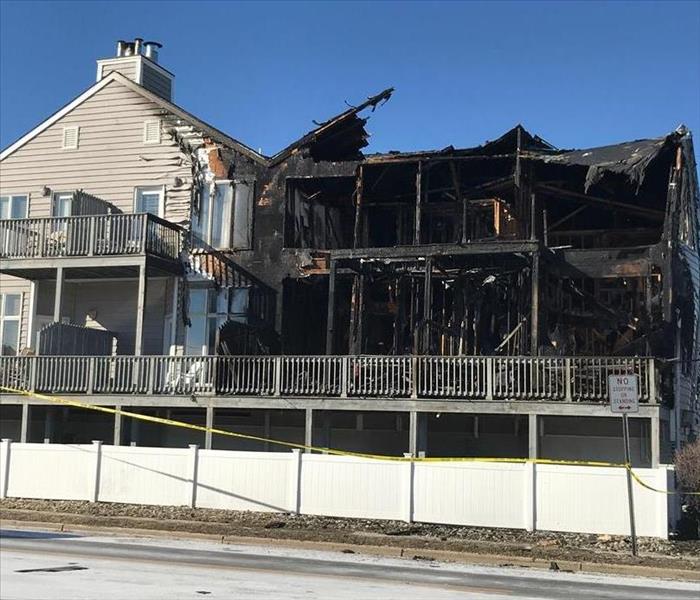 While we unfortunately can't do anything for the structure that is gone, SERVPRO CAN remediate and clean the surrounding structures.
While we unfortunately can't do anything for the structure that is gone, SERVPRO CAN remediate and clean the surrounding structures.
Having a fire in your home is a devastating and traumatic experience. No matter how small, soot, smoke and ash can creep into every crevice of your home, leaving a fine film over surfaces, ash everywhere and a lingering odor.
Having a fire in a structure next to your home can be just as devastating, as fire may destroy siding, smoke and ash may enter your home and water used to put out the fire next door can also affect rooms in your home as well. It can be just as traumatic not knowing what to do or whom to turn to.
SERVPRO of Eatontown/Long Branch is here to help. We have certified, experienced and professional technicians who will come to clean and deodorize – finding every place soot and odor can hide. We are also experts in content cleaning like furniture and have services that can clean documents, photos, artwork, rugs and window treatments. We can also tarp your home where damage has occurred or board up windows and doors if needed.
Whether you experience a fire in your home or are affected by one next to you, remember that SERVPRO is here to help, and truly can make it “Like it never even happened.”
Smoke is Sneaky - It Gets Everywhere
3/21/2019 (Permalink)
Smoke damage from a fire, no matter how large or small, can be devastating. Oftentimes smoke damage can be long lasting because the odor soaks into every surface including walls, furniture, window treatments, flooring, and wall studs.
Behavior of Smoke
A fire loss can be very complex because of the unique behavior of smoke. SERVPRO® Franchise Professionals undergo extensive fire restoration training and certification, and understand the behavior of smoke.
- Hot smoke migrates to cooler areas.
- Smoke migrates to upper levels of a structure.
- Smoke flows around plumbing systems, using holes around pipes to go from floor to floor.
Knowing how smoke penetrates and lingers is only one part of being able to mitigate smoke damage. Knowing what types of smoke will greatly affect the restoration process as well.
Knowing what type of smoke has affected your home is also important.
- Wet smoke- Plastics and Synthetics
- Dry smoke- Paper and Wood
- Protein Fire Residue- Produced by evaporation of material rather than from a fire.
- Fuel Oil Soot- Furnace Puff Backs
Because we are experts in dealing with fires, we know how to clean it professionally and completely. It is important to understand why you need to call us in the event of a fire, no matter how large or small. The professionals at SERVPRO of Eatontown/Long Branch will help get you back to your lives and jobs as soon as possible, making it “Like it never even happened.”
Coastal Storms Pose Flood Dangers
3/14/2019 (Permalink)
Living in a flood-prone area such as the Jersey Shore, being prepared is the best thing you can do for yourself in case of the inevitable storm surge. As destructive as flooding can be, with some forethought, planning and the right information, you can endure rising waters.
Obtain Flood Insurance - most of the area we live in is considered a flood plain.
Elevate Your Property - some shore towns are now requiring it, so make sure you know what you need to do.
Waterproofing - it is not too difficult to have a company come and waterproof your basement - especially if groundwater is a constant problem.
You also maintain your sump pump system and keep it operational. It may also be in your best interest to have a battery-operated sump pump if you lack a system or there is a power failure.
Reduce Potential Debris In anticipation of the flood and evacuation, move furniture and loose items to a higher floor to minimize debris.
If you decide to stay in the home during a storm with potential flooding, there a re a few things to keep in mind.
Food:
- keep at least 3-days of food and water. Any food you keep should be non-perishable, such as canned and dry goods (e.g., soups, cereals, protein bars);
- If you have access to a refrigerator, be sparing in its use to help keep the cold circulating. If the temperature rises above 40°F, bacteria will thrive—rendering any refrigerated food inedible;
- Any food that has been left at room temperature for over two hours or has had contact with contaminated flood water should be discarded.
Water:
- Keep a fresh supply of bottled water. If you need to use containers, use food-grade water storage containers. Avoid carbonated, caffeinated and alcoholic beverages as they will dehydrate you;
- If you run out or need to treat possibly contaminated water, boil it, chlorinate it, or use distillation methods before use.
Once the flood waters subside, you know you can count on SERVPRO of Eatontown/Long Branch to assist with the cleanup and speed up the return to normalcy.
What to Do If Your Business Is Damaged by Fire
3/8/2019 (Permalink)
If you’re dealing with fire damage to your business, you may be wondering what you’re supposed to do next.
The good new is: fire damage doesn’t have to mean the end of your business. According to statistics from FEMA, more than half of all businesses do re-open after disaster[1], and for many businesses, fire damage can become an opportunity to emerge stronger -- just like the mythical phoenix who rises from the ashes.
If you too want to rise above a fire disaster, here’s a simplified step-by-step guide for what to do when your business gets damaged by fire:
Call for Professional Cleanup & Restoration Services ASAP
When disaster strikes, you will want to call for professional help immediately. Once you are dealing with the aftermath, things can get very overwhelming, and knowing what steps to take can be elusive.
This is why calling in the professionals at SERVPRO of Eatontown/Long Branch can be the best move at this critical time.
Figure out who is responsible.
Many factors will come into play, including whether you own or lease the building, who or what caused the fire, and how much insurance coverage you have. (Note: some insurance policies only cover the contents of your building, not all the materials actually used to construct your business.)
In many instances, you will need to wait until investigations have been completed by the local fire or police departments and/or your insurance provider. Just make sure to keep the lines of communication open for information and additional instructions.
Make sure to salvage and safeguard all you can.
If the fire has destroyed windows, doors, walls, or your roof, you will need to act quickly to salvage and safeguard any property you can.
Any large holes in your structure should be patched to prevent further damage and minimize the risk of vandalism. This is another reason it’s so important to call for professional cleaning and restoration help as quickly as is possible.
Contact your business stakeholders.
Your next step will be contacting everyone who may be affected by the fire damage. This includes any employees, business partners, or investors. It also includes your customers – make sure to communicate the news about what has happened and tell them about your plans to emerge stronger. Making this open declaration can help your own motivation in such a difficult circumstance!
Also, don’t forget to contact your insurance agent ASAP. Some claims may require an inspection or consultation, and you’ll wanted to get the process started as soon as you can.
In most instances SERVPRO is able to help manage your insurance process and paperwork.
Make sure your documents are in order.
The insurance company will require documentation about your losses, so be sure to gather up your statements and receipts.
Another good tip is to take photos or video footage of the damage, even just using a smartphone. This can be used as evidence for the extent of your losses.
Get back to business as usual.
Once you call fire damage restoration experts, they will be able to assist you in repairing not only damage from fire and smoke, but also any water damage that may have occurred during the firefighting efforts.
The experts of SERVPRO Eatontown / Long Branch are specially trained to mitigate any damage and oversee the entire restoration process, getting you back to business as quickly as we can.
10 Things you need to know about mold
3/6/2019 (Permalink)
One of the biggest concerns for local residents is mold. Do I have mold? Is it bad? Are my kids safe?
Here are 10 basic things you need to know about mold:
- Mold can cause health effects.
- There is no practical way to eliminate ALL mold and mold spores in the indoor environment; the way to control indoor mold growth is to control moisture.
- If mold is a problem in your home or school, you must clean up the mold and eliminate sources of moisture.
- Fix the source of the water problem or leak to prevent mold growth.
- Reduce indoor humidity (to 30-60%) to decrease mold growth by:
- Venting bathrooms, dryers and other moisture-generating sources to the outside
- Using air conditioners and de-humidifiers
- Increasing ventilation
- Using exhaust fans whenever cooking, dishwashing and cleaning
- Clean and dry any damp or wet building materials and furnishings within 24-48 hours to prevent mold growth.
- Cleaning mold jis difficult - calling a specialist is best.
- Prevent condensation: Reduce the potential for condensation on cold surfaces (i.e., windows, piping, exterior walls, roof, or floors) by adding insulation.
- In areas where there is a perpetual moisture problem, do not install carpeting (i.e. basements) unless well ventilated.
- Mold IS everywhere and depending on the right environment, can grow and thrive. Food sources include wood, paper, carpet, and foods. Not all mold is a potential health threat, but knowing the difference is key.
Knowing the facts is the best way to prevent a potential mold problem. The BEST step is hiring a licensed professional to test and then have SERVPRO of Eatontown/Long Branch do the remediation. Our 50 years of experience counts when it comes to removing mold from your home. Call us today.
The Unpredictable Month of March
3/1/2019 (Permalink)
March can be the most unpredictable month of the year. Last year in New Jersey saw three major nor’easter storms, in less than two weeks! Or it can be mild, with spring-like weather leading into April.
Just like March itself, it’s difficult to predict what can happen in any weather situation. Winter storms can be any of a combination of snow, wind or rain, and can result in flooding, wind driven snow drifts and icy roads.
The main rule of thumb is to always be prepared, and know what to do in case an unexpected storm hits your area.
Call Your Insurance Provider
Contact your insurance provider as soon as you can to notify them of the damage. Your insurance company will send an adjustor to check on the state of the damage and determine payments for repairs.
Take Photos
If it is safe to move around or near the affected area, try to photograph the damage so that you have an additional record of evidence for your insurance company. This can help make sure you will be fully compensated.
Restore
When a severe winter storm hits, it’s a good idea to call for professional restoration services as quickly as you can.
Your restoration services will begin with the basic tasks of inspecting your property and securing it to make sure it is safe. The damaged area will then be thoroughly cleaned and sanitized and restored as soon as possible so you can hurry up and get back to normal life.
Stay safe!
Be sure to shut off the main gas line if you smell gas, and be on the lookout for slippery surfaces, exposed nails, broken glass, and other possible hazards. I you decide to enter the affected area, you’ll probably want to wear protective clothing and slip-resistant shoes. Depending on the extent of the damage, it may even be necessary to arrange an alternate place to be while your property is being restored.
SERVPRO of Eatontown / Long Branch has experience restoring businesses and homes affected by storms and flooding. We can respond immediately with highly trained technicians who employ specialized equipment and techniques and are equipped to handle any kind of disaster – from flood to fire and everything in between.
How to Deal with Water Damage to Your Home
2/12/2019 (Permalink)
If you’re facing water damage, there are some steps you can take to minimize the costs of restoring your home. The following are tips that can help you lessen the effects of any future water damage.
Just remember that depending on the extent of the damage, sometimes your smartest move is to call a professional right away. Your first priority needs to be making sure you and your family are safe.
Safety First
Before you can clean and restore your home, you first have to get rid of the mess.
Molds and bacteria flourish and grow in any damp space with little air flow, and can be very dangerous. Anyone working on cleaning-up water damage ought to wear protective clothing such as masks, gloves, and safe footwear.
Electrical hazards and the potential to slip and fall are the other major safety concerns – only perform those clean-up activities you know to be safe.
When belongings get wet, they can become much heavier than normal; you don’t want to attempt to lift something that is too heavy and hurt your back on top of everything else!
Remove Damaged Items
If your basement has flooded, you need to get the damaged items out. Unfortunately, many things may be beyond saving, or easier and cheaper to just replace rather than try to salvage. If you can make some of these decisions earlier rather than later, it may help you save costs in the long run.
Remove Water and Let Your Home Dry
Sometimes, the amount of water will be too much to remove yourself and you should call your cleaning and restoration professionals right away. Prop-up wet cushions and upholstery somewhere they can dry out. And place a piece of aluminum foil or wood blocks between furniture legs and wet carpeting to prevent further water damage.
Ripping up soaked carpet will most likely be necessary - be careful of nails and carpet tacks.
DO NOT use any electrical appliances that may have gotten wet or damaged themselves. A household vacuum cleaner is generally not a good option for cleaning-up after water damage, however, if you can get your hands on a commercial grade shop vacuum, that may help you clean and save some money in the process.
Disinfect
Once you’ve removed the water and damaged items, you’ll want to use a disinfectant to clean up the remaining affected areas. There are some green products that are safe to use and can help make a difference to the amount of professional grade cleaners you may ultimately need. Just be sure to read the labels and wear your protective gear.
Get the Air Circulating
The extent of bacteria and mold growth will depend on a number of factors, including moisture level, temperature, and the presence of wood and paper materials on which they can feed. If significant mold growth develops, that will increase your remediation costs – so it’s important to start drying as much as you can as soon as you can.
While your household fans can’t compete with professional equipment, they certainly can help and ultimately reduce remediation costs. Running a dehumidifier can also help remove excess humidity from the affected environment.
If you do require professional water damage restoration services, the professionals at SERVPRO of Eatontown / Long Branch offer 24-hour emergency service. We’re a locally owned and operated company here in your community providing the highest caliber water inspection, extraction, drying, and restoration equipment and service.
5 Tips to Help Your Business Weather Out a Bad Storm
2/7/2019 (Permalink)
Just when you think winter may be over, the New Jersey Coast can still see a major winter storm which can batter the Shore area with wind, rain, snow and flooding.
If you own a business that is in a high-risk area for flooding, these tips can help you minimize damage you may be unfortunate enough to endure
Get Prepared
1. Store important documents and valuables and in a location that will be dry and secure.
2. Check your gutters and spouts to ensure they won’t be clogged.
3. Make sure to have a working sump pump.
4. If possible, move any electronics or other costly items to a higher floor or at least try to raise them several feet off the floor to minimize any flood damage.
Safety First
1. Turn off electricity in any affected areas. Even if there’s a power outage, the power may be suddenly restored without notice and could cause a shock hazard.
2. Be cautious of any structural compromises or falling debris ff you choose to enter a damaged building.
3. Keep out of the floodwater as much as possible to reduce the risk of slip-and-fall hazards and bacterial contamination.
4. Be sure to wear protective clothing – including slip-resistant shoes, gloves, eye protection, and a mask – in order to minimize potential risks.
Clean-Up ASAP
When flooding occurs, the quicker you can start your cleaning and restoration efforts, the better your chances of minimizing long-term damage and costs.
Here at SERVPRO Eatontown / Long Branch our expert technicians are available 24/7 to respond to any flooding emergency big or small. We have the advanced training, skills, and equipment necessary to clean and restore your business to its pre-flood condition as quickly as possible.
The Science Behind Mold
2/6/2019 (Permalink)
Not all molds are actually toxic. That’s the good news. Unfortunately, there are plenty of other molds that are toxic -- but they’re not black.
If you’re concerned about mold in your home or business, here are the basics you need to know in order to keep safe:
What Kinds of Mold Are Toxic
If you follow the news, you’ve probably heard the scientific term Stachybotrys used to categorize black mold that produces toxins. (Specifically, the toxins that are produced are mycotoxins, which is the scientific term for any toxic substance produced by a fungus).
However, mycotoxins are not always produced when mold is present. Scientists have identified specific strains of Stachybotrys, such as Stachybotrys chartarum and Stachybotrys atra, which have been shown to cause many health issues for humans. But as there are literally hundreds of thousands of mold species that we currently know of in existence, it’s not necessarily likely that you will have these particular kinds.
What’s more, dangerous mycotoxins can be produced by other kinds of mold besides Stachybotrys. And these molds don’t have to be black.
The bottom line is that your best protection against a mold problem is to prevent mold in the first place. And if you do see some mold, you need to know when it’s okay to try to clean it on your own (hint: only if it’s small in area, less than 10 square feet). In most situations, however, if you think you have a mold problem, you should call in professional services to be sure. Remember: safety first.
Weather is Unpredictable
2/6/2019 (Permalink)
Just like winter itself, it’s difficult to predict what can happen in any weather situation. The main rule of thumb is to always be prepared, but should something unforeseen occur, know that the experts at SERVPRO are equipped to handle any kind of disaster – from flood to fire and everything in between.
The recent mild weather in the beginning of February, but we're not out of the woods yet as far as extreme weather is concerned! Living by the Jersey Shore, we should always be prepared for that next storm which could potentially bring severe coastal flooding.
Wetter seasons are packed with more extreme weather events with sea rise, coastal erosion and other factors leading to flooding issues, even in places that haven’t experienced it since records began.
“Forewarned is forearmed” is the mindset to have if you live in a flood-prone region. As destructive as flooding can be, with some forethought, planning and the right information, you and your loved ones can endure the trials posed by the rising waters.
Here are some helpful tips and suggestions:
For Your Home
- Obtain Flood Insurance: It’s best to know with some research or asking a realtor before you move into a new home if it’s located in a flood zone.
- If Feasible, Elevate Your Property: It may be expensive at the outset to do so, but if flooding is frequent, you may want to consider elevating your entire home to lift it higher than historic flood lines.
- Waterproofing: Another fix to consider is waterproofing your basement. You will also need to maintain your sump pump system and keep it operational.
- Reduce Potential Debris: In anticipation of the flood and evacuation, move furniture and loose items to a higher floor to minimize debris.
If you do end up with water damage due to storm surge, extreme wind and rain or any other reason, SERVPRO Eatontown/Long Branch has experience restoring businesses and homes affected by storms and flooding. We can respond immediately with highly trained technicians who employ specialized equipment and techniques to restore your home or business back to pre-storm condition.
4 Tips to Prevent Fire Damage During the Cold Weather Season
1/29/2019 (Permalink)
Did you know there are more fires during the Winter months than any other time of the year? During the cold weather season, it makes sense that people are looking for extra ways to keep warm. Unfortunately, many alternative heating methods can also be fire hazards, especially when they’re not approached with care.
If you want to protect your home and/or business from fire damage during this cold weather season, here are 4 tips to keep in mind:
Know the Dangers of Fireplaces and Wood Burning Stoves
Sitting in front of a fire on a cold winter’s night may sound cozy – unfortunately, a large percentage of fires start with issues to a chimney or fireplace.
- Shield the fireplace with a grate to prevent flying sparks from igniting in the room.
- Keep any flammable materials at least 4 feet away from the fire place.
- Perform regular maintenance and cleaning on your fireplace and/or wood burning stove.
- Make sure there are no cracks in your chimney and that the top is properly capped to keep out debris throughout the year.
Know the Dangers of Space Heaters
Space heaters are wonderful for keeping us extra warm on cold days. But this extra heating equipment is also a major cause of winter house fires.
- Use only space heaters with a “tip switch,” ones that shut off automatically if tipped over.
- Make sure to follow the manufacturer’s safety instructions.
- Keep the space heater at least 3 feet away from anything flammable.
- Make sure there is adequate ventilation and base/floor support in the areas where you will use a space heater.
Know the Dangers of Electric Blankets
On a cold night, it’s comforting to curl up in a warm bed. However, if you want to use an electric blanket, make sure to be cautious – these can quickly catch fire if the blanket material is ignited by an overheated electrical element within the blanket.
- Check for charred or frayed cords or any dark spots, these may indicate a potential problem with the electrical element.
- Don’t allow anyone or anything on top of the blanket when it is in use, this could lead to overheating.
- Similarly, don’t fold or tuck in the blanket when it is in use, as this could also lead to overheating.
- An electric blanket should never be left unattended or used while one is sleeping.
Make Sure Your Smoke Alarms are Working
If a fire accident should happen, you want to make sure your smoke alarms are in working order, so that you can address the issue immediately.
It’s generally a good idea to regularly check the alarms each year (many people remember to check the alarms on the days when daylight savings time changes). However, it’s also wise to double-check the alarms before you start a fire or use a heating element, just in case.
These tips can help make sure you, your property, and your family all stay safe during the cold weather season when we’re all trying to stay warm. If, however, you do experience a fire accident, know that SERVPRO of Eatontown / Long Branch is here to help. We pride ourselves on being “faster to any disaster,” no matter the size. And we can help you get back to normal ASAP!
What You Can do to Reduce Your Exposure to Mold
1/23/2019 (Permalink)
So what can you do to reduce your exposure to mold? Attack mold first by prevention:
Get your house tested for mold. SERVPRO of Eatontown/Long Branch has a list of local environmental testing companies.
Fix leaky plumbing or other sources of water. If you have mold in your crawl space or basement, locate the source and stop the water from coming in.
Dry water-damaged areas and items (like carpeting) within 24 to 48 hours of flooding. Don't install carpeting in areas where there is a moisture problem.
Reduce indoor humidity by venting bathrooms, dryers, and other moisture-generating sources. If you don’t have exhaust fans, crack a window.
Use air conditioners and dehumidifiers inside your home. Change filters regularly. Use a dehumidifier to get rid of dampness in basements.
Add insulation to windows, piping, exterior walls, roof, or floors where there is potential for condensation on cold surfaces.
If you follow these tips, mold growth should be kept at bay. But if you DO find mold, call SERVPRO of Eatontown/Long Branch, and we will be out right away.
Why SERVPRO is the Best Restoration Company In Your Area
1/4/2019 (Permalink)
Disasters are by definition: "a sudden event, such as an accident or a natural catastrophe, that causes great damage."
Nobody can predict when a water heater will burst, a pipe will break, or your stove will catch fire while you’re cooking.
But SERVPRO of Eatontown/Long Branch is always available, twenty-four hours a day, seven days a week. We are always ready to be there when you call, being "faster to any disaster."
Within minutes water will quickly spread, saturating everything in its path.
Fire and smoke are especially destructive, leaving physical damage, smoke and soot and lingering odor settling in air ducts, furniture, clothes, and crevices. In many instances property will also suffer from water damage from firefighting efforts.
In either case, The longer an area remains unmitigated, restoration time and cost increase dramatically; replacing contaminated materials and structural rebuilding may be extensive. That is why SERVPRO is ALWAYS available, we can get to the scene the faster.
As part of a national chain of over 1,700 independently owned and operated franchises, SERVPRO of Eatontown/Long Branch is held to a high standard of customer service. Creating happy customers is our overall goal.
Things Remember to Keep Mold at Bay
1/2/2019 (Permalink)
Mold is a problem that can affect every home, and may be present even before it becomes visible. Mold likes to grow in dark and damp environments, so sometimes you'll notice a damp, moldy smell in the air long before you ever see signs of a mold problem. Here are three tips to stop it before it even gets started.
Temperature
Warmer weather can instigate mold growth. Areas in your home that are allowed to surpass the 80-degree mark are the most susceptible. I
In the winter, check places where condensation collects, such as windows and doors. The heat from your home reacting to the cold outside will create moisture, especially if the area is not well insulated. If you have an older home, consider adding weather strips around drafty openings.
Air Circulation
Mold thrives in environments where there is little or no air movement.
Vent fans, ceiling fans and strategically placed floor fans are excellent additions to bathrooms, or other places in your home where air can become stagnate.
Moisture
The last problem you need to be concerned about is probably the most important. Mold needs moisture to grow. Without moisture in some form, mold will dry up and turn to dust.
Leaks & Drips
Always fix water leaks and drips immediately though.
Gutters & Eaves
Clogged rain gutter can drip back under the eaves and begin to slowly seep behind your exterior walls.
Cleanliness
Dirt can also attract moisture as well as be a food source for mold. Vacuum at least once a week. If you have pets that shed, it would be well advised to vacuum a little more frequently.
Mold is everywhere, and once it starts to spread in your home it can become an expensive problem to remediate. Make sure you keep on top of issues when they arise to keep mold from affecting you!
Storms During the Colder Months
12/3/2018 (Permalink)
This summer and fall were unusually wet and cold. Even though the winter weather is not reliably predicted yet, whether or not we have a mild winter or one filled with blizzards and nor'easters, you should always prepare your home for the worst.
Preparing now may affect the impact that powerful storms and weather systems can do to property.
Keep Drains and Gutters Clear
Clear leaves from your gutters and rake leaves away from your foundation.
The same applies for snow. Break up any piles of snow that may be slow to melt and get stuck in a cycle of re-freezing, which will block any drains.
Another tactic to aid with drainage is to consult with a landscaping service to design your property to move water away from your home, and have plantings to prevent soil erosion.
Seal Potential Leaks & Gaps
As it gets colder and wetter, any roof leaks could be a potential disaster, as the entry point may freezes and re-freeze, making the gap expand and allow more water in.
Windows can also be a source for leaks. It may take time to locate where water is coming in–you may have to check for cold air as well. Once you find it, you’ll have to caulk around where the break is.
Clear Away Sick Trees and Loose Branches
Poor drainage, combined with sick, old or damaged trees may result in downed trees during a storm - which results in uprooted trees. These may fall or lean on power lines and homes.
If you have trees on your property it would be in your best interest to hire an arborist or tree service to check your tree’s health. Most branches and fallen trees were weak and sick before a storm, and only needed the right gust to send branches flying and trunks to topple.
Maintain your trees and keep them trimmed and healthy.
Regular property maintenance can make the difference between a a rough weather season that’s manageable and one full of hazards and costly. Staying several steps ahead of the damage caused by wind, rain, ice and snow can make for a safe and secure rest of the year.
Remember, should you need professional assistance, SERVPRO of Eatontown/Long Branch has the professionally trained staff to handle your post storm clean-up.
Why SERVPRO is Your Best Restoration Service Provider when Burst Frozen Pipes Cause Water Damage
11/28/2018 (Permalink)
Burst frozen pipes can be any property owner’s worst winter nightmare. Even a small amount of leaking water can cause significant water damage in just a short period of time.
If your home or business has been unfortunate enough to have burst frozen pipes, it’s understandable if you’re feeling stressed out and confused as to what you should do. We’d like to tell you why SERVPRO can be the best restoration service provider to fix your water damage problem.
We’re a locally owned and operated company with some of the most highly trained and certified water restoration technicians in the country. We offer 24-hour emergency service, and we have the advanced water inspection, extraction, and drying equipment necessary to restore your property quickly.
We know that dealing with water damage requires immediate action in order to minimize the damage, so it’s best if you have a plan of action. We’d like to share some water damage tips with you so that you can be prepared if you ever have to deal with burst frozen pipes.
Safety First
REMEMBER: your first priority is always safety first.
If it is safe to do so, try to determine the exact source of the water problem and cut off the water and electricity supply to that area. You want to minimize the damage as much as possible.
If you find any carpeting, rugs, drywall, ceiling, or tile that is saturated, you need to call a professional restoration service provider as soon as you can.
Remove What You Can
When you’re dealing with water damage, you need to remove items to a safe dry location. However, it is an unfortunate reality that in this situation certain items may be beyond saving or easier to just replace rather than try to salvage. Here at SERVPRO, we always try to salvage as much as possible and can help you determine the best course of action.
If it is safe to remove potentially salvageable items from the affected area, be sure to take the right precautions. Remember that your belongings will be much heavier if they’re soaked – you don’t want to attempt to lift something too heavy and injur yourself.
Dry
If you’re dealing with water damage, you want to dry out the area as thoroughly and as quickly as possible. This is why water damage typically requires professional equipment and training.
Pro tip: although it may seem tempting, DO NOT use a household vacuum cleaner to clean-up water damage. Any significant damage will require professional grade equipment to be both safe and effective.
SERVPRO of Eatontown / Long Branch has helped hundreds of both commercial and residential customers in Monmouth, Ocean, Middlesex and Mercer Counties. If you ever have burst frozen pipes, we’ll be there ASAP to minimize the water damage and get you back to normal soon. We can even help work with your insurance company.
You can call us anytime 24/7 at 732-858-5196
Commercial Mold
11/20/2018 (Permalink)
Mold growth is NOT a new subject. In fact, many commercial structures end up closing their doors to business for months due to mold contamination. That is why in any large facility the importance of maintaining that facility to deter water leaks, moisture problems and poor air quality should be the main focus.
Most mold growth is discovered after we get called to remediate a water issue, and we discover it growing behind removed material such as sheet rock, sink vanities, cabinetry, etc. In many instances, the mold growth has gone undetected for months, if not years.
According to the Environmental Protection Agency, the key to mold control is moisture control. Solve moisture problems before they become mold problems.
Mold Prevention Tips
- Fix leaky plumbing and leaks in the building as soon as possible.
- Watch for condensation and wet spots.
- Prevent moisture due to condensation by increasing surface temperature or reducing the moisture level in air (humidity). To increase surface temperature, insulate or increase air circulation. To reduce the moisture level in air, repair leaks, increase ventilation (if outside air is cold and dry), or dehumidify (if outdoor air is warm and humid).
- Keep heating, ventilation and air conditioning (HVAC) drip pans clean, flowing properly and unobstructed.
- Vent moisture-generating appliances, such as dryers, to the outside where possible.
- Maintain low indoor humidity, below 60% relative humidity (RH), ideally 30-50%, if possible.
- Perform regular building/HVAC inspections and maintenance as scheduled.
- Clean and dry wet or damp spots within 48 hours.
- Don't let foundations stay wet. Provide drainage and slope the ground away from the foundation.
Potential health concerns are also an important reason to prevent mold growth and to remediate/clean up any existing indoor mold growth.
Obviously staying on top of moisture issues is the key to keeping mold under control.
Should your commercial building need mold remediation, remember that SERVPRO has specially trained technicians that can handle the job. No job is too large or small, and we are available 24/7.
Why SERVPRO is a Trusted Leader in Fire Damage Restoration
11/12/2018 (Permalink)
If your home or business has been damaged by fire, you’re undoubtedly feeling stressed and may be confused as to what you should do next. We’d like to tell you why SERVPRO can be your best choice for help.
We’re your local neighborhood experts in fire damage restoration. Our company is owned and operated by proud members of this community. We’re also part of a nation-wide network of franchises with specialized Disaster Recovery Teams located strategically across the country to handle large-scale fire catastrophes.
We understand that dealing with fire damage is a stressful, high pressure situation, and it’s best if you have a guide for action. We’d like to share with you this essential, step-by-step action plan – even if you don’t need it now, it’s always best to be prepared.
Wait Before You Re-Enter
Even if it seems safe again, you should wait until a fire professional gives you the go-ahead before you re-enter your building.
Your property may look okay from the outside, but it is possible the structure could be unstable, and the fire may not yet be completely smothered. In order to keep safe, it is always best to wait until the authorities determine the area is secure for re-entry.
Make Important Phone Calls
If fire has damaged your home or business, you will want to call close family and friends or business stakeholders to inform them about the situation.
You’ll also want to call your insurance company. They can help you arrange temporary shelter and walk you through next steps. Let them know you’ve enlisted the help of professional restoration services and any information you may have about your situation.
Remember to Get a Copy of the Fire Report
In the rush of things to do and calls to make, don’t forget to call the fire department to find out how you can obtain a copy of the fire report.
The fire report will not only provide official documentation regarding the fire event, it should also cover the condition of your property.
Make Sure Your Property is Secure
In order to prevent further accidents or theft, make sure your property is secured.
This could include boarding up windows or doors or making sure structural supports are added to your building. Your insurance provider may require this and will let you know what you need to have done.
Begin the Process to Replace Valuable Documents
You may have lost valuable documents in the fire, such as credit cards, your driver’s license, or other important identification papers.
Even if documents weren’t destroyed by the fire, they may have become lost or ruined in the confusion of the catastrophe. Best to take stock now of what you might need replaced. For example, if any of your credit cards are missing, you should cancel them now.
Start the Clean-Up Process
One reason why SERVPRO is such a trusted leader in the restoration industry is because of our dedication to responding immediately when you need restoration and clean-up help. We’re known to be “faster to any size disaster.”
The truth is: the quicker the response time, the better when it comes to minimizing damage and keeping costs low.
As elite fire and water damage experts, we have the specialized training and advanced equipment to handle any of your clean-up or restoration needs, from fire restoration to odor control to soot-stained upholstery cleaning to water damage restoration from the effects of the fire hoses on your property. We like to prioritize restoring before replacing, in order to get you back to your pre-fire life as quickly and with as little disruption as possible.
Just call us anytime at 732-858-5196
Is Your Hot Water Heater Leaking? Here’s What to Do.
11/5/2018 (Permalink)
Finding out that your hot water heater is leaking is never a pleasant experience. But this minor emergency doesn’t have to become a major disaster.
Here’s a list of steps you can take to minimize the damage from a leaking heater:
Confirm that it is, in fact, your water heater that’s leaking.
Sometimes looks can be deceiving. If you see a puddle of water under your hot water heater, it’s obvious why your first thought would be a heater leak. But that may, in fact, not be the problem.
If it’s a small puddle, your first step should be to clean-up the water an inspect the heater. Do you see any wet fittings or other signs of leakage from the tank itself? Check your surroundings for other water sources? Maybe there’s a nearby window or pipe that is the actual source of the water you see. Don’t forget about the effect of gravity! If your floor slopes, the water may have traveled from a different source point to the place where it ultimately pooled.
Turn off the water.
If you do have a leaking water heater, the next recommended step is to turn off the water.
Your hot water heater should have its own shut off valve.
If your valve is broken, you may need to shut off the water to your home. If you need assistance, reach out to your local expert professionals.
Cut the power.
Whether you have a gas or electrically powered water heater, your next step is to shut off the fuel source that powers your heater.
A gas tank should have its own dedicated shut-off gas valve. You want to make sure the gas is off so your heater will be safe to work with. If you have an electric tank, you can shut off the power at the breaker.
Try to determine the location and cause of the leak.
Now that the water and power are off, you will be in a better position to assess your situation and try to determine the location and course of your leak:
Check the pipes that connect to your heater for any loose fittings. This may just require quick tightening with a wrench.
- Check your pressure relief valve. If the temperature or pressure is too high, this could be causing valve leaks. Your water heater should be around 120 degrees Fahrenheit and the pressure shouldn’t be over 80 PSI.
- Check the drain valve to make sure it doesn’t need replacing.
- Check the bottom of the water heater itself -- it may be that the tank itself is cracked and needs to be replaced.
If you determine that it is your tank that is leaking and the leak is serious, you may want to drain the tank to minimize further water damage.
Hopefully, the leak from your hot water heater hasn’t caused too much water damage. But if you need professional assistance, the restoration pros at SERVPRO Eatontown / Long Branch are here to help. We’re equipped to handle any size water damage restoration needed for either residential or commercial buildings.
Just call us any time 24/7 at 732-858-5422
The Importance of Indoor Air Quality in Your Home
11/1/2018 (Permalink)
This summer at the Jersey Shore was one of the wettest, most humid summers in recent memory. We all had our air conditioners running 24/7 to keep the humidity at bay. Running into the fall season, it is important to remember that indoor air quality is important to our overall health and well-being.
We talk a lot about mold,but mold is not the only the only potential pollutant that may be damaging your indoor air quality. Other sources of indoor air pollution include:
- Asbestos
- Smoke from cigarettes, chimneys, fireplaces, etc.
- Construction Materials
- Lead
- Radon
- Carbon Monoxide
How to Improve the Indoor Air Quality of Your Home
If you suspect your home may be contaminated by any indoor pollutants, there are three strategies you should follow to improve the indoor air quality of your home.
- Remove the Source of the Air Pollution
In many cases, you will want to hire a professional cleanup and restoration services provider such as SERVPRO of Eatontown/Long Branch to safely assess your particular situation and make sure the problem is thoroughly fixed as quickly and efficiently as possible.
- Make Improvements to Your Ventilation System
Proper ventilation is necessary for good indoor air quality.
The EPA recommends increasing the amount of outdoor air coming indoors whether it’s through natural ventilation (such as opening windows and doors), mechanical ventilation (for example through a well-functioning HVAC system), or through infiltration (the process by which outdoor air enters your home through cracks and openings in the window casings, walls, floors, etc.).
- Use an Air Cleaner
There are many air cleaners on the market today from small, inexpensive table units to extensive house-wide systems.
The effectiveness of your air cleaner will depend on how well it collects the pollutants from your indoor air and how much air it draws through its cleaning element. You can learn more about air cleaners here: https://www.energy.gov/energysaver/weatherize/ventilation/whole-house-ventilation
If you’re concerned about mold or other potential pollutants in your home, you can trust SERVPRO of Eatontown / Long Branch. We are highly trained, certified remediation and restoration specialists who can quickly get your home back to normal.
Sewage Back Ups Need Immediate Attention
10/26/2018 (Permalink)
Dealing with a water mishap is devastating enough, but dealing with a sewage backup is even worse.
Sewage is considered blackwater, which is waste water contaminated with human waste, flood water, or water contaminated with chemicals. Unlike clean water, which is floodwater that does not pose an immediate health threat, sewage leaves contaminants on every surface it touches. This can lead to potential serious health risks.
Blackwater floods are the most dangerous and the most destructive, and must be cleaned and mitigated immediately. Because of the unsanitary conditions of the water, items such as carpets, upholstery and drywall are often unsalvageable. Contact with blackwater can cause illness in both humans and pets.
To keep safe, here’s a list of things you should NOT do:
- DON’T attempt any cleaning measures if you have the slightest doubt about sanitation. Remember: safety first.
- DON’T attempt to flush toilets or drain sinks and tubs. Wait for the professionals to inspect, sanitize, and restore your plumbing before you use your water system again.
- DON’T use harsh chemical to try to unclog the drains. You don’t want to cause further damage to your pipes. This is why professionals have special training and cleaning solutions.
- DON’T let children or pets near the affected areas until your house been thoroughly cleaned, sanitized, and restored.
Calling SERVPRO of Eatontown/Long Branch is the best step you can take to make you’re your home or business is mitigated and restored correctly and safely. And because we are open 24/7, we can be at your door immediately, day or night. Our technicians are experienced and trained to know exactly how to handle any situation and will be able to get your home or business back to normal.
Halloween Fires Can be Scary so Be Prepared
10/19/2018 (Permalink)
Halloween is almost here. It is a time of fun and festivities for children and adults alike, including decorating the house, dressing up in costumes, going out trick-or-treating, and attending spook-filled parties. But don’t forget about Halloween fire prevention!
Unfortunately, many of the favorite activities associated with Halloween can also be serious fire hazards, especially if precautions aren’t taken. According to the National Fire Protection Association, Halloween fires are responsible for $13 million in property damage every year, in addition to risks of injury and death.
In order to make sure you and your family stay safe, make sure to follow these Halloween fire prevention tips:
Consider Costume Length and Materials.
Dressing up can be one of the most fun activities associated with Halloween. Unfortunately, some costume can be fire hazards.
Look for costumes that are made of flame-retardant materials.
Avoid long-trailing costumes or outfits that are oversized and bulky.
Pay Attention to Decoration Locations.
Jack-o-lanterns and other candlelit decorations are always popular on Halloween. However, if you use real candles for these decorations, it is important to keep them in a safe location. Make sure they remain at least three feet away from people and things that could accidentally ignite.
Similarly, corn stalks, hay bales, and paper decorations need to remain at least three feet away from any heat source or flame. Flammable decorations that are too close to a light bulb or heater may start a fire.
Make sure no Halloween decorations are blocking your exits. If you need to escape quickly, you will want all paths out the house to be clear and easily accessible.
Choose an Alternative Light Source.
One of the best ways to keep safe on Halloween is to use battery operated lights or glow sticks instead of open flames.
If you and your family are going out trick-or-treating, be sure to carry a flashlight. Make sure it is bright enough so that you can see any potential fire hazards and so that others can see you and the full extent of your costumes.
Practice “Stop, Drop, and Roll”.
Advise young children to keep far enough away from any decorations that may have candles. And make sure they know to “stop, drop, and roll” if their costumes should catch on fire.
Check Your Fire Alarms.
October is Fire Prevention Month, so make sure to double check that your fire alarms are working properly, just in case.
Fire Damage? Why You Should Call Restoration Experts ASAP
10/1/2018 (Permalink)
If you’ve just suffered fire damage to your home, the aftermath can feel overwhelming. You may feel tempted to hole yourself up some place far away and safe, putting off the stress of dealing with the whole restoration process.
While this reaction is understandable, you should know that if fire restoration gets postponed, the extent of the destruction and damage to your home can grow even worse than it already is. The longer you wait, the more repairs you will probably need – and the more money it will undoubtedly cost you in the long run.
However, if you make restoration a priority, you can probably avoid many long-term issues and expensive repairs.
Here are some steps you can take to get your home -- and your life -- back to normal as quickly as possible:
Contact Fire Damage Restoration Experts ASAP
In order to reduce the risk of increasing damage to your home, it is essential to bring in help from licensed fire damage restoration professionals. Everyone’s situation is different, but here are some of the steps they are likely to help you with, making your safety and the protection of your valuables their number one priority:
- Salvaging as many of your personal belongings as possible, making sure they will be safe for future use (this includes furniture, appliances, other electronics, etc.)
- Documenting everything temporarily removed from the premises, either through written records or photographs.
- Performing any needed restoration services from the fire (here in NJ near to the shore, fire damage is also often accompanied by water damage – which the professional can also help you address).
- Returning and re-installing the belongings that were saved.
- Working as quickly and carefully as possible to get you and your family back living in your home, keeping in contact to make sure you aren’t experiencing any continuing issues.
Be on the Lookout for Prolonged Smoke Damage
Fire damage can be tricky to assess, because while some signs of damage are obvious (wall discolorations and smoke stains on surfaces), there are some instances of prolonged smoke damage that stay hidden and can go unnoticed, until they start causing problems.
For example, it is common for ash and soot to become trapped in vents or in the spaces between your walls. You fire damage restoration experts should make sure to check your HVAC system, attic, basement, and exterior walls to ensure that all contaminants are removed and cleaned. They should also keep in touch after the cleaning is done, to ensure there are no lingering issues.
Prepare for Fall's Storms
9/21/2018 (Permalink)
Here in Monmouth County, NJ, we often enjoy a beautiful fall season spent outdoors, enjoying time with friends and family in our backyard and weekends walking along the beach, no longer crowded with summer revelers.
Unfortunately, this season can also bring potentially dangerous weather conditions in the form of nor'easter storms that can wreak havoc for homeowners. In order to minimize any damage to your home and property, here are some steps you can take now to help prepare for when the next storm hits:
Trim Large and/or Dying Trees
Some of the worst damage that can happen to a home during a major storm is the result of falling trees.
While the weather is nice, make sure to inspect all your shrubs and trees and remove any branches that may come crashing into your home.
Make Sure Your Gutters are Clean
When leaves fall it is especially important to keep your gutters clean of leaves and debris. This not only helps protect your siding and landscaping, it can also help prevent costly water damage to your foundation.
Make sure to inspect where the downspout meets the gutter system as this is a spot where clogs frequently occur.
Secure Your Outdoor Furniture
If the weather is still nice, you may still have your patio or deck set up. Before the storm hits, make sure you have tightly secured any furniture using heavy duty chains or wires to connect your furniture to stakes. Or, try tying multiple pieces of furniture together with bungee cords so that their combined mass and weight can function like a natural anchor.
If you have the space, another good option is to bring the furniture inside until after the storm has passed.
Put Together an Emergency Kit
If you’re wondering what you should have in your survival kit, here are the 15 minimum supplies recommended by the American Red Cross:
- Water
- Non-Perishable Food
- Flashlight
- Radio (battery-powered or hand-crank)
- Batteries
- First Aid Kit
- Medications
- Multi-Purpose Tool
- Personal Hygiene & Sanitation Items
- Copies of Personal Documents
- Cell Phones & Chargers
- Emergency & Family Contact Info
- Cash
- Blanket
- Area Maps
Know Your Evacuation Plan
Lastly, in case the storm turns out to be severe, make sure you have a safe place to take shelter. Communicate with your family and make a plan well in advance so everyone is prepared.
If your home is damaged by a storm, call the restoration professionals of SERVPRO Eatontown / Long Branch as soon as you can. A quick response helps to minimize and prevent further damage, reducing you costs. We have the specialized expertise and equipment to help you quickly dry and restore your home to its pre-storm condition.
A Simple Step-By-Step Guide for Dealing with Water Damage
9/17/2018 (Permalink)
It’s a homeowner’s nightmare: water damage. An extensive water problem in your home can feel overwhelming. Unfortunately, serious problems – like mold growth – can begin within 24 hours, so it’s important to assess your situation and act quickly.
If you’re staring at a pool of water in your home and wondering what to do next, here’s a guide to help you start getting everything back to normal.
Call for Professional Water Damage Restoration Services ASAP
The simple fact is, the quicker you bring in professional help, the better your chances of minimizing the long-term damages and costs.
Check Your Insurance Coverage
Once help is on the way, check your homeowner’s insurance to see if your water damage will be covered.
Typically, a sudden major flooding event (like bursting pipes) is more likely to be covered than a long slow leak. You’ll want to act fast in order to make a claim. It’s also a good idea to take photos to document the evidence.
SERVPRO of Eatontown/Long Branch can help you manage the insurance paperwork process – just ask!
Remove Any Items You Can
When you’re dealing with water damage, remember: safety first.
“Slip and fall” accidents and electrical hazards can be common in water damage situations, so only perform those clean-up activities you know to be safe.
If it is safe to do so, remove any items you can from the affected area. It’s a good idea to gather any loose items from the floor, especially colored rugs, or other colored materials that might leave a stain. Prioritize the removal of any valuables as well as any wet items like cushions or upholstery that can be taken out to dry.
Remember: water-logged materials can be very heavy, so make sure to be safe and handle them carefully!
Dry Out the Damaged Area
If it is safe, start drying out the wet area.
Mops and buckets can be useful to remove excess water quickly. Also wipe down any wood or porous objects that may be more sensitive to water damage. Open windows and doors to allow maximum air circulation.
Also, if you have access to electricity, run an air conditioner and/or fans on high and use a dehumidifier. While a wet-dry vac can be a useful tool to deal with minor flooding, NEVER use a vacuum cleaner to remove excess water.
Remember: if there are any electrical hazard concerns, do NOT attempt to use any appliances.
Disinfect Damaged Surfaces
Once you’ve removed excess water, you can start to disinfect the damaged area to clean-up and prevent further mold growth and other contamination.
A simple cleaning solution is one-part household bleach to one-part water. Just lightly spray and wipe down any affected non-porous surfaces.
SERVPRO of Eatontown/Long Branch is a locally owned and operated organization of highly trained technicians with the expertise and advanced technological equipment needed to clean-up and repair your water damage fast. We’re ready to respond to your emergency situation immediately, and we will oversee and document the entire process until your home is fully restored.
What to Do When Sewage Backs Up in Your Home
9/4/2018 (Permalink)
A sewage backup can be a homeowner’s nightmare.
Having to deal with a disgusting mess and the damage to items in your home are often just the start of the problems. If the backup is severe enough, you may have to keep out of your house until the damage restoration is complete. There are also potential serious health risks from the contamination. And don’t forget about the potential major hit to your wallet, especially if you have to pay not only for restoration services but for replacements of ruined furniture and appliances too.
In order to protect your home, it’s good to know some preventive measures you can take, as well as the best steps to follow right after a sewage backup to mitigate the damage.
Prevention
To save yourself and your home from a sewage backup, here’s some advice to keep in mind:
- Keep your drains clear of clogging. Don’t flush items down your toilet that can cause build up in the pipes, such as diapers, sanitary napkins, or thick waste. Also, don’t get rid of grease down the sink, as grease can harden within the pipes and then collect other waste, creating a major clog.
- Conduct regular inspections of all the pipes and valves in your home and make sure they are well maintained.
- Don’t plant trees too close to the sewer lines, as over time the roots can grow and damage the pipes.
- Keep a working sump-pump on hand, just in case.
Aftermath
If a sewage backup does happen, you may be able to limit the damage considerably if you take the following steps:
- Call for professional sewage cleanup and restoration services ASAP. Special training and equipment is necessary to safely deal with the hazards of unsanitary sewage water, and the quicker you enlist help, the better you can contain this emergency situation.
- Put on protective clothing, such as gloves, rubber boots, and protection for your eyes, nose, and mouth.
- Open windows to allow air circulation and remove any fumes.
- Use your sump pump to remove excess water.
- If it is safe, shut off the power. But if you have any doubts, don’t touch electrical equipment.
- Discard any soaked, dirty items and debris. Try to remove unaffected valuables from the premises to keep them safe.
- Scrub any items that have been only slightly affected with an antibacterial soap and water then let them air dry.
- Try adding a small amount of chlorine bleach to standing water to help disinfection.
To keep safe, here’s a list of things you should NOT do:
- DON’T attempt any cleaning measures if you have the slightest doubt about sanitation. Remember: safety first.
- DON’T attempt to flush toilets or drain sinks and tubs. Wait for the professionals to inspect, sanitize, and restore your plumbing before you use your water system again.
- DON’T use harsh chemical to try to unclog the drains. You don’t want to cause further damage to your pipes. This is why professionals have special training and cleaning solutions.
- DON’T let children or pets near the affected areas until your house been thoroughly cleaned, sanitized, and restored.
If you are dealing with sewage backup, SERVPRO’s specially trained technicians are here to help. Call us 24/7 at 732-858-5422.
4 Tips for Cleaning Your Commercial Property After Water Damage
8/21/2018 (Permalink)
If you own commercial property, you know that water damage can be horribly bad for business. It can ruin your assets and disrupt the flow of transactions and productivity that keep your business growing. Whether you own an office building, a retail store, a restaurant, or even a manufacturing plant, whatever the size of your business, you need to get back to “business as usual” as soon as you can.
If your commercial property has been struck by water damage, you’ll want to act quickly in order to minimize any losses. Time is of the essence when it comes to salvaging what you own. Unfortunately, expensive items, like furniture and electronics, are often the most prone to be ruined by water damage, so you’ll want to do as much as you can and bring in assistance as quickly as you can to reduce the long-term costs.
If you’re dealing with water damage to your business, here are 4 tips that can help you deal with the problem and minimize the extent of the damage:
Cut the Power and Remove Any Salvageable Large Items
The first thing you must remember is the truism: safety first.
If it is safe to do so, turn off the electricity, and focus on removing valuable assets from the affected area. You might be able to salvage area rugs and carpeting if they are removed and dried quickly. The same is true for electronics, furniture, and other important movable items you need for your business.
Remove as Much Water as You Can
There are multiple methods for removing water. A sump pump can be an effective tool for removing lots of water and can sometimes even be rented from a nearby hardware store if you don’t have one on hand. If It is possible to safely access an electrical outlet that is far enough away from the water, you might also be able to use a wet/dry vacuum.
If need be, manual methods of water removal can work. Buckets, mops and towels can be safe and effective, especially if the water damage is contained to a delimited area.
Your professional cleaning and restoration services provider will be able to bring industrial grade tools and expert techniques to clean up your water damage, so if your problem is extensive, you will want their help as soon as possible.
Allow for Ventilation and Drying
Once you’ve cleared out as much standing water as you can, you want to speed up the drying process as much as possible.
Open any doors or windows to allow maximum ventilation. If you have access to electricity, you can also use fans and/or a dehumidifier. Turn them up to the highest possible setting for the quickest results.
Clean and Disinfect
Once the water has dried out, use a disinfectant to clean the affected area and get rid of any bacteria contamination.
Make sure to wear protective clothing and use a 10% bleach solution or other proven disinfectant on areas where it is safe to do so.
You want to prevent any contamination from spreading and affecting other areas of your business property. This includes odor control and the prevention of mold growth.
If your business requires emergency professional cleaning and restoration services, your local SERVPRO experts are here to help. We have the professional training, skills, and equipment to respond to any size water damage problem and restore you back to business fast. You can reach SERVPRO of Eatontown/ Long Branch anytime 24/7 at 732-858-5422.
It’s Hurricane Season!
7/13/2018 (Permalink)
The peak potential time for hurricanes here in New Jersey runs from mid-August through the end of October. Hurricane Sandy is still on people’s minds, and each season is unpredictable as to the amount and severity of possible storms. Here at the Jersey Shore it’s especially important to be prepared for anything.
In order to protect your home, here are 5 tips that can help you prepare for and ride out a storm:
Keep Doors and Windows Protected Against Rain, High Winds, and Flying Debris
Heavy rains can cause flooding in your home. And, high winds can hurl objects at speeds so fast they can act like bullets. In other words: make sure to protect your windows and doors.
And don’t forget your garage door! Make sure your garage door is installed to be weather-proof or brace an existing door to keep it from giving way.
Remove Items from Your Yard
The more you can minimize any loose, large objects near your house, the better you can protect yourself from flying debris. Remember to secure any patio furniture or garden sculptures. Even better, try to bring everything you can indoors for the duration of the storm.
Keeping your trees pruned and removing any dead branches well before the storm begins will make a big difference in high winds.
Keep Gutters Clear So Water Can Flow
It’s a good idea to regularly clean out your gutters and downspouts and make sure nothing blocks flowing rain water or melting snow throughout the year. But, is especially important to make sure nothing is blocking your water flow before a major storm.
If the heavy rains can’t flow down and away, they could end up pooling on your roof and leaking into your attic, creating significant and costly damage to your home. So, make sure to conduct a visual inspection of your gutter and downspouts to ensure rain will flow away from your roof and home.
Make Sure You Have a Working Sump Pump and Emergency Generator
One way to ensure your basement or crawl space will stay dry during any potential flooding is to install a sump pump system. Also having an emergency generator on hand can be useful for any power loss you may experience during a major storm. You may consider installing a whole-house system, but even a small generator can keep the essentials going and help you withstand the worst of the storm’s after-effects.
Stock Up on Basic Supplies
It’s a good idea to keep on hand at least a three-day supply of basic necessities. This includes drinking water, food that doesn’t need refrigeration, a first aid kit, any prescriptions or other necessary medications, and personal hygiene items. You’ll probably also want a supply of batteries, a flashlight, and candles, just in case you end up with no electricity.
Some additional items recommended by FEMA include:
- Copies of important family documents in a waterproof container
- Sleeping bags and warm blankets
- Change of clothing
- Paper towels and plastic utensils, plates, and cups
- Books and games to pass the time.
If your home does sustain significant storm damage, it is a good idea to enlist the help of trained storm damage specialists as soon as you can. A fast response can limit the extent of the damage and significantly reduce your overall costs. Remember SERVPRO of Eatontown/Long Branch is THE only restoration company who can handle storms like Sandy - we can rely on many of our SERVPRO franchises throughout the country to come and help.
Preventing Grill Fires
6/19/2018 (Permalink)
Summer is the time for lazy days, warm nights, fireflies and barbecues. Many families use their grill daily during the summer so they don’t heat the house and because clean-up is easy.
However, it’s always important to remember to use the grill safely to avoid injury or fire. Before lighting up, remember the following safety points.
According to the National Fire Protection Association:
- Propane and charcoal BBQ grills should only be used outdoors.
- The grill should be placed well away from the home, deck railings and out from under eaves and overhanging branches.
- Keep children and pets away from the grill area.
- Keep your grill clean by removing grease or fat buildup from the grills and in trays below the grill.
- Never leave your grill unattended..
Make safety checks with your propane tank & lines before you use your grill. Learn how to check your propane tank with this video from NFPA.org.
Charcoal grills
There are several ways to get the charcoal ready to use.
- Charcoal chimney starters allow you to start the charcoal using newspaper as a fuel.
- If you use a starter fluid, use only charcoal starter fluid. Never add charcoal fluid or any other flammable liquids to the fire.
- Keep charcoal fluid out of the reach of children and away from heat sources.
- There are also electric charcoal starters, which do not use fire. Be sure to use an extension cord for outdoor use.
- When you are finished grilling, let the coals completely cool before disposing in a metal container.
Remember that a fun summer also means a safe summer, and if you need SERVPRO of Eatontown/Long Branch for any fire or smoke damage, we are a phone call away 24/7.
A Commercial Cleaning Checklist for Your Business
5/31/2018 (Permalink)
Cleanliness is always a key component of a professional reputation. Customers, clients, and colleagues will always respond more favorably to a well-kept, fresh atmosphere. Plus, you need to make sure your commercial property is a safe environment for all who enter. This includes being proactive about potential hazards.
To help make sure your place of business is as clean as it ought to be, here’s a commercial cleaning checklist:
- Power wash all exterior building surfaces, sidewalks, and parking lots
- Clean all the windows, including their accessories such as blinds and drapes
- Clear out all gutters
- Inspect for and remove any mold and mildew growth
- Make sure air ducts and HVAC systems are clean and functioning properly
- Deep clean any carpets or upholstery
- Remove the accumulation of dirt, grease, and contaminants from hard floors, walls, and ceilings
Everyday wear and tear can build up overtime until the problem goes beyond the capabilities of your janitorial staff. Plus, certain challenges, like removing biohazardous contaminants, should always be left to specially trained professionals with the equipment, tools, and industrial grade products needed to restore your commercial property to business as usual.
SERVPRO of Eatontown / Long Branch has been helping local business maintain their high standards of safety and cleanliness with a range of commercial cleaning services from cleaning restaurant hoods to removing odors to restoring damaged property.
Check out the wide range of commercial cleaning service we offer: www.SERVPROeatontownlongbranch.com/commercial-restoration-cleaning
Better to Prepare and Prevent
5/17/2018 (Permalink)
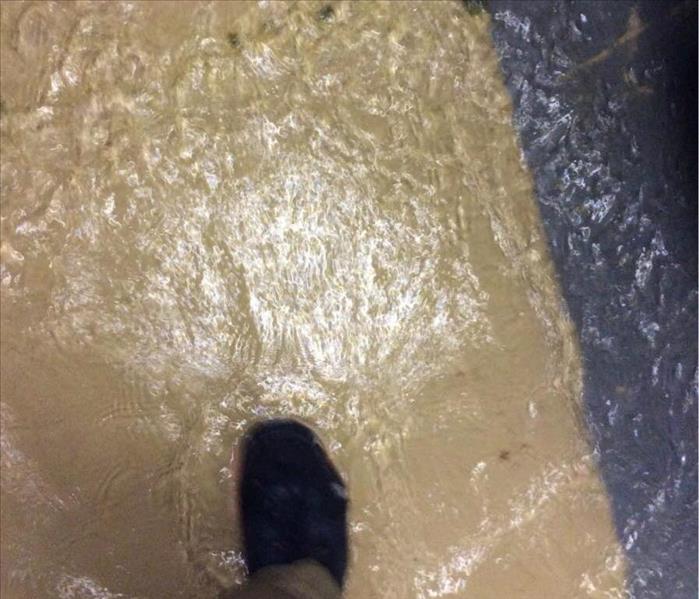 Preparing for a flood would have kept the contents of this home from being soaked and ultimately having to be discarded.
Preparing for a flood would have kept the contents of this home from being soaked and ultimately having to be discarded.
Knowing that flooding and storm damage is a potential threat, there are preventative steps you can take to minimize any future damage.
First, don’t forget to do your spring cleaning. Our homes, and especially our basements, can easily become cluttered with things we don’t even need. Better to clean them out once a year when the weather is nice. If flooding does happen, you’ll be glad that excess clutter is gone.
Second, get your belongings off the floor and up on shelves. Boxes piled up on the floor can quickly become an awful nightmare once water starts to rise. However, if your items are already sorted out on shelves above the water, it’s one less thing to have to deal with. For any low hanging shelves, metal and plastic are recommended rather than wood as they better survive potential water damage.
Finally, make sure you have enough ventilation and keep the air circulating. Potential mold growth will depend on a number of factors, including moisture level, temperature, and the presence of wood and paper materials on which they can feed. Running a dehumidifier can also help remove excess humidity from the affected environment.
If you do require professional water damage restoration services, the professionals at SERVPRO of Eatontown / Long Branch offer 24-hour emergency service. We’re a locally owned and operated company here in your community providing the highest caliber water inspection, extraction, drying, and restoration equipment and service. Call us now at (732) 784-4082.
A Wet Spring May Mean Mold Growth in your Home
5/10/2018 (Permalink)
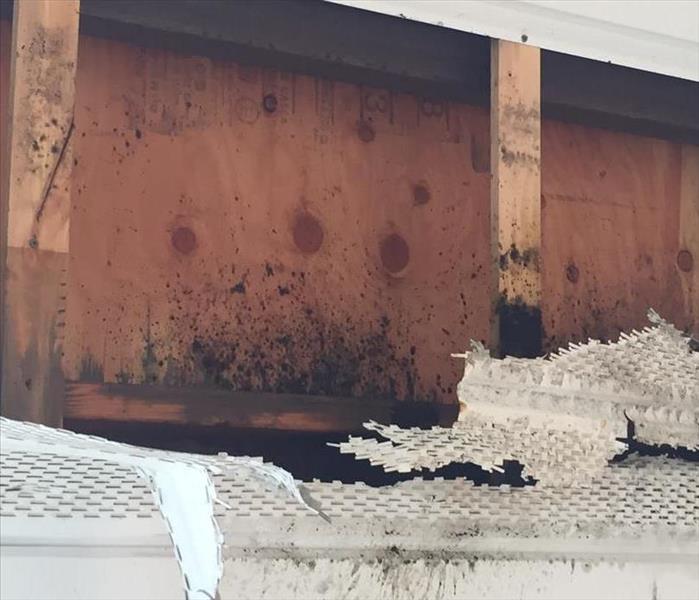 Mold can be found hidden anywhere.
Mold can be found hidden anywhere.
Springtime at the Jersey Shore is usually a month of wet, rainy weather followed by hot and humid temperatures. So it is important to be aware of the potential of mold growth in your home. Mold spores exist everywhere. Mold growth depends on certain conditions such as poor ventilation, moisture and air temperature. Every home has areas that have the potential for mold growth, so it is important to know where to look and what to look for. Places to look in your home that are susceptible to mold growth are areas that are constantly wet or humid such as:
- Bathrooms
- Kitchens
- Basements
- Windows/doors
- Crawl spaces
What you need to look for:- Discoloration on walls, carpets and floors
- Visible mold growth – black, white, red, orange, yellow, blue, violet, etc.
- Noticeable muster and/or dirt odor
Our technicians are IICRC certified and undergo weekly training. We screen all our employees with background checks so you can feel safe having us in your home. We follow EPA standards and our products are child/pet safe. If you find ANY mold in your home, it is always best to call a professional to take care of the issue. If you find you need our services, we are always open.
Mold in Schools
4/2/2018 (Permalink)
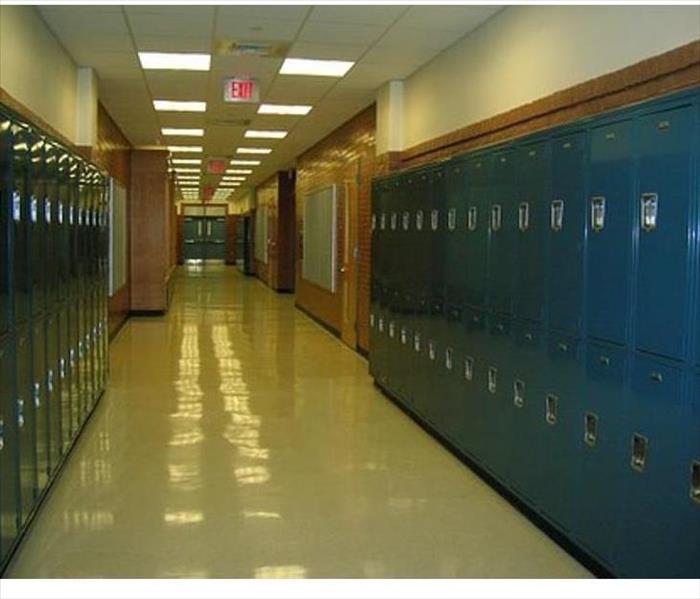 maintaining water leaks, moisture problems and poor air quality should be the main focus at any large facility.
maintaining water leaks, moisture problems and poor air quality should be the main focus at any large facility.
Mold growth in schools is not a new subject. In fact, just last year a large township in NJ was forced to close its schools for months due to mold contamination. That is why in any large facility like a school or commercial building, the importance of maintaining that facility to deter water leaks, moisture problems and poor air quality should be the main focus.
According to the Environmental Protection Agency, the key to mold control is moisture control. Solve moisture problems before they become mold problems!
Mold Prevention Tips
- Fix leaky plumbing and leaks in the building envelope as soon as possible.
- Watch for condensation and wet spots. Fix source(s) of moisture problem(s) as soon as possible.
- Prevent moisture due to condensation by increasing surface temperature or reducing the moisture level in air (humidity). To increase surface temperature, insulate or increase air circulation. To reduce the moisture level in air, repair leaks, increase ventilation (if outside air is cold and dry), or dehumidify (if outdoor air is warm and humid).
- Keep heating, ventilation and air conditioning (HVAC) drip pans clean, flowing properly and unobstructed.
- Vent moisture-generating appliances, such as dryers, to the outside where possible.
- Maintain low indoor humidity, below 60% relative humidity (RH), ideally 30-50%, if possible.
- Perform regular building/HVAC inspections and maintenance as scheduled.
- Clean and dry wet or damp spots within 48 hours.
- Don't let foundations stay wet. Provide drainage and slope the ground away from the foundation.
Potential health concerns are an important reason to prevent mold growth and to remediate/clean up any existing indoor mold growth.
According to the National Clearing House for Educational Services, the following symptoms may be caused by mold allergies:
- Nasal or sinus congestion
- Sensitivity to light
- Sneezing
- Sore throat
- Cough
- Skin irritation (rash or itching)
- Shortness of breath
- Headache
- Watery, reddened, or burning eyes
- Fatigue
Damp buildings and mold growth are recognized triggers of asthma attacks.
Obviously staying on top of moisture issues is the key to keeping mold under control.
Should your school or commercial building need mold remediation, remember that SERVPRO has specially trained technicians that can handle the job. No job is too large or small, and we are available 24/7.
For more information, check out these links:
https://www.epa.gov/mold/mold-remediation-schools-and-commercial-buildings-guide
http://www.ncef.org/pubs/mold.pdf
Groundwater Basement Flooding
3/29/2018 (Permalink)
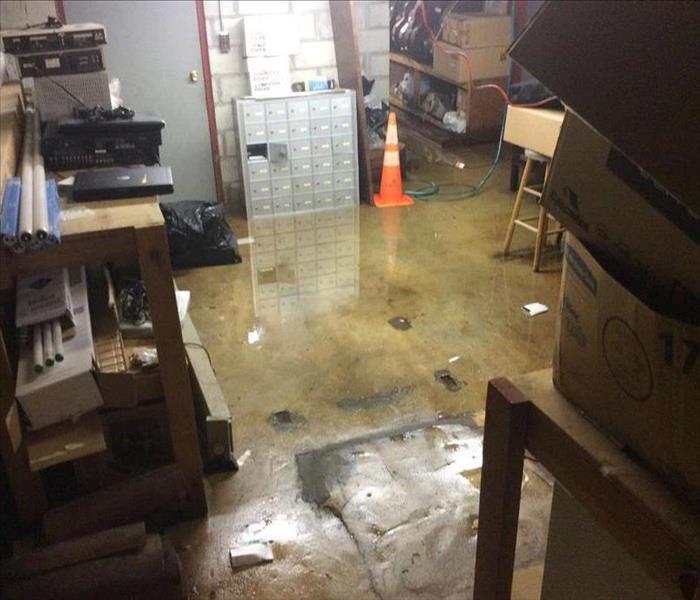 Water in a basement needs to be extracted and dried out as soon as possible.
Water in a basement needs to be extracted and dried out as soon as possible.
Groundwater flooding is basically water in your basement caused by seepage or flow through the walls or foundation floor.
According to State Farm Insurance, there are four common sources of water entering basements. Each source has its own specifics and requires its own course of action.
Surface water running down foundation walls.
If this is the first instance of water problems in your basement, the first thing to check for is surface water draining down next to the foundations. Water coming in at one location or only at the exterior foundation wall indicates surface water problems. Here are some things to look for once you get outside.
- Overflowing gutters: leaves
- Overflowing gutters: downspouts
- Downspout distance
- Pavement slope
- Sealant
- Landscape slope
- Irrigation
Groundwater in water-saturated soils being pushed into the basement by hydrostatic pressure.
If no surface water sources are found, then the source of the water is likely subsurface groundwater under hydrostatic pressure. When the groundwater levels outside the basement rise above the level of the floor, the basement acts like a boat in a pond. If a boat is sitting in water, water will leak in through any open cracks or holes. It works the same way with a basement. Hydrostatic pressure can push water through hairline cracks.
Unfortunately, subsurface groundwater problems are more difficult and more expensive to fix than surface groundwater problems.
Storm sewer water from the municipal storm sewer system backing up into the home's existing perimeter foundation drain and leaking into the basement.
If you have an older house within town and the house has a basement with no sump pump, it is likely the perimeter foundation drain system connects directly into the city storm sewer system. If the level of the basement is below the street level, there is the potential of storm water backing up in the city storm sewer system and being pushed into the perimeter foundation drain system. This can saturate the soils around the house at the basement level with storm water under hydrostatic pressure, causing water to leak in.
- Underground springs
- Storm water backing up
- Sewer water backing up
Sanitary sewer water from a clog in your home's sewer line. If there is a clog in the municipal sewer line, or the combined municipal storm/sanitary sewer system backing up into the home's drain system, it can cause sewer water to come up through sink drains and floor drains on lower levels.
Whatever the cause of water in your basement, remember it is important to have it dried out as soon as possible by a professional. SERVPRO of Eatontown/Long Branch is available 24/7, and will be able to get to your water damage quickly.
Smoke 101
3/27/2018 (Permalink)
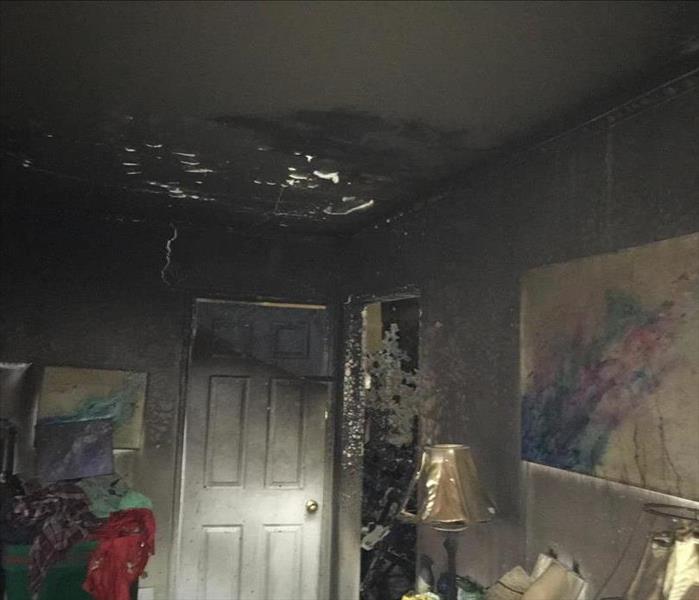 Fire leave smoke and soot damage throughout the home.
Fire leave smoke and soot damage throughout the home.
Smoke damage from a fire, no matter how large or small, can be devastating. Oftentimes smoke damage can be long lasting, which is why it is so important to take care of it immediately.
Behavior of Smoke
A fire loss can be very complex because of the unique behavior of smoke. SERVPRO® Franchise Professionals undergo extensive fire restoration training and certification, and understand the behavior of smoke.
- Hot smoke migrates to cooler areas.
- Smoke migrates to upper levels of a structure.
- Smoke flows around plumbing systems, using holes around pipes to go from floor to floor.
This enables us to take care of smoke throughout the entire home or office.
- Knowing how smoke penetrates and lingers is only one part of being able to mitigate smoke damage. Knowing what types of smoke will greatly affect the restoration process as well. Upon arriving at a fire scene, SERVPRO of Eatontown/Long Branch will test the smoke to see what type of fire has taken place.
Types of Smoke
- Wet smoke- Plastics and Synthetics
- Low heat, smoldering, pungent odor, sticky, smeary. Smoke webs are more difficult to clean.
- Dry smoke- Paper and Wood
- Fast burning, high temperatures, dry. Powdery, non-smeary residues. Heat rises therefore the smoke rises.
- Protein Fire Residue- Produced by evaporation of material rather than from a fire.
- Virtually invisible, discolors paints and varnishes, extreme pungent odor.
- Fuel Oil Soot- Furnace Puff Backs
- While “puff backs” can create havoc for property owners, SERVPRO® Franchise Professionals can, in most cases, restore the contents and structure quickly.
Other smoke related services we offer are:
Content Cleaning
- Smoke and soot residues and deposits can cause permanent damage to contents and may result in periodically resurfacing odors if not properly deodorized.
- All restorable contents in affected areas will be professionally cleaned and deodorized to preloss condition when possible. This includes area rugs, furniture, draperies, upholstery, electronics, clothing, photos, kitchen items, bedding and much more.
Deodorization
- SERVPRO® Franchises provide specialized services
that rid structures of offensive odors left by fire or smoke damage. We do not merely cover up lingering odors with a fragrance, we seek out the sources of the odor and remove them. - Proper deodorization is vital as odors may appear to be gone, only to reappear months later under different conditions, including when humidity levels rise.
It is important to understand why calling us in the event of a fire, no matter how large or small. The professionals at SERVPRO Eatontown/Long Branch will help get you back to your lives and jobs as soon as possible, making it “Like it never even happened.”
Where to Look For Moisture & Mold
3/26/2018 (Permalink)
 Hidden mold like this which was found when a bathroom sink was removed can spread and become a health problem.
Hidden mold like this which was found when a bathroom sink was removed can spread and become a health problem.
Mold growth depends on certain conditions for growth such as poor ventilation, moisture and air temperature. Every home has areas that have the potential for mold growth, so it is important to know where to look and what to look for.
The following is a list of places in your home that are susceptible to mold growth:
- Under sinks
- Behind washing equipment
- Under and behind refrigeration units
- Under dishwashers
- Behind toilets
- Behind and below water heaters
- Around tubs and showers
- Around doors and windows
- Around basement perimeters
- In crawl spaces
- Above ceiling tiles
- Around the outside hose bib
- Inside access panels to whirlpool tubs
What you need to look for:
- Discoloration on walls, carpets and floors
- Visible mild growth – black, white, red, orange, yellow, blue, violet, etc.
- Noticeable muster and/or dirt odor
If you do find any mold in your home, it is always best to call a professional to take care and remediate the issue. Mold spores are easily dispersed if incorrectly disturbed and most household cleaners won’t sufficiently take care of the problem.
SERVPRO of Eatontown/Long Branch is available 24/7/365 to help home and business owners take care of water, mold and fire disasters quickly and thoroughly.
In Like a Lion
3/14/2018 (Permalink)
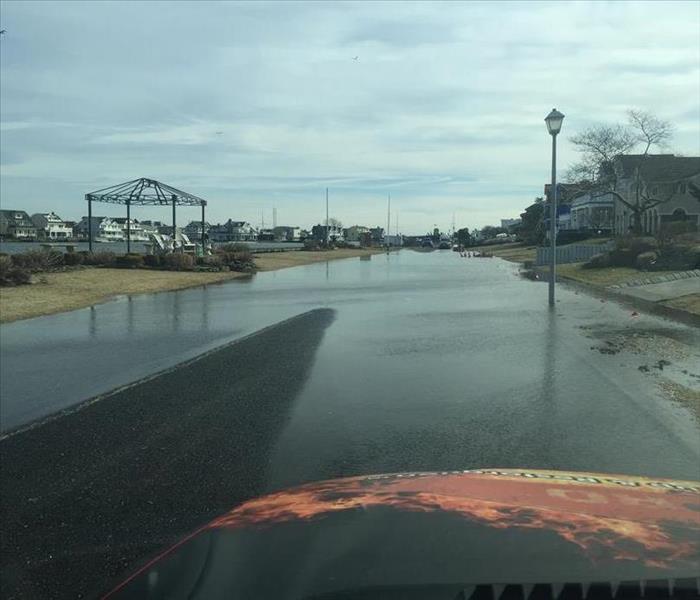 This road in Belmar saw flooding due to high tide surge. Homes facing the bay had water damage that had to be remediated.
This road in Belmar saw flooding due to high tide surge. Homes facing the bay had water damage that had to be remediated.
The beginning of March in New Jersey saw three major nor’easter storms, Riley, Quinn and Skylar, in less than two weeks. Winter Storm Riley was accompanied by a full moon, which resulted in flooding for many Jersey Shore towns. Many homes had flood damage or water damage caused by high winds and heavy rain and snow.
Just like March itself, it’s difficult to predict what can happen in any weather situation. The main rule of thumb is to always be prepared, but should something unforeseen occur, know that the experts at SERVPRO are equipped to handle any kind of disaster – from flood to fire and everything in between.
SERVPRO of Eatontown / Long Branch has experience restoring businesses and homes affected by storms and flooding. We can respond immediately with highly trained technicians who employ specialized equipment and techniques to restore your home or business back to pre-storm condition.
Ready To Sell? How To Prepare Your Home For A Sale
3/8/2018 (Permalink)
 Prepare your home to sell
Prepare your home to sell
Selling your home can seem stressful, but there are plenty of ways you can make the process easier on yourself. By following some simple steps, you can more easily attract a buyer and maybe even negotiate a better sale price.
Before you bring anyone in for a tour, you'll want to make sure everything is in its best condition possible. What it all comes down to is getting your home as close to move-in ready as you can and presenting its best face to prospective buyers. Here are a few ways you can be sure to wow any interested parties.
Tidy the landscaping and exterior
The first thing anyone will notice upon approaching your home is the landscape and the exterior. Making both look top notch is key to nailing your very first impression with the potential buyer.
Tidying up your lawn and shrubbery can go a long way to improving the overall look of the property, and you might even consider planting some flowers to bring a splash of life and color to your yard.
Be sure to wash your home if it needs it; power-washing the siding can go a long way to making the building look like new. Applying a fresh coat of paint to the entryway and laying down a welcome mat are nice finishing touches that will really make a prospective buyer feel like a guest.
The key is to make it feel homey and put together, so that a buyer can envision a simple transition from their old home to their new. This implied simplicity could be the difference between a sale or a walk.
Make any necessary repairs
Repairs are essential, as any savvy home buyer will be checking to ensure that everything is in working order. That means guaranteeing that there are no mold problems or other underlying damage that needs to be addressed.
If there are issues, tackle them before you invite prospective buyers to view the home. Consider contracting remediation services Like SERVPRO Eatontown/long Branch to deal with any mold, fire, or water damage that might have occurred over the years. Now is your chance to address these problems, before they chase off a prospective buyer.
Remove personal items and organize your space
It's important to downsize as much as possible ahead of time, packing away whatever personal items you can and only leaving those things in the living space that are absolutely essential to your day-to-day life, or those that give the buyer an idea of what the home looks like when furnished.
Buyers want to picture the space as theirs when searching for a new home, so make it as easy as possible on them by removing family photos, keepsakes, or any décor based on your identity and personality. Help them see themselves in your home, and closing a deal will likely become easier.
Provide a squeaky-clean interior
Finally, no buyer wants to imagine hours of hard work scrubbing the home they just bought with their hard-earned money. Providing a squeaky-clean interior will go a long way to closing the deal.
Selling your home takes a lot of time and energy, so consider partnering with a professional cleaning service like SERVPRO Eatontown/Long Branch to get the job done quickly and efficiently, without having to divert your focus from the many other tasks at hand.
Once everything is repaired, cleaned, and shaped up, it's time to bring in your leads. If you've crossed all your T's and dotted all your I's, odds are you'll get some immediate reactions and likely seal that deal sooner, rather than later.
Fire Dangers After a Flood
3/6/2018 (Permalink)
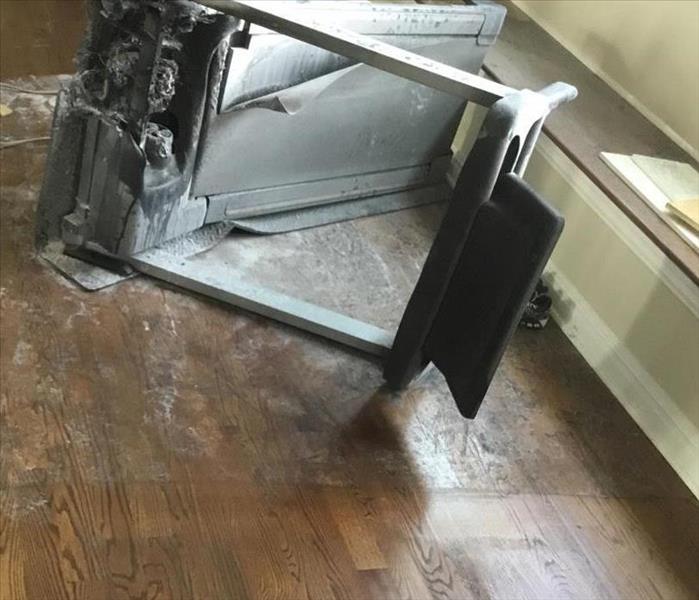 Electrical appliances such as this treadmill are in danger of catching fire after being submerged in flood water.
Electrical appliances such as this treadmill are in danger of catching fire after being submerged in flood water.
Fire is probably not the first thing you think of as the result of flooding, however it is a real concern and something every homeowner should be aware of.
It is well known that water and electricity DO NOT mix. It is important to remember that any electrical device that has been submerged in water could potentially be dangerous, as the wires may become compromised or corroded.
According to the Colorado Inspection Services, the rule of thumb for electrical devices that have been submerged is REPLACE them. The fire hazard from soaked electrical devices is not worth trying to save them.
As stated in their web site, outlets, switches and breaker boxes are the obvious electric devices that need replacement. Appliances, heaters, furnaces, AC units and anything else that contains electric motors, switches or wiring are included.
Flood waters may also contain mud and many toxic substances such as fuels, solvents, cleaning chemicals, industrial chemicals, sewage, fertilizers, pesticides, herbicides and other toxic compounds, that can deposit in these devices causing overheating and/or mechanical failure.
Controlling Moisture Deters Mold Growth
3/6/2018 (Permalink)
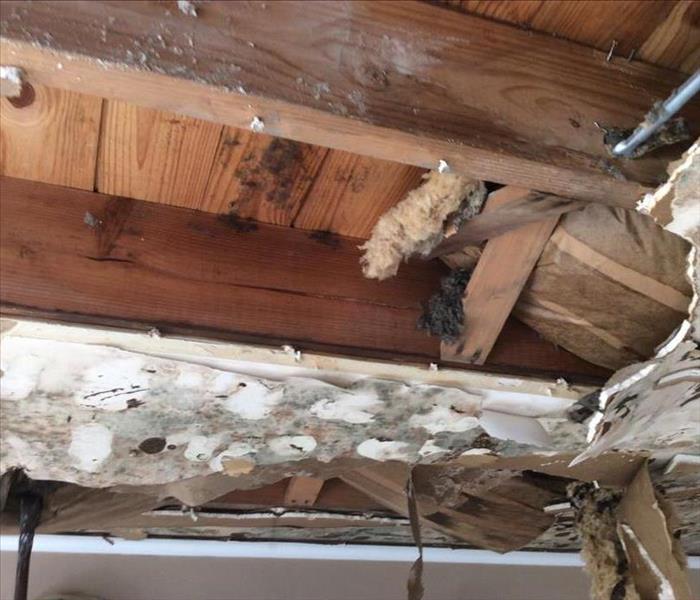 Mold growth in attics can be due to lack of moisture control and poor ventilation.
Mold growth in attics can be due to lack of moisture control and poor ventilation.
Water leaks, showers, cooking, all these things can add moisture to the air in your home. The amount of moisture the air in your home can hold depends upon the temperature. The warmer the air, the more moisture stays in the air. The lower the temperature, the less moisture is in the air.
At any temperature level, moisture can encourage biological pollutants to grow, which becomes the perfect habitat for mold growth.
So how do you begin to control moisture in your home? According to the EPA, the following steps can be taken to keep moisture – and subsequently mold – at bay:
Fix leaks and seepage. If water is entering the house from the outside, your options range from simple landscaping to extensive excavation and waterproofing.
Place a plastic cover over dirt in crawlspaces to prevent moisture from coming in from the ground. Be sure crawlspaces are well ventilated.
Use exhaust fans in bathrooms and kitchens. Make sure fans are vented to the outside, and not the attic.
Turn off certain appliances (such as humidifiers or kerosene heaters) if you notice moisture on windows and other surfaces.
Use dehumidifiers and air conditioners, especially in hot, humid climates.
Raise the temperature of cold surfaces where moisture condenses. Insulate storm windows and open doors between rooms to circulate warm air. Using fans and moving furniture away from wall corners can help increase air circulation.
Be careful of carpet on concrete floors. Carpet can absorb moisture and serve as a place for biological pollutants to grow. Use area rugs which can be taken up and washed often. In some climates it may be necessary to use a vapor barrier over the concrete.
While these tips may help control moisture in your home, it may not guarantee the complete prevention of mold growth. If you do suspect mold, have your home tested, and make sure a professional takes care of remediation safely and properly.
Be Prepared For Coastal Flooding
3/1/2018 (Permalink)
 The New Jersey coastline is particularly vulnerable to ocean storm surge.
The New Jersey coastline is particularly vulnerable to ocean storm surge.
The Jersey Shore is particularly vulnerable to coastal flooding during hurricanes and nor'easters. The safest step to take is to evacuate to higher ground.
However, if you must shelter in place, much of the evacuation protocol applies in moving valuables and furniture to a higher floor and removing loose items, but now you, your loved ones and any pets must move to a higher floor. What is paramount is creating the conditions to endure the next few days with increased discomfort, and accepting the limited availability of rescue and medical services.
Food:
- It is recommended to keep at least 3-days of food and water. Any food you keep should be non-perishable, such as canned and dry goods (e.g., soups, cereals, protein bars);
- It may be dangerous to use a gas stove, or you may not have access to a working gas or electric one, you can use the following alternatives:
- Camp stoves (outdoor use only)
- Charcoal grills (outdoor use only)
- If you have access to a refrigerator, be sparing in its use to help keep the cold circulating. If the temperature rises above 40°F, bacteria will thrive—rendering any refrigerated food inedible;
- Any food that has been left at room temperature for over two hours or has had contact with contaminated flood water should be discarded.
Water:
- Keep a fresh supply of bottled water of the commercial variety. If you need to use containers, use food-grade water storage containers. Avoid carbonated, caffeinated and alcoholic beverages as they will dehydrate you;
- If you run out or need to treat possibly contaminated water, boil it, chlorinate it, or use distillation methods before use.
Further tips and information can be found here.
Enduring and surviving a flood can be a harrowing experience. There’s much preparedness that is required for living in flood-prone areas. With the right information helpfully provided on Ready.gov and the FEMA sites, you can find strategies and tips, so you can direct your energies to help and comfort for your loved ones.
Once the flood waters subside, you know you can count on SERVPRO to assist with the cleanup and speed up the return to normalcy.
Hot Water Heaters: What to Know
2/22/2018 (Permalink)
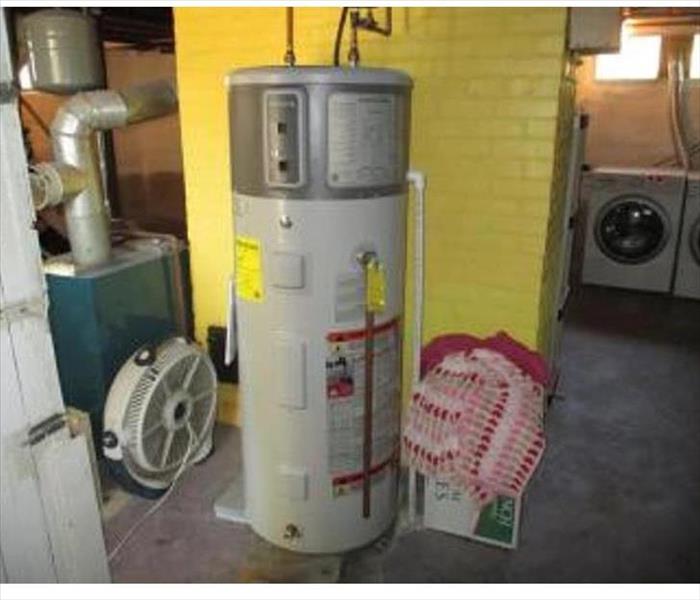 Homeowners should be aware of hot water heater maintenance and replacement.
Homeowners should be aware of hot water heater maintenance and replacement.
Water heaters are one of those appliances that you use frequently, but always seem to forget they’re around. Oftentimes homeowners are surprised in the middle of the night or after coming back from vacation to find water everywhere. A broken water heater can leave over 50+ gallons of water all over your house, depending on how big it is.
How can you tell if it’s time to change your water heater? There are definitely signs.
- On average, your gas hot water heater should last anywhere between 8 to 12 years, while an electric model will last a bit longer at 10 to 15 years. If your water heater is getting up in years, it may be time to replace it before it breaks.
- Tinted water coming from your hot water tap means there may be rust in your water heater, which is a possible indicator your hot water heater is showing signs of wear and may start to leak.
- Gurgling or popping noises coming from your water heater are caused by the buildup of hard water sediment heating up and exploding inside your water heater tank.
- Look around the base of your hot water heater for dampness. This may be a symptom of a slow or intermittent leak.
- If you have no hot water while using your hot water tap, it may be a sign that your water heater needs to be checked out.
- If you see a puddle around the base of your hot water heater, immediate action should be taken to replace it.
Remember, prevention and being prepared could save you thousands of dollars in the long run. But if you need us, the professionals of SERVPRO of Eatontown/Long Branch are available 24/7/365, and will have your home cleaned up and restored “Like it never even happened.”
More Than Remediation
2/9/2018 (Permalink)
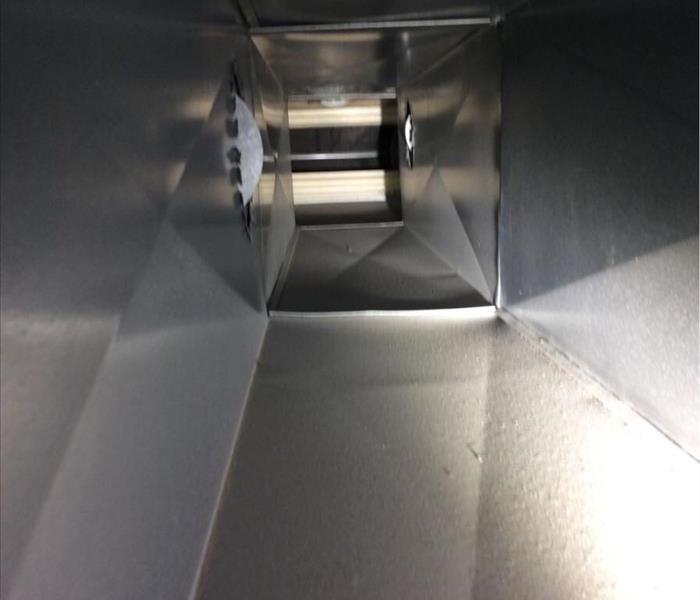 Clean air ducts are important for maintaining good air quality.
Clean air ducts are important for maintaining good air quality.
Did you know that SERVPRO of Eatontown/Long Branch offers more than water and fire cleanup and remediation? We offer a host of cleaning services for our commercial clients who don’t have time to worry about the common wear and tear that gradually soils their office. When grime, odor, and moisture challenges go beyond the scope of regular janitorial staff, can call SERVPRO of Eatontown / Long Branch for prompt service. Whether it’s removing an odor problem or deep cleaning flooring or carpets, our commercial clients can rely on us to make your workspace look its very best!
Among the services we offer our commercial clients are:
- Air Ducts and HVAC
- Biohazard and Sewage
- Trauma and Crime Scene
- Carpet and Upholstery
- Drapes and Blinds
- Ceilings, Walls, and Hard Floors
- Odor Removal and Deodorization
- Vandalism
Beware of the Flood
2/8/2018 (Permalink)
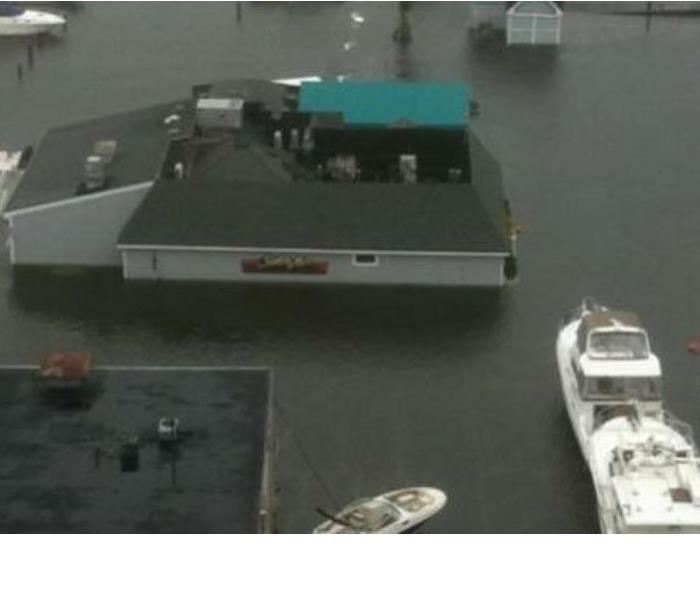 This restaurant in Monmouth Beach was almost submerged from a storm surge and tidal flooding during a hurricane.
This restaurant in Monmouth Beach was almost submerged from a storm surge and tidal flooding during a hurricane.
It's February, but we're not out of the woods yet as far as extreme weather is concerned! Living by the Jersey Shore, we should always be prepared for that next storm which could potentially bring severe coastal flooding.
We’ve all seen the footage and images from the most recent wave of deadly hurricanes, the destruction wrought by storm surges that fill residential streets. Wetter seasons are packed with more extreme weather events with sea rise, coastal erosion and other factors leading to flooding issues, even in places that haven’t experienced it since records began.
“Forewarned is forearmed” is the mindset to have if you live in a flood-prone region. As destructive as flooding can be, with some forethought, planning and the right information, you and your loved ones can endure the trials posed by the rising waters. What follows are some helpful tips and suggestions:
For Your Home
- Obtain Flood Insurance: It’s best to know with some research or asking a realtor before you move into a new home if it’s located in a flood zone. If so an early measure to take is to seek out a flood insurance policy that works for you. Having flood insurance will help cover the cost of any repairs once waters subsides. Flood insurance is available for renters and business owners as well and forms and information can be acquired through the National Flood Insurance Program;
- Elevate Your Property: It may be expensive at the outset to do so, but if flooding is frequent, you may want to consider elevating your entire home to lift it higher than historic flood lines. Frequent flooding requires frequent fixes so stockpile emergency building materials, such as wood, nails, etc.;
- Waterproofing: Another fix to consider is waterproofing your basement. You can find ready step-by-step fixes on most websites or purchase sealants to fill cracks and openings. You will also need to maintain your sump pump system and keep it operational. It may also be in your best interest to have a battery-operated sump pump if you lack a system or there is a power failure;
- Reduce Potential Debris: In anticipation of the flood and evacuation, move furniture and loose items to a higher floor to minimize debris.
If you do end up with water damage due to storm surge, extreme wind and rain or any other reason, make sure you contact the pros from SERVPRO Eatontown/Long Branch. They will be able to fix your home "Like it never even happened."
Winter is the Biggest Season for Home Fires
2/7/2018 (Permalink)
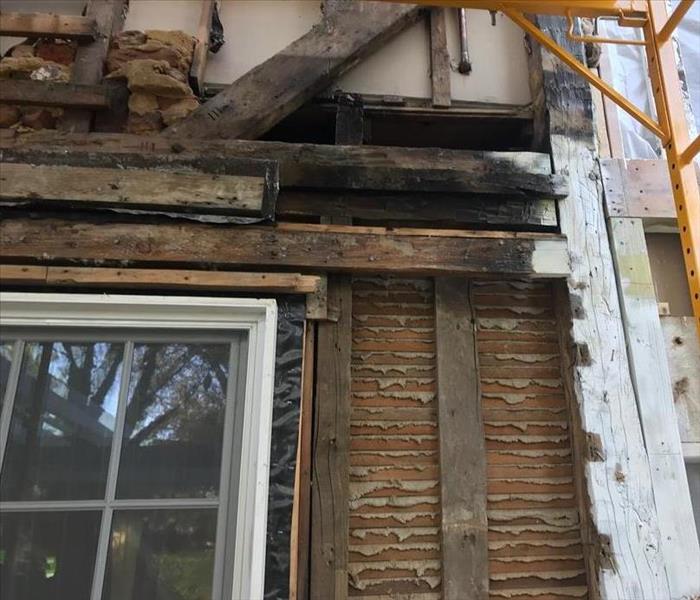 Home fires occur in winter more than any other season.
Home fires occur in winter more than any other season.
Did you know that, the threat of a home catching on fire is the greatest during the winter months? Half of ALL heating home fires occur during the months of December, January and February. One in Seven home fires is a result of malfunctioning or misused heating equipment.
There are several tips to keep your home safe while keeping warm during the winter.
- Have your fireplace, heating vents and dryer vents inspected and cleaned by a professional every year.
- If you use your fireplace, make sure you clean after every use. Dispose of ashes correctly by placing them in a metal can at least ten feet from the house.
- Keep anything that can burn at least three feet from any heat source like fireplaces, wood stoves, radiators, or space heaters
- Plug only one heat-producing appliance (such as a space heater) into an electrical outlet at a time.
- If portable generators are needed, keep them outside, away from windows and as far away as possible from your home. Make sure someone is home to supervise.
- Install and test carbon monoxide alarms at least once a month.
These are simple but effective steps to take to safeguard your home against fire. But should you ever need us, SERVPRO of Eatontown/Long Branch can clean fire, smoke and soot damage and make it “Like it never even happened.”
Why Bleach Isn’t an Effective Mold Remover
2/5/2018 (Permalink)
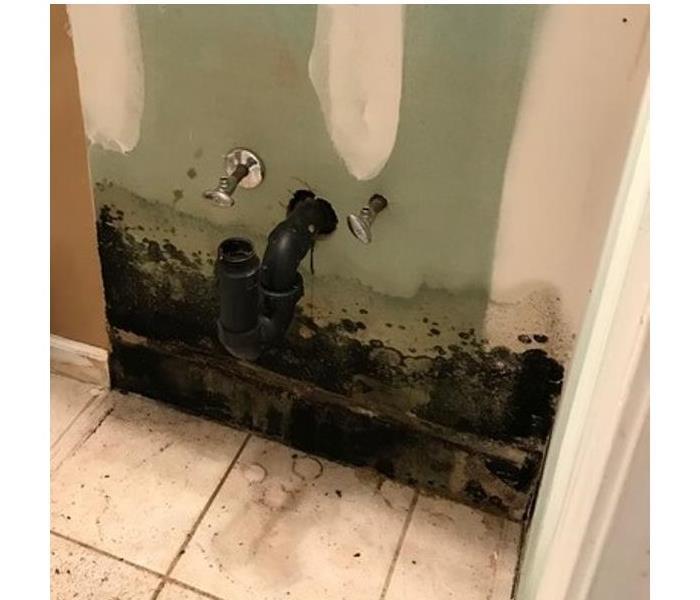 Mold can grow anywhere, but is most prevalent where there is leaking water, moisture and poor ventilation.
Mold can grow anywhere, but is most prevalent where there is leaking water, moisture and poor ventilation.
Most households have a bottle of chlorine bleach on hand that is designated for a host of uses such as cleaning, laundry or a disinfectant. This bleach is a combination of hypochlorite, chlorine and water.
As a disinfectant, chlorine bleach will kill many household molds, but not all of them. This is the reason that bleach is not recommended in removing mold from walls According to the Harvard School of Public Health, bleach will only kill 50% of mold growth on surfaces such as wallboard (sheet rock, plaster, etc.).
It can also be considered a dangerous substance if not used correctly.
This is why it is so important to leave mold remediation to professionals, who have the proper tools and products to remove mold. Attempting to remove mold yourself may result in mold spores being released and finding a foothold elsewhere in the home. Also cleaning agents will not effectively remove all the mold. In most cases anything affected such as the sheet rock, insulation, carpeting or carpet padding must be cut out and/or removed.
SERVPRO of Eatontown/Long Branch has certified and trained technicians who know how to properly clean and remove mold from your home safely and effectively. If you suspect you have a mold problem give us a call at 732-578-9888.
Mold Prevention is Your Best Defense
2/2/2018 (Permalink)
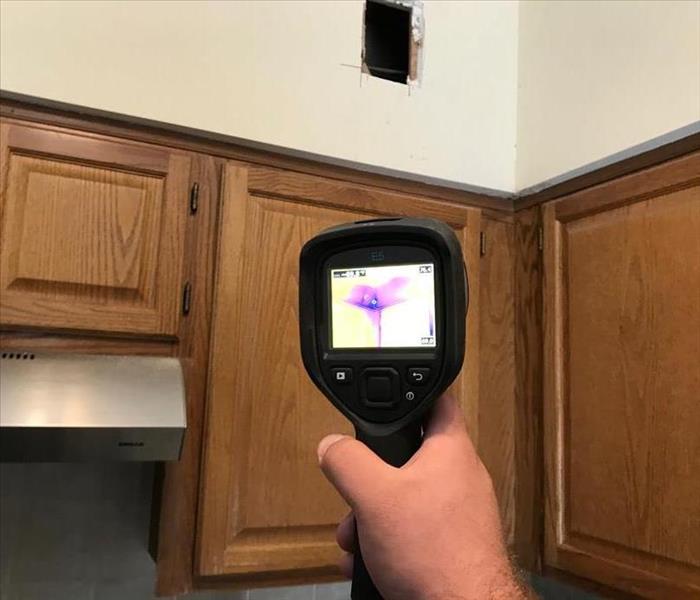 Hidden moister or water behind a wall can be detected by our infrared sensors.
Hidden moister or water behind a wall can be detected by our infrared sensors.
Mold thrives in dark, damp, warm environments. If you have (or have had) water damage, water leaks, a leaky roof, a washing machine that overflows frequently or a basement that takes on water, even occasionally, the resulting moisture can give mold a toehold for growth.
In some instances, it can be hard to see the water damage. SERVPRO professionals can use a moisture meter and infrared cameras and find moisture or water behind walls.
So what can you do to reduce your exposure to mold? Attack mold on two fronts – prevention and removal.
- Fix leaky plumbing or other sources of water. If you have mold in your crawl space or basement, locate the source and stop the water from coming in.
- Check inside drywall for mold inside the wall. You can usually smell mold even if you can't see it. Moldy drywall must be cut out and replaced. Moldy insulation also must be removed and replaced.
- Use fans and heaters to dry water-damaged areasand items (like carpeting) within 24 to 48 hours of flooding.
- Replace ceiling tiles or carpet that have become moldy (or smell like mold).
- Reduce indoor humidity by venting bathrooms, dryers, and other moisture-generating sources. Exhaust fans in bathrooms and kitchens can help. If you don’t have exhaust fans, crack a window in the kitchen when you're cooking or in the bathroom when you're bathing.
- Use air conditioners and dehumidifiers inside your home. Change filters regularly. Use a dehumidifier to get rid of dampness in basements.
- Add insulationto windows, piping, exterior walls, roof, or floors where there is potential for condensation on cold surfaces. Mold can grow even in winter months.
- Get your house tested for mold. A moisture meter test will help. Check with your state health department or find a local environmental testing company.
- If you find or smell mold anywhere in your home, DO NOT try removing mold yourself. Instead, call the professionals at SERVPRO of Eatontown/Long Branch to put a remediation plan in place.
Deep Freeze of 2018
1/22/2018 (Permalink)
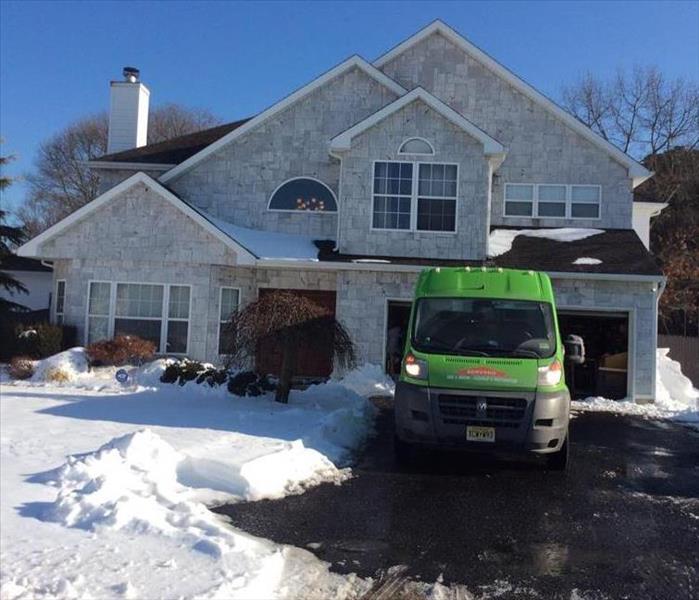 Temperatures below freezing for over ten days left many homeowners seeking help from SERVPRO Eatontown/Long Branch for broken pipes
Temperatures below freezing for over ten days left many homeowners seeking help from SERVPRO Eatontown/Long Branch for broken pipes
The Jersey Shore, along with the entire Northeast, suffered a deep freeze of below freezing temperatures for nearly two weeks, coupled with Winter Storm Grayson. This resulted in frozen and bursting water pipes in many homes, offices and schools throughout the region. Monmouth County was hit particularly hard as well from coastal flooding.
SERVPRO of Eatontown/Long Branch was on the scene, helping many homeowners and businesses by extracting water and drying basements, crawl spaces, floors and sheet rock.
To avoid future frozen and broken pipes during long-time freezing temperatures, it is easy to take the following steps:
Outdoors:
- Wrap outside faucets
- Caulk around pipes where they enter the house
- Disconnect garden hoses
- Drain in-ground sprinkler systems
Indoors:
- Let a stream of water run if the temperatures dip below freezing
- Open cupboard and vanity doors in the kitchen or bathroom
- Make sure thermostat is set to constant temperature
If, however, you do experience broken pipes, make sure you take quick action to have the water extracted and your home or business dried out properly. Call SERVPRO of Eatontown/Long Branch and we will make it “Like it never even happened.”
Commercial Structures need rapid remediation
1/18/2018 (Permalink)
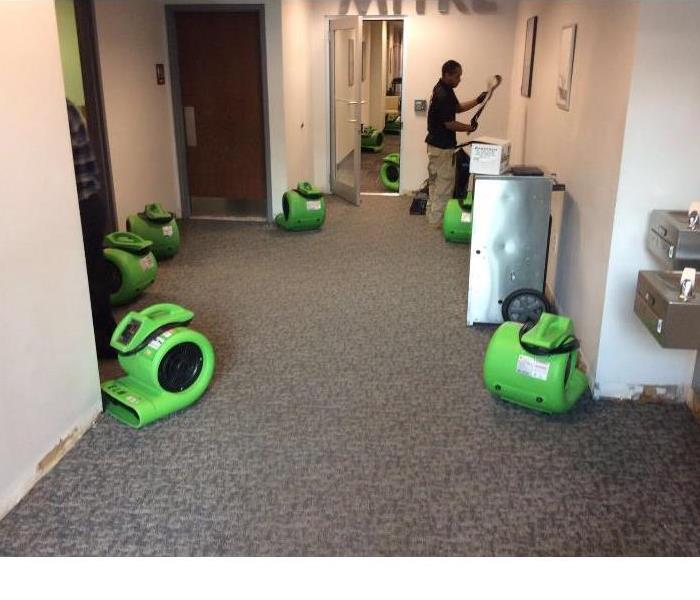 Broken water pipe completely soaked this office space in Eatontown, NJ
Broken water pipe completely soaked this office space in Eatontown, NJ
When a home experiences disruption due to water, mold or fire damage, it can be difficult to think things can get back to normal. The quicker a family can get back to normal life, the better everyone feels.
It is just as important to get commercial spaces up and running quickly. The longer the loss of time means the greater loss of business. At SERVPRO of Eatontown/Long Branch we strive to get businesses back in operation with as little interruption as possible. We make every effort to be quick and thorough, making sure that every detail has been taken care of and remediation is complete.
We are equipped to service the following, no space is too large or small:
- Office Buildings
- Apartment Buildings
- Restaurants
- Hotels/Motels
- Retail Stores
- Manufacturing & Industrial
- Government/Military
- Universities/Colleges
- Schools
Mold Growth in Winter
1/9/2018 (Permalink)
Most people think that you need humid, moist air in order for mold to take hold and grow. While this is true, many other factors need to be present for mold growth.
During cold winter months, when there seems to be little moisture in the air, mold will still grow in places where there is a sufficient source of food (dead organic matter) and the right temperature. This usually occurs in cold, uninsulated exterior windows and walls, including uninsulated closets along exterior walls, where building surfaces are generally cold relative to the indoor air temperature. Cold surfaces next to warm oftentimes results in condensation (moisture), which is necessary for mold growth. And while extreme cold, freezing, and heat can deactivate spores, it does not kill them.
In order to keep winter mold growth at bay, try to control humidity in crawl spaces, basements and uninsulated closets, insulate exterior doors and windows and remove any material that mold will grow on, such as paper, cardboard, wood and fabrics.
If you do suspect mold growth, make sure you call professionals such as SERVPRO of Eatontown/Long Branch to take care of the removal and mitigation.
Water Damage 101
12/29/2017 (Permalink)
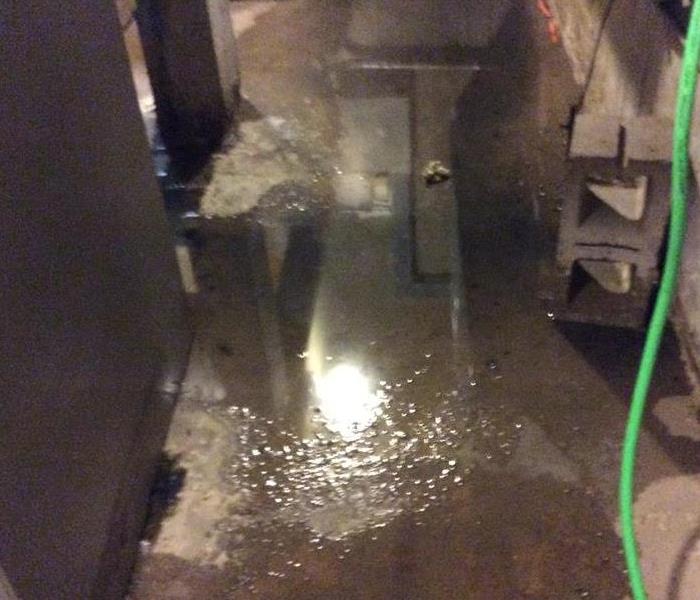 Standing water needs to be mitigated quickly before it has the chance to turn into blackwater.
Standing water needs to be mitigated quickly before it has the chance to turn into blackwater.
According to Wikipedia, wastewater is any water that has been affected by human use. But did you know that there are different grades of wastewater? Should your home be affected by water damage, it is imperative to act quickly to mitigate damage and prevent further damage such as mold growth.
CLEAN WATER
Floodwater that does not pose an immediate health threat is known as clean water. Clean water floods can result from malfunctioning appliances, toilet holding tanks, and melting snow and rainwater. Clean water home floods are generally safe for you to clean up yourself, but remember--time is an important factor. Standing clean water can become greywater if left untreated.
GREYWATER
Greywater refers to wastewater that is not contaminated with fecal matter. As far as household wastewater goes, greywater could include water from bathtubs and showers, appliances such as dishwashers, a weather event, an overflowing plumbing fixture or appliance or even a broken pipe.
When flooding occurs, it can saturate carpeting, furniture and drywall. If you experience a home flood with greywater, wear protective gear, and keep children and pets away from the flooded area. If the flood is extensive, such as several inches of water in the basement, it is advisable to hire professionals to safely clean up and decontaminate the area. Cleanup must begin as soon as possible as greywater can become blackwater if left untreated.
BLACKWATER
Blackwater is wastewater contaminated with human waste, flood water, or water contaminated with chemicals.
Blackwater floods are the most dangerous and the most destructive, and must be cleaned and mitigated immediately. Because of the unsanitary conditions of the water, items such as carpets, upholstery and drywall are often unsalvageable. Contact with blackwater can cause illness in both humans and pets.
Having water damage in your home is never a pleasant experience, and oftentimes it is destructive, and disruptive - affecting multiple rooms, floors, levels – of a home, office or multiple dwelling. Knowing whom to call and when could mean all the difference in keeping contamination and damage to a minimum.
Remember that you can call SERVPRO of Eatontown/Long Branch twenty-four hours a day, 365 days year. We will be there to survey and clean up your water damage quickly and get you back to your normal routine as quickly as possible.
Preparing for a Blizzard Part II
12/21/2017 (Permalink)
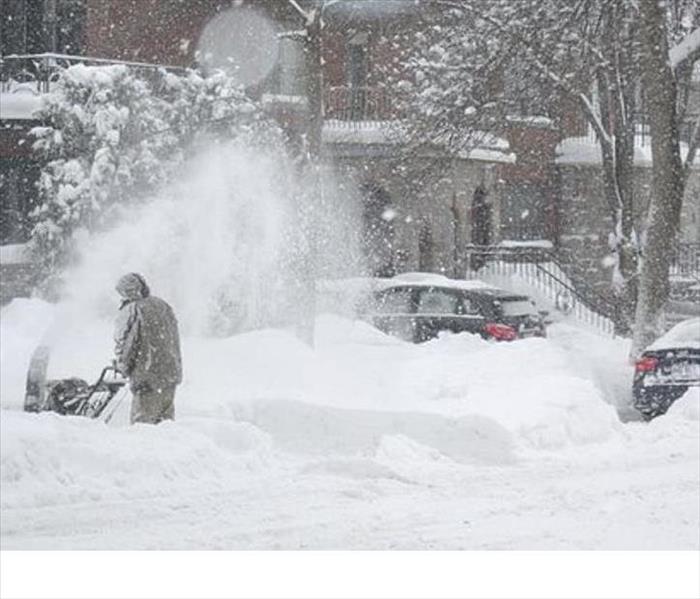 Make sure to be prepared way ahead of any storm.
Make sure to be prepared way ahead of any storm.
Now that you've winterized your home, you're ready to prepare for the unexpected. It's never too late to get everything you need before a storm.
Stock Up on Supplies
Every powerful storm brings a panic run on supermarkets and gas stations. Consider stocking up on the following to sustain you and your family over difficult days:
- Canned and Non-Perishable Food: Begin buying a few canned goods before the season with each trip to the supermarket as part of your regular shopping. Stocking up on soup, canned vegetables, dry pasta and other items gradually could create a substantial food source that could be useful during the winter months.
- Bottled Water: You should always keep a few extra gallons of water with some designated for drinking, others for non-consumption and set aside for washing up and cleaning, and even for first aid purposes.
- Battery-Operated Devices: A working supply of batteries can be the difference between staying illuminated and connected or stuck and ignorant in the dark. Keep an assortment of fresh batteries in different sizes for use in flashlights, radios, battery-operated charges and other useful equipment.
- Generators: Keeping a generator running requires diligent maintenance. Follow the manufacturer’s instructions (or find reliable tips online) and perform all necessary checks, change the oil and make sure you’re stocked with all the necessary equipment and fuel to keep it running. Store it outside of your house at a good distance, since generators emit carbon monoxide exhaust.
- Emergency & First-Aid Equipment: Keep your home first-aid kit fully stocked with fresh, clean bandages and non-expired topical applicants and gels. Fire extinguishers should also be full and inspections up-to-date.
Keep Your Car Storm-Ready
There could be that awful possibility of getting caught out on the highway in a terrible storm, only to discover that the highway has been closed and you are forced to shelter in place. Don’t let your motor idle, sapping battery life and fuel in an effort to keep warm. In addition to keeping a first-aid kit and jumper cables in your trunk, you may want to stow a shovel, scrapers and brushes to remove snow and dig out your car, or someone else who may need your assistance. You may also want to carry kitty litter or rock salt to free your car from slushy situations.
Here’s some other suggestions for keeping your car storm-ready:
- Snacks and water: have the foresight to keep snacks on hand, such as trail mix, nuts or anything else with a long shelf life, as well as a fresh bottle of water.
- Keeping warm: That sleeping bag that accompanied you on summer overnight trips could come in handy should you find you have to stay the night before the ploughs can clear the highway. Also a set of dry clothes (jeans, sweaters, shirt, socks and maybe even extra boots) to change into if what you’re wearing manages to get soggy.
- “Go Bags”: It may be a sound decision to have on hand in your car or home, packed and ready for emergencies, a “go bag” (aka, “bug-out bag”). The Get Ready campaign, an emergency preparedness campaign sponsored by the U.S. government, has a site where you can learn the basic contents: a set of clothes for extended stays, some money, first aid material, and anything else needed should there be a call to evacuate.
Keep Activity to Confined to Only a Few Rooms
It will prove important to reduce the amount of area that your family uses to retain heat. Designate areas such as the living room, the kitchen and a bathroom for habitation and to keep warm. Close off all other rooms—especially if they aren’t well insulated. If you keep enough people to only a few rooms, body heat and the heat given off by heaters and will last much longer, especially if the power goes out.
If you want more information regarding preparation for blizzards and nor’easters and the challenges these storms present, information can be easily obtained via material posted on the Red Cross and FEMA websites. Both proved helpful in compiling the tips and pointers mentioned in this article. Should you need help with cleanup and disposal in the aftermath, you can always count on SERVPRO of Eatontown/Long Branch to provide ready assistance.
Don't let a Blizzard Catch You Off Guard
12/18/2017 (Permalink)
 Excess snow from a blizzard can create a host of problems if your home is not prepared.
Excess snow from a blizzard can create a host of problems if your home is not prepared.
Snowmageddon! Snowpocalypse!
You can call it anything you want, but when the wind and snow come roaring through: a blizzard is a blizzard! With heavy snowfall and hurricane-force gusts hurling drifts in every direction, a blizzard will render roads impassable, down power lines and bring life to a standstill.
With the right precautions in place, you may be able to ride out the storm with your home and your family’s safety intact. Your main tasks during such a trial are to be prepared, stay warm and dry and stay safe.
Winterize Your Home
If there’s an evacuation order it’s best to take heed, especially if there’s a danger of coastal flooding or impassable roads cutting you off from vital care. If by choice or circumstance you find you are riding out the storm at home, it’s important to make sure your home is well-insulated and that any gaps and cracks around windows and doors are sealed.
These following precautions can be very helpful in the run-up to any winter storm or freezing condition:
- Exposed water pipes should be wrapped with newspapers or a plastic wrap, and faucets should be turned on to allow a trickle to come through to prevent freezing and pipes bursting.
- Leaking roofs need to be patched or re-freezing precipitation could widen gaps and bring in more water and cold.
- Clogged gutters should be cleared of fallen leaves and twigs to let liquid flow and not get a chance to freeze so gutters weigh down.
Dress for the Storm
To preserve body heat indoors and out, it’s best to layer up. If there is a reason to go out and brave the weather, or you’re feeling snug at home while the wind is roaring outside, you should still dress for reduced temperatures and stormy conditions.
Outside Apparel: If you must be outside, you must keep warm and dry. Cover yourself from scalp to sole with a hat, a scarf and a water-repellent outer layer. Use mittens instead of gloves because keeping your fingers close together helps with insulation.
Inside apparel: Even in the comfort of your own home, you should add an extra, secondary layer—especially if and when the power goes out. For the duration of the storm and the cold days and nights afterward, you will want to retain as much heat as you give off.
By making sure your house is prepared, you can save yourself the expense and headache of broken pipes and water damage. But if you DO need storm cleanup, you know you can turn to SERVPRO of Eatontown/Long Branch!
Christmas Tree Safety
11/29/2017 (Permalink)
 Christmas trees are a wonderful holiday decoration, but it is important to remember to keep them at least 3 ft away from any heat source.
Christmas trees are a wonderful holiday decoration, but it is important to remember to keep them at least 3 ft away from any heat source.
Christmas trees are an integral part of decorating for the holidays. They are beautiful to look at, have that wonderful aroma that permeates the house, and lend a festive atmosphere in the home. But if not properly taken care of and set up correctly, they could pose a dangerous fire hazard.
According to the National Fire Protection Association, the statistics are alarming:
- From 2011-2015, U.S. fire departments responded to an estimated average of 200 home1structure fires per year that began with Christmas trees.
- Christmas tree fires caused an annual average of $14.8 million in direct property damage.
- Four of every five Christmas tree fires occurred in December or January.
- In one-quarter (26%) of the Christmas tree fires, some type of heat source, such as a candle or equipment, was too close to the tree.
With proper planning and common sense, Christmas tree fires can easily be avoided. Here are some tips to remember when bringing home fresh cut trees:
- When choosing a tree, look for one that is fresh and with needles that don’t fall off easily.
- Before placing the tree in the stand, cut 2" from the base of the trunk.
- Make sure the tree is at least three feet away from any heat source, like fireplaces, radiators, candles, heat vents or lights.
- Make sure the tree is not blocking an exit.
- Add water to the tree stand. Be sure to add water daily.
It is important to remember that your holiday lights need to be used safely as well. The lights you use to decorate your tree or your house need to be in good shape:
- Make sure there are no frayed ends or wires showing.
- Make sure the lights are specifically meant for either indoor or outdoor use.
- Replace any string of lights with worn or broken cords or loose bulb connections. Read manufacturer's instructions for number of light strands to connect.
- Never use lit candles to decorate the tree.
- Always turn off Christmas tree lights before leaving home or going to bed.
We at SERVPRO of Eatontown/Long Branch hope all our friends, family and customers have a very happy, healthy and SAFE holiday season!
SERVPRO of Eatontown/Long Branch is available 24/7/365
11/27/2017 (Permalink)
 SERVPRO of Eatontown/Long Branch is always available, no matter what time of day or night.
SERVPRO of Eatontown/Long Branch is always available, no matter what time of day or night.
Nobody can predict when a water heater will burst, a pipe will break, or your stove will catch fire while you’re cooking. That is why SERVPRO of Eatontown/Long Branch is always available, twenty-four hours a day, seven days a week.
Within minutes, water will quickly spread, saturating everything in its path. Water is absorbed into walls, floors, upholstery, and belongings. Within the first 24 hours drywall begins to swell and break down, metal surfaces begin to tarnish and furniture begins to swell and crack. The earlier SERVPRO can get to the scene, the faster water can be extracted from the area and the important step of drying and mitigation can begin.
Fire and smoke is especially destructive. Not only does the structure suffer physical damage, smoke and soot can creep into tiny spaces and settle there, leaving a lingering odor and settling in air ducts, furniture, clothes, and crevices. In many instances property will also suffer from water damage from firefighting efforts.
Immediate response can mean all the difference in further issues .If you wait too long, there is the possibility of the appearance of mold and mildew, wood flooring begins to swell and warp or metal and paint being affected. The longer an area remains unmitigated, restoration time and cost increase dramatically; replacing contaminated materials and structural rebuilding may be extensive.
So remember that SERVPRO of Eatontown/Long Branch is available day or night, we are always on call, and we’re here to help.
Holiday Safety Tips
11/20/2017 (Permalink)
 Lit candles are beautiful, but be careful about where you place them. Keep them away from flammable materials and out of reach of children and pets.
Lit candles are beautiful, but be careful about where you place them. Keep them away from flammable materials and out of reach of children and pets.
It’s that time of year - the holiday season- when most people are busy getting their homes ready for large family dinners, guests and celebrations.
With all that goes behind getting your house in perfect holiday order, it’s easy to get distracted and forget about safety.
Here are some tips to remember while you decorate and cook that perfect holiday meal!
Fires
Cooking is the No. 1 home fire hazard, according to the NFPA.
- Always stay in the kitchen when cooking, and always keep an eye on the stove, oven or grill.
- Be careful of smoking oil – that is a sign that the oil is too hot and may ignite. Lower the flame or remove the pan from the heat.
- Never try to put out a pan fire with water. Baking soda works to extinguish a pan fire.
- It is now New Jersey law that every home must have a fire extinguisher within 10 feet of the kitchen area,
- Keep oven mitts, dish towels and other flammable items away from heating elements and open flames.
Candles are a popular decoration, however it is important to follow these simple rules:
- Keep an eye on candles, and never place them near fabrics such as curtains, wall hangings or flammable decorations.
- If you have small children or a pet, make sure the candles are placed out of reach.
- Be sure to extinguish candles before going to bed or leaving the house.
Fireplaces are also a safety concern:
- Have your chimney cleaned annually.
- After a fire, dispose of ashes in a metal container, away from flammable material.
- Keep children at least three feet away from fireplaces.
Lighting
Holiday lighting poses the risk of overdrawing power and creating a fire hazard, and older strands are more likely to overheat because they require more electricity.
- Inspect your lights before hanging them. If they look worn (frayed wires, loose or cracked bulbs), don’t hesitate to replace them. Switch to LEDs, which are more energy-efficient and burn coolerthan conventional incandescents.
- If you’re stringing lights outside, make sure they are for outdoor use.
- Do not attach more than three strings of lights together.
- Always unplug your lights and decorations before going to bed or leaving the house.
Christmas trees
We wish the best, brightest and safest holiday season for all our SERVPRO friends and families.
SERVPRO of Eatontown/Long Branch Offers Opportunity to Use Green Products
11/14/2017 (Permalink)
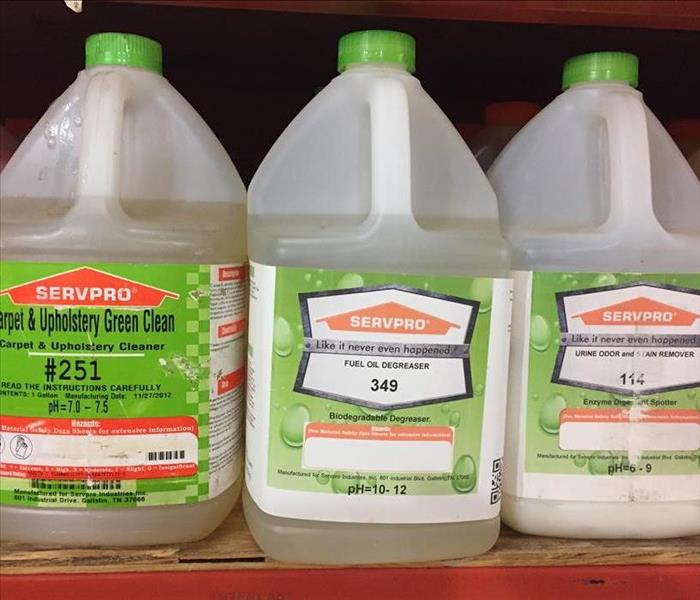 These are just some of the green cleaning products we use that are specially manufactured exclusively for and by SERVPRO.
These are just some of the green cleaning products we use that are specially manufactured exclusively for and by SERVPRO.
Cleaning up after a disaster is a messy job, which oftentimes calls for specialized cleaning products. Many of the products we use at SERVPRO are our own unique formulas that are manufactured in our headquarters in Gallatin, TN.
At SERVPRO we care what we use and how it affects our environment and the safety of our customers. We understand that sometimes families with children and pets prefer all natural products. For this reason we offer the opportunity to use Green products when available and appropriate. There are some jobs, however, that require the use of different products.
Our green products are awarded the “Green Seal” and are registered with the EPA. They do not contain any solvents, phosphates, dyes or fragrances, and are safe and non-toxic.
Opportunities for using our own label Green products are when we do carpet & upholstery cleaning, or need a urine odor and stain remover, all surface cleaner, glass cleaner and fuel oil degreaser.
Other green products we use for disinfecting, mold clean-up and prevention and mold stain removal contain no chlorines, ammonias or other harsh chemicals, are hypo-allergenic, and food-grade non-toxic.
We hope that as soon as a customer calls SERVPRO of Eatontown / Long Branch and we enter their home, they can rest assured that their remediation job will be done as quickly as possible in a safe and effective way.
Will You be Ready for a Disaster?
11/10/2017 (Permalink)
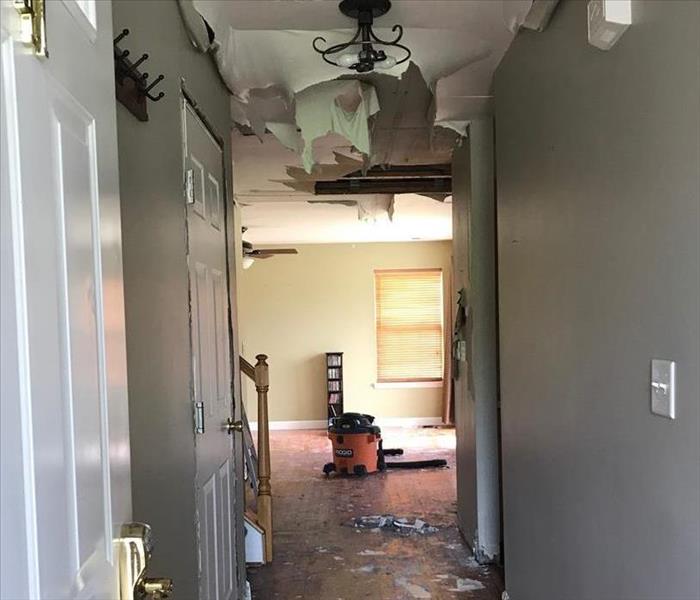 Water leaking from the upstairs completely destroyed the sheet rock ceiling on the lower floor.
Water leaking from the upstairs completely destroyed the sheet rock ceiling on the lower floor.
Disasters like water damage, fire damage or flood, no matter how big or small, can never be predicted. But you CAN prepare for them!
The best way to reduce business interruption following a disaster is to plan for it NOW. Preparation is a key component for making it through any size disaster, no matter how big or small.
According to the latest industry research, 50% of all businesses never recover after a disaster. Of the businesses that do open, approximately 75% of those businesses had a plan in place.
One of our most effective tools in helping customers in the event of an emergency is the ERP, or Emergency Ready Profile. This profile provides all the critical information needed in emergency situations, and minimizes business interruption.
The main reason to have an ERP done for your facility or home is:
- It provides a concise Profile Document that contains only the critical information needed in the event of an emergency.
- It is a guide to help you get back into your building following a disaster.
- It is an identification of the line of command for authorizing work to begin.
- It provides facility details such as shut-off valve locations, priority areas and priority contact information.
This invaluable service is offered at no cost to our customers, and leaves them with peace of mind that their home or office will be ready for whatever happens.
This service can also be done for residential properties, so homeowners can rest assured they have the information at hand when a disaster strikes.
Be prepared! Call SERVPRO of Eatontown/Long Branch to schedule your Emergency Ready Profile and rest easily in knowing that we will be faster to your disaster!
Avoiding Winter Water Damage
11/9/2017 (Permalink)
 The water that flowed out of this window and froze was caused by an unprotected pipe that burst.
The water that flowed out of this window and froze was caused by an unprotected pipe that burst.
In Monmouth County, cold winter weather can usually come at us in a snap after a warmer, summer-like autumn. Because water expands when it freezes, pipes are especially susceptible to crack and burst from the resulting excess pressure.
That is why it is so important to make sure that you take the steps to prepare your house – especially your pipes, for the freezing temperatures.
Following are tips to get your house ready:
OUTDOORS:
- Wrap outside faucets.
- Caulk around pipes where they enter the house.
- Disconnect garden hoses.
- Drain in-ground sprinkler systems.
INDOORS:
- Let a stream of water run if the temperatures dip below freezing.
- Open cupboard and vanity doors in the kitchen or bathroom.
- Keep the thermostat set to the same temperature both during the day and at night. By temporarily suspending the use of lower nighttime temperatures, you may incur a higher heating bill, but you can prevent a much more costly repair job if pipes freeze and burst.
- Shut off and drain your water system if you are leaving the home for several days or more, and set your thermostat a temperature no lower than 55° F.
IF YOU DO COME HOME TO FROZEN PIPES, THESE TIPS CAN HELP YOU
- If you turn on a faucet and only a trickle comes out, suspect a frozen pipe. Likely places for frozen pipes include against exterior walls or where your water service enters your home through the foundation.
- Keep the faucet open. As you treat the frozen pipe and the frozen area begins to melt, water will begin to flow through the frozen area. Running water through the pipe will help melt ice in the pipe.
- Apply heat to the section of pipe using an electric heating pad wrapped around the pipe, an electric hair dryer, a portable space heater (kept away from flammable materials), or by wrapping pipes with towels soaked in hot water. Do not use a blowtorch, kerosene or propane heater, charcoal stove, or other open flame device.
- Apply heat until full water pressure is restored. If you are unable to locate the frozen area, if the frozen area is not accessible, or if you cannot thaw the pipe, call a licensed plumber.
- Check all other faucets in your home to find out if you have additional frozen pipes. If one pipe freezes, others may freeze, too.
Should you ever have a problem with water due to bursting pipes or any other reason, calling SERVPRO of Eatontown/Long Branch will get your home back to normal “Like it never even happened.”
SERVPRO of Eatontown/Long Branch Cares About Our Environment
10/26/2017 (Permalink)
 Pier Village Beach, Long Branch
Pier Village Beach, Long Branch
October Beach Sweep a Success!
On October 21, 2017, SERVPRO of Eatontown/Long Branch participated in the Clean Ocean Action Beach Sweep, which was conducted all over New Jersey, from Raritan Bay to the Bayshore to Cape May We captained the site at Pier Village in Long Branch, where close to 50 volunteers spent their time combing the beach for garbage. In all, over 5,500 pieces of debris were collected and thrown away or recycled! Last year a total of nearly 220,000 pieces of debris were removed statewide from the shore lines!
Volunteers began arriving at 9 a.m. and combed the beach until 12:30 p.m. Although the beaches “looked” clean, the amount of debris that was found was surprising. Among typical items such as straws, candy wrappers, plastic bottle caps and cigarette butts, unusual items such as a melted beverage cooler, large plywood and metal pole were also found.
It is always important to be mindful of our environment, and how what we do affects more than just our immediate surroundings. We are very proud of our beaches, and we should make the effort to keep them clean all year long!
Is Your House Safe?
10/24/2017 (Permalink)
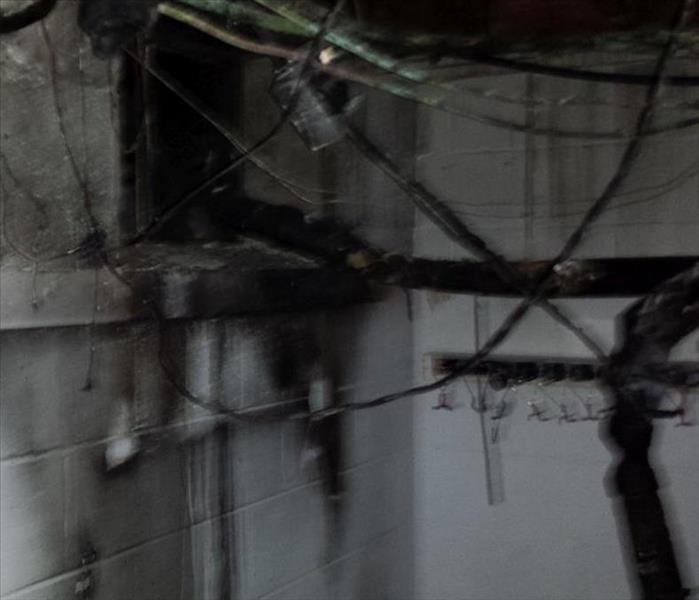 Basement wall where dryer caught fire.
Basement wall where dryer caught fire.
How safe is your home? Have you done the proper maintenance needed to minimize your family’s risk of fires? Now is the time for you to prepare your home against risks that are easily avoidable.
According to the National Fire Protection Association, 2015 saw nearly 370,000 home fires nationwide, at a cost of 7 billion dollars in damages. Ninety-two percent of the appliance fires were caused by the clothes dryer. Thirty-two percent of those fires were due to lack of cleaning.
Here are some dryer safety tips:
- Have your dryer installed and serviced by a professional.
- Do not use the dryer without a lint filter.
- Make sure you clean the lint filter before or after each load of laundry. Remove lint that has collected around the drum.
- Rigid or flexible metal venting material should be used to sustain proper air flow and drying time.
- Make sure the air exhaust vent pipe is not restricted and the outdoor vent flap will open when the dryer is operating. Once a year, or more often if you notice that it is taking longer than normal for your clothes to dry, clean lint out of the vent pipe or have a dryer lint removal service do it for you.
- Keep dryers in good working order. Gas dryers should be inspected by a professional to make sure that the gas line and connection are intact and free of leaks.
- Make sure the right plug and outlet are used and that the machine is connected properly.
- Follow the manufacturer’s operating instructions and don’t overload your dryer.
- Turn the dryer off if you leave home or when you go to bed.
As scary as the statistics for dryer fires sound, they aren't close to being the number one cause of home fires. Two out of every five home fires started in the kitchen, Cooking and cooking equipment account for over 60% of all home fires. They also account for 42% of all fire related injuries in the home.
The peak month of the year for these kitchen related fires is January, the peak time being between 5-8 p.m. Unattended cooking was by far the leading cause of these fires.
What you need to know:
- Be on alert! If you are sleepy or have consumed alcohol don’t use the stove or stovetop.
- Stay in the kitchen while you are frying, grilling, boiling or broiling food.
- If you are simmering, baking or roasting food, check it regularly, remain in the kitchen while food is cooking, and use a timer to remind you that you are cooking.
- Keep anything that can catch fire — oven mitts, wooden utensils, food packaging, towels or curtains — away from your stovetop.
It all amounts to common sense and being mindful.
This short video has more safety information:
https://www.youtube.com/watch?v=Dm6UMPP2z8I
Water Restoration: 5 Ways to Deal with Water Damage
10/13/2017 (Permalink)
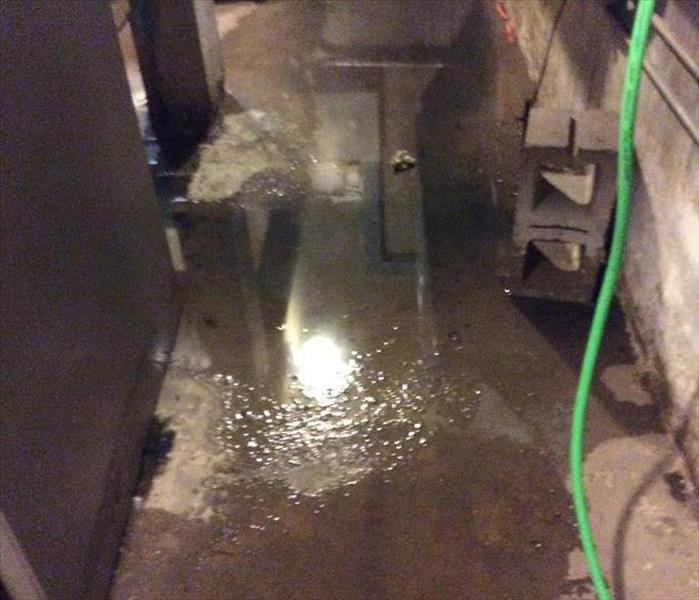 Standing water can create issues from water flow obstruction to mold.
Standing water can create issues from water flow obstruction to mold.
As a homeowner, water damage is always a cause for concern. When water damage does strike, it’s important to know how to handle the situation with efficiency and ease. Effective water damage restoration comes with knowing that the situation is urgent and calling the professionals immediately, however, there are a few things each and every homeowner can do to minimize the damage.
Prevent It
The best path towards successful water damage restoration is to not have to restore anything at all. One of the most beneficial things a homeowner can do is be informed. In short, know your home!
- Know where your water main valve switch is located. This is really important. Don’t be afraid to shut it off when you go away for long periods of time.
- During the winter, disconnect your hoses. This prevents standing water from forming and creating an issue where your water flow becomes obstructed. Bursting pipes are no fun!
- Maintain the hoses in your home. From the washing machine to under the sink, make sure you upgrade your hoses regularly to avoid leaks.
- Measure your water pressure. Hoses and pipes can only handle so much and checking the pressure that is running through them can save you a huge headache. You can buy a pressure gauge at Home Depot or Lowes that will do the trick.
Safety First
Any disaster, small or large, comes with the risk of safety. First, make sure everyone is safe and while cleaning up the damage wear gloves, waterproof footwear, and protective gear. Additionally, be mindful of mold and bacteria, exposure to them can be very unhealthy.
Create Airflow
SERVPRO’s professionals understand how important it is to create airflow in a water damage emergency and their team is second-to-none when it comes to water cleanup and restoration. As a homeowner, we recommend utilizing any fans or dehumidifiers you have in your home until the pros arrive. This helps prevent bacteria and microbial growth from forming.
Smart Storage
One of the smartest preventative measures you can take is to keep a close eye on how you store your belongings and items within your home. Items and boxes stored at floor level are a target for damage, should a water emergency occur. Utilizing plastic or metal shelves for storage can prevent your items from taking on water damage. Avoid wood and particleboard if possible.
Plastic storage bins can provide an excellent way to store items as well. And even better, they’re cheap! Make sure the tops are secure and store them a few feet off the ground.
Isolate the Damage
If disaster does strike, you will want to remove the affected items right away. Separate water-logged items and place them in an area where they can dry. This will allow you the ability to move around the water-filled area with ease and create airflow that can help reduce water damage quickly.
Call the Pros
Dealing with water restoration and damage can be incredibly time consuming and frustrating. We suggest you call the professionals immediately so they can guide you through the process. The SERVPRO team is experienced and knowledgeable and will be able to get you back on track in no time. We are here to serve you!
If you need to reach us feel free to contact us through our site form or call us at (732) 858-5416.
Winning the War Against Wind and Water During the Colder Months
9/25/2017 (Permalink)
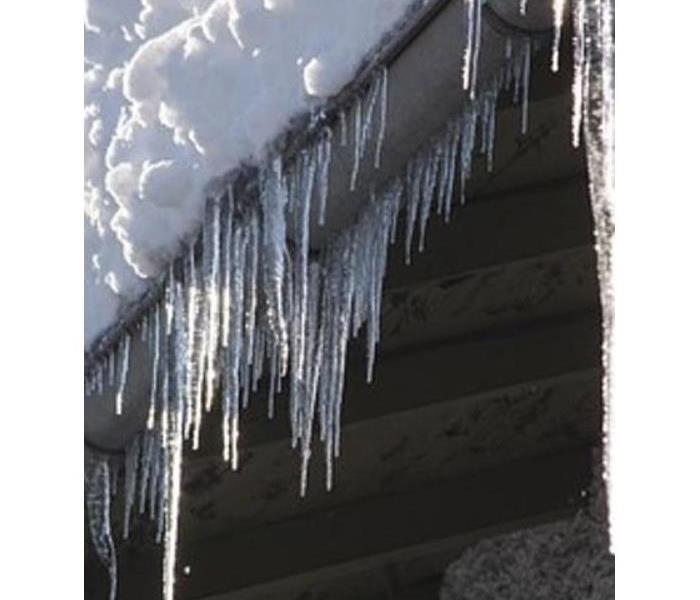 Icicles forming on your gutters can cause structural damage due to melting and refreezing water.
Icicles forming on your gutters can cause structural damage due to melting and refreezing water.
It seems most of the heavy-hitting storms happen in the fall, followed by brutal winter blizzards and nor’easters. Your adversaries during this time are the two legendary elements: Wind and Water. At full force, the wind will scatter leaves and tear off the sturdiest limbs; water will flood and wash away. The damage they can cause can be mind-boggling, resulting in physical injury and death, and property destruction.
Homeowners must be mindful of the impact that powerful storms and weather systems to their property and their loved ones. Decisions must be made in a timely manner to get ahead of the extremes of the season. The following are suggested remedies for possible issues that will come up as the seasons change and the weather gets colder.
Keep Drains and Gutters Clear
After a major rainfall, rain pours from your roof and pools around your property and leaks into your basement. A major reason is leaves and branches clogging water drainage on the street or around your house. When not raked away from drains, leaves and branches will clog them. Rake the leaves and clear treefall from your property.
The same applies for snow. Snow mounds on the street may be slow to melt and get stuck in a cycle of re-freezing and will block any drains. If it’s on your property—or if you’re feeling neighborly when the department of public works has left the job to fate—break it up and keep it clear.
As for the gutters around your roof, it’s best to contact a professional gutter cleaning service to clear out leaves and debris that could choke your gutters. If left unattended, rain will flow unhindered to leak down into your property, potentially flooding your basement. During the colder months, moisture in the gutters will freeze and weigh them down. They could come crashing down around you and cause injury as well as property damage.
Another tactic to aid with drainage is to consult with a landscaping service to design your property to move water away from your home, and have plantings to prevent soil erosion.
If you have a concern about the basement flooding, your house should have a working sump pump system or a French drain system to prevent seepage or drain collected water. If your basement does take in water and you are able to drain it out, you should set up a de-humidifier to dry it out to prevent mold and mildew growth.
Seal Potential Leaks & Gaps
It’s almost inevitable that leaks will develop in a house, from top to bottom, owing to long-term exposure to the elements, construction concerns or animals nesting. As it gets colder and wetter, those leaks could become more than just a nuisance. When a leak entry point freezes and re-freezes, the gap will expand and allow more water in.
If the leak is coming from the roof, you will need to locate where the leaks are coming from and seal them. You can do it yourself, but if it looks like a bigger job, locate a roofer.
Windows can also be a source for leaks. Just like the roof it will take some detective work to locate where water is coming in–you may have to check for cold air as well. Once you find it, you’ll have to caulk around where the break is.
Clear Away Sick Trees and Loose Branches
The day after any powerful storm will find a landscape littered with fallen branches and downed trees. Some of those trees will have a crushed house underneath. Others will lean on power lines. One of the reasons for the trees to be uprooted may be that the ground was so sodden the roots couldn’t maintain their grip, owing to poor drainage.
If you have trees on your property it would be in your best interest to hire an arborist or tree service to check your tree’s health. Most branches and fallen trees were weak and sick before a storm, and only needed the right gust to send branches flying and trunks to topple.
If you do have sick trees, then you should have them and whatever weakened limbs removed. It’s recommended to get a professional service to do it. DIY only works if your experienced and know how to handle the tools to do the job.
Should you need professional assistance, SERVPRO has the professionally trained staff to handle your post storm clean-up. Regular property maintenance can make the difference between a rough weather season that’s manageable and one full of hazards, costly financially—and in life and limb. Staying several steps ahead of the damage caused by wind, rain, ice and snow can make for a safe and secure rest of the year.
The Facts About Hoarding
3/7/2016 (Permalink)
As one of New Jersey's premier resoration companies, we at SERVPRO of Eatontown/Long Branch often get asked questions about hoarding clean up. In order to understand the process of cleaning the residence of a hoarder, we first need to enlighten the family and friends of the facts about the issue itself. According to the International OCD Foundation:
What is compulsive hoarding?
Compulsive hoarding includes ALL three of the following:
1. A person collects and keeps a lot of items, even things that appear useless or of little value to most people.
2. These items clutter the living spaces and keep the person from using their rooms as they were intended.
3. These items cause distress or problems in day-to-day activities.
How is hoarding different from collecting?
• In hoarding, people seldom seek to display their possessions, which are usually kept in disarray.
• In collecting, people usually proudly display their collections and keep them well organized. What are the signs of compulsive hoarding?
• Difficulty getting rid of items
• A large amount of clutter in the office, at home, in the car, or in other spaces (i.e. storage units) that makes it difficult to use furniture or appliances or move around easily
• Losing important items like money or bills in the clutter
• Feeling overwhelmed by the volume of possessions that have ‘taken over’ the house or workspace
• Being unable to stop taking free items, such as advertising flyers or sugar packets from restaurants
• Buying things because they are a “bargain” or to “stock up”
• Not inviting family or friends into the home due to shame or embarrassment
• Refusing to let people into the home to make repairs.
What makes getting rid of clutter difficult for hoarders?
• Difficulty organizing possessions
• Unusually strong positive feelings (joy, delight) when getting new items
• Strong negative feelings (guilt, fear, anger) when considering getting rid of items
• Strong beliefs that items are “valuable” or “useful”, even when other people do not want them
• Feeling responsible for objects and sometimes thinking of inanimate objects as having feelings
• Denial of a problem even when the clutter or acquiring clearly interferes with a person’s life
Who struggles with hoarding behavior?
Hoarding behaviors can begin as early as the teenage years, although the average age of a person seeking treatment for hoarding is about 50. Hoarders often endure a lifelong struggle with hoarding. They tend to live alone and may have a family member with the problem. It seems likely that serious hoarding problems are present in at least 1in 50 people, but they may be present in as many as 1 in 20.
Are hoarding and obsessive compulsive disorder (OCD) related?
Compulsive hoarding was commonly considered to be a type of OCD. Some estimate that as many as 1 in 4 people with OCD also have compulsive hoarding. Recent research suggests that nearly 1 in 5 compulsive hoarders have non-hoarding OCD symptoms. Compulsive hoarding is also considered a feature of obsessive compulsive personality disorder (OCPD) and may develop along with other mental illnesses, such as dementia and schizophrenia.
What kinds of things do people hoard?
Most often, people hoard common possessions, such as paper (e.g., mail, newspapers), books, clothing and containers (e.g., boxes, paper and plastic bags). Some people hoard garbage or rotten food. More rarely, people hoard animals or human waste products. Often the items collected are valuable but far in excess of what can reasonably be used.
What are the effects of hoarding?
• Severe clutter threatens the health and safety of those living in or near the home, causing health problems, structural damage, fire, and even death
• Expensive and emotionally devastating evictions or other court actions can lead to hospitalizations or homelessness
• Conflict with family members and friends who are frustrated and concerned about the state of the home and the hoarding behaviors
Can compulsive hoarding be treated?
Yes, compulsive hoarding can be treated. Unfortunately it has not responded well to the usual treatments that work for OCD. Strategies to treat hoarding include:
• Challenging the hoarder’s thoughts and beliefs about the need to keep items and about collecting new things
• Going out without buying or picking up new items
• Getting rid of and recycling clutter. First, by practicing the removal of clutter with the help of a clinician or coach and then independently removing clutter
• Finding and joining a support group or teaming up with a coach to sort and reduce clutter
• Understanding that relapses can occur
• Developing a plan to prevent future clutter.
How can I help a hoarding friend or family member de-clutter?
Attempts by family and friends to help with de-cluttering may not be well received by the person who hoards. It is helpful to keep in mind:
• Until the person is internally motivated to change they may not accept your offer to help. • Motivation cannot be forced.
• Everyone, including people who hoard, has a right to make choices about their objects and how they live.
• People who hoard are often ambivalent about accepting help and throwing away objects.
Can’t compulsive hoarding be solved by simply cleaning out the home?
No. Attempts to “clean out” the homes of people who hoard without treating the underlying problem usually fail. Families and community agencies may spend many hours and thousands of dollars clearing a home only to find that the problem recurs, often within just a few months. Hoarders whose homes are cleared without their consent often experience extreme distress and may become further attached to their possessions. This may lead to their refusal of future help.
How do I have a conversation with my friend of family member who is ready to talk about hoarding?
When a person seems willing to talk about a hoarding problem, follow these guidelines:
• Respect. Acknowledge that the person has a right to make their own decisions at their own pace.
• Have sympathy. Understand that everyone has some attachment to the things they own. Try to understand the importance of their items to them.
• Encourage. Come up with ideas to make their home safer, such as moving clutter from doorways and halls.
• Team up with them. Don’t argue about whether to keep or discard an item; instead, find out what will help motivate the person to discard or organize.
• Reflect. Help the person to recognize that hoarding interferes with the goals or values the person may hold. For example, by de-cluttering the home, a person may host social gatherings and have a richer social life.
• Ask. To develop trust, never throw anything away without asking permission.
If you are faced with helping a family member who needs to clean their home after a hoarding situation, call SERVPRO of Eatontown/Long Branch. We can take you through the process and ensure that everything is handled professionally and as quickly as possible. 732-578-9888
Winter Mold Growth: What You Need To Know
2/16/2016 (Permalink)
The wet season in the winter months is one of the best times of year for molds to grow and expand. Often mold is contained near sources of water where it can easily grow and reproduce. As it grows, mold can breakdown and compromise the integrity and strength of the source in which it lives.
Mold spores are microscopic and are naturally found in the air we breathe indoors and outdoors. When large amounts of spores grow, one’s health may be compromised. Mold can be killed, but if it is not removed properly, it can remain in the area just cleaned and the dry spores can be released into the air. Mold remediation services can help eliminate the mold in your home and personal items affected by water damage.
Prevention, however, is what will help keep your lungs healthy and homes and buildings strong. We’ve put together a few tips on how you can help thwart mold from infesting your home that are efficient and realistic:
General Home and Building Maintenance:
- Keep all areas clean.
- Make sure there is good air circulation. Use an exhaust fan or open a window when showering, cooking, and washing the dishes.
- Prevent mold and water damage by turning off the water flow to broken appliances and pipes.
- Replace cracked or defective mortar in basements. If you find your basement is wet or has water leaking into it, inspect the outside drainage systems.
- Spread moisture-barrier materials in crawl spaces over the soil. Heavy roofing paper or plastic film made of polyethylene can be used for this. Make sure there is good ventilation in the crawl space and, if possible, do not enclose it. One may need to use a fan to blow out humid air from under the building.
- One can get rid of humidity or dampness within a building by heating it for a short time. After heating, open up the doors and windows, or use an exhaust fan, to let out the air that is moist.
- Hire a professional roofing contractor to cover a damaged roof with a tarp or tent. This will help protect the building from the elements.
- If there are freezing temperatures, take measures to insulate pipes inside and out to ensure they will not crack and/or burst.
- Make sure all the seals on the windows and doors are not compromised and in good-working condition.
- Clean and repair roof gutters regularly.
- Make sure the ground around your building slopes away from the foundation so water does not collect around or enter in to it.
- Act quickly if you see condensation on windows, pipes, or walls inside a building. Dry out the area and determine if the source of the condensation is from a leak or the result of high humidity.
After a Flood or Heavy Rains:
- Work fast. Call in SERVPRO, which will help in the cleaning and disinfecting of your home from toxins and spores mold can release.
- Lower the humidity and temperature in the building: molds do not like these conditions. Open up windows if the air outside is less humid than the air inside. Otherwise, turn on an air conditioner and a dehumidifier.
- Dispose of moldy items in a sealed bag. Objects that can be saved should be frozen (which deactivates mold) or dried out. Mold remediation services can assist with restoring many of your items, including documents, pictures, and books.
- Make sure there is good ventilation within the building affected. Use a fan, if necessary, to promote good air circulation.
- Remove as much standing water in a building as quickly and safely as possible after disconnecting all electronic equipment inside the building.
- The two key things to remember in mold prevention are: 1. Keep everything clean, and 2. Keep everything dry. Many simple steps can be taken to prevent mold damage as well as water damage during the winter months. However, keep the number SERVPRO handy should you require their services. These professionals can efficiently and quickly ensure your home is safe, dry, and mold-free.
Winter Ice Dams: Cause, Effects, and Prevention
1/25/2016 (Permalink)
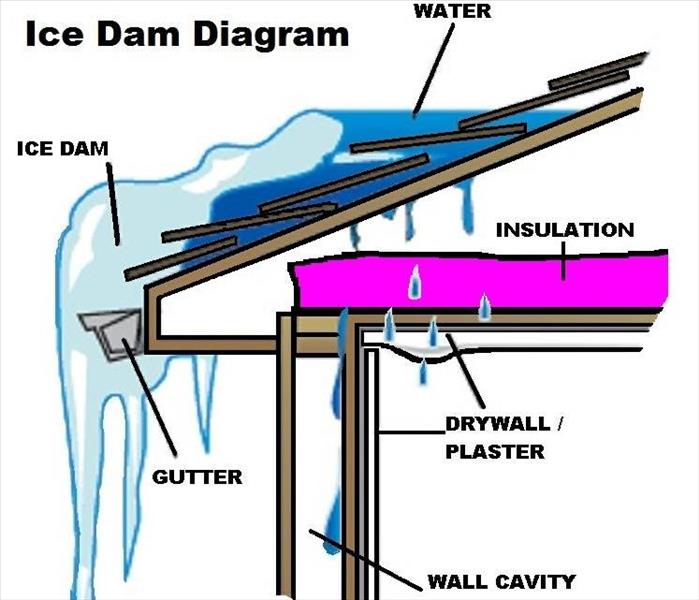
What Causes Ice Dams?
Ice dams form when melting ice and snow refreeze above the eaves of your roof and subsequent melting backs up under the shingles. This causes interior leaks and water damage to interior walls and ceilings.
Preventing Ice Dams
Proper ventilation, drainage and insulation are the only ways to prevent ice dams and can be achieved in the following ways:
- Make sure your gutters are clear of leaves and debris
- Check and seal places where warm air could leak from your house to the attic: vent pipes, exhaust fans, chimneys, attic hatches and light fixtures are all possibilities
- Inspect, or have your roof and attic inspected for proper ventilation and insulation
- Look for signs of inadequate ventilation: rust spots, rusty nails or a mildew smell are all signals that moisture has formed on the inside of your roof
- If you have soffit vents in your eaves, make sure they are not blocked and insulation surrounding them is secured so that air can flow easily
- Keep snow from accumulating on the lower three to six feet of your roof
Additional Steps
- Install snow and ice slides to prevent ice and snow from "bonding" to the lower roof
- Install a rubberized ice and water shield beneath the roof shingles for the first three to six feet from the eaves up
- Install heating cable along the eaves to melt ice
Removing Ice Dams
- Consult a roofing professional
- Do not use a snow blower, shovel or blowtorch to try to chip, break or melt ice dams
5 Tips To Protect Your Home On Winter Vacation
1/13/2016 (Permalink)
Everyone dreams of that warm weather vacation when the winter temperatures drop in NJ. But that dream vacation can turn into a nightmare if your don't prepare your home before you leave.
For peace of mind while you lounge on the beach here is a great article from First Service Residential:
5 Tips Before You Leave On Winter Vacation
If you should come home to an emergency, remember SERVPRO is available 24 hours a day to help. Call us at 732-578-9888
Prepare Your Home in 2016
12/31/2015 (Permalink)
As we say goodbye to 2015, and get set for our resolutions that disappear faster than the ball drops on Times Square, take some time in the coming weeks to think about safety.
How safe is your home? Have you done the proper maintenace needed to minimize your families risk of fires, floods or mold?
In 2013 there were nearly 370,000 home fires in the U.S. At a cost of 6.8 billion dollars in damages. 92% of the appliance fires were caused by the clothes dryer. 32% of those fires were do to lack of cleaning. Here are some dryer safety tips:
*Have your dryer installed and serviced by a professional.
* Do not use the dryer without a lint filter.
* Make sure you clean the lint filter before or after each load of laundry. Remove lint that has collected around the drum.
* Rigid or flexible metal venting material should be used to sustain proper air flow and drying time.
* Make sure the air exhaust vent pipe is not restricted and the outdoor vent flap will open when the dryer is operating. Once a year, or more often if you notice that it is taking longer than normal for your clothes to dry, clean lint out of the vent pipe or have a dryer lint removal service do it for you.
* Keep dryers in good working order. Gas dryers should be inspected by a professional to make sure that the gas line and connection are intact and free of leaks.
* Make sure the right plug and outlet are used and that the machine is connected properly.
* Follow the manufacturer’s operating instructions and don’t overload your dryer.
* Turn the dryer off if you leave home or when you go to bed.
As scary as the statistics for dryer fires sound, they aren't close to being the number one cause of home fires. Two out of every five home fires started in the kitchen, Cooking and cooking equipment account for over 60% of all home fires. They also account for 42% of all fire related injuries in the home.
The peak month of the year for these kitchen related fires is January. The peak time being between 5:00pm and 8:00pm. Unattended cooking was by far the leading cause of these fires.
What you need to know:
- Be on alert! If you are sleepy or have consumed alcohol don’t use the stove or stovetop.
- Stay in the kitchen while you are frying, grilling, boiling or broiling food.
- If you are simmering, baking or roasting food, check it regularly, remain in the kitchen while food is cooking, and use a timer to remind you that you are cooking.
- Keep anything that can catch fire — oven mitts, wooden utensils, food packaging, towels or curtains — away from your stovetop.
Watch this short video for more safety info:
https://www.youtube.com/watch?v=Dm6UMPP2z8I
Make 2016 the year you prepare your home against the risks that are easily avoidable.
Best Defense Against Mold
11/11/2015 (Permalink)
 The SERVPRO of Eatontown/Long Branch Management Team meets with Bruce Wolf of Garden State Environmental Consultants to discuss mold remediation
The SERVPRO of Eatontown/Long Branch Management Team meets with Bruce Wolf of Garden State Environmental Consultants to discuss mold remediation
The first thing you should be aware of is that mold spores are absolutely everywhere. Fungal spores use air currents and water to spread, which is how they get inside homes and other buildings to begin with. The key to prevention is to ensure the atmosphere required for mold spores to mature and spread cannot be found in your home.
The following steps are the best defense against mold becoming a problem in your home.
- Clean and dry wet spots immediately
- Promptly remove any affected materials that cannot be thoroughly cleaned or dried
- Maintain indoor humidity levels below 60%
- Maintain plumbing and utilities to prevent leaks
- Run the bathroom exhaust fan a minimum of 20 minutes after a shower or bath
- Operate a dehumidifier in basement during hot and humid weather
- Ensure attic vents are open and clear of insulation for outside air flow
Should you feel that you have mold issues in your home or business, call SERVPRO of Eatontown/Long Branch at 732-578-9888.
10 Ways To Get Your Home Ready For Winter
11/4/2015 (Permalink)
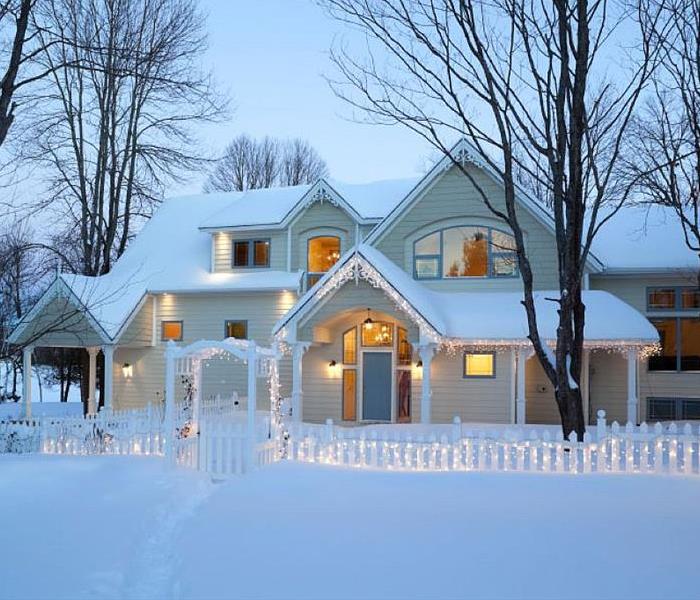 Are you ready for Winter?
Are you ready for Winter?
Winter can be a devastating time for many unprepared home owners. With freezing temperatures and high utility usage, winter can be expensive and even dangerous.
Here are a few tips to get things in order before the temps drop:
1. Order firewood. Ask friends and neighbors for suggestions on good sources in your community. Because of invasive tree pests like the emerald ash borer, it's now illegal in New York state to move firewood more than 50 miles. Any hardwood, such as oak, maple, beech or elm, will work fine for firewood. You want seasoned firewood that's at least a year old. Ash is the only wood that you can burn "green," right after it's cut down.
2. Clean gutters. If you can't get on a ladder yourself, hire someone. Wait until all the leaves are down, then do it once (unless, of course, they're already overflowing when it rains). So many water-in-the-basement problems are because of clogged gutters.
3. Get water away from the house. Same as above. Even if your gutters are clean, rainwater may be pouring down the leader pipes and emptying right at the corner of your house (and into the basement). You may need to hire someone to dig trenches and install underground drain pipes to pull roof water away from the house. Make sure that all landscaping is pitched away from the house.
4. Seal up masonry. Repair any broken joints or cracks in walkways, steps and stone work. Make sure you have clear, shovel-friendly paths to all doors.
5. Cut down on heating costs. Make your house more energy-efficient by adding insulation, caulking around windows and doors and new storm windows. Maybe you have enough sun and space for solar panels. Repair any cracked or broken windows.
6. Don't rake your leaves. Instead, just leave them where they fall and run them over with a mulching lawn mower. You'll be amazed at how one of these powerful machines can turn a pile of leaves into a million little pieces. Plus, they add valuable organic matter to your lawn. Similarly, leave grass clippings on the lawn.
Love 'Em and Leave 'Em is a Westchester County initiative to encourage leaf mulching and reduce organic yard waste, with a downloadable list of landscapers (Rockland, too) who do this, leleny.org. The cities of Yonkers and New Rochelle have been particularly active with this program.
7. Hire a chimney sweep. We've had two bad winters in a row with another one forecast, so if you haven't had your chimneys cleaned in a while, it's probably time.
How often should you have your chimneys cleaned? "If you have 40 to 50 fires a winter, or about three times a week, you should clean it every year," said Bob Pelaccio of the Mad Hatter Chimney Sweep in Montrose. If it's a couple of times a week, every other year is fine. Only on Sunday? Then every third year will do.
Tedd Cuttitta of New City-based NY Fireplace Designs (and formerly High-Tor Chimney Sweeps) is more of a stickler for an annual checkup. "According to every code in the world, chimneys should be cleaned or inspected on an annual basis," he said. Even if they look fine, there may be internal water damage to the bricks that you can't see.
"I never recommend that any of my clients go beyond every third year, no matter how infrequently they use their chimneys," Cuttitta said.
8. Call in an arborist. Many winter tree catastrophes are preventable. Get a certified arborist to walk around your yard with you to look for rotting trees or damaged or dangling limbs that may come down in the next storm.
9. Get your furnace and boiler inspected. Instead of begging for service when your boiler blows on a dead-cold January night, sign a contract now with a reputable heating company. Many oil and propane suppliers are happy to bring you on board with an annual service contract. It's worth it.
10. Time for a generator? Raise your hand if you spent a week in a dark, cold house after Superstorm Sandy tore through the Northeast. If a big storm is forecast or upon us, no one will have a generator with your name on it. So think long and hard now about whether it's time to finally spring for one. But consider your neighbors, too, and where you're going to put it. Generators are LOUD.
Keep SERVPRO of Eatontown/Long Branch's 24 hour help line number handy: 732-578-9888.
Is My Sump Pump Working? How To Test It.
5/12/2015 (Permalink)
Sump pumps are often installed in a crawlspace or basement below the floor to defend your home against a flood or accumulating ground water. A sump pump also removes collected condensation created by your air conditioner and water from areaway drains, preventing moisture from collecting around the foundation of your home or in the floor of your basement. Test your sump pump periodically to ensure it is working correctly to protect your home against water damage.
1) Find the outside pipe that catches the water as it drains from the pump. Examine the inside the pipe to ensure no dirt or debris is clogging the drain. Remove any debris.
2) Locate the sump pump in your basement or mechanical room. Trace the two electrical cords from the sump pump to the electrical outlet. The pump cord plugs into the back of the float cord plug. Pull the plugs from the outlet, pull the plugs apart, and plug the pump cord only back into the outlet. You should hear the pump running. Unplug the pump and plug the cords back in the wall with the float first, and the pump cord plugged into the back of the float pump.
3) Remove the lid from the sump crock. Slowly pour some water from a 5-gallon bucket into the crock. Observe the sump pump switch. It should turn on and begin to pump water from the crock. Wait until the water pumps from the crock to ensure the pump turns itself off, then slowly pour the remaining water in the crock to ensure the pump turns on again.
4) Replace the sump pump if it fails either test.
Monmouth County: Do You Have Mold?
4/14/2015 (Permalink)
Older homes are prime habitats for mold, which thrives in a dark, damp, warm environment. If you have water damage, water leaks, a leaky roof, a washing machine that overflows frequently, that moisture can give mold a toehold.
In some instances, it can be hard to see the water damage. SERVPRO professionals can use a moisture meter and infrared cameras see if anything is leaking.
So what can you do to reduce your exposure to mold? Attack mold on two fronts -- removal and prevention:
· Get your house tested for mold. A moisture meter test will help. Also, a dust sample from your carpet can show whether mold spores are in your home. Check with your state health department or find a local environmental testing company.
· Fix leaky plumbing or other sources of water. If you have mold in your crawl space or basement, locate the source and stop the water from coming in.
· If your crawl space has mold, call SERVPRO of Eatontown/Long Branch to put a remediation plan in place to get rid of it.
· Check inside drywall for mold inside the wall. You can usually smell mold even if you can't see it. Moldy drywall must be cut out and replaced. Moldy insulation also must be removed and replaced.
· Dry water-damaged areas and items (like carpeting) within 24 to 48 hours of flooding. Don't install carpeting in areas where there is a moisture problem.
· If ceiling tiles or carpet have become moldy, they must be replaced. Throw out all wet, moldy tiles and carpeting.
· Reduce indoor humidity by venting bathrooms, dryers, and other moisture-generating sources. Exhaust fans in bathrooms and kitchens can help. If you don’t have exhaust fans, crack a window in the kitchen when you're cooking or in the bathroom when you're bathing.
· Use air conditioners and dehumidifiers inside your home. Change filters regularly. Use a dehumidifier to get rid of dampness in basements.
· Add insulation to windows, piping, exterior walls, roof, or floors where there is potential for condensation on cold surfaces.
Find out more: http://www.SERVPROeatontownlongbranch.com/mold-removal-remediation
Ice And Cold Can Wreak Havoc On Your Home
3/2/2015 (Permalink)
March is here and winter is still with us in Monmouth County NJ. From Sea Bright to Long Branch, Red Bank and Eatontown, many homeowners have experienced water damage from frozen pipes these past two months. Keep in mind that ice dams can also cause water to come into your home from the outside elements. Luckily, SERVPRO of Eatontown/Long Branch is here to help 24 hours a day. Our experienced crews can tackle any type of water or fire damage in your home. Call us at 732-578-9888.
See The News 12 Fire Scene Interview Here
2/10/2015 (Permalink)
http://newjersey.news12.com/multimedia/interviews-on-ocean-grove-fire-aftermath-1.9921276
SERVPRO of Eatontown/Long Branch Featured On News 12 New Jersey
2/9/2015 (Permalink)
SERVPRO of Eatontown/Long Branch owner, John Majeski speaking with Karla Bardinas of News 12 New Jersey regarding our clean up efforts at the scene of the Ocean Grove fire.
3 Alarm Fire In Destroys Businesses And Homes in Ocean Grove
2/9/2015 (Permalink)
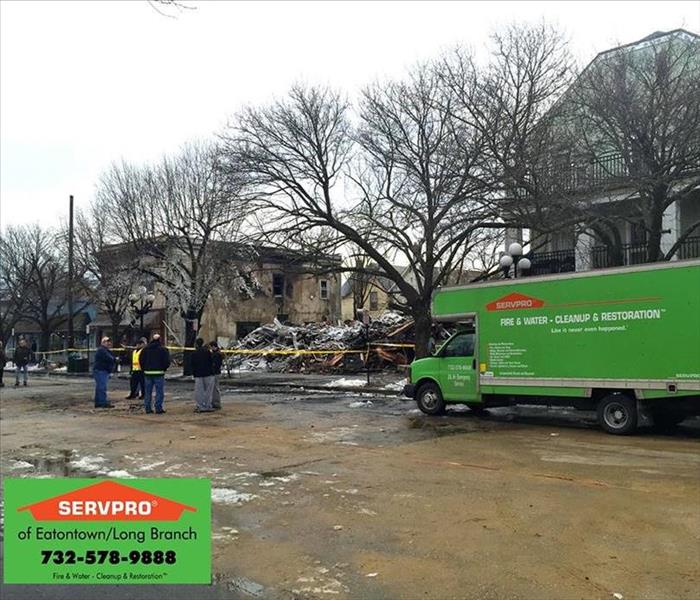 Green on the scene Saturday morning in Ocean Grove.
Green on the scene Saturday morning in Ocean Grove.
A three-alarm blaze demolished a section of Main Street in Ocean Grove on Friday. The fire began in an apartment above Yvonne's Luncheonette at approximately 4pm. Firefighters battled the flames and cold temperatures throughout the night.
On Saturday morning, SERVPRO of Eatontown/Long Branch was called in to clean up the soot, smoke and water damage in three adjacent buildings. Crews began work shortly before noon. SERVPRO of Eatontown/Long Branch offers 24 hour response for fire, and water clean up and remediation.
At this point, no cause has been determined for the fire.
SERVPRO of Eatontown/Long Branch Provides General Contracting Services
2/3/2015 (Permalink)
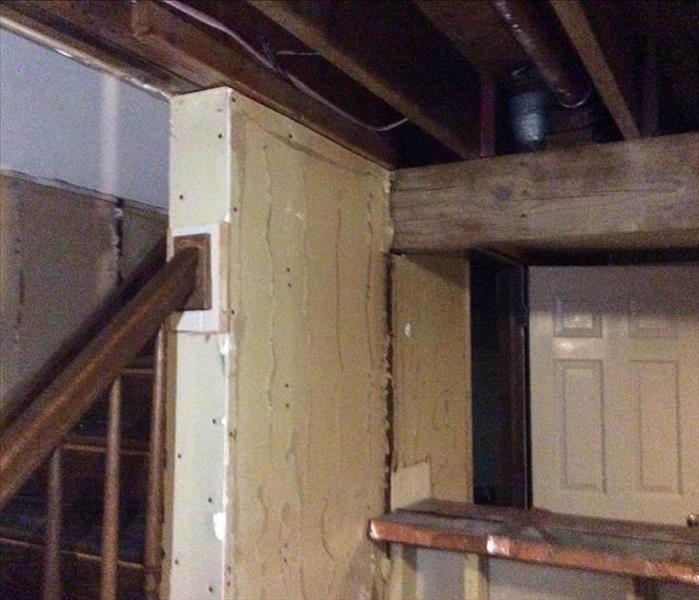 Removing sheet rock is the only wayto get to the problem and remediate thoroughly. Afterward our renovation team will come and make the area like new.
Removing sheet rock is the only wayto get to the problem and remediate thoroughly. Afterward our renovation team will come and make the area like new.
Sometimes damage requires more than just cleaning soot or removing sewage. Some damages require replacement of drywall, paint, electrical service and plumbing.
Having damage is stressful enough, and seeing your home during remediation can add to that stress. That is why SERVPRO of Eatontown/Long Branch now provides many general contractor services through our restoration department to help return your home or business to pre loss condition. We aim to get you back to your normal life as quickly as the job allows.
These services include, but are not limited to, fire, water and mold restoration services, flooring, tile, framing, window replacement, carpentry, roofing, siding and masonry work. Find out all that SERVPRO can do for you.
When it comes to helping you get your life back to normal, we will make it “Like it never even happened.”
Avoid Winter Water Damage
1/28/2015 (Permalink)
With ice, snow and cold temperatures across the Jersey Shore, SERVPRO of Eatontown/Long Branch reminds you take the steps needed to avoid major flooding problems...
OUTDOORS:
- Wrap outside faucets
- Caulk around pipes where they enter the house
- Disconnect garden hoses
- Drain in ground sprinkler systems
INDOORS:
- Let a stream of water run if the temperatures dip below freezing
- Open cupboard and vanity doors in the kitchen or bathroom
- Shut off and drain your water system if you are leaving the home for several days or more.
SERVPRO of Eatontown/Long Branch: Faster To Any Disaster
1/22/2015 (Permalink)
The residents of Monmouth County NJ, know that when it comes to any size emergency, SERVPRO of Eatontown/Long Branch can make it "Like It Never Even Happened". Whether it's damage from a fire. Water damage from a broken or frozen pipe, a flooded basement, mold or even a sewage back up, Servrpro of Eatontown/Long Branch's trained technicians can tackle the clean up quickly. We work with all major insurance companies. We'll clean up the mess and get your life back on track after any type of commercial or residential loss. Call 732-578-9888. 24/7
Winter Weather Tips
1/7/2015 (Permalink)
Tips for Preparing Your Home for Winter Weather
Keep cabinet doors open during cold spells. This allows warm air to circulate around pipes.Keep a slow trickle of water flowing through faucets, especially if the pipes for faucets run through unheated or non-insulated areas of your home.Consider shutting off outdoor faucets. Find the shut-off valve in the basement or crawl space and turn it to “off.”If you follow the previous step, then open the outdoor faucet to help ensure it drains completely and the inner valve is shut off.Proper maintenance of your furnace can help reduce the risk of puff backs.Ensure gutters are clan and secure. Leaves and debris accumulate, causing a damming effect on gutters, which could lead to roof problems and water damage.
Helping a Veteran in the wake of Hurricane Sandy
10/29/2013 (Permalink)
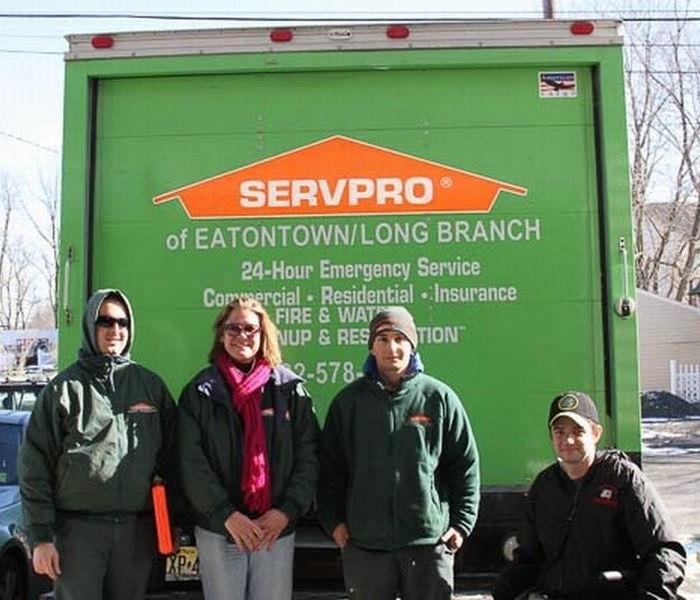 Our response crew with SSG Mike Minard (right).
Our response crew with SSG Mike Minard (right).
SERVPRO of Eatontown/Long Branch teamed up with Homes For Our Troops to help Iraq war veteran SSG Mike Minard and his family return to their Union Beach home after suffering damage from Hurricane Sandy. It was an honor to work with a veteran that has given up so much for our country.





 24/7 Emergency Service
24/7 Emergency Service

















































































